











































































It’s unknown who decided this Super Hawk needed a chrome frame, but boy is it sharp. See Page 18.













































































It’s unknown who decided this Super Hawk needed a chrome frame, but boy is it sharp. See Page 18.
10 METAL AND RUBBER: 1970 DUCATI 450 MARK 3
A motorcycle is only a compilation of metal and rubber. It takes people to create the memories and stories behind the machine.
18 EASY LIVIN’: HONDA SUPER HAWK
Rider Jen Tacy decided she wanted a motorcycle, and as a fan of the 1960s, she searched out and bought a sweet 1963 CB77 Super Hawk.
24 CLASSIC SCENE: A TALE OF TWO TEXAS RALLIES
Corey Levenson reports on a pair of Texas events, the 20th and very last Harvest Classic European & Vintage Motorcycle Rally, and the reborn Texas Motorcycle Revival.
2 SHINY SIDE UP
On the road again.
4 READERS AND RIDERS
A reader responds to a past story on Bill’s Old Bike Barn, and we take a special look at a pair of long-term-loves, reader Phil Dansby’s two Norton Commandos.
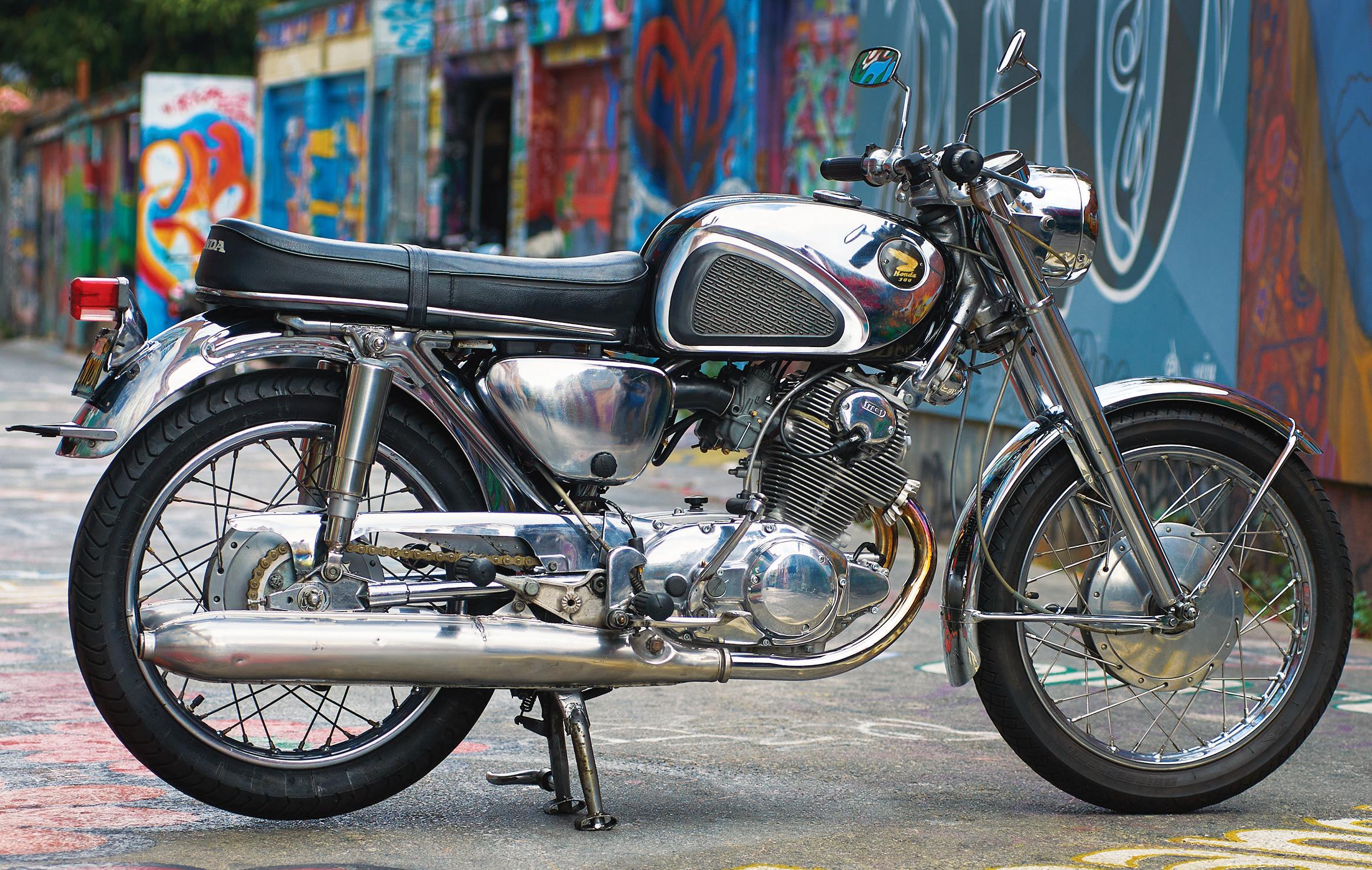
32 GREY GHOST: GODET VINCENT GREY FLASH 500


Alan Cathcart tests Patrick Godet’s 500cc racer.
40 CONFESSIONS OF A JUNKIE

A look back at a zany ride by motojournalist
John L. Stein aboard a $5 1965 Yamaha Big Bear Scrambler.
47 DESERT SLED: TRIUMPH T100/110
Desert Sleds were built to carry their riders quickly and efficiently across portions of the Great American Desert.
54 SMOOTH SURVIVOR: YAMAHA TX750
Vibration is the enemy of just about everything that makes motorcycling fun.
8 ON THE RADAR
The Triumph Daytona, Honda CB450, and the BMW R50/5.
62 TEST RIDE
Motocross The Golden Era, reviewed.
64 HOW-TO
Part 3 of reviving the Honda CB175.
68 CALENDAR
Where to go and what to do this spring.
70 DESTINATIONS
Visit Cedar Breaks National Monument in Utah.
80 PARTING SHOTS
Botts’ Dots.

Remember the classics through the Street Bikes of the ’50s, ‘60s, ‘70s, and ‘80s series, Pre-War Perfection and the magazine archive. Also included in this package are the MC 2023 calendar and hat. Enter for a chance to win this package valued at $130 at MotorcycleClassics. com/sweepstakes/treasures

Traveling on an old bike can be an adventure, or it can be as smooth as a run to your local coffee shop. Preparation is often the main difference between the two.
But have you ever stopped and thought how easy we have it today? We are rarely more than a cell phone call away from help if we find ourselves with a broken bike we can’t fix, and in the rare occurrence that there’s no signal, I’ve always had a kind stranger (and often fellow motorcyclist) stop within five minutes of roadside trouble to offer help.
How many of us take real journeys on our old bikes anymore? I’ll admit most of my 3- or 4-day weekend jaunts in the past 10 years have often been on something more modern than my 1970s twins.
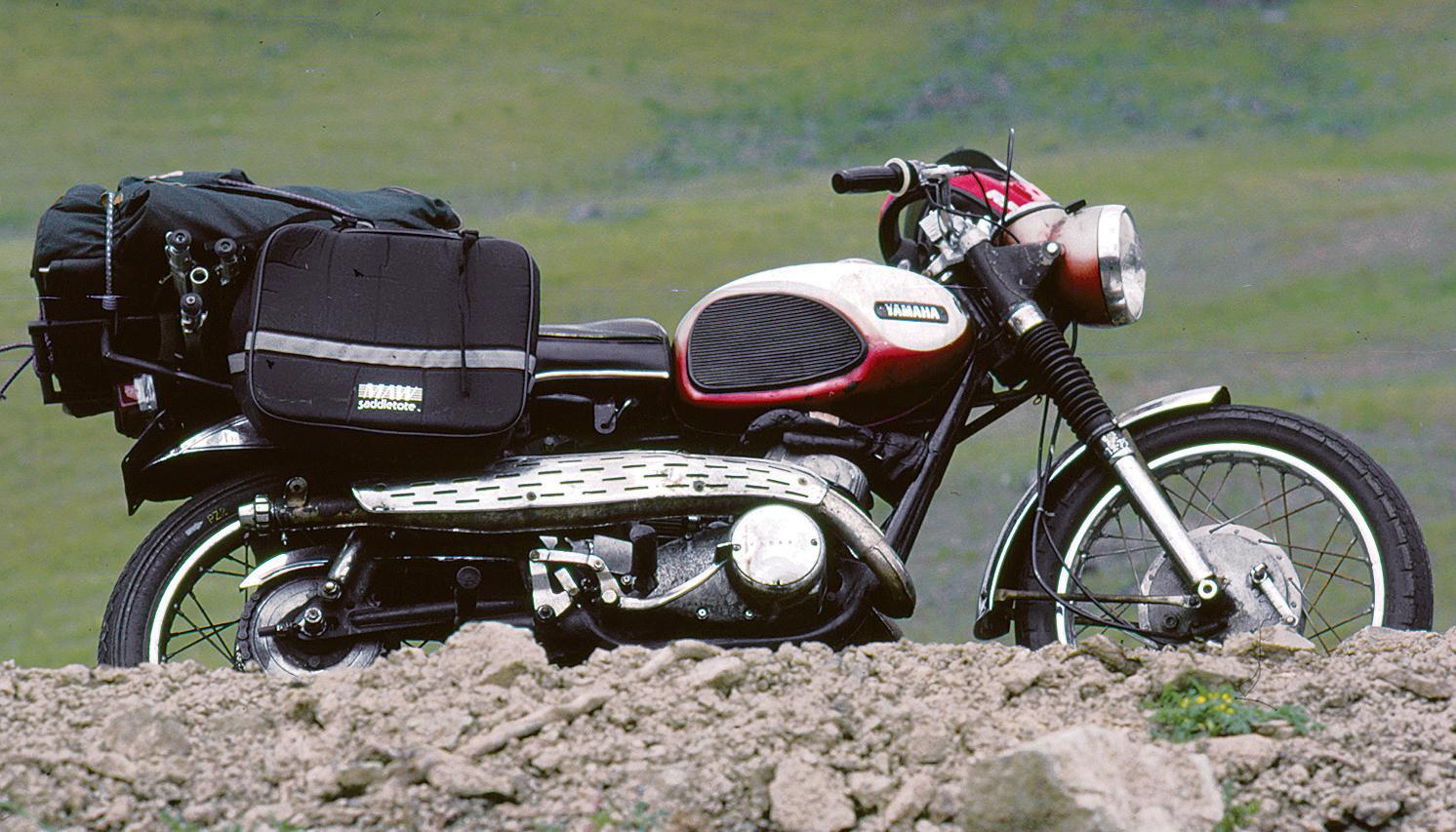
The one multiple-day trip I did take a few years back on my 1973 BMW R75/5 was a hoot. A friend and I took a few days off to head to Missouri to ride some of the great roads surrounding the Lake of the Ozarks. I purposefully planned out a completely back-road route from my home in Topeka, Kansas, to our rented little cabin in Missouri.
Though only some 200 miles away, it took us 7 hours to get there with a lunch stop. In the heat of the summer, that was enough time in the saddle for us that day. The ride there was
happily uneventful. The next day things got more exciting. First I was pulled over by a Missouri state trooper who was not familiar with what an antique (as in circa-1973) Kansas motorcycle tag looks like. After a friendly discussion, we were back on our way.
But a couple hours later, after some of the nicest curvy roads we’d seen yet on the trip, my buddy had disappeared from my mirrors. Turns out the charging system on his early-2000s Honda VFR had given up the ghost, and no shop within riding distance had the parts we needed to repair it. That was it. Another friend with a truck and a ramp hauled the broken VFR back to the cabin and back to Topeka the next day. The /5 never missed a beat the whole trip, and we still had a good time despite the breakdown.
Some other people's journeys are far more exciting than ours was. We don’t often reprint stories from old motorcycle magazines, but as writer John L. Stein shows us on Page 40, some tales are worth retelling, and I promise you this: John’s story turns into more of an adventure than mine did. I hope it inspires you to take a trip on one of your old bikes. I know it has me making riding plans.
Cheers,
LANDON HALL, EDITOR-IN-CHIEF

lhall@motorcycleclassics.com
CHRISTINE STONER, ASSOCIATE EDITOR
KEITH FELLENSTEIN, TECH EDITOR
RICHARD BACKUS, FOUNDING EDITOR





JOE BERK • ALAN CATHCART • NICK CEDAR
KEL EDGE • DAIN GINGERELLI • KURTIS KRISTIANSON
COREY LEVENSON • ROBERT SMITH • MARGIE SIEGAL
JOHN L. STEIN • GREG WILLIAMS
ART DIRECTION AND PREPRESS
MATTHEW STALLBAUMER, ART DIRECTOR
ADVERTISING DIRECTOR








BRENDA ESCALANTE; bescalante@ogdenpubs.com
WEB AND DIGITAL CONTENT
TONYA OLSON, WEB CONTENT MANAGER
DISPLAY ADVERTISING
(800) 678-5779; adinfo@ogdenpubs.com

NEWSSTAND
BOB CUCCINIELLO, (785) 274-4401
CUSTOMER CARE (800) 880-7567
BILL UHLER, PUBLISHER CHERILYN OLMSTED, CIRCULATION & MARKETING DIRECTOR
BOB CUCCINIELLO, NEWSSTAND & PRODUCTION DIRECTOR
BOB LEGAULT, SALES DIRECTOR ANDREW PERKINS, DIRECTOR OF EVENTS & BUSINESS DEVELOPMENT
TIM SWIETEK, INFORMATION TECHNOLOGY DIRECTOR
ROSS HAMMOND, FINANCE & ACCOUNTING DIRECTOR
MOTORCYCLE CLASSICS (ISSN 1556-0880)
March/April 2023, Volume 18 Issue 4, is published bimonthly by Ogden Publications, Inc., 1503 SW 42nd St., Topeka, KS 66609-1265. Periodicals Postage Paid at Topeka, KS and additional mailing offices. POSTMASTER: Send address changes to Ogden Publications, Inc., 1503 SW 42nd St., Topeka, KS 66609-1265.
For subscription inquiries call: (800) 880-7567
Outside the U.S. and Canada:
Phone (785) 274-4360 • Fax (785) 274-4305

Subscribers: If the Post Office alerts us that your magazine is undeliverable, we have no further obligation unless we receive a corrected address within two years.
©2023 Ogden Publications Inc. Printed in the U.S.A.
In accordance with standard industry practice, we may rent, exchange, or sell to third parties mailing address information you provide us when ordering a subscription to our print publication. If you would like to opt out of any data exchange, rental, or sale, you may do so by contacting us via email at customerservice@ ogdenpubs.com. You may also call 800-880-7567 and ask to speak to a customer service operator.
®

Great to see Joe Berk’s excellent article on Bill and his “stuff” (November/December 2022). I’ve been four times and am constantly finding new things to gawk at. One of my favorites used to be the centerpiece in the main hall before he bought the carousel about four years back ... a 1948 RollsRoyce chopped into a pickup truck, painted white and ready for a wedding party. The Gatling gun in front of it I always thought was a nice touch. I haven’t had the good fortune to meet Bill, although the last time I was there I did meet his (long-suffering!) wife, a lovely lady. When I asked about the carousel she just rolled her eyes, and said, “Bill was over in Europe recently, and ... ” Fabulous place. Even if you have no interest in motorcycles it’s a gem of a place to visit.
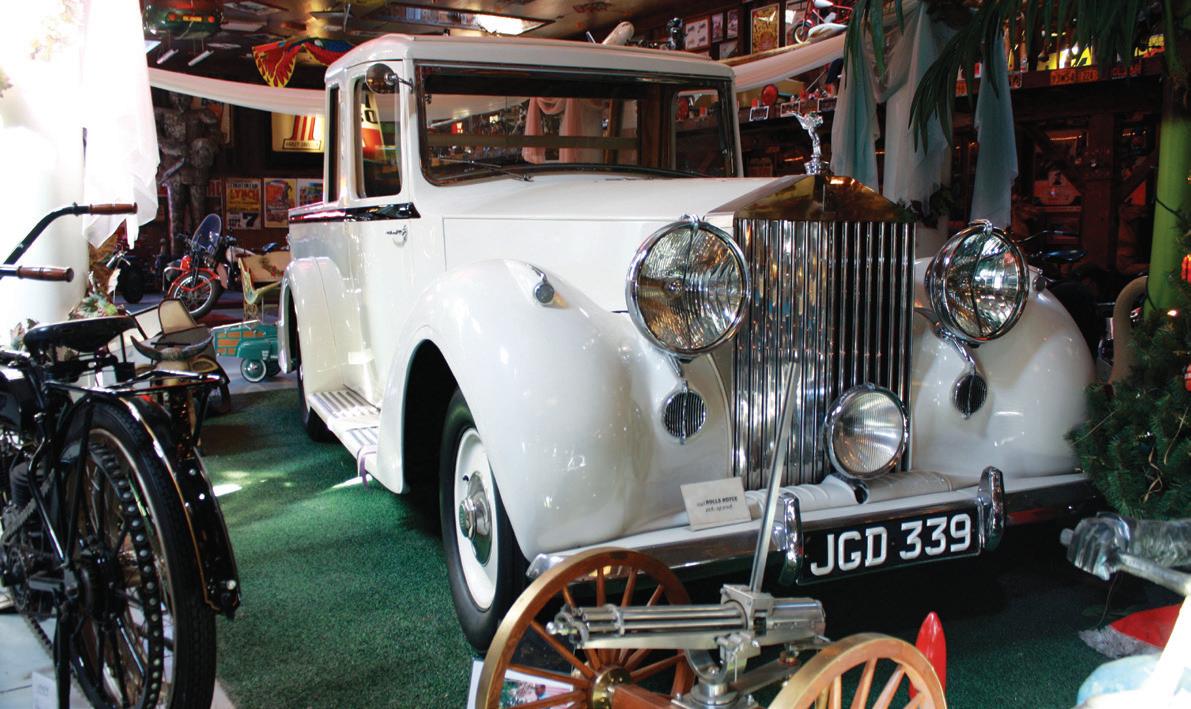 Larry Tate/via email
Larry Tate/via email




My strong admiration for those who could amass a sizable motorcycle collection started in 1969 when I saw the just released Honda CB750 at the World’s Fair in Budapest, Hungary. I was an avid rider in my twenties, and owning one Pannonia, a Hungarian made 250cc 2-stroke motorcycle, made me very happy. As I was looking at that bike, I realized that owning that Honda, was an impossible dream. Just one year later, I escaped communist Hungary, and immigrated to
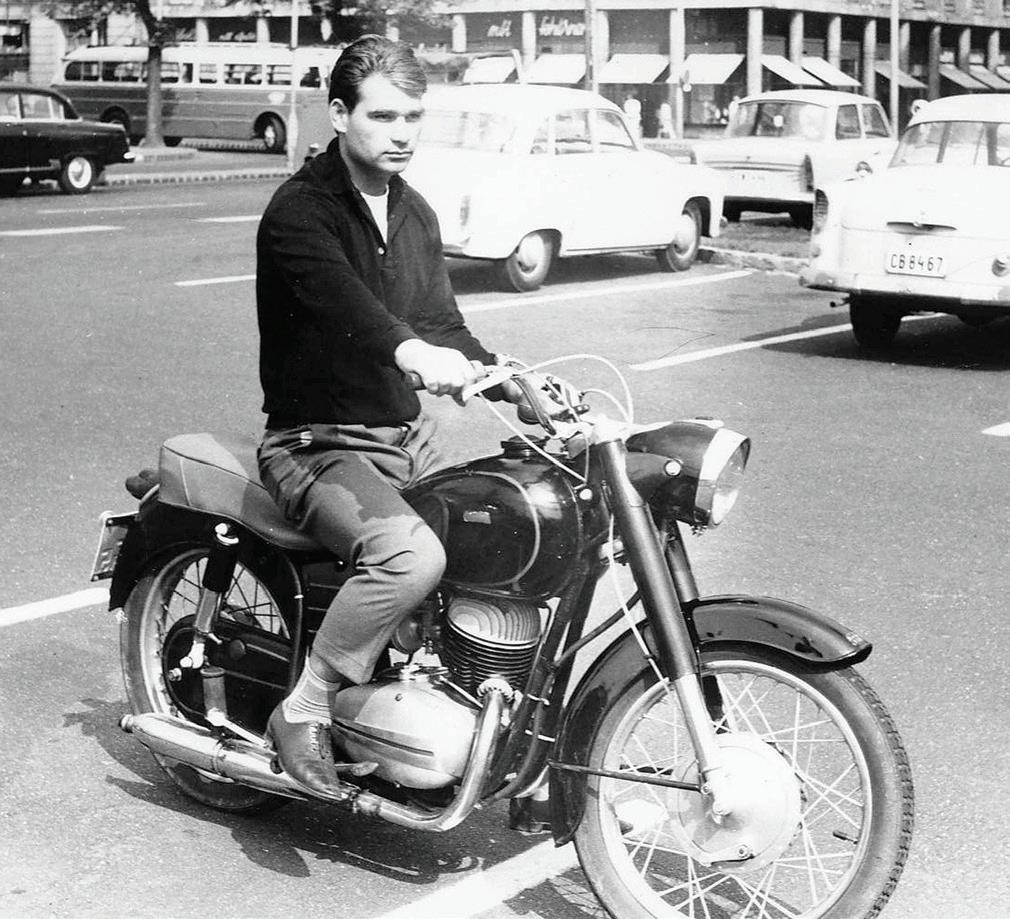
the United States. For several years, I was dreaming and hoping to own that Honda or something similar or equal. It took a long time when finally I was able to buy a used Kawasaki Z1. I had arrived at motorcycle heaven. Over the years I have owned 45 motorcycles, but lacking the space and sufficient funds, I needed to sell many of my prized possessions. With my son, we could only maintain about a dozen vintage and modern bikes. I visited and know only a few museum style collections, but there is one I admire the
most. It belongs to a dear friend of mine, Daniel Schoenewald, who I met at the Rock Store in Southern California 25 years ago. Not only does he have more than 150 extremely rare and valuable bikes, but he rides them regularly. His collection covers the years between 1930 and 2021. I treasure this picture, my friend Daniel and I, with his 1930 Brough Superior, which was taken during the 2005 Hansen Dam ride in Southern California.
Attila Gyarmati, Sun Valley, California
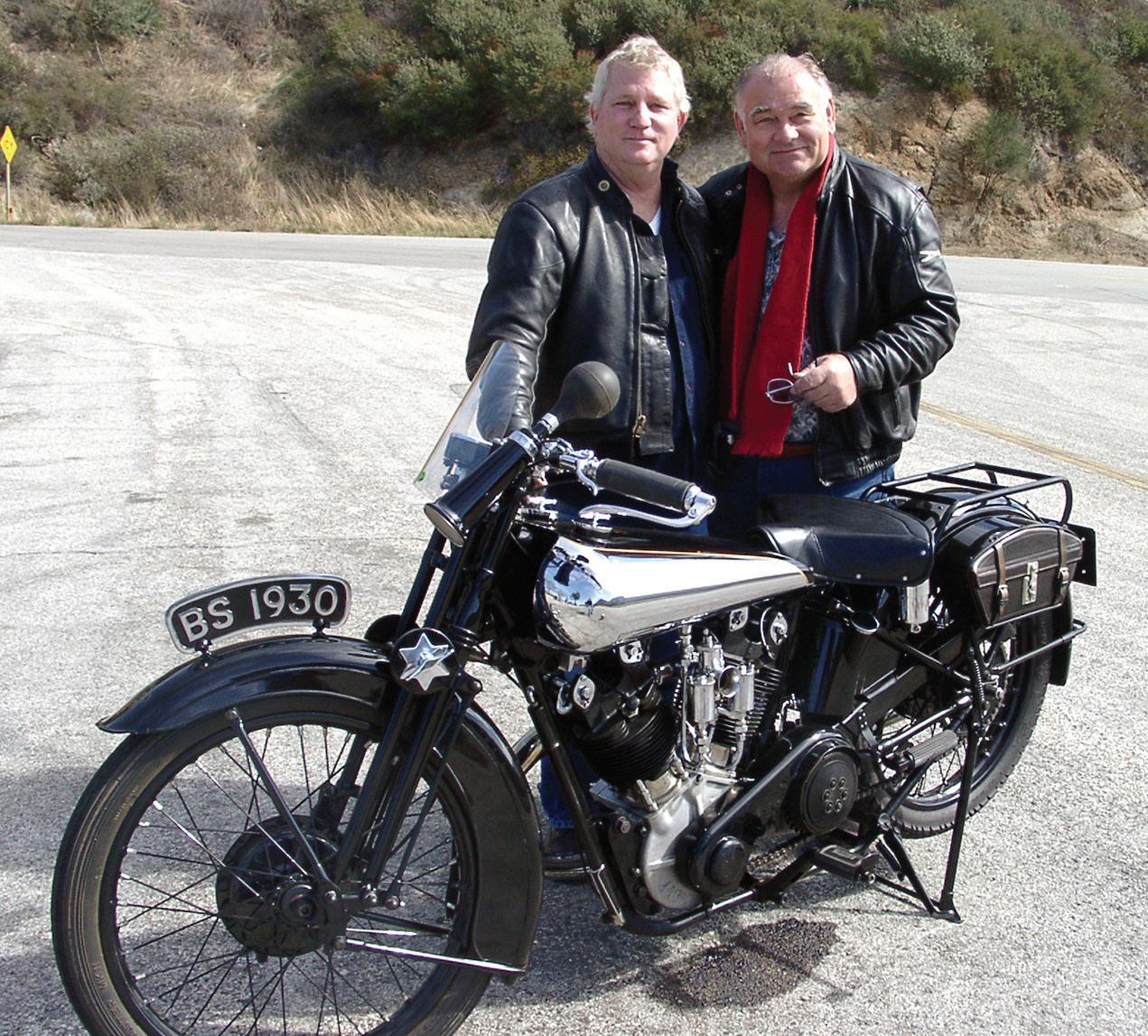
“Sort of wish I'd held onto mine from new, but hey, what can you do?”
I’m not sure what it was that drew me to motorcycles from a very young age back in the ’60s, but I was always fascinated with the sound of motorcycles as they passed by and the looks of the engines.
My first recollection of motorcycles was seeing one of the next door neighbor’s boyfriends pull up on various bikes when I was approximately 10 years old. The first I recall was probably a ’65 or thereabout Ducati, possibly a 250. The other bike I can first recall was a black Yamaha 100 2-cylinder “Twin Jet” possibly 1965-1967 or so, owned by the daughter of one of our neighbors.
My first two-wheel motorized experience was a Stella model A mini bike with a 2.5 horsepower Tecumseh lawn mower engine with a max speed of approximately 20mph. $99 off the showroom floor. My first real motorcycle was a well-used 1966 Bridgestone 90 Sport for $90. My next 10 bikes were a 1968 Kawasaki 175 Bushwacker, followed by a 1971 BSA 250 Gold Star, 1970 BSA 441 Victor Special, 1970 Kawasaki 500 Mach III, 1972 Suzuki 400 Cyclone motocrosser, 1972 Harley Davidson Sportster 1000 XLCH, 1974 Kawasaki 900 Z1A, 1975 Kawasaki 900 Z1B, 1976 Suzuki RM250A motocrosser, then finally the 1978 Kawasaki Z1R pictured with me at age 23.
All of these bikes are Classics to me and a few were significant when they were produced. The obvious standout is the 1970 Kawasaki Mach III which I had in Pearl Gray. What a rush when the tachometer hit 5,500rpm and the power came on. Below that, the bike didn’t have much of a power band at all which necessitated constant downshifting on the freeway when you wanted to pass a car or make quick work of a steep hill.
Contrast that to the 1972 Sportster 1000 which had humongous amounts of mid-range torque which meant almost never
having to downshift for any road conditions, as power was plentiful throughout the limited rpm range. Unfortunately this V-twin engine vibrated so much over 4,000rpm that the bike was not very comfortable over 65mph, which limited its usability for me.
The next step for me was of course the 4-cylinder Kawasakis I owned. What a change from the Sportster. On the Kawasakis, the engine was happy at virtually any rpm up to the 9,000rpm redline. The engines on these bikes were so smooth that I constantly found myself cruising at 80 to 85mph on the freeways at about 5,000rpm, leaving another 4,000rpm to redline. Fastest I’ve ever gone on a bike was 132mph on my 1974 Z1A. Even at that speed the bike was smooth and rock-solid.
Ultimately, my last bike, the 1978 Z1R, was perfect for me. The quarter fairing kept almost all wind away from my upper body, with only a little buffeting around the top of my head. The engine had more horsepower than the older Z1s, and the bike had plenty of power even with the stock 4-into-1 exhaust. I put a Kereker 4-into-1 on it anyway which lightened things up a bit and may have added a few horsepower. I used to ride that bike on the Sunken Meadow Parkway and Southern State Parkway going back and forth to work on Long Island and the handling and power made short work of all the freeway traffic. I often cruised between 80 and 90mph on the less congested areas of the freeways. What a great bike. If I see one of these on a Mecum Auction I may have to pick it up. You can never go back, and memories are frequently more friendly to us than our actual experiences at the time. But I’m confident the Z1R1 would still be a great around town bike and freeway cruiser. Sort of wish I had held onto mine from new, but hey, what can you do?
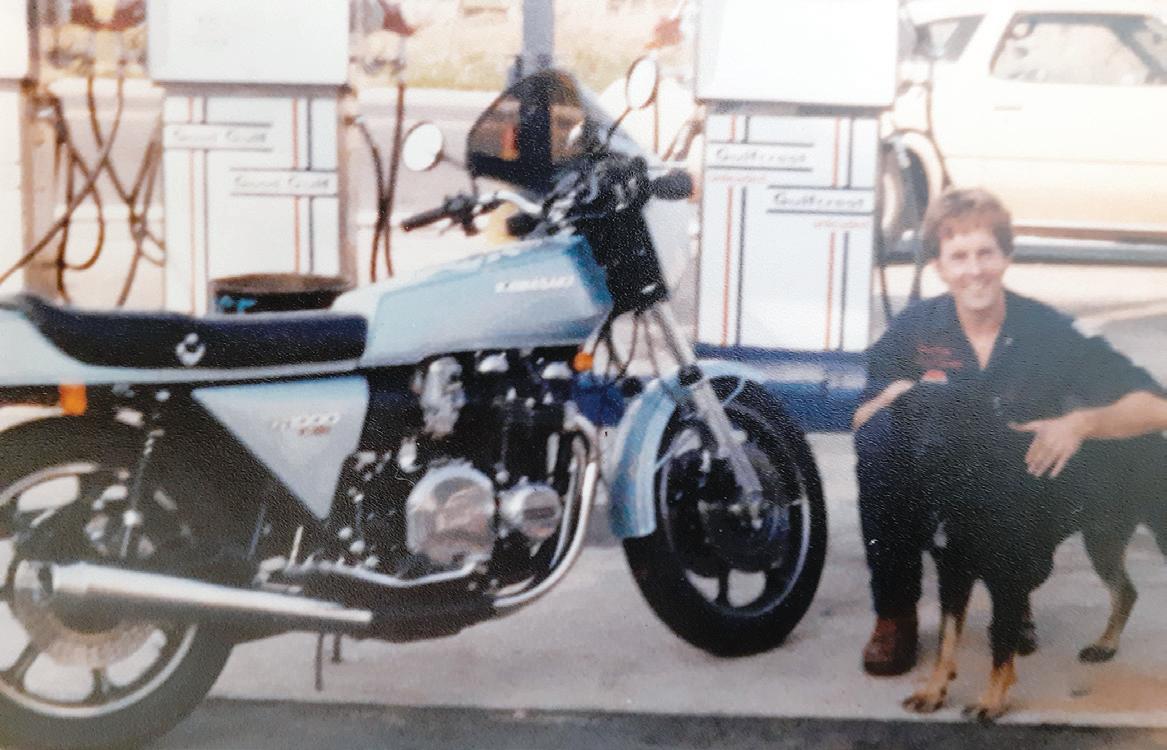
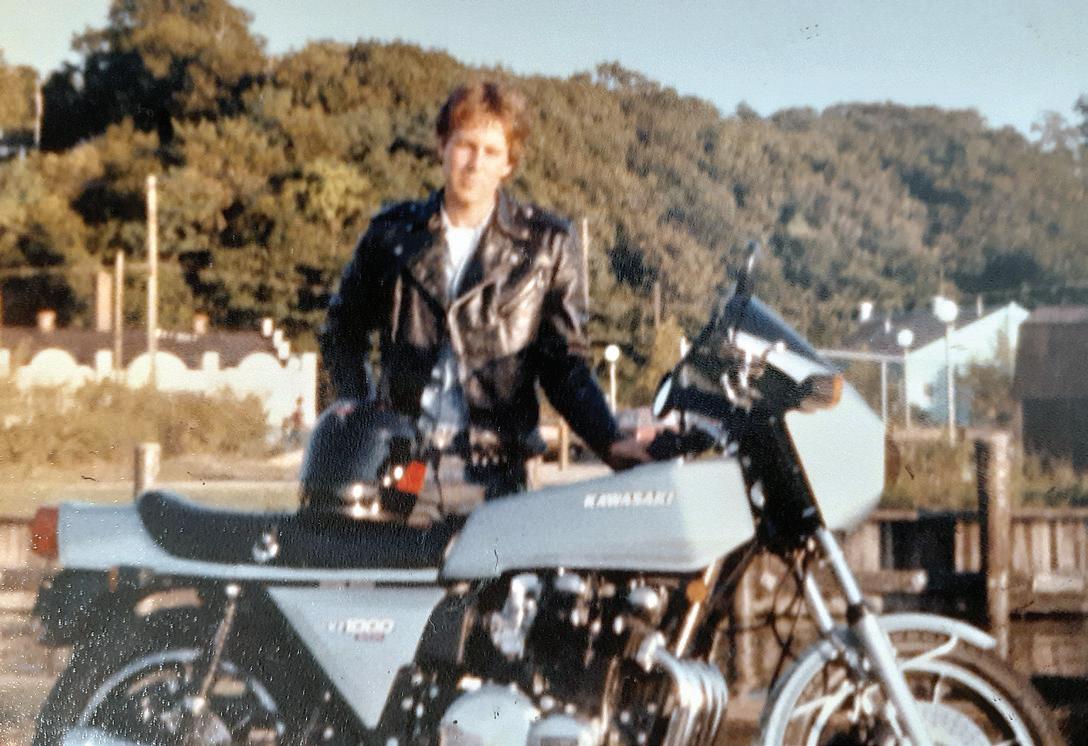 David E. Crow/Huntington Beach, California
David E. Crow/Huntington Beach, California
Some years ago I found the attached photo among my father’s collection. He passed away in 1978. I believe it was likely taken before 1938 (in the Boston, Massachusetts, area), the year my dad and mother were married. I identify the rider as Bill Hood, their mutual good friend from their “gang,” as my mother would refer to their group of chums. The passenger is unknown to me. Perhaps they were set to be riding in a 4th of July parade? It is interesting to note that American flag appears to have 42 stars. Google it! Any insights on this Indian motorcycle would be appreciated.
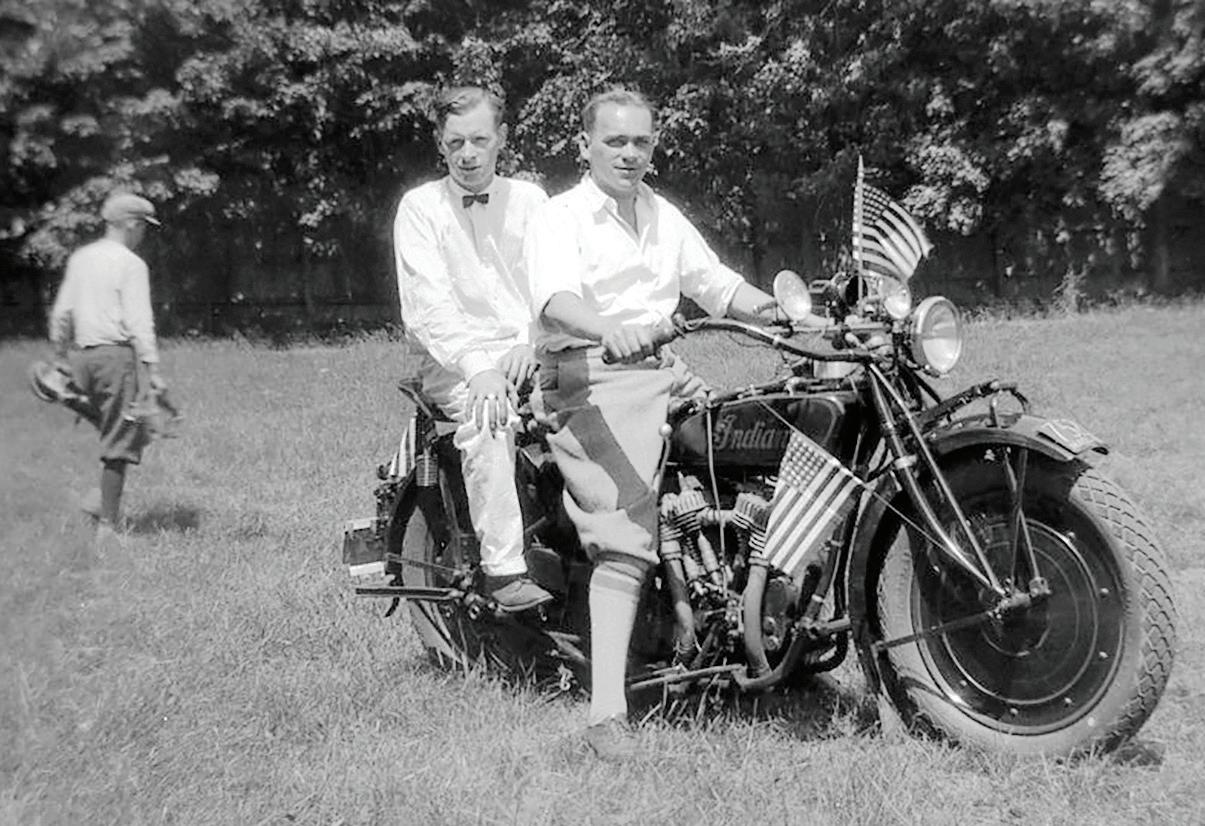 Jerry Harting/Framingham, Massachusetts
Jerry Harting/Framingham, Massachusetts
Readers,



Send me any information you may have on this Indian model, and I’ll pass it along to Jerry. Thanks! — Ed.

It was while growing up New Mexico in the early ’60s that my interest in motorcycles was first kindled. I don’t remember any specific event that inspired my lifelong involvement with motorized two-wheeled vehicles, but surely something did. In those days variety was limited: there were Allstates, sold by Sears and Roebuck, some Vespas, a Cushman scooter or two, and occasional old BMW with an even older guy riding it. The police had only one other motorcycle, an iron barrel Sportster ridden by our only police officer, and the officer had to purchase it himself.
While serving in Uncle Sam’s Navy in the late 60s I subscribed to the two important industry magazines of the time, Cycle and Cycle World. I feel pretty certain that it was the “Norton Girl” in the Commando ads that first caught my eye, but after that it was the beautiful lines of the motorcycle itself that held my attention. The Superbike of its age, the Norton had at least 100cc’s displacement advantage over the competition as well as a long and storied racing history. For the next four years I hungrily consumed any information that I could find regarding Nortons. However, even after my discharge in 1970, it would be a few more years before I actually got my hands on one.
It was late December 1973 and the first 850cc models were almost sold out, but two remained on the showroom floor at Doc Storm’s dealership. I still didn’t have the money, but I was certain that I had waited long enough for the motorcycle of my dreams. Soon the deal was done, and I picked up my ’73 MKII Roadster just before Christmas which I still have today. Little did I know at the time what a significant role that motorcycle and my association with all things Norton, British and later Italian motorcycles would play in my life.
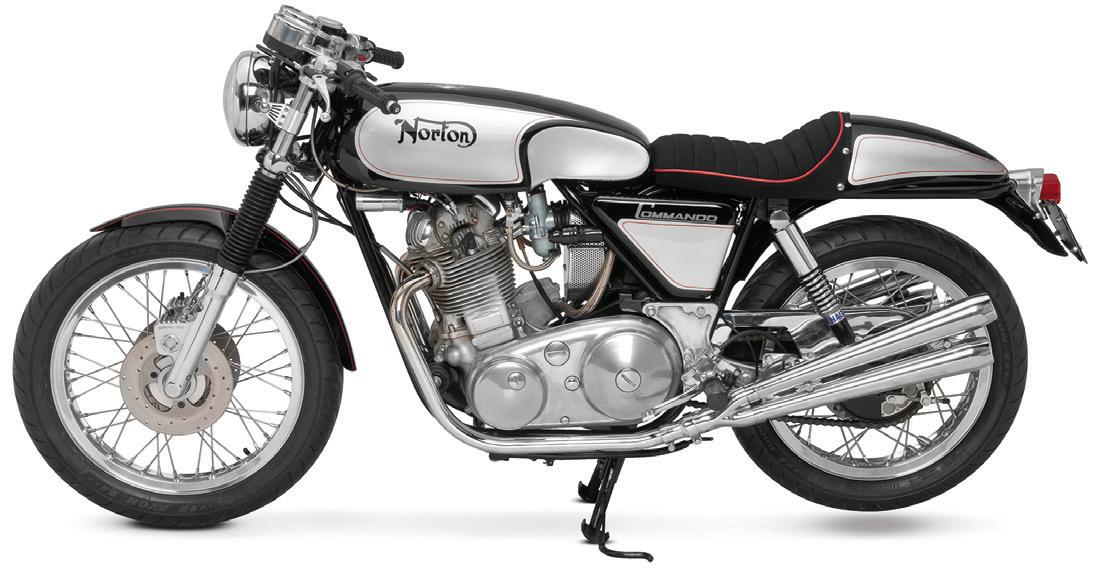
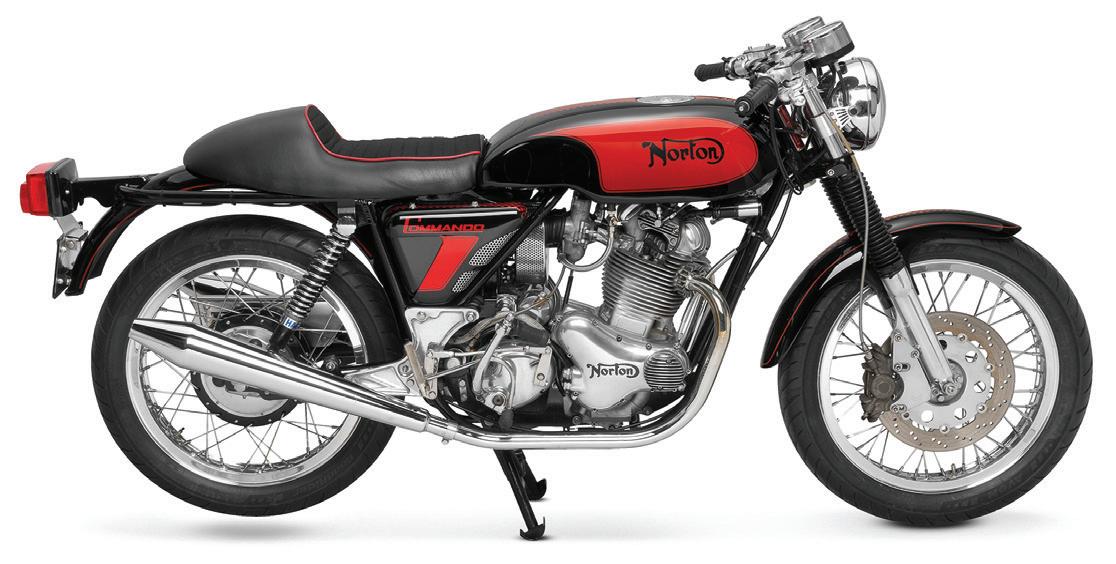
During the following three decades my job required that I relocate about every two years. No matter where I was sent it wasn’t long before I was able to connect with other Norton owners and British bike enthusiasts. I did everything on my Norton in those early years. I rode it to work, toured Colorado and many other states, all the while keeping it mostly stock. During this early period of Norton ownership I was making it a point to go to as many USNOA (what is now the INOA) national rallies as possible. I would eventually attend 16 nationals spanning the country from California to the mountains of Virginia. Each time I met many memorable people, some of whom are my best friends today. It was while attending the nationals through the years that I began to think about starting a local club. I’d been impressed to find so many people from the Dallas/Ft. Worth area at these events, so I started collecting names and phone numbers. I petitioned the INOA for a chapter membership and in early 1980 and started getting some of these guys together at my home in Irving. The next thing we knew we had a club. We realized that we didn’t have enough Nortons to maintain a purely Norton club so we decided to include all British and European marques as well. The North Texas Norton Owners Club was born.
In 1990 I noticed the Norton was burning a little oil out the left cylinder. It was time for a top end job! Of course, as these things usually go, it wasn’t long before I was loading up a bare frame and heading to the powder coat shop. It was then that things began to happen. When it was time for the reassembly I started looking around at all the Norton parts I had collected over the previous 17 years of ownership. Lo and behold, I had accumulated some pretty neat parts. During the rebuild I used most of what I had hidden away and later that year finished the highly modified red and black bike you see here today. Two years later in 1992 I took it to the Norton National in Tennessee along
with my freshly completed silver and black Commando. The red Norton took First Place in the modified class as well as the “Jim Balliro” award for technical excellence, named after the author of the Commando Technical Digest. The silver and black one also took First Place in the café class. Interestingly enough, 10 years later at the INOA rally in Utah the same bikes did a repeat, again winning best modified and best café exactly as they had 10 years earlier.
Over the years both Nortons have opened many doors and helped me make friends wherever I’ve gone. They have been featured in Cycle World and Classic Bike magazines, two of the most prominent publications in the field of motorcycles. In addition to my travels throughout the United States, my Norton has inspired me to make two visits to the National Motorcycle Museum in Birmingham, England, and a trip to the Isle of Man in 2007. All this is a direct result of having purchased the bike of my dreams so many years ago.
Time has passed and now my prized Norton is almost 50 years old. I’m that much older as well. Why is it that time passes so quickly, and why can’t I get a rebuild and some new parts for myself? But there’s no question I am a much richer man for having owned my Nortons! During our years together it has taken me down a road where I’ve made many friends, and it has enabled me to meet many famous racers, collectors, and enthusiasts who all share a love for Nortons and all things British. Two wives, one daughter and one granddaughter all know about Dad’s Nortons. We have shared a lifetime together and because of it I am forever enriched.
Yesterday I went for a ride on one of my Nortons, and the memories of so many good times and places came rushing through my mind. It has been my friend for the last 49 years of my life; a trusted companion as the years and miles roll by.
Story by Phil DansbyItem #11787 $34.99
Members: $31.49










In this completely revised and updated version of The Backroads of Route 66, author and Route 66 expert Jim Hinckley is your guide from the lowlands of the American Plains to the high plateaus of New Mexico and Arizona, from the Great Lakes to the mighty Pacific Ocean, and through major metropolises and remote country towns. But rather than taking the road oft traveled and the sites most photographed, Hinckley encourages you to branch off the Mother Road and discovers the hidden gems beyond today’s familiar motels and tourist traps—quaint frontier communities that date to westward expansion, the legacy of native cultures; and the aweinspiring natural wonders that have graced these lands since time immemorial. There to be explored within a few hours’ drive from the path of Route 66, discover outdoor attractions, museums, historic sites, and much more. The thirty trips in The Backroads of Route 66 offer new travel opportunities for you and the thousands of road-trippers who follow this legendary route, looking for something more. To
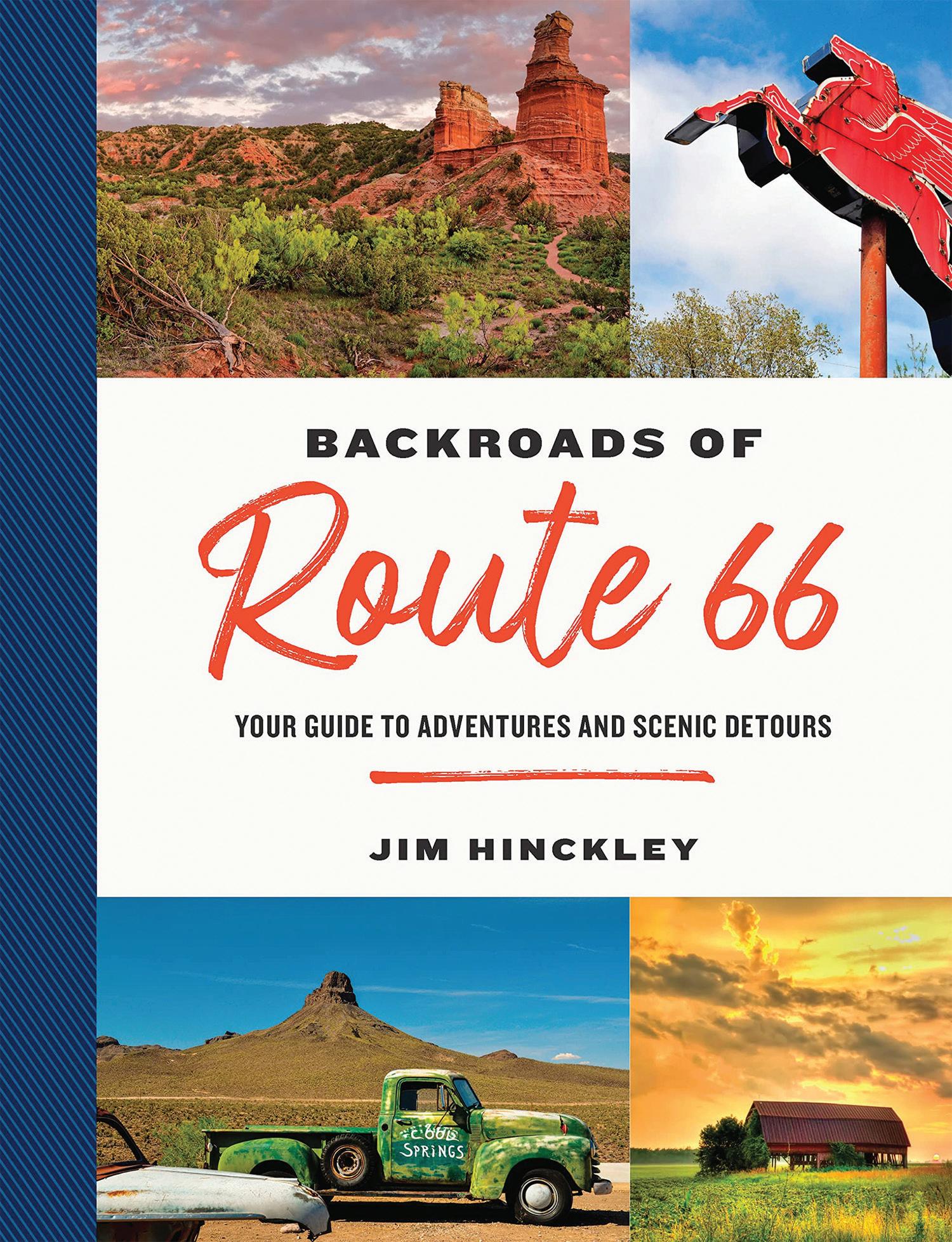
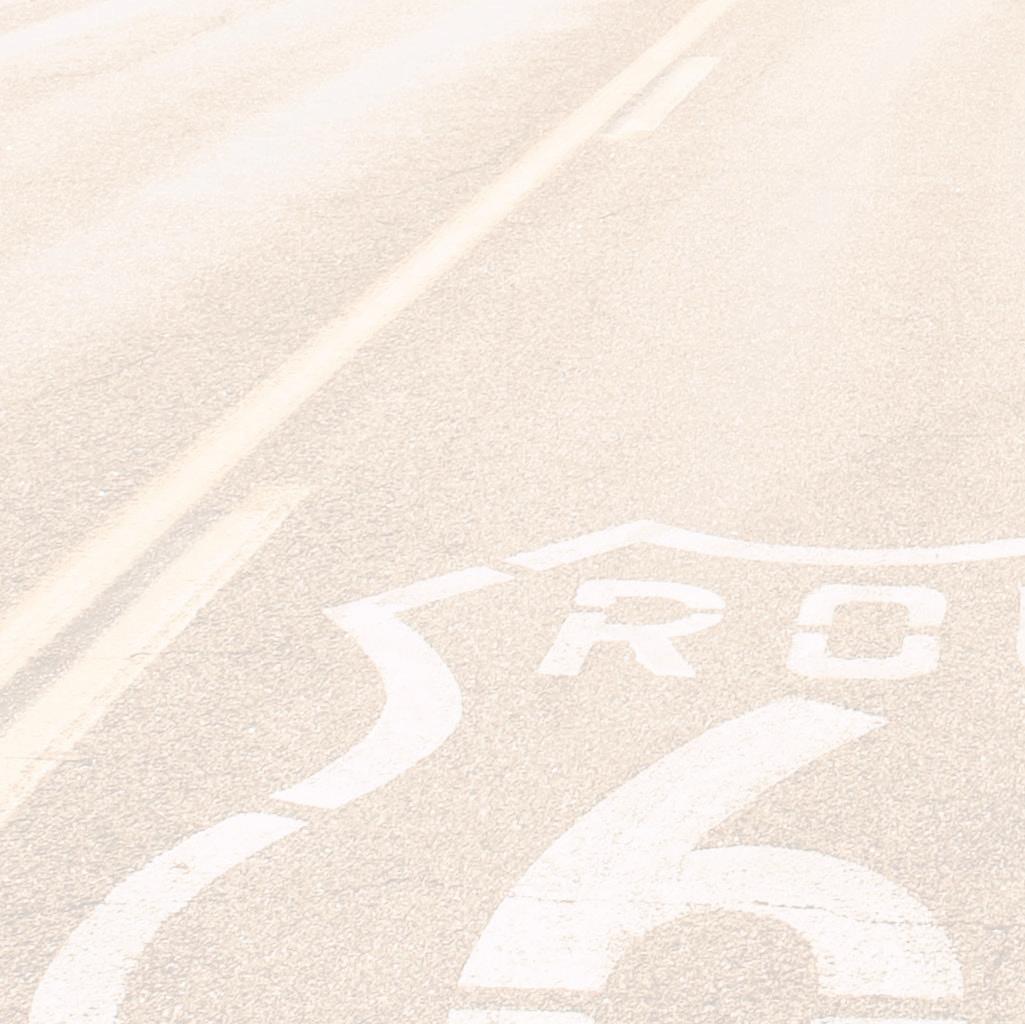
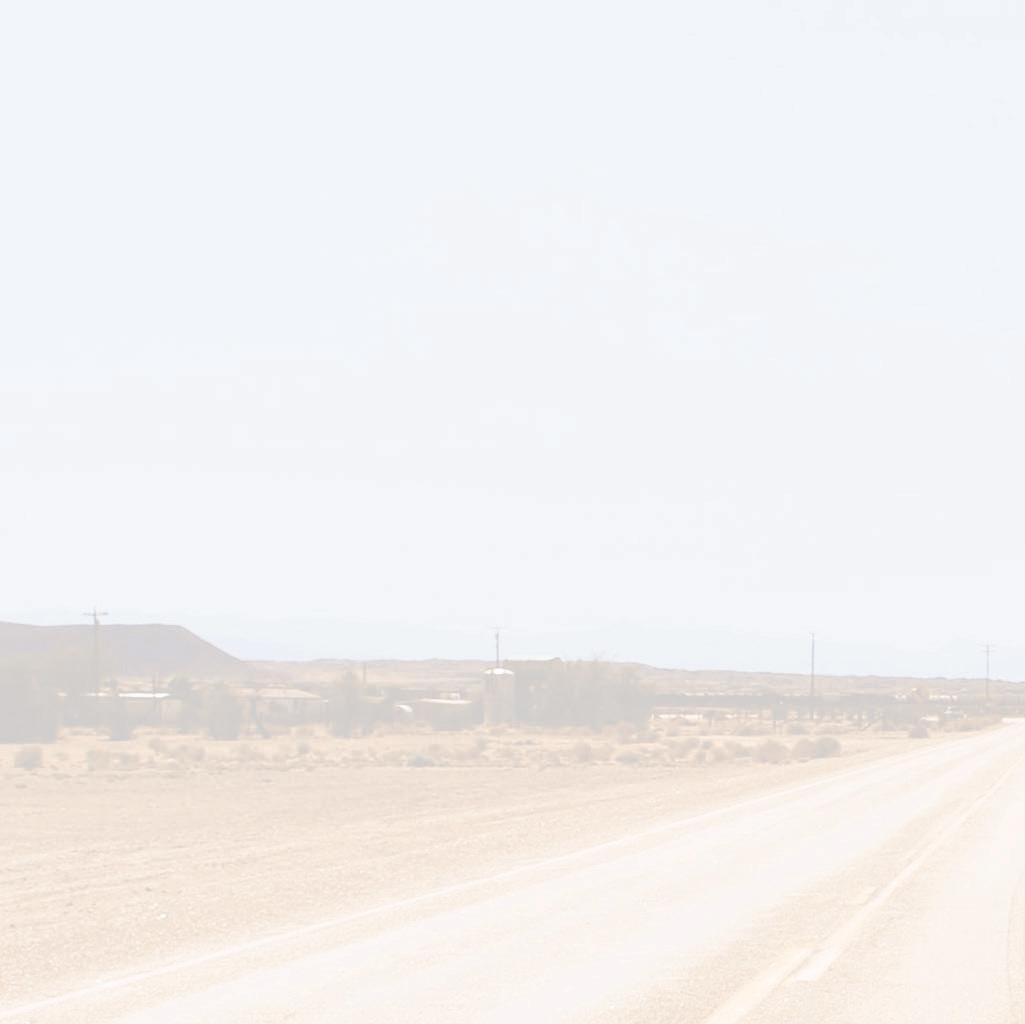
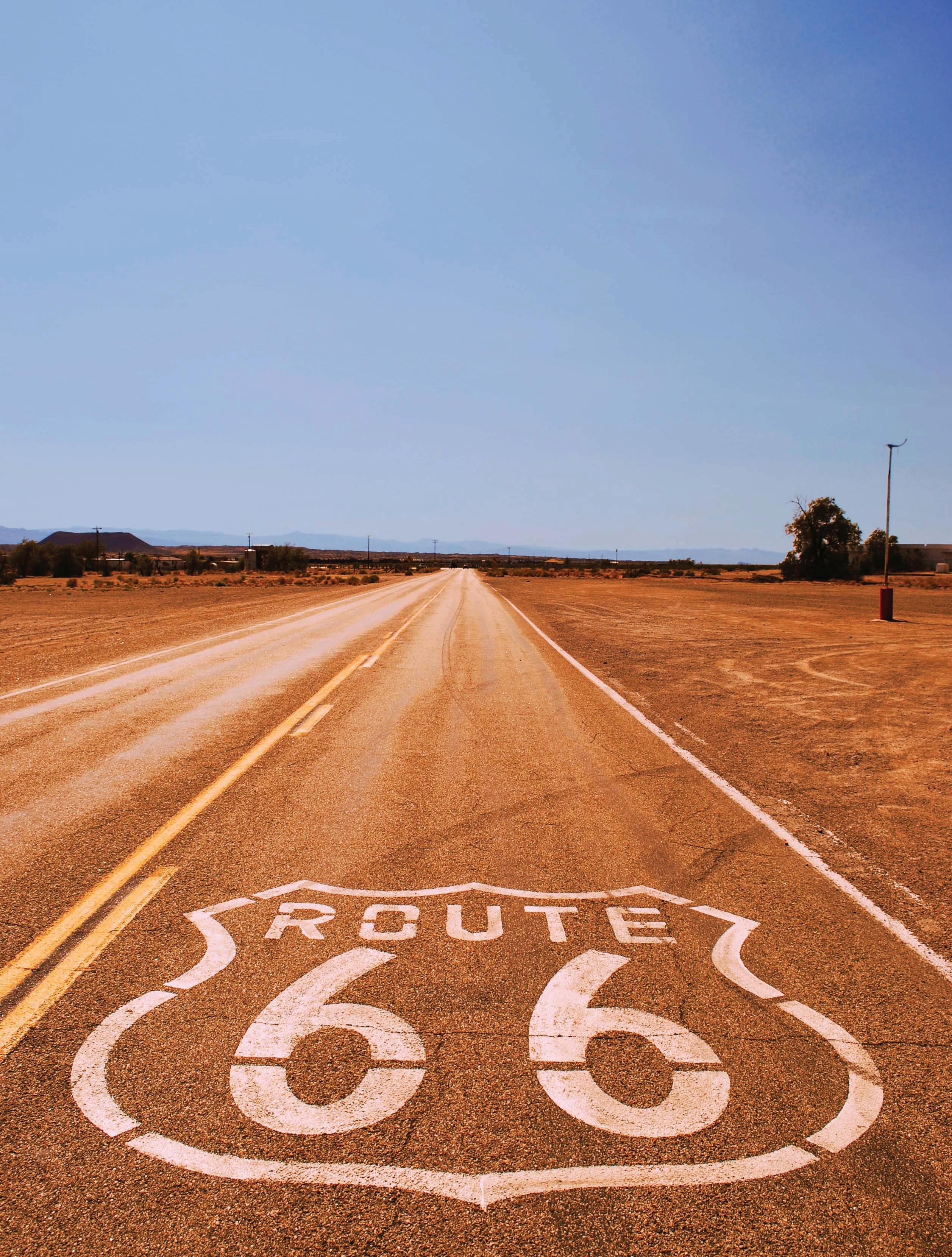
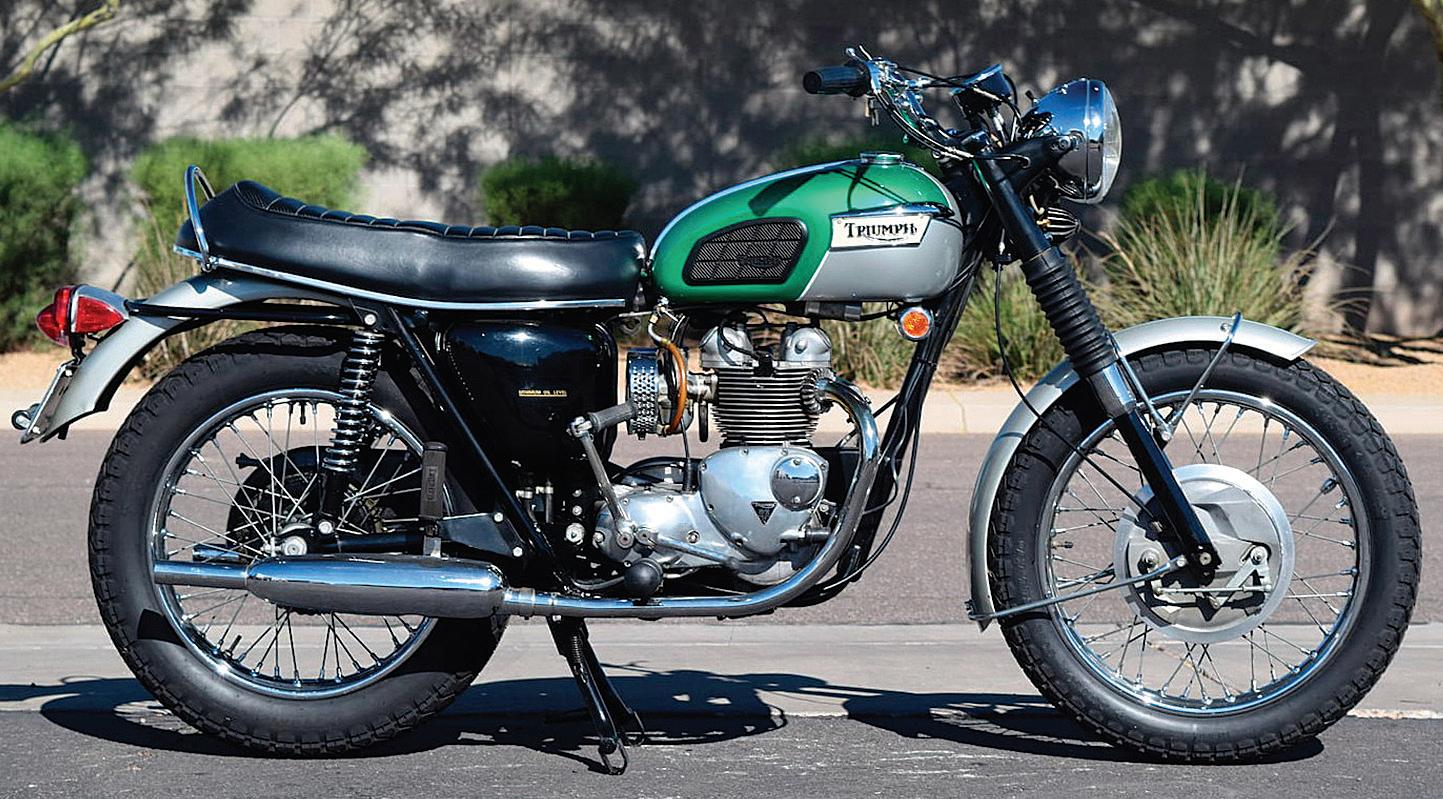
Buddy Elmore’s victory in the 1966 Daytona 200 is the stuff of legend. Lastminute fixes to his tuned-to-the-max race bike put him at the back of the grid in 46th place. Regardless, by lap 22 he had fought his way through the field and stayed in the lead to the finish, setting a record speed of 96.58mph.
Elmore’s victory was remarkable in many other ways: his 1966 racer looked surprisingly close to the street 500 except for a new cylinder head with dual Amal GP carburetors, energy transfer ignition, oil cooler, one-gallon oil tank, racing exhaust and strengthened swingarm. Inside the engine, Triumph’s Doug Hele had worked his magic to unlock the engine’s potential, but reliability suffered; and in completing the full 200 miles, Elmore’s bike was more the exception than the rule. (Gary Nixon’s 1967 winning engine was strengthened with a full ball and roller main bearing crankshaft. That year, Elmore finished second.)
Moto marketers have never been shy about naming their machines for successful racing exploits and their locations. Think: Le Mans, Thruxton, Sebring, Monza, Manx, Bonneville, and — of course — Daytona. Winning the “Handlebar Derby” at the famous Florida course was perhaps the most prestigious victory of them all.
all, though the transmission now shared its case with the engine. The new cylinder head topped the same iron cylinder barrels. The alloy rocker covers featured screw plugs providing access to check valve lash. Drive was by duplex primary chain to a 4-speed gearbox with gear position telltale. The Daytona ran on 3.25 x 19-inch front and 4:00 x 18-inch rear tires sharing the same 7-inch SLS drum brakes front and rear.
Upgrades for 1970 included a strengthened engine with ball and roller bearing bottom end, E3134 racing cams, revised front fork, and finally a decent front brake, the 8-inch TLS item from the Bonneville.
How did the Daytona compare with it bigger brother? It weighed in at 356 pounds dry, while the Bonnie claimed 387 pounds.
Top speed 105mph (period test)
Engine 490cc (69mm x 65.5 bore and stroke) air-cooled, OHV parallel twin
Transmission Duplex chain primary, wet multiplate clutch, chain final drive
So when Triumph racked up three wins in the 1960s with their 500cc Tiger twin, (Don Burnett in ’62, Elmore ’66 and Nixon ‘67), it was only a matter of time before the company capitalized on its successes. In late 1966, Triumph announced a new 500cc street sport bike based on the single-carb T100 Tiger but fitted with a new cylinder head featuring shallower valve angles, splayed intake ports to make room for twin Amal Monobloc carburetors, 9:1 compression, and Bonneville cams with larger followers: the T100R Daytona.
Weight 356lb (dry)
Price then/now $1,199 (1969)/$6,000-$15,000
Power was given as 39-41hp @ 7,400rpm for the smaller bike, and 46-50hp @ 7,000rpm for the 650. Seat height was 30-inches (31), and wheelbase 53.5-inches (56). This translated into a standing quarter of 14.9 seconds @ 90mph (13.9 @ 96) and a top speed of 105mph (112). The extra weight and power of the Bonnie cost potential buyers around $200 more than the Daytona’s $1199 list in 1969.
The drivetrain fitted in a new chassis with revised steering geometry and a stiffer swingarm mounting, but the rest of the bike was familiar Tiger territory. The 69mm x 65.5mm air-cooled OHV parallel twin’s heritage was easily traceable back to the 1937 Speed Twin, exposed pushrod tubes and
Though the Bonneville received the new oil-bearing chassis in 1971, the T100 continued with the lug and braze frame until the last Daytonas left the factory. Likewise, it never adopted the 1971-on TLS front brake, continuing to use the earlier (and superior) TLS brake from 1968. Nor did the Daytona ever get a front disc brake (though some 14 prototypes did escape the factory). Then in 1973 came the factory closure and the workers’ sit-in. Only the 750 Tiger and Bonneville were produced at Meriden after that.
Cycle World tested a Daytona in 1967, calling it “A café racer’s dream.” Cycle was equally gushing: “Nothing but good may be said of the Daytona as day-in, day-out sporting transportation. It is a fantastically comfortable bike …
Claimed power 39hp/41hp @ 7,400rpmStarting is a snap, for it fires very willingly. Add to all that the obvious quality of materials and care in workmanship and you have a lot to like.”



But six years later the Daytona was looking stale-dated. In a side-by-side comparo with the new Yamaha TX500, Cycle concluded that everything the Daytona does, the 4-valve,
electric-start, disc-braked TX “does better — except be a Triumph … and that is the best and as far as we can tell only reason for preferring it.” The last Daytonas were built at Meriden in late 1973. Buddy Elmore was killed in a street crash in 1975 aged just 39, and has yet to be inducted into the AMA Motorcycle Hall of Fame. MC

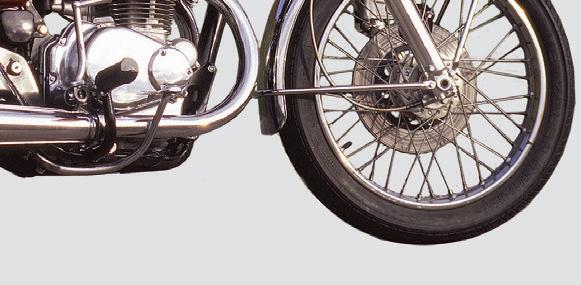
By the time Honda’s CB750 became the nail in the British motorcycle industry’s coffin, the Black Bomber had already closed the lid. With performance comparable to Triumph’s Bonneville, the CB450 also boasted double overhead camshafts, a twin leading shoe front brake and electric start. Perhaps even more important; unlike earlier pressed-steel-frame Hondas, the CB450’s tubular chassis looked right. Available only in black when it was first released, the CB450K was built around a shortstroke, 180-degree, 4-main-bearing crankshaft, which drove two overhead camshafts by chain. Valves were closed by torsion bar springs with eccentric adjusters. Drive to the 4-speed gearbox was by wet multiplate clutch with chain final drive.
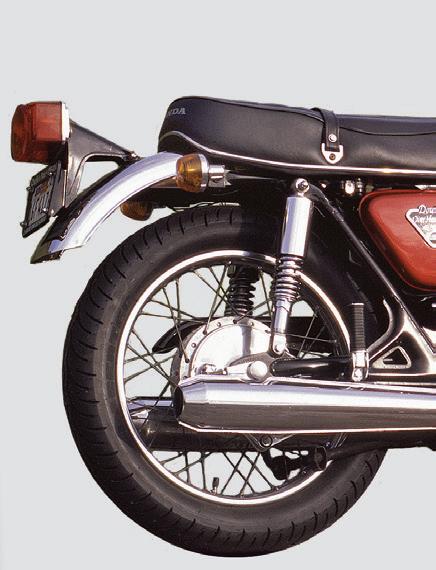
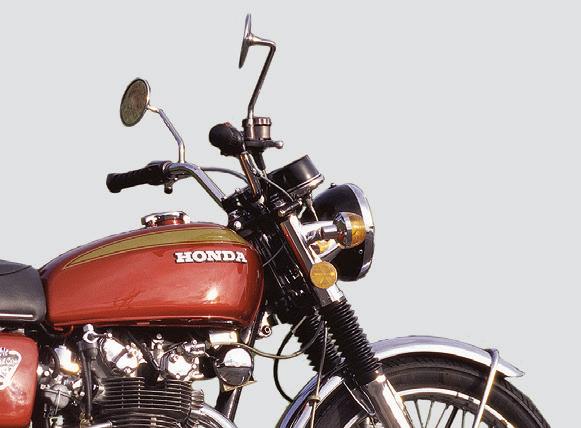
The drivetrain fitted into a single-tube cradle frame with conventional telescopic fork and dual spring/shocks on the rear swingarm. And the CB450 was continually revised and improved over its production lifetime in technology and aesthetics. For 1969, the new Super Sport K1 got larger valves, revised camshaft timing for an extra 2hp, a 5-speed gearbox and nitrogen-filled de Carbon rear shocks. A disc front brake was fitted for 1970.
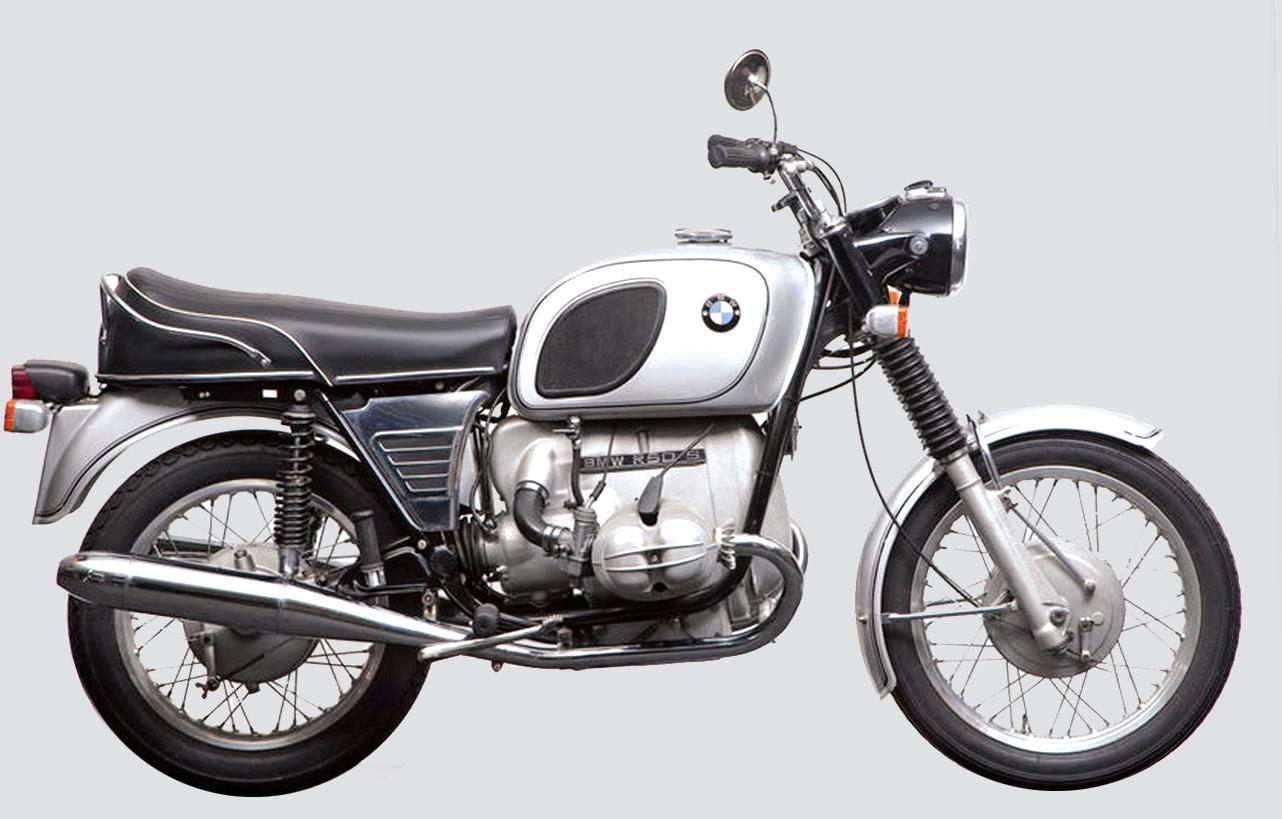
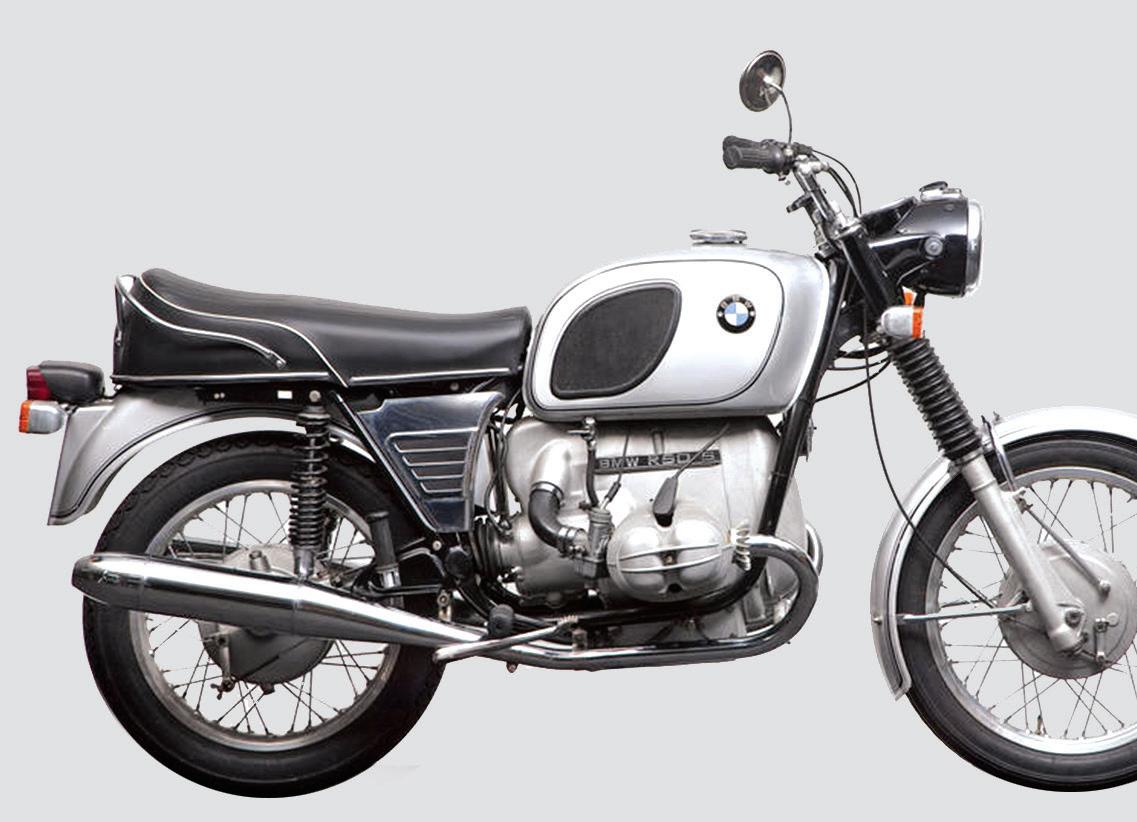
BMW announced the “Slash 5” series (R50/5, R60/5 and R75/5 of 500, 600 and 750cc) for the 1970 season — and a revolution in BMW motorcycle design. Though the basic flat twin “boxer” layout remained, just about everything else was new. The engine used a forged one-piece crankshaft (previously built-up) with plain-bearing rods (rollers). A duplex chain (gears) drove the camshaft, moved from above the crankshaft to below. Light-alloy cylinders replaced cast iron and were capped with redesigned cylinder heads fed by dual Bing slide carbs (CV on the R75/5). Twelve-volt electrics featured push-button start, though a kickstarter was retained. A single-plate, engine speed clutch drove the 4-speed gearbox, with shaft final drive built into the right-side rear swing arm. The tubular steel frame used duplex tubes with rear spring/shock units adjustable for pre-load with a simple hand lever. A telescopic fork controlled the front. The tires were 3.25 x 19in front and 4.00 x 18in rear tires. Brakes were 200mm drums, TLS front and SLS rear.
• Years produced: 1965-1974
• Power: 43hp @ 8,000rpm (1968-on, 45hp @ 9,000rpm)
• Top speed: 112mph (claimed)
• Engine: 444cc (70mm x 57.8mm) air-cooled, DOHC parallel twin, 9.0:1 compression
• Transmission: Wet multiplate clutch, 4 (5 1968-on)-speed gearbox, chain final drive
Cycle magazine tested a CB450 in November 1968, and while testers found the suspension stiff and the TLS front brake “marginal,” its handling was “on a par with the good middleweights, its toughness on a par all its own. Best of all, the bike feels right — everything tight, snug, rubber-mounted where necessary and working together.” They concluded: “The new Honda is beautifully engineered, clean, stylish, easy to maintain and quick. What more could you want in a motorcycle?”
• Weight: 420lb (curb, half tank)
• Years produced: 1969-1973
• Power: 32hp @ 6,400rpm


• Top speed: 97mph (claimed)
• Engine: 498cc (67mm x 70.6mm) air cooled, OHV flat twin, 8.6:1 compression
• Transmission: Dry clutch, 4-speed gearbox, shaft final drive
• Weight: 451lb (curb, full tank, 1970-1971), 440lb (1972-1973)
• MPG: 51 claimed





Though similar in weight to the R50/2, the /5 gained 6 horsepower, giving it a livelier performance, while the new frame and suspension improved handling. Moving the camshaft below the crank also meant the cylinders sat higher up, improving ground clearance. For 1972, the 4.5-gallon chrome-paneled “toaster” tank replaced the bulky 6.3-gallon item; and during 1973 the swingarm was lengthened by two inches. And while performance may not have been its strong point, the R50/5 developed a reputation for reliability and longevity. The 600 and 750cc engines were carried over
• Price then/now: $1,025 (est.)/$3,500-$8,000 to the disc-braked, 5-speed “Slash 6” range in 1974: the R50/5 was quietly dropped.
Cycle World tested a Daytona in 1967, calling it “a café racer’s dream.”

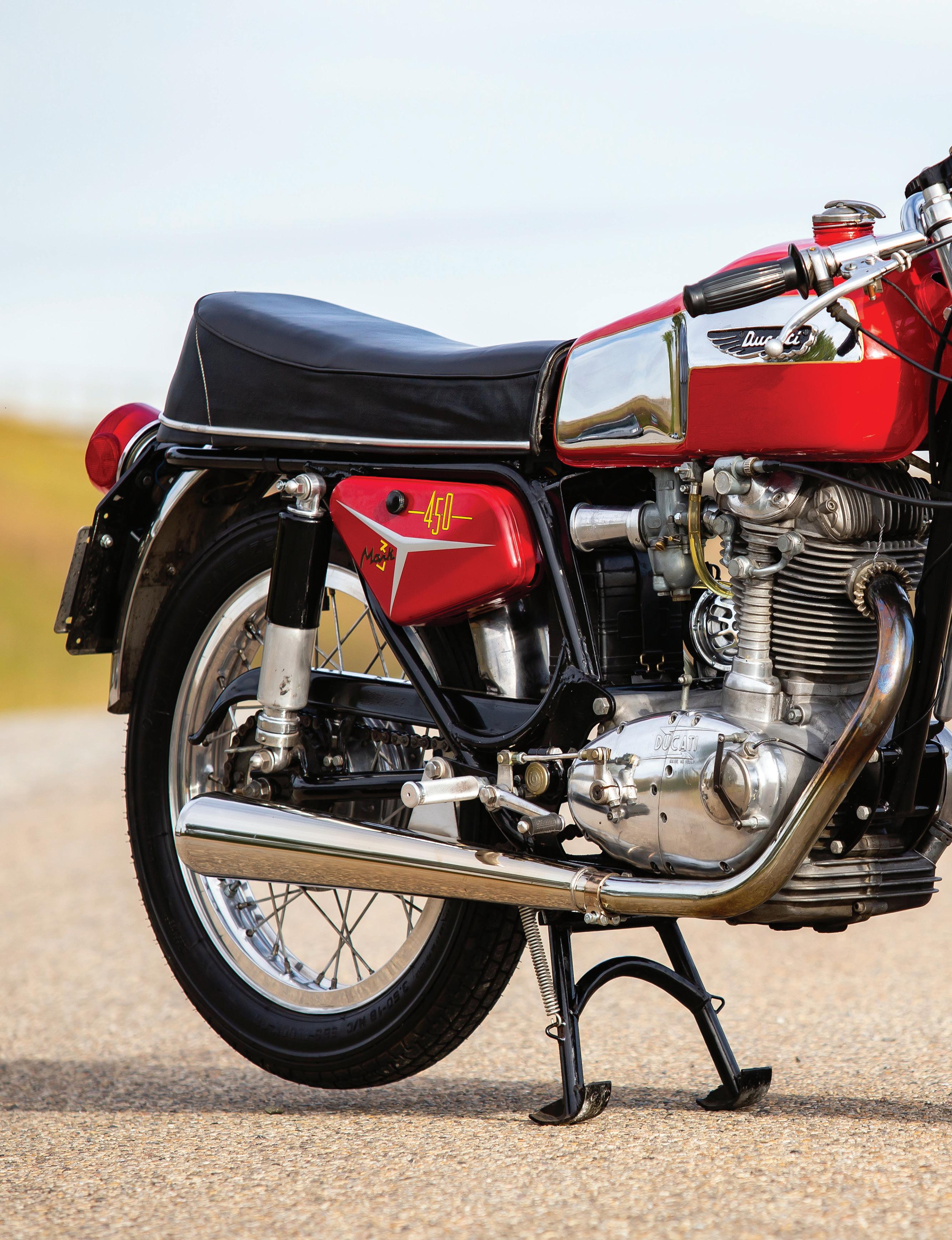
AA motorcycle is only a compilation of metal and rubber — it takes people to create the memories and stories behind the machine.

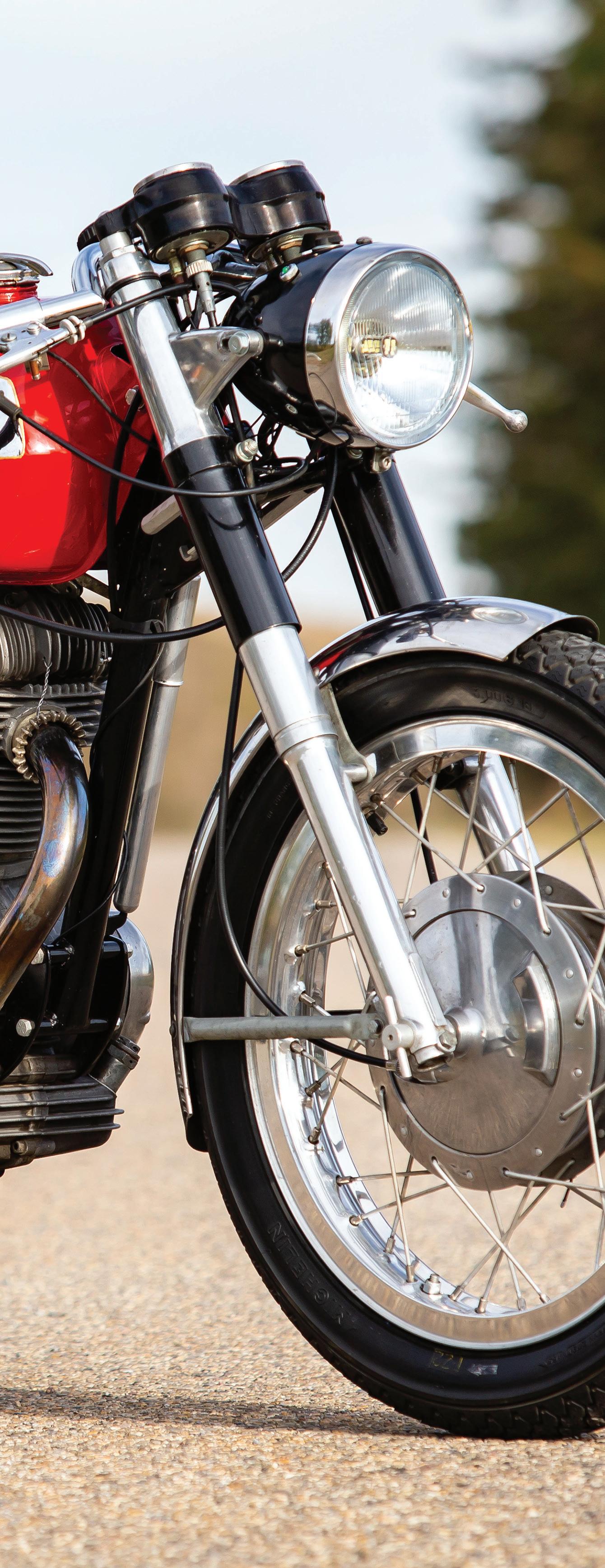
For example, the 1970 Ducati 450 Mark 3 seen here has a tale to tell. It starts in Calgary, Alberta, Canada, with Art Cartwright. Art was passionate about motorcycles and he had his father, Herb Cartwright, to thank for that. Herb rode and raced in the 1940s and ‘50s, and it was only natural that an interest in machines be passed along. Growing up, Art spent time working on and riding motorcycles, and during his high school years in the mid- to late-1960s, he rode almost year round on a BSA Golden Flash. During the cold and snowy winter months prevalent on the Canadian prairies, a homemade sidecar platform helped Art keep his motorcycle upright.
Art liked all motorcycles, including an Indian Chief he’d inherited from his dad, but he was particularly fond of British and Italian machines. He owned BSA singles including a Gold Star basket case, a Vincent and several Ducati singles. A First Class Journeyman welder, Art ran his own business and then became a Welding Engineering technologist. Passing along his knowledge, Art went on to teach others to weld, first at Red Deer College and then Calgary’s Southern Alberta Institute of Technology. In the early 1970s, Art met his future wife, Renee. “When I met him, he was commuting on motorcycles and building a Model T hot rod with a Studebaker engine,” she says. “That car won me over, and we had fun with it.”
First Class Journeyman welder, Art ran his own businologist. Passing along his knowledge, Art went College and then Calgary’s Southern Alberta Institute of Technology. In the early 1970s, his met him, he was commuting on motorModel engine,”
fun with it.”
Art and Renee married in 1977, and she says they often rode two-up until she bought her own Yamaha 650 in 1978. Not long after that, the couple was driving in North Calgary when Renee spotted a forlorn 450cc Ducati sitting on a front step with a “For Sale” sign. The asking price was $100, and Renee bought it on the spot. “It was filthy,” Renee says, “and I spent hours cleaning it up. After I was through, Art took an interest in it and got it running and back on the road for me.”
single-cylinder because
could hold it up with my feet flat on the
good. I also found it easy to start, but I have a keen knack for kickstarters.” As an example of Renee’s kickstarting prowess, she adds, “Herb’s
Renee continues, “I was drawn to the single-cylinder Ducati because I’m not a big person, and the bike was such a nice size for me. It really was lovely. I could hold it up with my feet flat on the ground, and the weight of the bike was so good. I also found it easy to start, but I have a keen knack for kickstarters.” As an example of Renee’s kickstarting prowess, she adds, “Herb’s
running-around bike was a singlecylinder BSA Victor, and neither Herb nor Art could ever really get it easily started. Well, I’d get it to start with a single kick — we’d joke about it all the time because I’m only 110 pounds.”
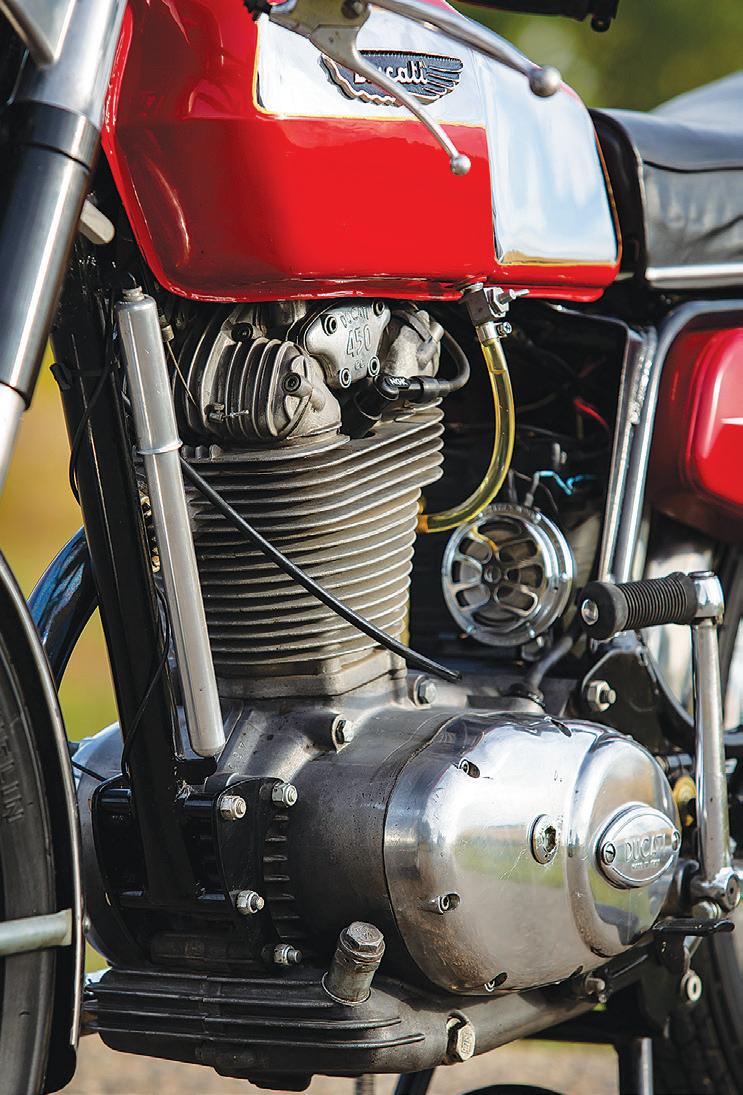
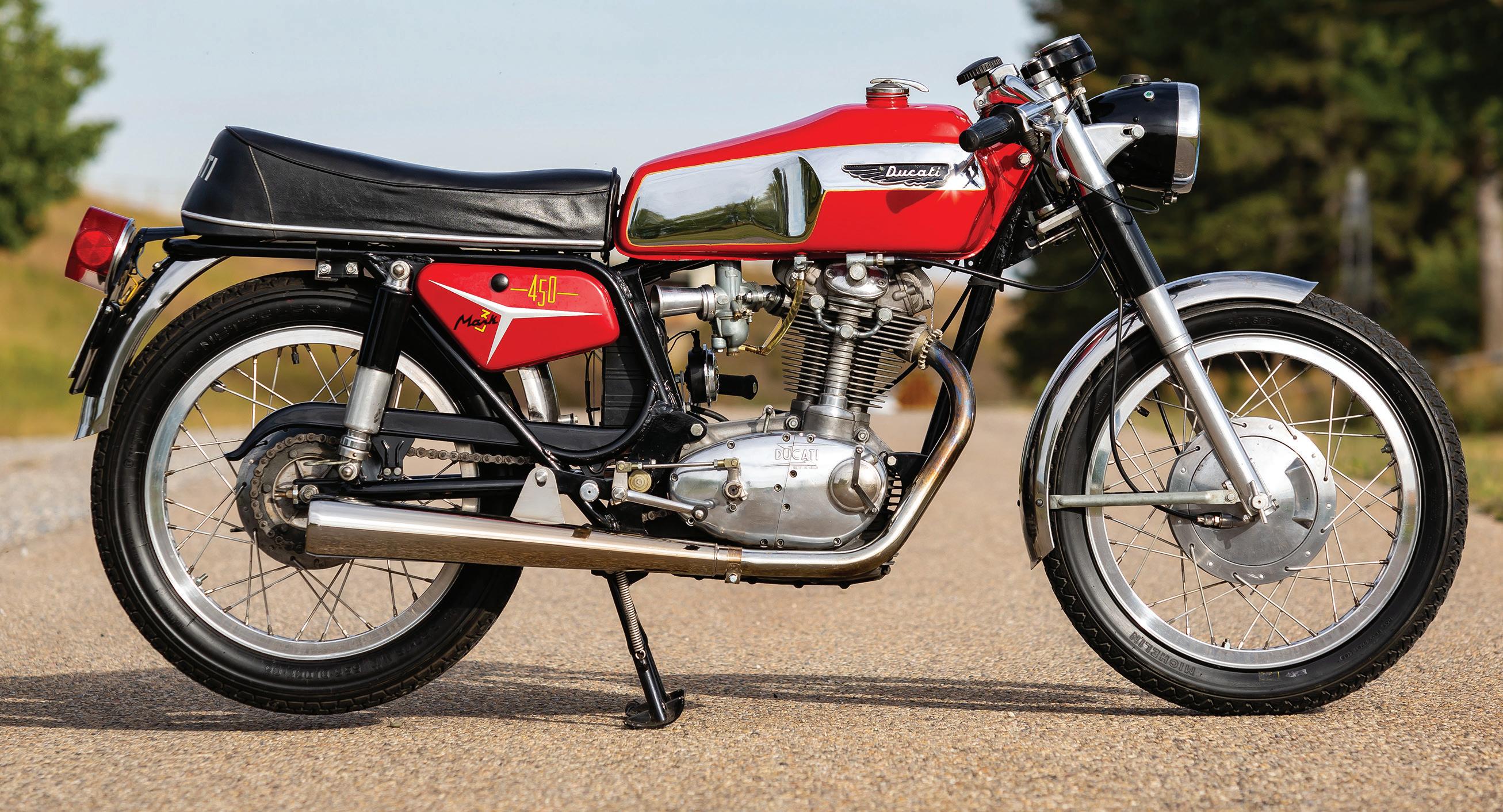
Engine: 435.7cc air-cooled bevel-gear driven OHC 4-stroke single-cylinder, 86mm x 75mm bore x stroke, 9.3:1 compression ratio, 25hp @ 6,500rpm
Top speed: 95mph (approx.)
Carburetion: Amal 930
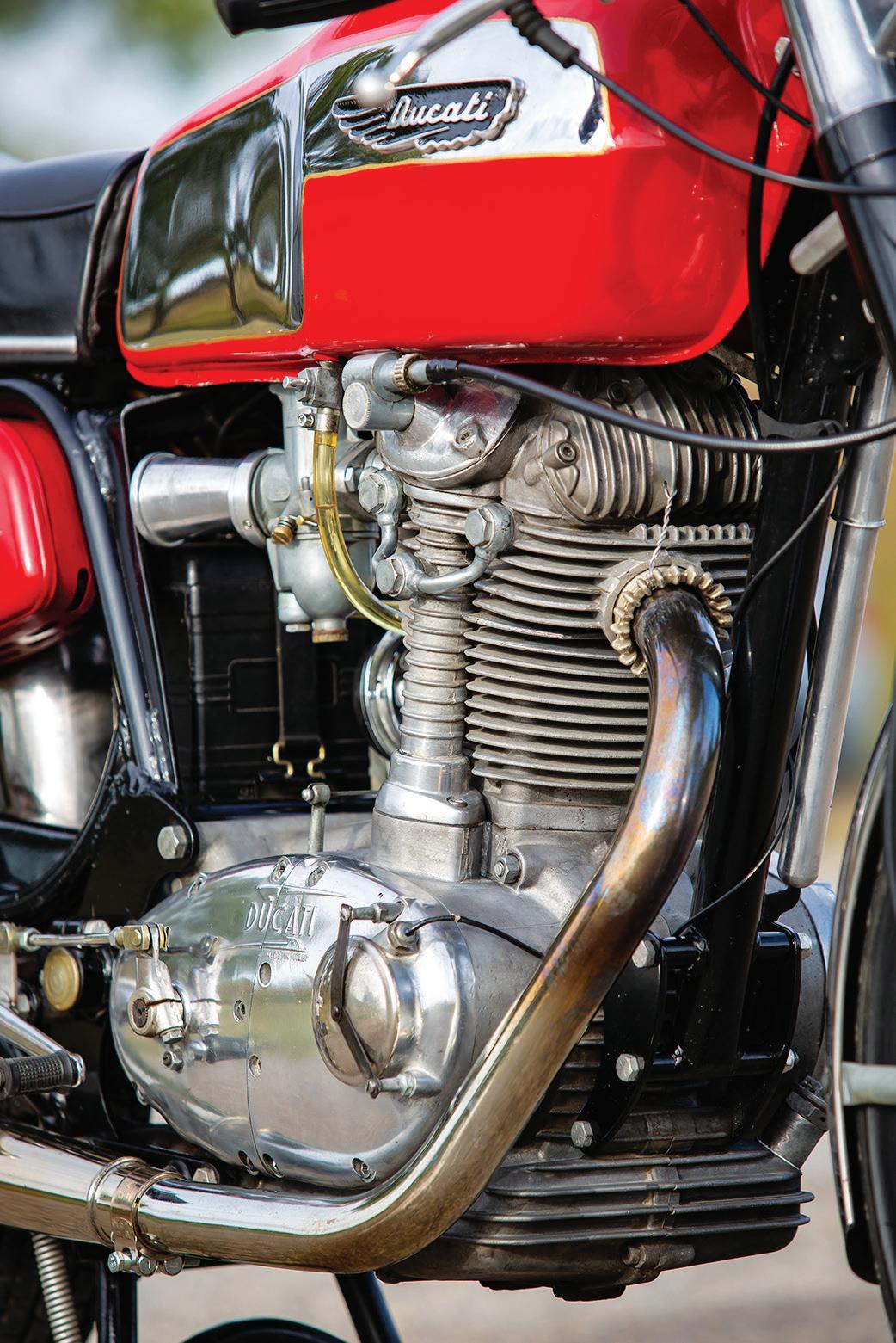
Transmission: 5-speed, chain final drive
Electrics: 6v, points and coil ignition w/6v/70w alternator
Frame/wheelbase: Tubular w/engine as stressed member/53.5in (1,360mm)
Suspension: 35mm Marzocchi telescopic front fork, dual Marzocchi shock swingarm rear
Brakes: 7.1in (180mm) drum front, 6.3in (160mm) drum rear
Tires: 2.75 x 18in front, 3.50 x 18in rear
The Ducati 450 was ridden occasionally by Renee, and by the late 1990s the bike was partially disassembled to put another of the family’s Ducatis back on the road. That machine was a 250cc Scrambler that Art had hopped up with the top end of a 350cc Ducati, and it needed a set of wheels. With the 450’s wheels on the Scrambler, Art and Renee’s then 16-year old son Geoffrey rode the bike to a Vincent Owners Club North
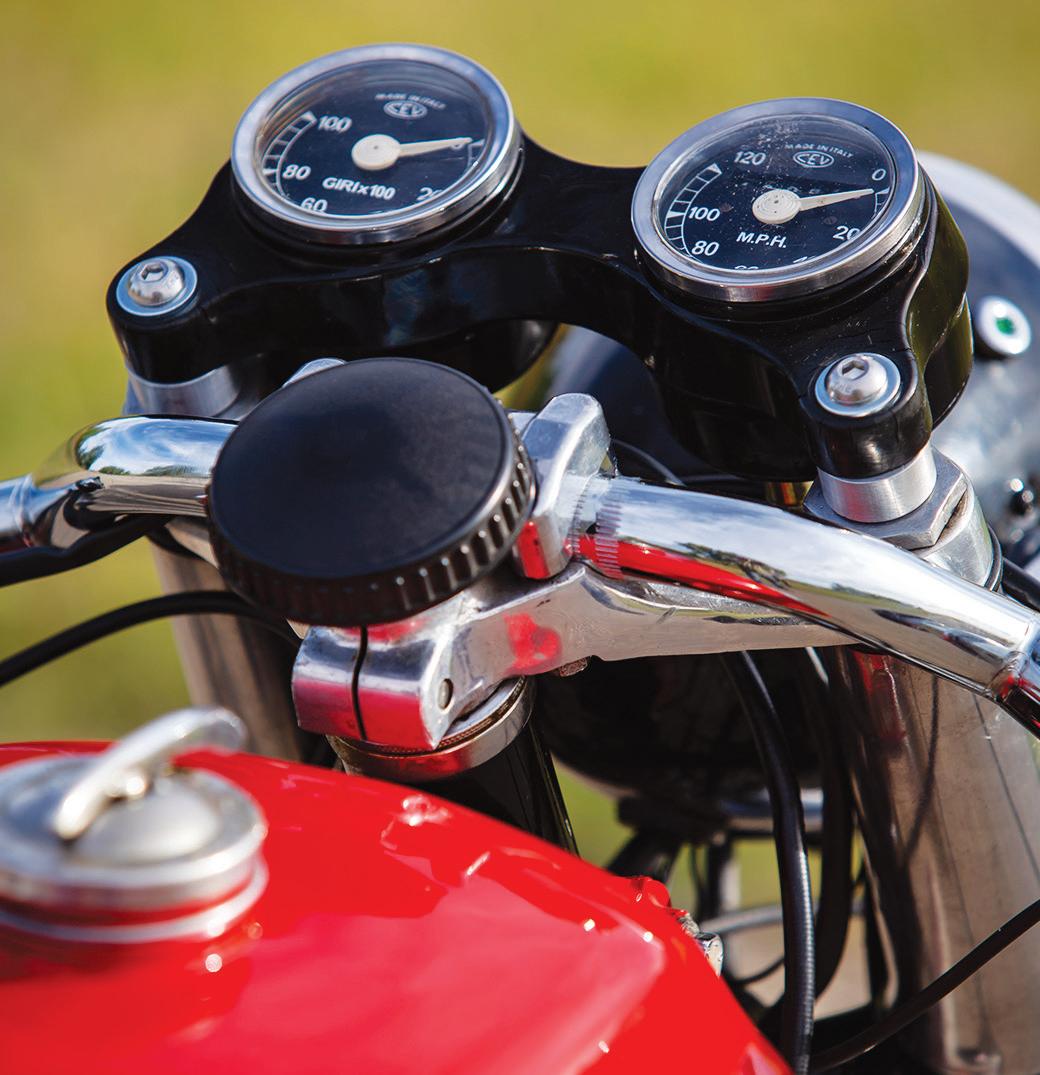
Weight (dry): 286.3lb (130kg)
Seat height: 29.5in (749.3mm)
Fuel capacity: 3.7gal (13.5ltr)
Price then/now: $1,050 (Canadian, 1970)/$4,000$10,000 (U.S)
American Rally in Washington. After that, Renee’s 450 simply languished in the garage — until Art’s arthritis was preventing him from riding his 1976 Triumph Bonneville. “Art had bought that Triumph new in ’77,” Renee says, “but he had arthritis in his hips, hands and knees and the Triumph was getting heavy for him. In 2018, he started to put the lighter Ducati 450 back together so he could ride that.”
Art planned to be riding the Ducati in the summer of 2019. He was remarkably close when, just two weeks after his 70th birthday, Art suffered a heart attack and died. While understandably difficult for the family, Renee began the process of working
through Art’s collection of machines. Geoffrey got three of them, while new homes were sought for several others. “I had quite a long history with that Ducati and I loved riding it, but I’d given up motorcycles in the early 2000s,” Renee says. “I have regrets about the Ducati being taken apart and not put back together, and it was great Art was working on it when he was, but it needed to go to a new home.”
That’s when Calgary motorcyclist Bob Klassen entered the picture. Bob’s garage is currently home to a number of preunit Triumph twins, including a Triton and a 1963 Bonneville. In the past, he’s owned and ridden BMWs, Harley-Davidsons and a few Ducatis, including a Mille S2 and a 916. But for some time, he’d been keen to find an older single-cylinder Ducati. He often rides with a group of friends, a couple of whom do have 250cc Ducati singles. “We’d have conversations about these little Ducatis, and that sort of awakened something I wasn’t even aware I was harboring,” Bob says. In early August 2021 when he heard Renee was selling the Ducati 450, he says, “I was excited to go and see it, and meeting with Renee and Geoffrey and getting the story behind the
bike was cool. Physically, what I saw was a Ducati with not a lot of miles (there were just over 8,800 on the odometer), and it had been worked on by someone well-known and respected in the vintage bike community.”
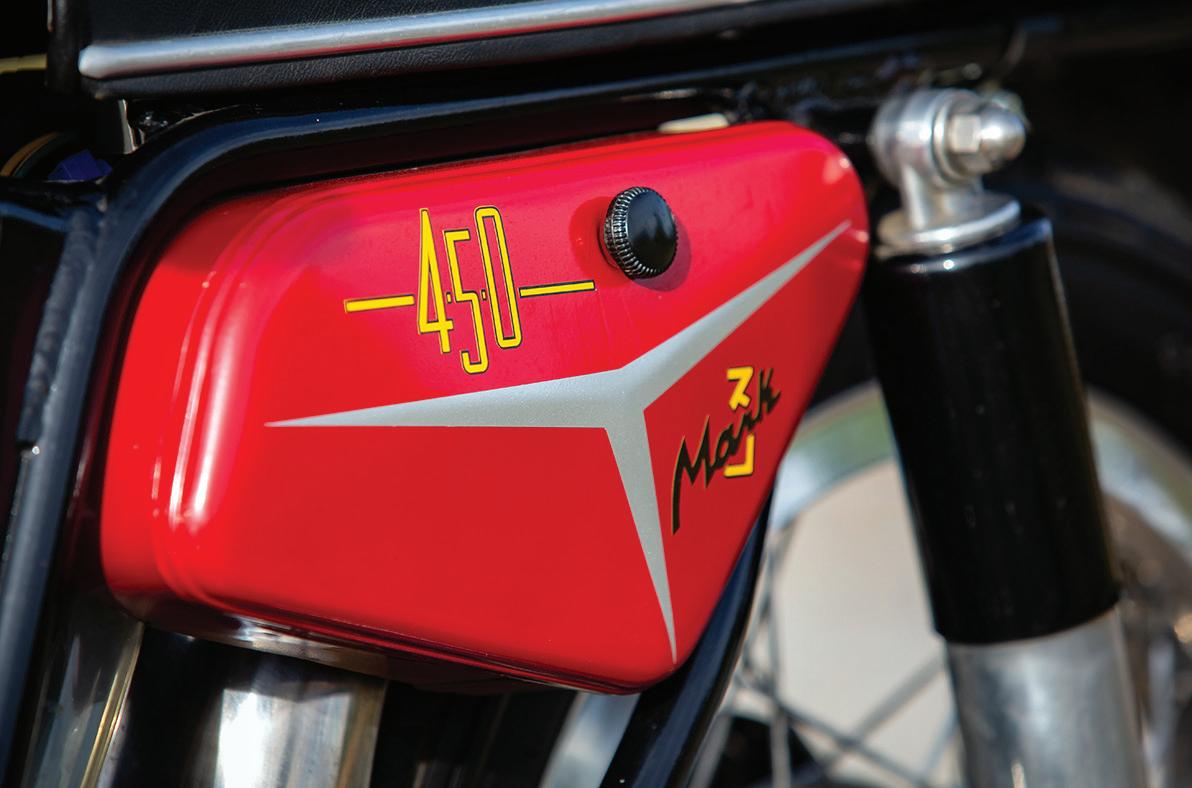
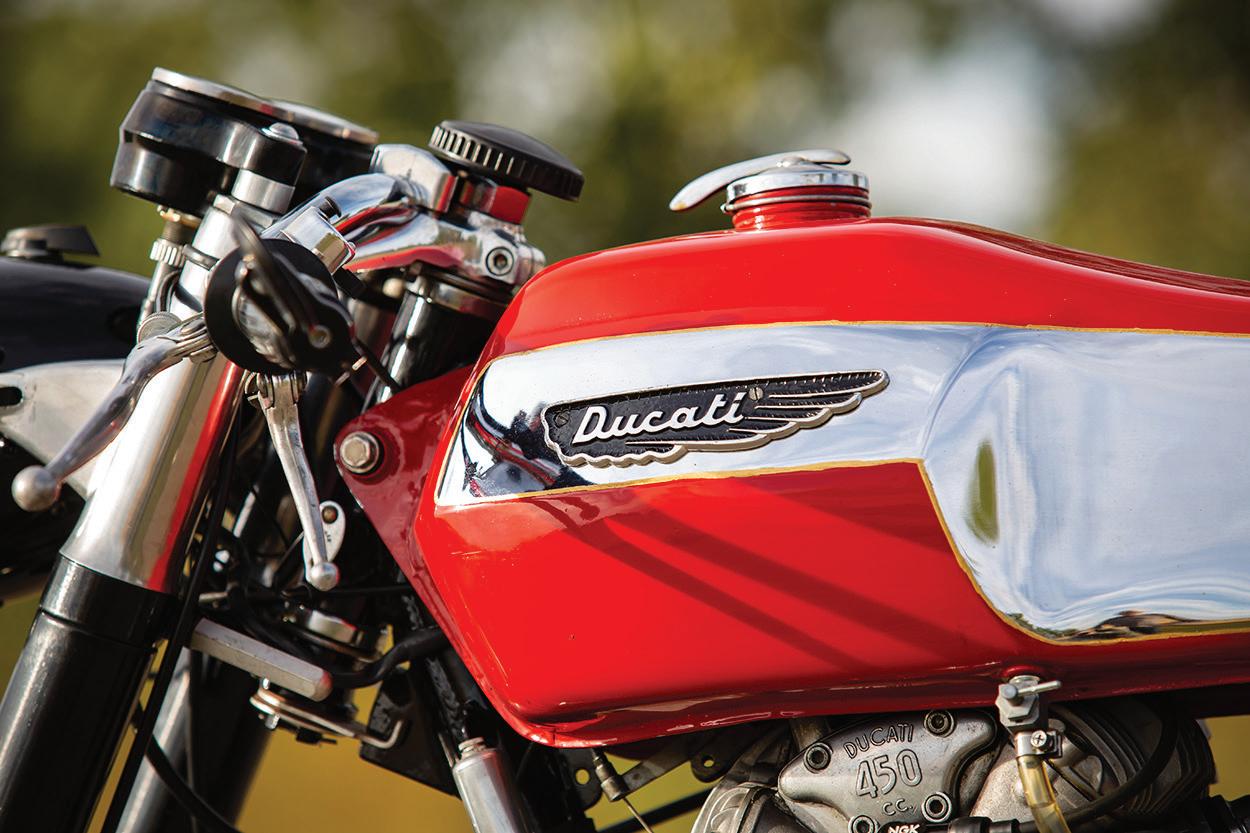

Essentially, Art had started a cosmetic restoration. The frame and just about anything else in black had been freshly powder coated. The 450cc overhead-cam engine, complete with a manifold to hold an Amal 930 carburetor to the intake, was in the frame. The front fork and wheels were in place, and a Scrambler-style tank was atop the machine. Mechanically, the bike looked to be in a condition to run, but the wiring harness was incomplete and no cables had been installed. Art had the makings for cables with inner wire and sheathing new in bags. The seat wasn’t mounted, but it was in good condition. Art had been setting the Ducati up as an around-town runabout and had installed signal lights. While in Renee’s garage, Bob noticed a near mint condition chrome and red coffin-style Ducati single tank sitting on a shelf and
negotiated the sale of the tank with the Ducati.
A box of spares, including the correct square-slide Dell’Orto VHB 29 carburetor, a couple of books and six pages of Art’s handwritten notes went with the bike. Reviewing Art’s notes, Bob says it appeared he’d devised a way to rebuild what are considered to be non-rebuildable rear shocks. He’d also had some work done to the stator, noting the original wiring was losing its protective insulation.
With the bike in his own garage, it didn’t take Bob long to make up clutch, throttle and decompressor cables. He removed the signal lights and spent time sorting out the wiring. With a 6-volt sealed lead acid battery in place, Bob familiarized himself with the starting drill. With gasoline fed from a test tank, the Ducati fired right up. “As soon as I got it running,” Bob says, “I had no doubts about getting it through Alberta’s inspection program in order to get it registered, and at that point, I’d like to think I’d brought Art’s vision to the finish line.”
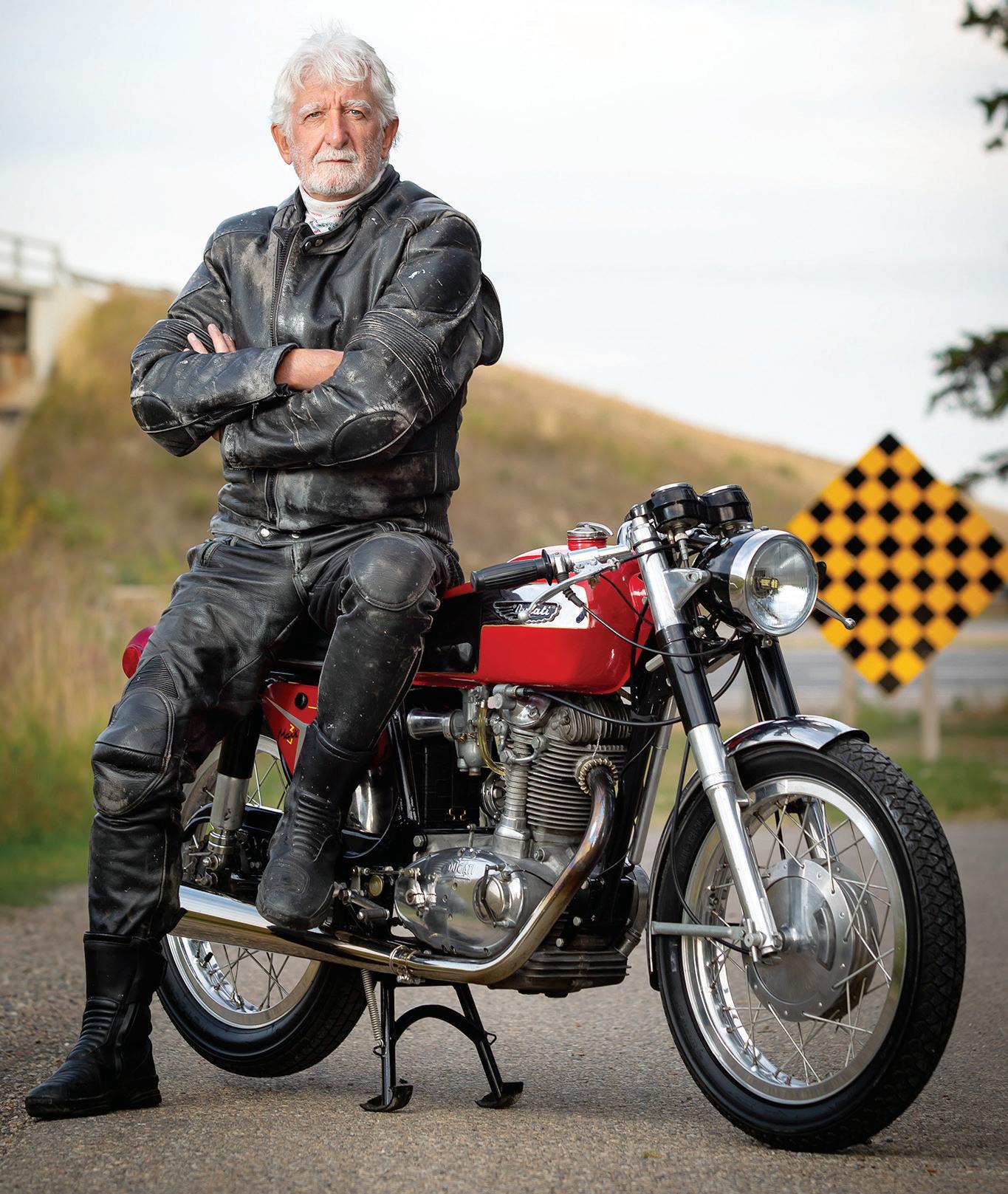
Now, it was Bob’s turn to pay some attention to the Ducati. According to author Ian Falloon in his Standard Catalog of Ducati Motorcycles 1946 – 2005, the 450 Mark 3 was introduced in 1969 but they didn’t reach America until 1970. Falloon notes the 450 Mark 3, distributed by North American importers Berliner in the U.S., was essentially dropped shortly after
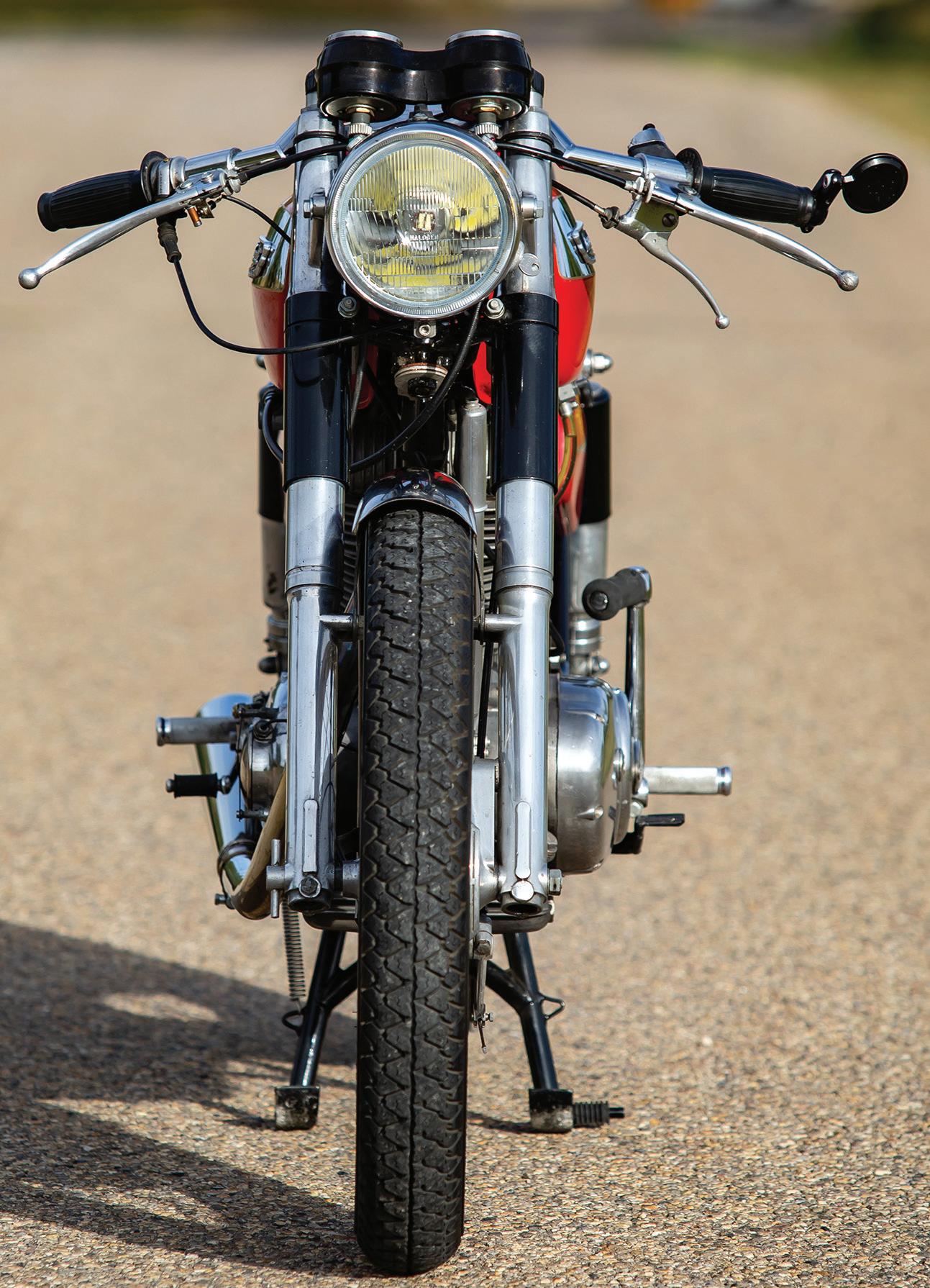
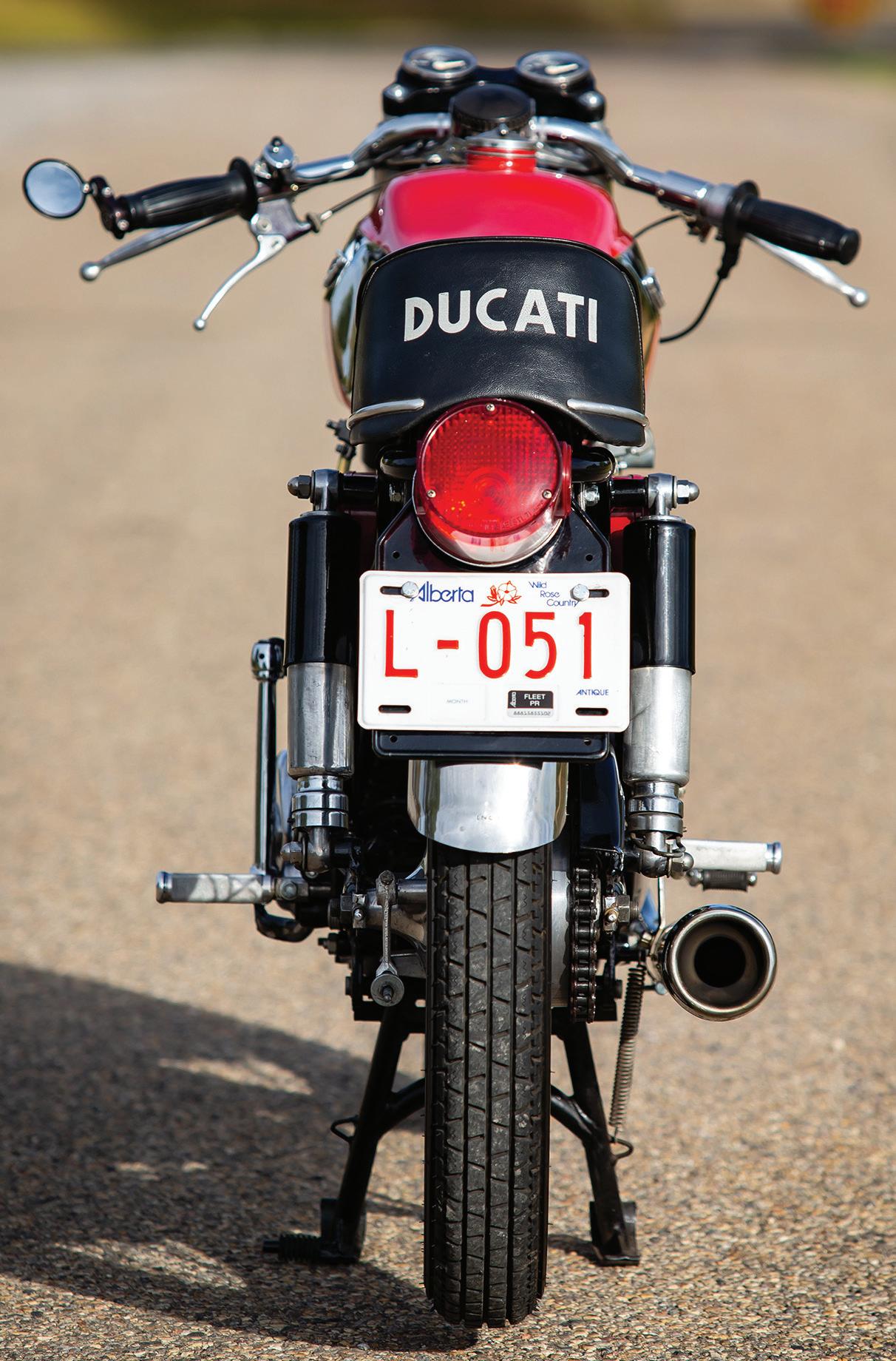
1970. The Ducati situation in Canada was somewhat different, as the machines were imported by Montreal-based Franco Romanelli and distributed from there to dealers such as Chariot Cycle Ltd. in Winnipeg. A 1970 catalog from Chariot Cycle lists the 450 Mark 3 for $1,050.
Most of the Mark 3s sent to America had a painted 13.2liter (3.48-gallon) Scrambler tank, but some did come with the far prettier coffin-style tank. To Bob’s eye, the slightly longer 13.5-liter (3.56-gallon) coffin-style tank that he bought with the bike was much more attractive. It mounted easily in place of the Scrambler tank. Because it was longer, however, it changed the geometry of the seat mounting

points, and Bob had to adapt the mounting brackets to make the saddle work with the tank.
“As I became familiar with the Ducati’s characteristics — it’s light [286.3 pounds dry], it’s got a short wheelbase, and that engine has plenty of torque making it a responsive and nimble package — I made a decision to turn it into something in line with its capabilities,” Bob explains. He shaved approximately 14 pounds from the Ducati. The side stand was removed and its mounting plate, which is the left side front engine plate, was replaced with a plain plate. Cast iron foot pegs were taken off and custom alloy rearsets fabricated. To move the right-foot shifter, Bob modified two



Somewhat overshadowed by its twin sibling 450 Mark 3 D (D for Desmo), the 450 Mark 3 is essentially the exact same model, but without the desmodromic overhead valve actuation. Prior to 1969, Ducati offered a number of single-cylinder machines ranging in capacity from 100cc to 350cc. In North America, the most popular sizes were the 250 and 350, and by 1968 Ducati had redesigned the frame of these bikes with twin frame tubes from the backbone down to the swingarm pivot. This necessitated widening the
rear of the engine case, and after that alteration, these models are known as “wide case” machines. In 1969, Ducati enlarged the single-cylinder engine to 436cc; the engine could not have gone to 500cc because, as author Ian Fallon notes in his Standard Catalog of Ducati Motorcycles 1946 – 2005, “the 75mm stroke was the largest that could be used with the crankshaft throw missing the gearbox.” This larger engine was first installed in a reinforced 250/350 Scrambler frame, and the street-going 450 Mark 3 and Mark 3 Desmo fol-
lowed shortly after. Built from 1969 to 1974, in its last years of production (1973-1974), according to Falloon, only 613 of the non-desmo 450 Mark 3 models were produced — with very few of them entering the North American market. In his book Ducati Singles Restoration, writer Mick Walker explains, “Hardly any of the 1971-72 bikes reached either the American or British markets, as both importers (Berliner and Vic Camp, respectively) were in dispute with the Bologna factory over prices.” — Greg Williams
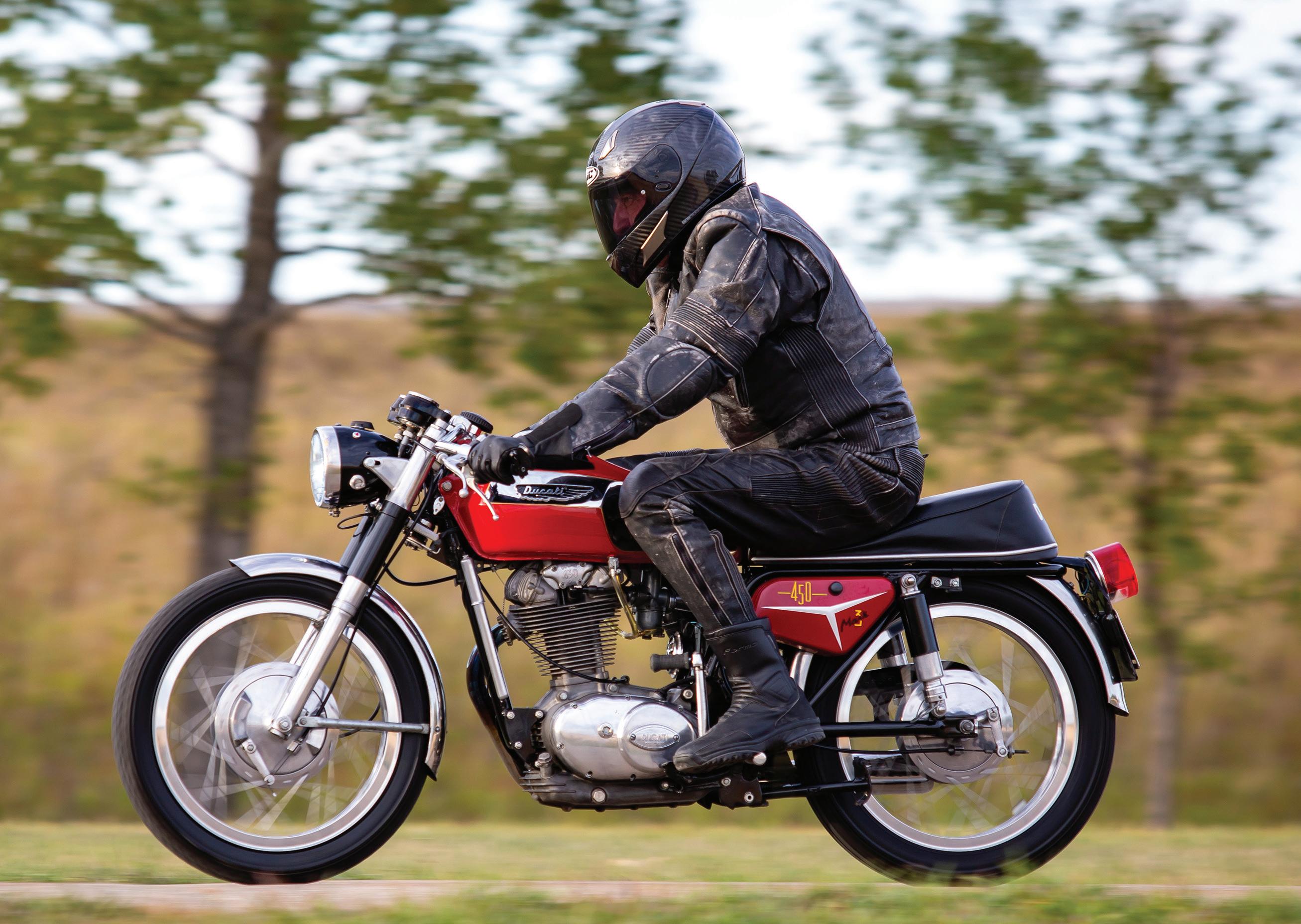
original shift levers, connecting the two with a linkage rod from another Italian bike project. On the braking side, Bob cut and removed a length of the pedal to make it compatible with the rearset peg position.
While Bob did rebuild and fit the Dell’Orto carburetor, he was never happy with how the bike ran and returned to the modified Amal 930. He did make a new manifold adaptor, though, to bring the carb closer to parallel to the ground — Art’s mount had the carb tilted up at 12-degrees. Bob added several hundred miles to the Ducati during the fall of 2021 but had trouble keeping the battery in a happy state. Without the battery, the points and coil ignition system would quit producing spark and leave him at the side of the road. He suspected the voltage regulator as well as the low-cost sealed lead acid battery were to blame. Some of the battery failure issues could possibly be chalked up to vibration, but Bob says the 450 Ducati doesn’t really vibrate as noticeably as some vintage British twin-cylinders he’s ridden.
In the end, he rectified the problem with an updated voltage regulator and a traditional wet-acid battery. “The bike had a Dunstall silencer on it and I found that to be a bit restrictive above 4,500rpm,” Bob says. In late spring 2022, he ordered a Continental-style megaphone from Feked.com and installed it on the header. “It runs much nicer with that silencer fitted,” he notes. Most recently, to suit Bob’s taller stature, he removed the low rise handlebars and installed café-racer Ace bars to tuck himself closer to the gas tank. “I’m not as upright and it’s a more aerodynamic riding position, and it’s very comfortable for me.”
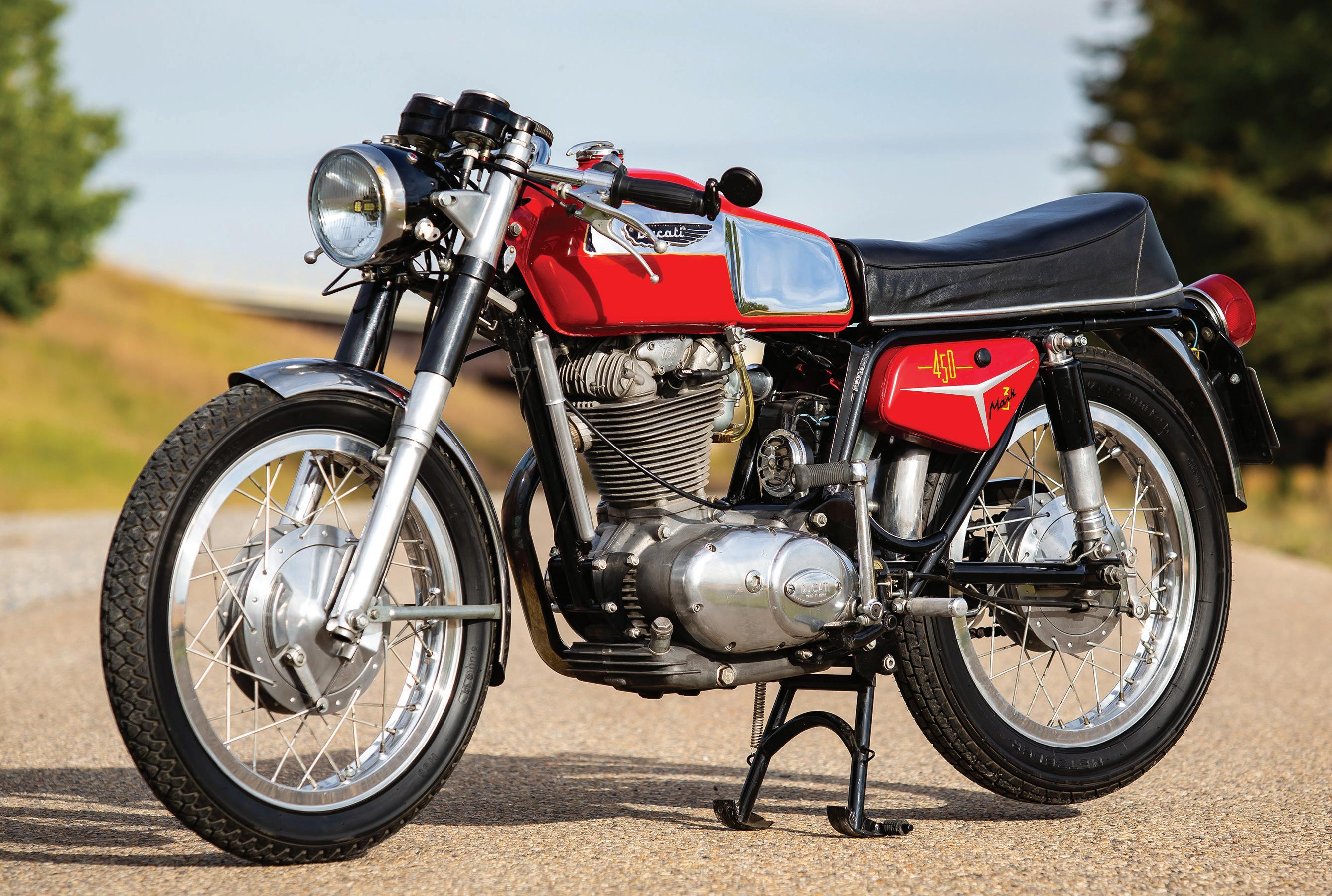
Since returning Renee and Art Cartwright’s Ducati to the road, Bob’s put close to another 2,000 miles on the CEV

speedometer. He’s happy to have been adding more chapters to the evolving story of the Ducati 450 and is convinced the top end has never been off the bike, given the state of the fasteners. Bob plans to soon take it apart to confirm the state of the bore, piston and rings and valves.
Renee appreciates the dedication Bob has shown the little Ducati, and concludes, “I’m so happy it’s found a good home, and that Bob has put his own stamp on that bike. That makes it even more special.” MC
Phil Aynsley has been a fan of Ducati since he bought his first motorbike, a 250 Desmo, in 1972. Aynsley’s love for Ducatis is matched only by his passion for photography. “Ever since buying my first in 1972, I’ve been taking photos of them. How could you not?” After 30 years, he hasn’t tired of his beloved Ducatis and is revered by the motorcycle industry as one of the best photographers in the business. Ducati lovers will relish Volume 2 with its expanded section on Road and Race bikes and a raft of new photos not previously released. It’s a must-have for any Ducatisti! This title is available at store.MotorcycleClassics. com or by calling 800-8807567. Mention promo code: MMCPANZ5. Item #11380.
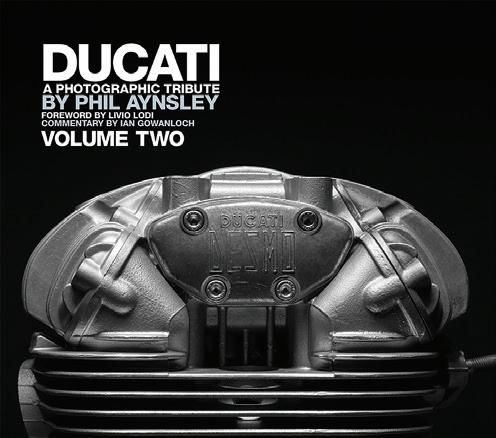

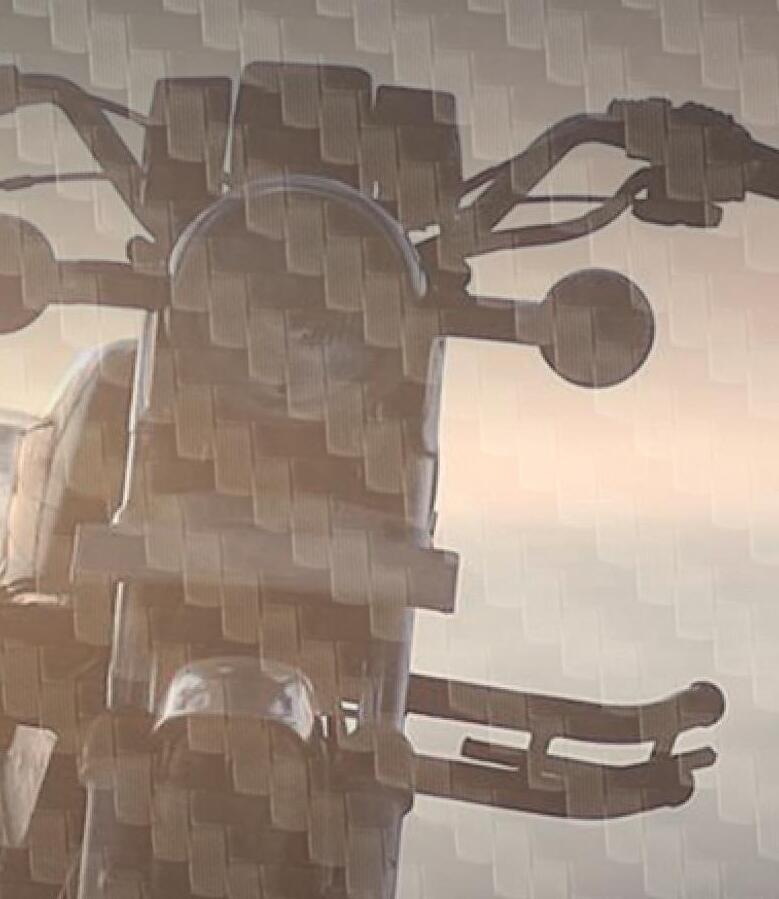

























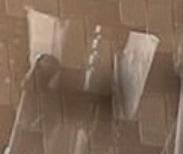





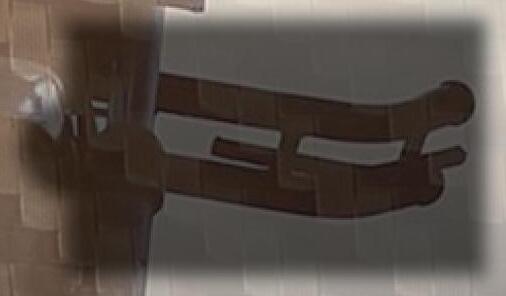



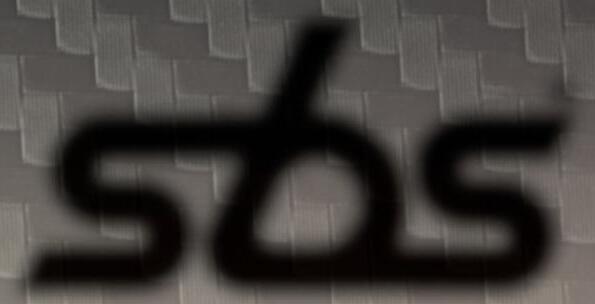

Photos by Nick Cedar
T“Together with the 250cc Hawk, the Super Hawk was the first truly modern motorcycle most Americans encountered: pushbutton starting, reliable electrics, fantastic brakes, 100-plus-mph performance, incredible SOHC sophistication and impressive smoothness.”
— Phil Schilling, Cycle World
After World War II, America was invaded by light, good handling British motorcycles. The English factories made money, the stockholders were pleased and the good times appeared to stretch to the horizon — except for one little problem. Management forgot to upgrade the machine tooling that made the motorcycles. It was not possible to develop the product and, eventually, quality control suffered.
At the same time, Japan, thoroughly ruined in World War II, was struggling to get back on its feet. The Japanese saw salvation through technological upgrades and quality control. With public transportation in disarray, there was a large internal market for small, reliable motorcycles. Soichiro Honda designed such a bike, but, not content to just sell to fellow countryfolk, Honda wanted to export. To do so, he had to overcome the then-bad reputation of Japanese products. In the Forties and Fifties, many people in Europe and America believed “Made in Japan” meant cheaply made, tinny and unreliable. Honda, determined to change that perception, started by arranging bank loans and purchasing Swiss and American machine tooling to the tune of one million 1952 dollars. His shareholders were much more patient than British shareholders, and were content to wait for the investment to make a profit. Although Honda paid his workers about what British workers were paid, Japanese executives did not demand English salaries. Profits were plowed back into the business. By 1959, the same year that Honda started exporting to the U.S., Honda was the world’s biggest motorcycle company.
Honda’s American subsidiaries’ first best seller was the Super Cub, a 50cc step through that spanned the gap between bicycle and motorcycle. Seeking to sell bigger bikes, Honda quickly learned that Americans wanted speed, looks,
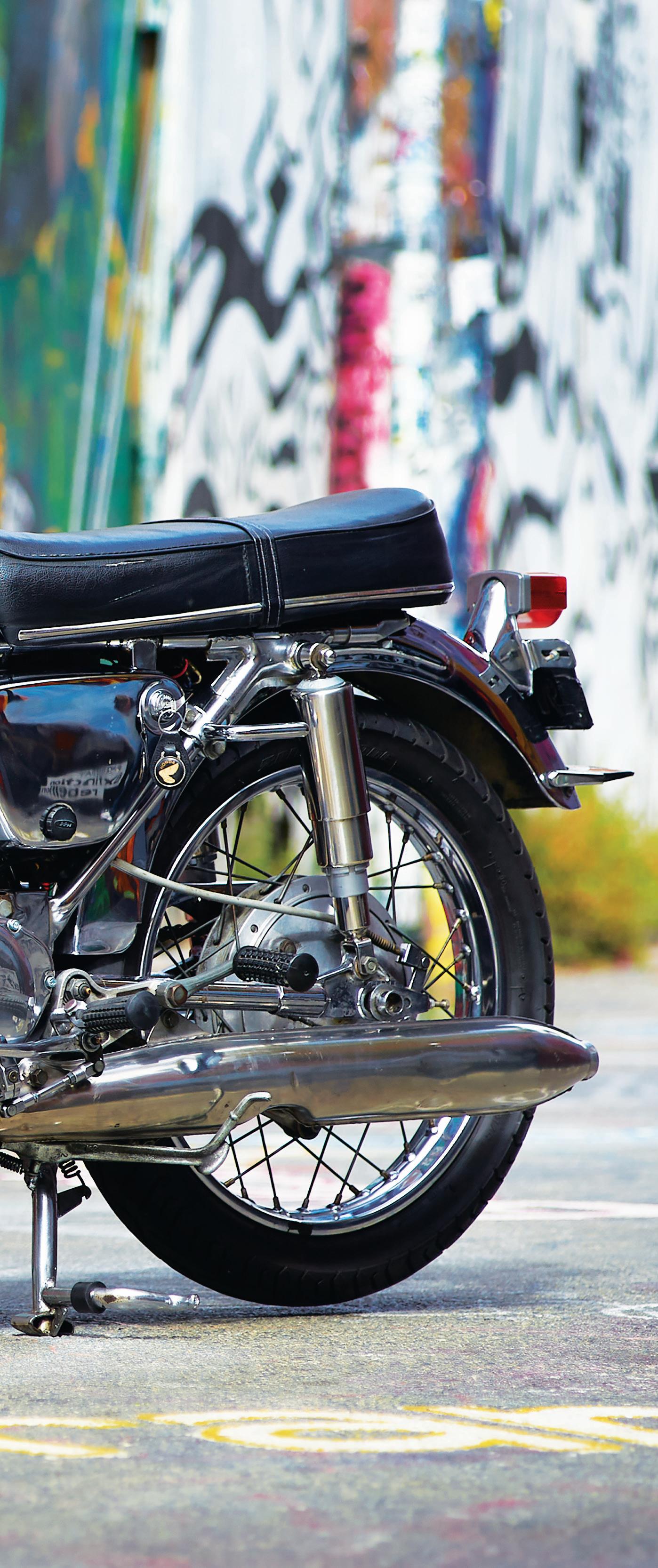
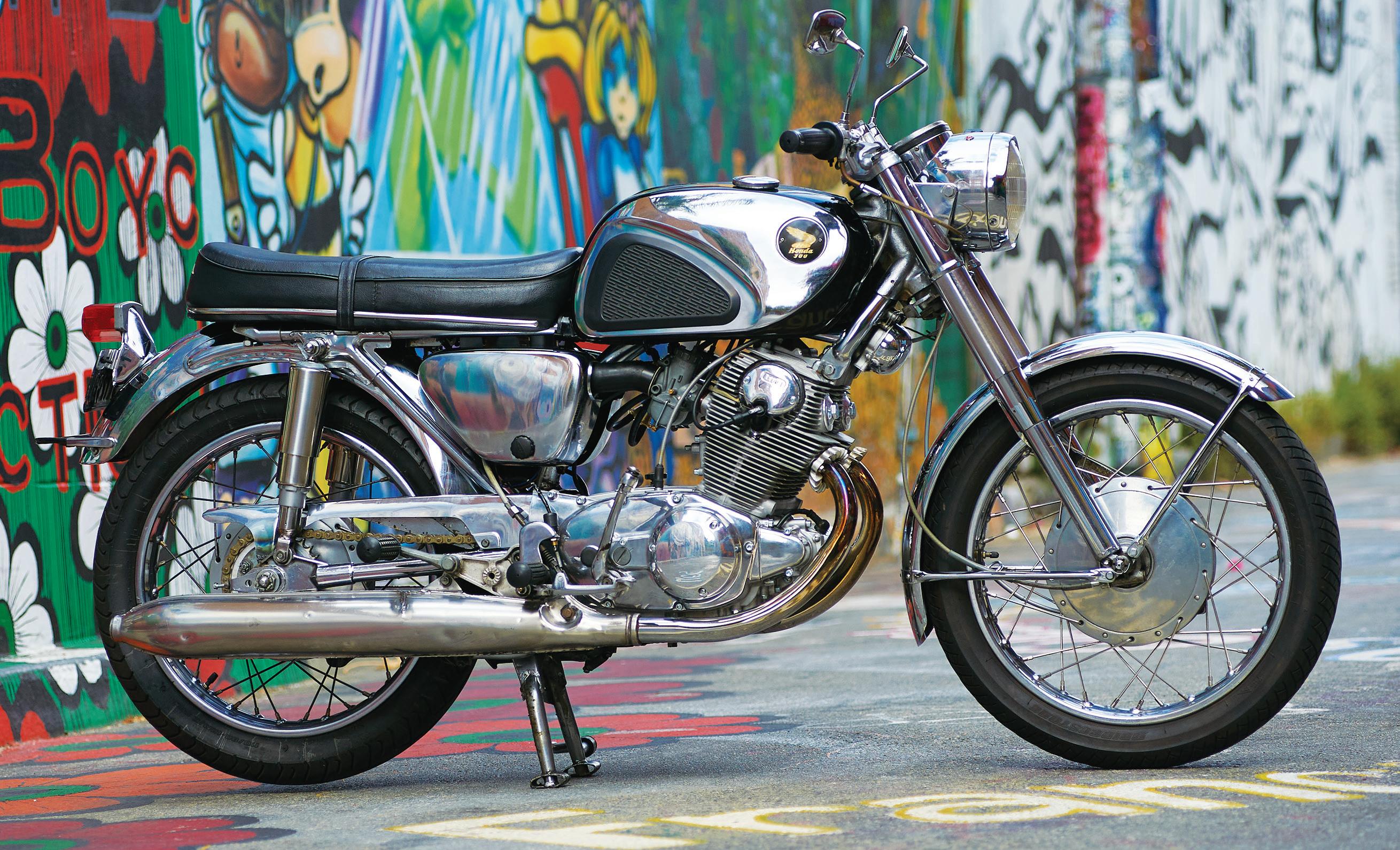
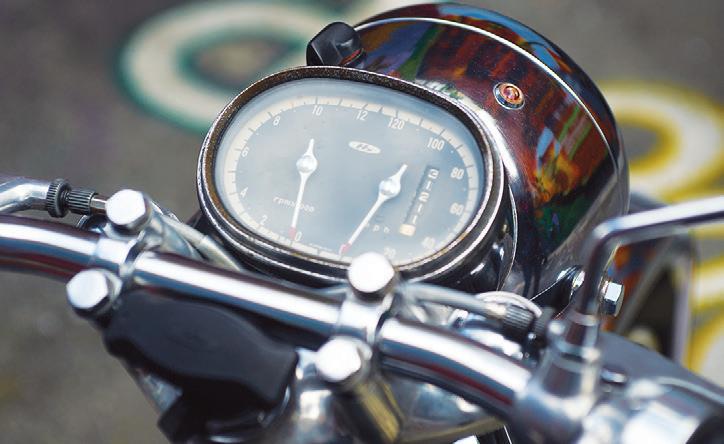
Engine: 305cc air-cooled 4-stroke SOHC parallel twin, 60mm x 54mm bore and stroke, 10:1 compression ratio, 28hp @ 9,000rpm (factory claim)
Top speed: 105.2mph (period test)
Carburetion: 2 Keihin 26mm carburetors
Electrics: 12v, battery and coil
Transmission: 4-speed, chain final drive
and horsepower; and were not that interested in fuel economy. Honda engineers were tasked with giving the customers what they wanted. A 250 twin showed up at motorcycle shows in the fall of 1960 as a 1961 model. It came in two versions: the Dream, an economical get-to-work bike, and the sporty Hawk. The Hawk was in many ways a first for Honda: it was styled like a European motorcycle, with a tubular frame and lightweight fenders. Earlier Hondas had pressed steel frames, which were cheaper to produce, but looked ugly and stodgy to American consumers.
Frame/wheelbase: Single downtube cradle frame/ 51in (1,295mm)
Suspension: Telescopic forks front, swingarm w/ dual shocks rear
Tires: 2.75 x 18in front, 3 x 18in rear
Brakes: 8in (203mm) TLS drum front, 8in (203mm) SLS drum rear
Weight (curb): 351lb (159kg)
Seat height: 30in (762mm)
Fuel capacity: 3.6gal (13.6ltr)
Price then/now: $665/$4,000-$10,000
In 1962, the cow trail and dirt road capable CL72 Scrambler appeared. Dave Ekins and Bill Robertson rode a pair of highly modified CL72s from Tijuana to La Paz to set a long distance off-road record. This trek sparked the Baja 1000 race. In 1968,
Ekins wrote an article for Cycle magazine, explaining what he did to turn a CL72 into a winning race bike. He said he did all of the long list of improvements because the Honda was “reliable,” an important feature when down a dirt road miles from nowhere.
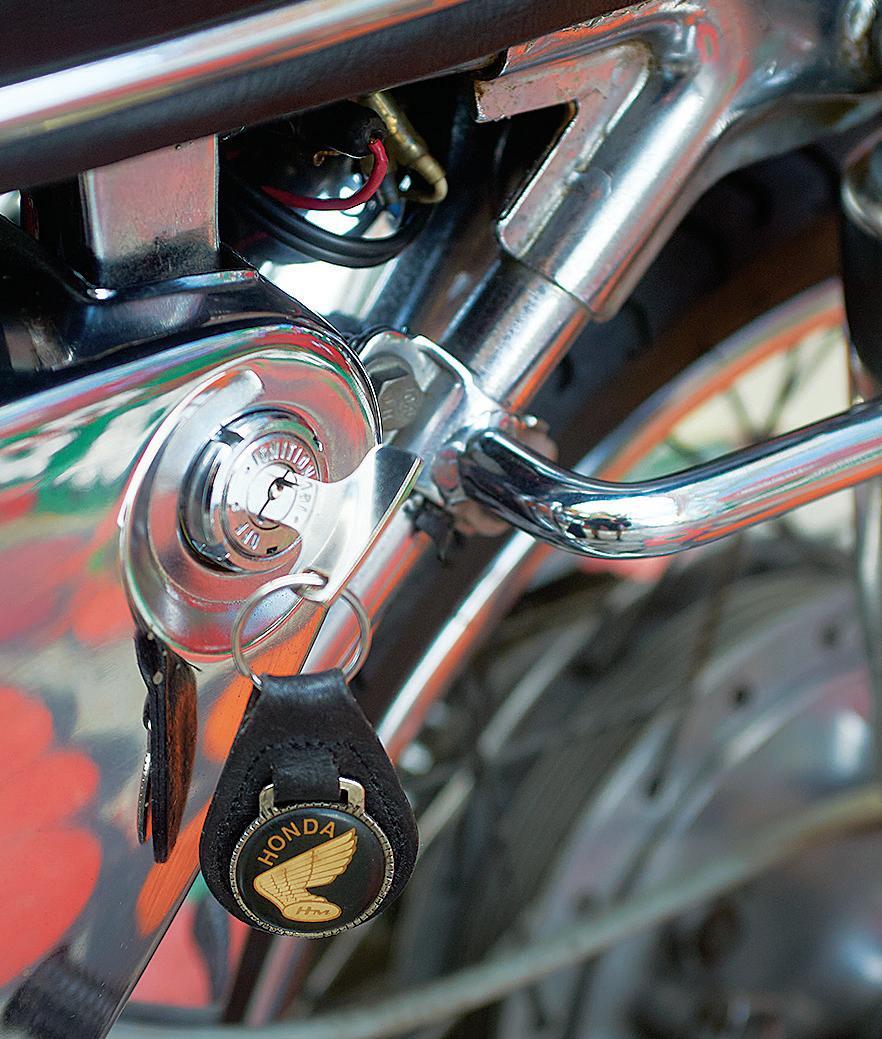
The CB77 Super Hawk appeared in the Spring of 1961, shortly after the 250cc Hawk. The frame was derived from the lightweight racers that Honda was then campaigning. This 305cc twin had an overhead cam, 8-inch double-leading-shoe brakes, and 12-volt alternator electrics, complete with an electric starter at a time when most bikes were making do with kickstarters, single-leading-shoe brakes and 6-volt generators. It also didn’t leak oil — a complete revelation.
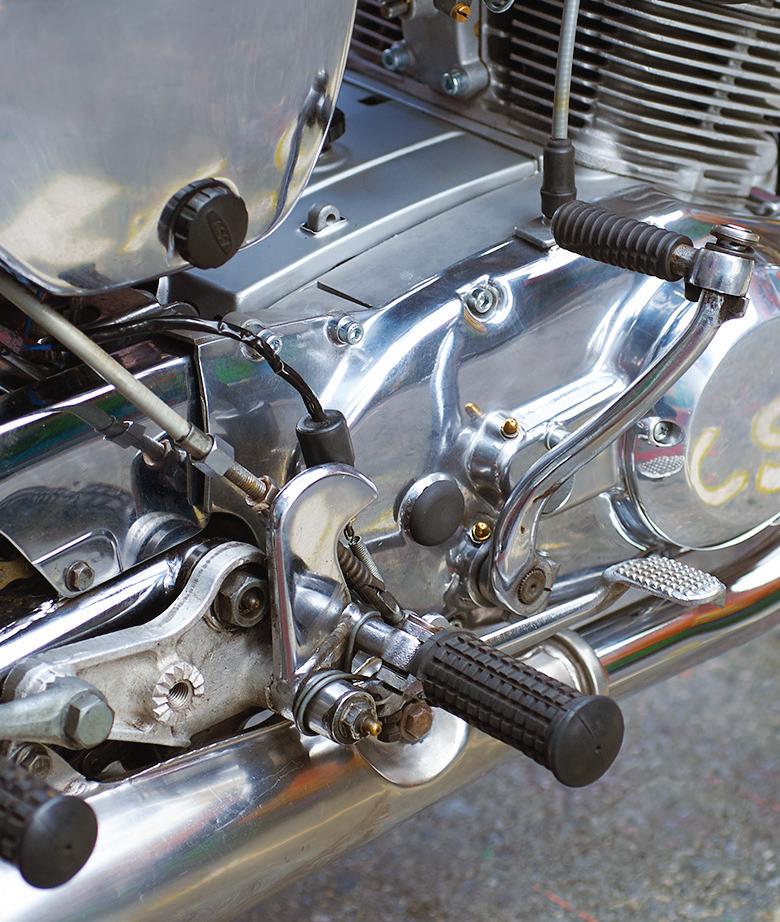 The speedo runs counterclockwise. Keyed ignition is in the left sidecover.
The speedo runs counterclockwise. Keyed ignition is in the left sidecover.
Magazine testers commented that there was not enough blow-by through the chain oiler to keep the chain greased, but that they preferred greasing chains to cleaning up oily engines. Although fuel economy was not an engineering objective, most Super Hawks will wring about 50 miles out of a gallon.
Honda advertising emphasized innocent fun and respectability, culminating in the “You meet the nicest people on a Honda” campaign. The new imports arrived just as Baby Boomers were reaching their teens and wanting to go places and see things. Soichiro Honda’s combination of a technologically advanced, clean running, reliable product and intelligent advertising made his dream of worldwide sales come true. By December 1962, American Honda was selling more than 40,000 motorcycles annually, including a lot of Super Hawks.
Period motorcycle magazines loved the Super Hawk, and not only because Honda was buying large ads. Cycle World liked the bike so much they road tested it twice. The editors stated in the September 1964 issue: “Although the machine has changed little since that time [the first test in 1962] we are repeating the test. Reasons: we have acquired several new readers over the intervening years; and that the Super Hawk, changed or not, is one of the most advanced and best performing motorcycles available today.” Cycle World revisited the Super Hawk for a third time in 1999, in the con-
text of a Wisconsin ride arranged by a loosely organized group calling themselves the Slimey Cruds. Phil Schilling, the author, explained that below 6,000rpm, a Super Hawk will pull along smoothly, “like a Fifties Plymouth.” The redline was 9,200rpm, and over that the valves would start to float. Between 6,000rpm and 9,200rpm, the Super Hawk roared. It would pound along for miles at engine speeds that would make most contemporaries (notably excepting Ducati) bend valves. “Riders called the CB77 cammy and rev-crazy. They were right.”
The Super Hawk was produced from 1961 to 1967 with incremental changes. Up until 1965, the twins were produced with flat bars. The 1966 bikes had improved forks and higher “Western” handlebars. Earlier machines had speedometers and tachometers with indicators that moved in opposite directions, bottom to top, while later machines had a speedo and tach that both moved clockwise, like those on most Western machines.

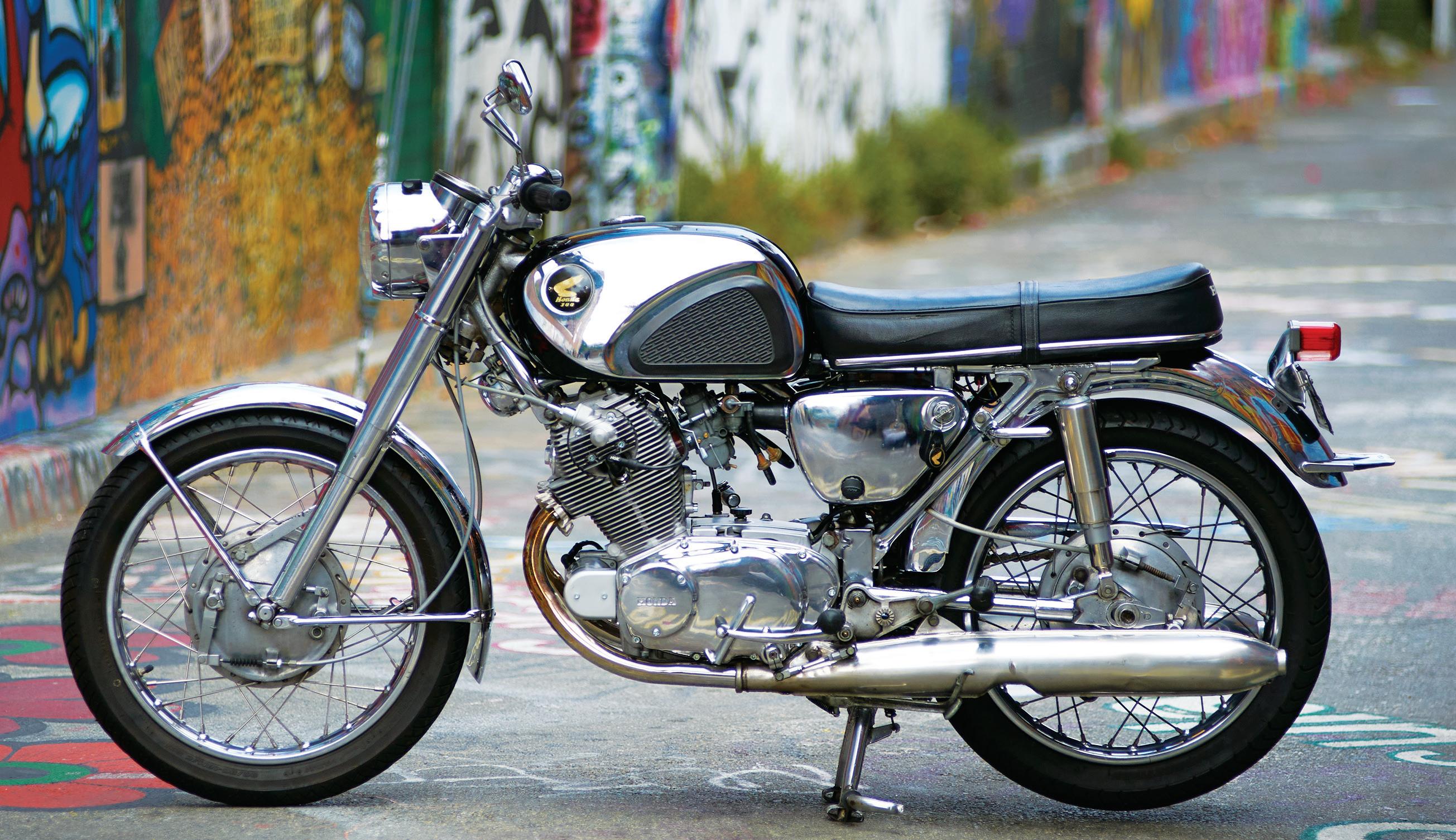
Meanwhile, Honda’s engineers were working on a new, improved version of the Super Hawk, which came out in 1968 as the CB350, with updated looks, more power, and a 5-speed transmission. By the time the CB77 was retired, over 72,000 had been sold in the U.S. alone.
The ubiquity of Super Hawks makes finding one easier than finding many other motorcycles of the early 1960s. The later CB350s (and their sister machine, the CL scrambler) have acquired
the status of cult bikes. While aftermarket parts suppliers are at the ready to help turn a small 1970’s Honda into the owner’s vision of café racer, rat bike or custom machine, the earlier Super Hawks have not acquired the same status. This makes the Super Hawk perfect for someone like owner Jen Tacy, who wants something a little different. Although Super Hawks are not as powerful as later Honda twins, they have similar bright lights, good brakes, and electric starting. Super Hawks are also reliable if the maintenance is kept up.
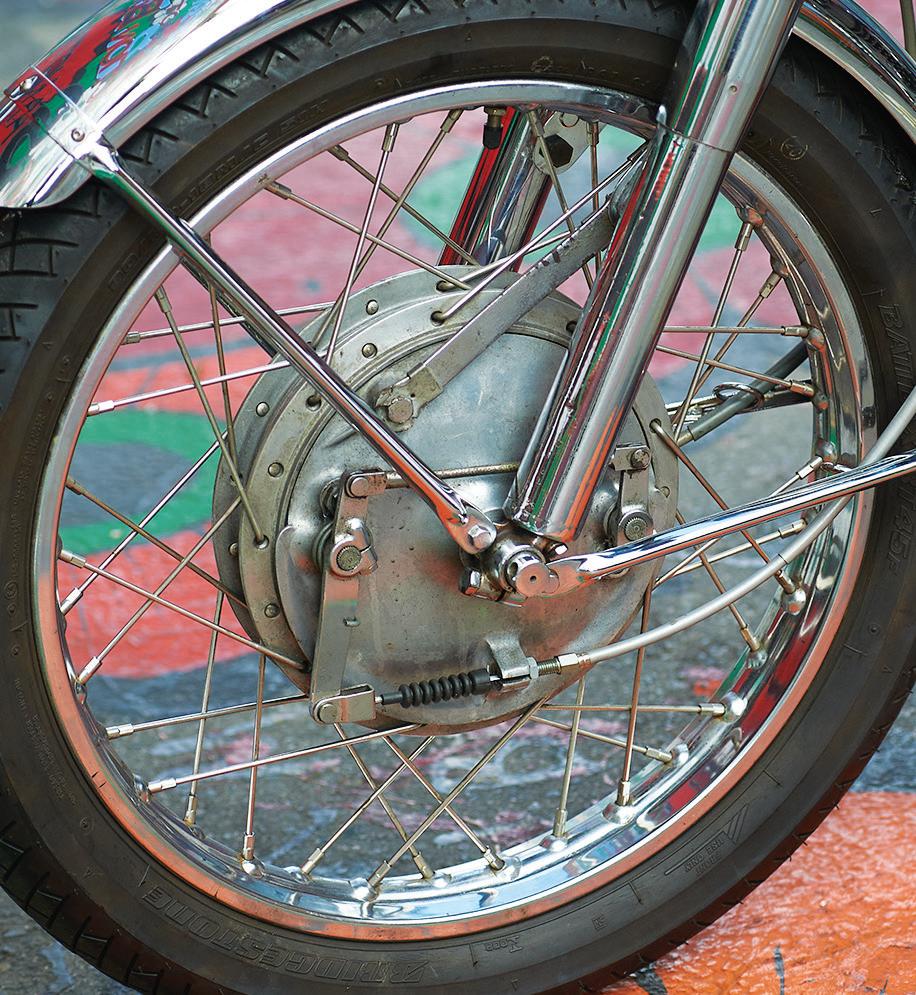
The one issue that can arise for a Super Hawk that is intended to be ridden on a regular basis, as Jen rides her bike, is parts availability. Bill Silver in his book Classic Honda Motorcycles cautions that finding Super Hawk parts can be problematic. Honda has stopped making parts for older machines, and aftermarket availability can be hit or miss.
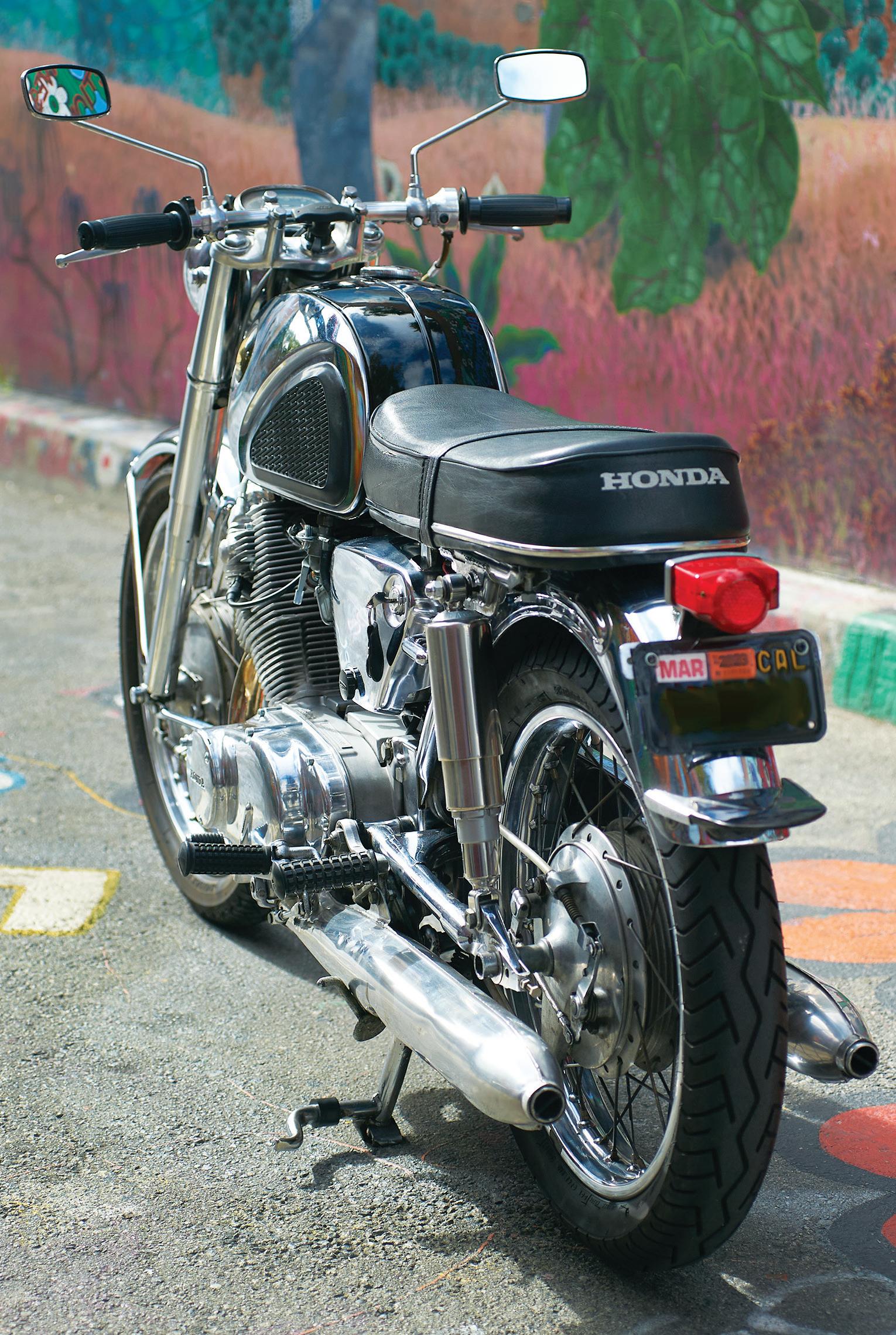
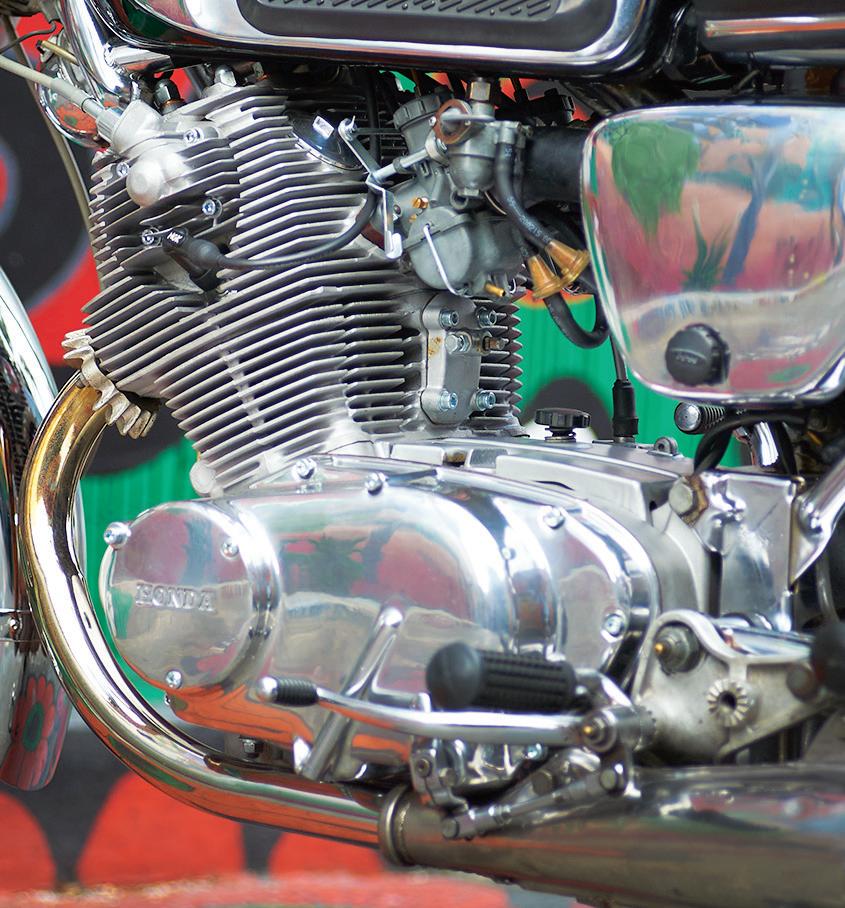
The parts issue hasn’t stopped Jen Tacy from riding her Super Hawk on a regular basis. She says that many parts, especially things that wear out repeatedly, like cables, are actually easy to find, although others, including some engine parts, are harder. With some patience, Jen has been able to keep her bike running and maintain it in stock condition.
Jen’s motorcycle adventures started when a roommate came home on a vintage Puch. “I thought that was cool. I wanted one. Then I thought, ‘Why get a moped — why not get a motorcycle?’” Jen had coveted 1960’s cars as a teenager and owned a 1966 Mustang at one point. She decided to look for a 1960’s motorcycle and ended up with a 90cc Suzuki 2-stroke. But Jen did not know how to work on it and couldn’t find anyone who did. Charlie O’Hanlon (charlies-place.com), the only mechanic in town who worked on older Japanese bikes, only worked on Hondas. Jen looked for six months until she found a Honda she liked on eBay — this 1963 Super Hawk. It was almost stock, but somehow had acquired a chromed frame. Jen is not sure if the chrome was a factory experiment, a dealer project, or an owner customization.
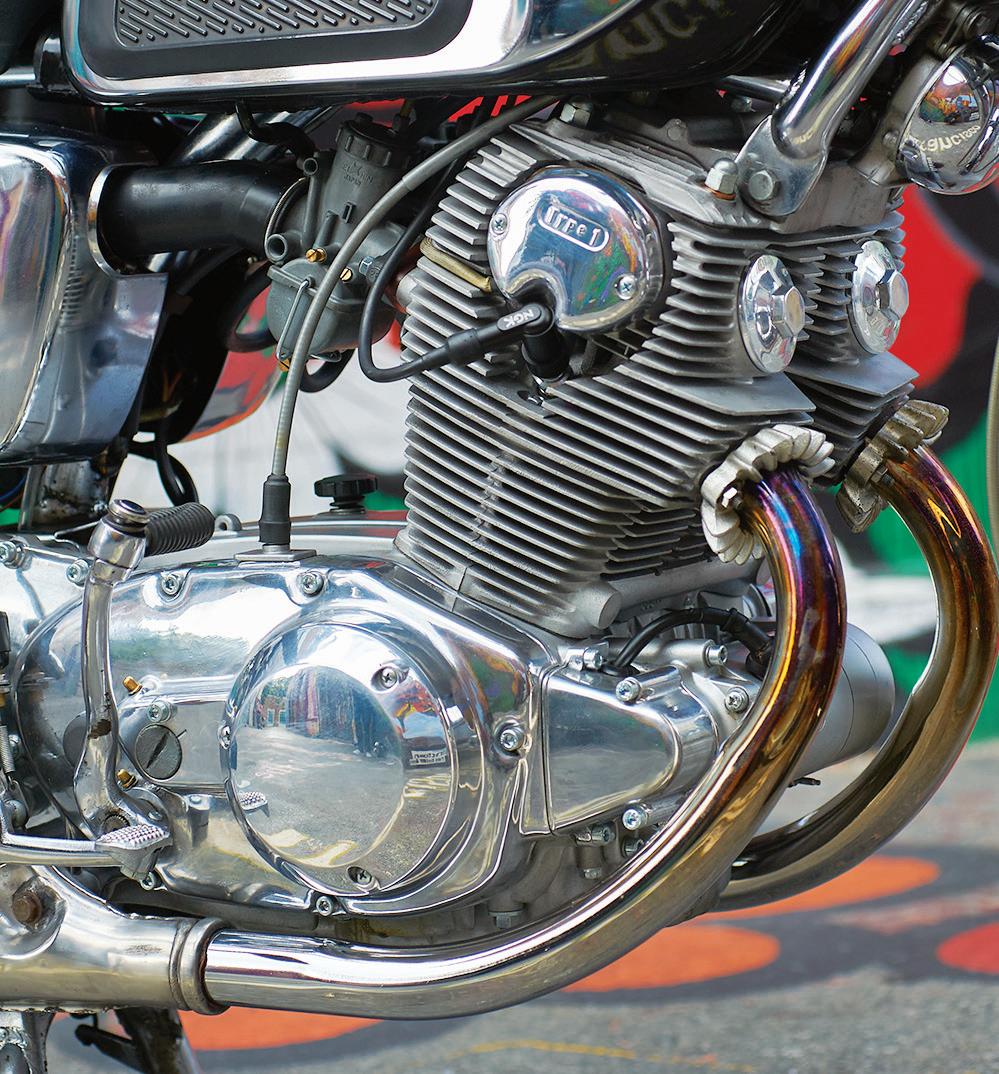
As purchased, the Super Hawk wasn’t running very well. “The solenoid was out, it needed tires, a full tune-up, new cables and an oil change.” In 2008, Charlie helped her get the bike running smoothly — and then moved to Los Angeles. Jen had grown up with a mother who kept the house repaired and understood how to use basic tools. She decided she needed to learn to fix her bike herself. “I wanted to make it my daily rider.” Even after 60 years, the Super Hawk works well as a commuter and grocery store bike, making chores and the daily round fun. “I just started riding all the time.”
Jen took motorcycle repair classes at San Francisco’s City College and found she enjoyed working on bikes. She met Gregg, her wife, when she saw Gregg riding a 1964 Super Hawk. The two got married a few years ago, and have started a small two-wheeled collection. “I work on all our bikes — Gregg’s four and my five.” In addition to the two Super Hawks, there’s a 1989 GSXR 750, an Interceptor that Jen restored herself, and a new Husqvarna Svartpilen. Jen rides the Super Hawk around town and for shorter trips and the bigger bikes on longer trips. “It’s a day trip bike.” Due to a recent change to working from home, Jen is now only on her bike once a week, instead of every day.
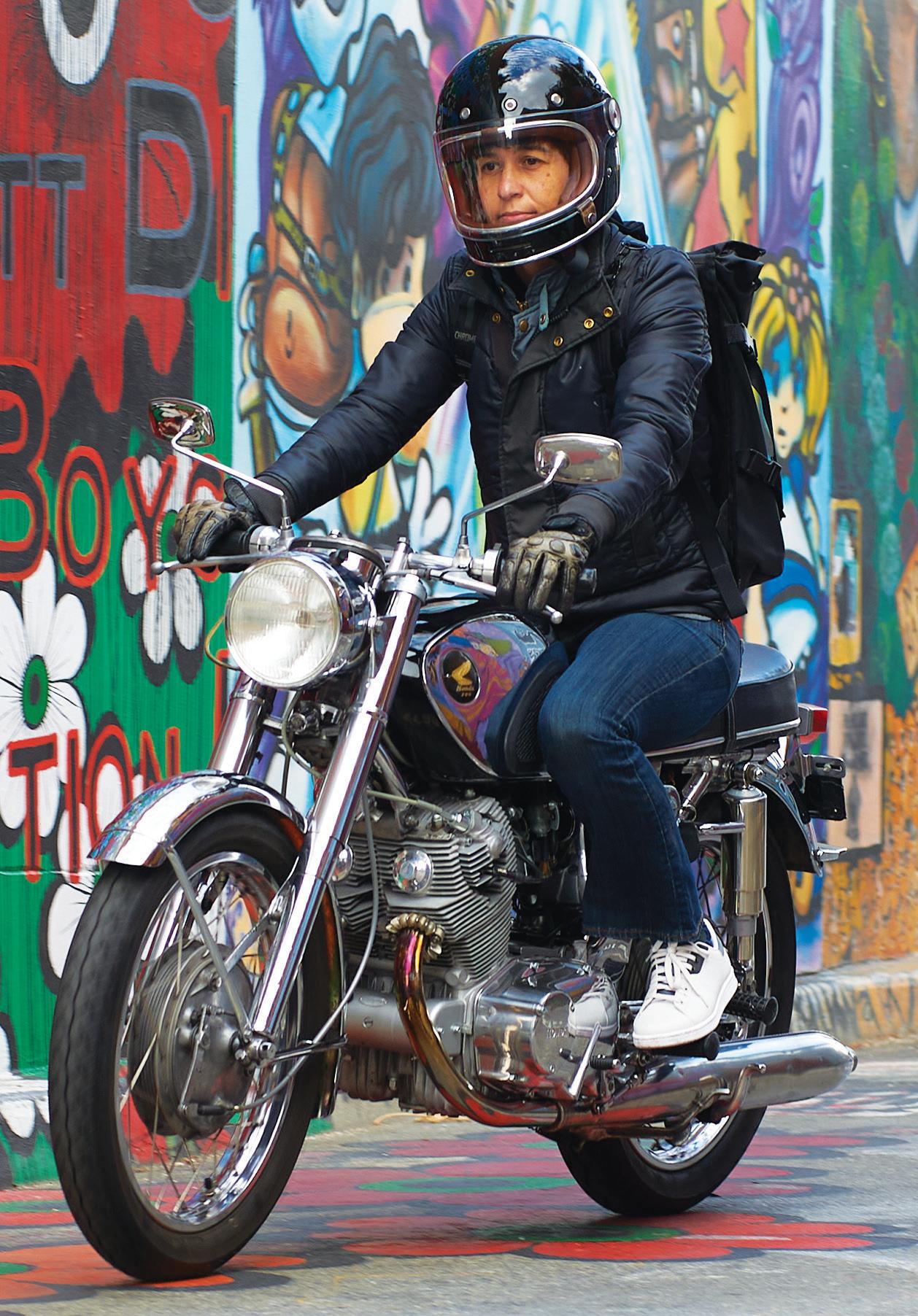
In 2021, Jen took the engine out of the Hawk and sent it to Charlie in Los Angeles. “It was making strange sounds. It turned out the cam was worn. I also wanted to upgrade the pistons.” While the engine was apart, Charlie replaced some worn parts and Jen had the front fender rechromed. Nine months later, the engine came back, all shiny and fresh. Jen installed it in the chassis and is back to riding this bike on a regular basis.
Part of the reason why Jen rides the Super Hawk so much is its ease of maintenance. She replaced the original points with an electronic ignition. “Everything is really easy to access.” The only regular chore is the 500 mile oil change. The bike has a centrifugal oil filter that rarely needs cleaning. Jen checks the carburetors occasionally, but it rarely needs adjustment. “It doesn’t go out of tune as long as I keep riding the bike on a regular basis.” She also occasionally checks the valves. “Adjusting the valves is super easy. I adjust the chain, put air in the tires — that’s about it.”
With the electric starter, starting is almost as easy as on a modern bike, although the Super Hawk does take a while to warm up. “It needs a little choke to start and 3-5 minutes to warm up. If you don’t let it warm, the carbs pop.”
“The Super Hawk is my favorite bike. I like the look. I like the dual exhaust. I like the fact that Gregg has the same bike. It’s easy to work on. It’s a perfect city bike. It looks nice, but no one has ever tried to steal it. I had to park it outside for the first five years
I owned it, and I would be worried that it would be stolen, but no one has ever tried.

“It’s still powerful and reliable. It always gets me home. It stops fine. The bike feels very happy and I feel secure and confident riding it.” MC
Honda Enthusiasts Guide is designed to aid non-professional motorcycle collectors to decide whether to buy and restore Honda motorcycles produced between 1959 and 1985. Author Doug Mitchel provides four to six paragraphs describing bikes in general terms, including, but not limited to, the differences and similarities between models discussed and other similar models. A general section at the back of the book will offer the reader help deciding where to buy classic bikes, where to get parts, who to call for help, and which parts of the restoration should be farmed out to experts with specific skills. This title is available at store. MotorcycleClassics.com or by calling 800-880-7567. Item #6793.
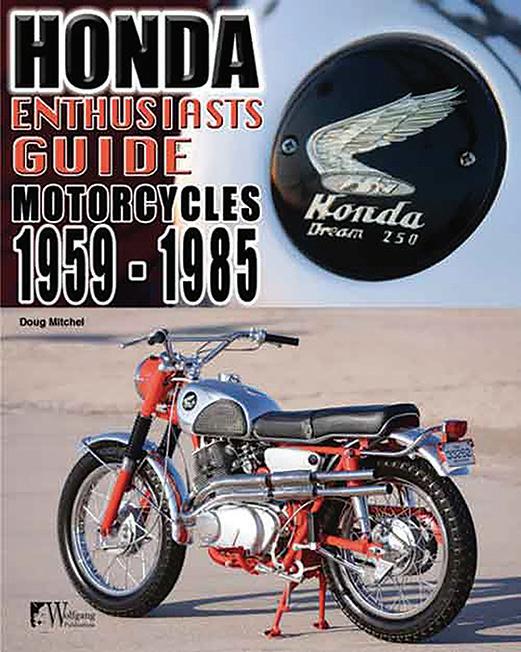
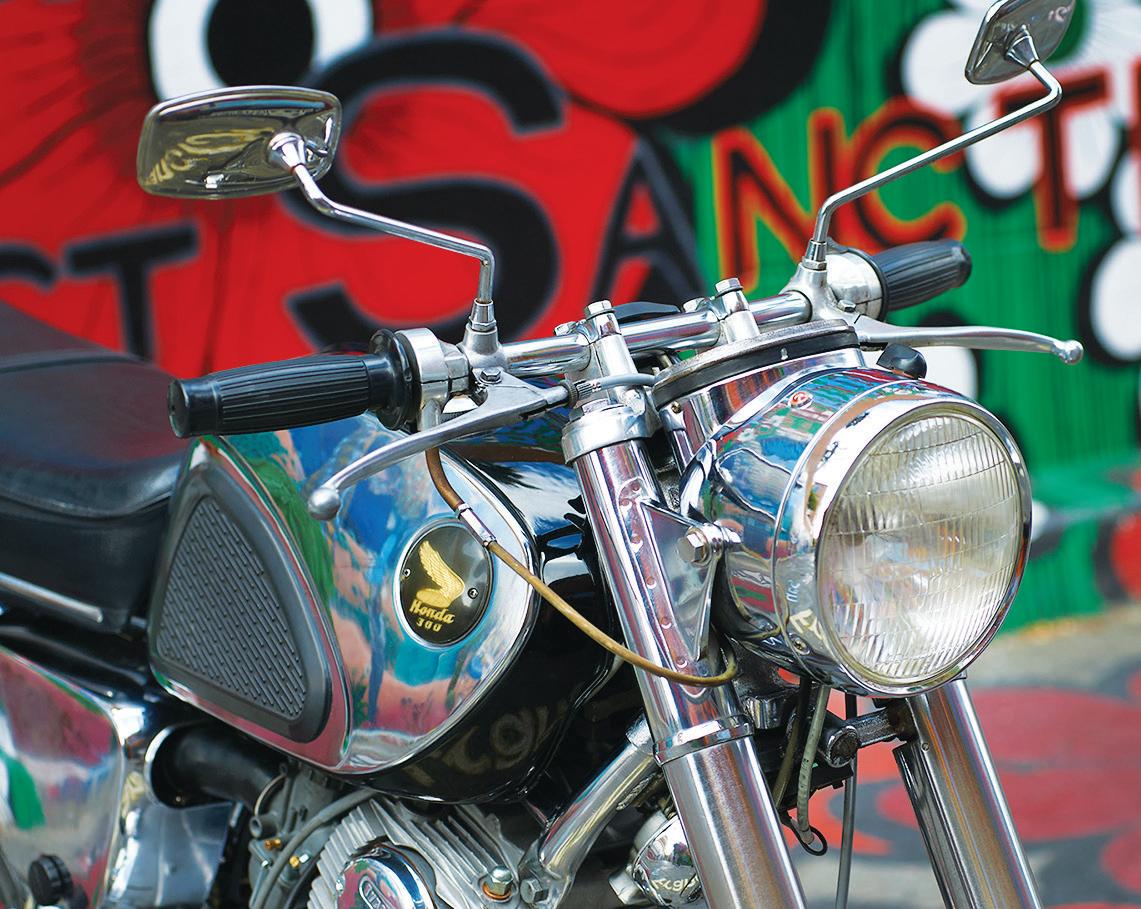

TThe normal way to tell a story is to start at the beginning and finish with the ending. But normal is boring and beginnings are usually more upbeat than endings, so this tale of two Texas classic motorcycle rallies will be told bass-ackwards, starting with an ending and finishing with a beginning.
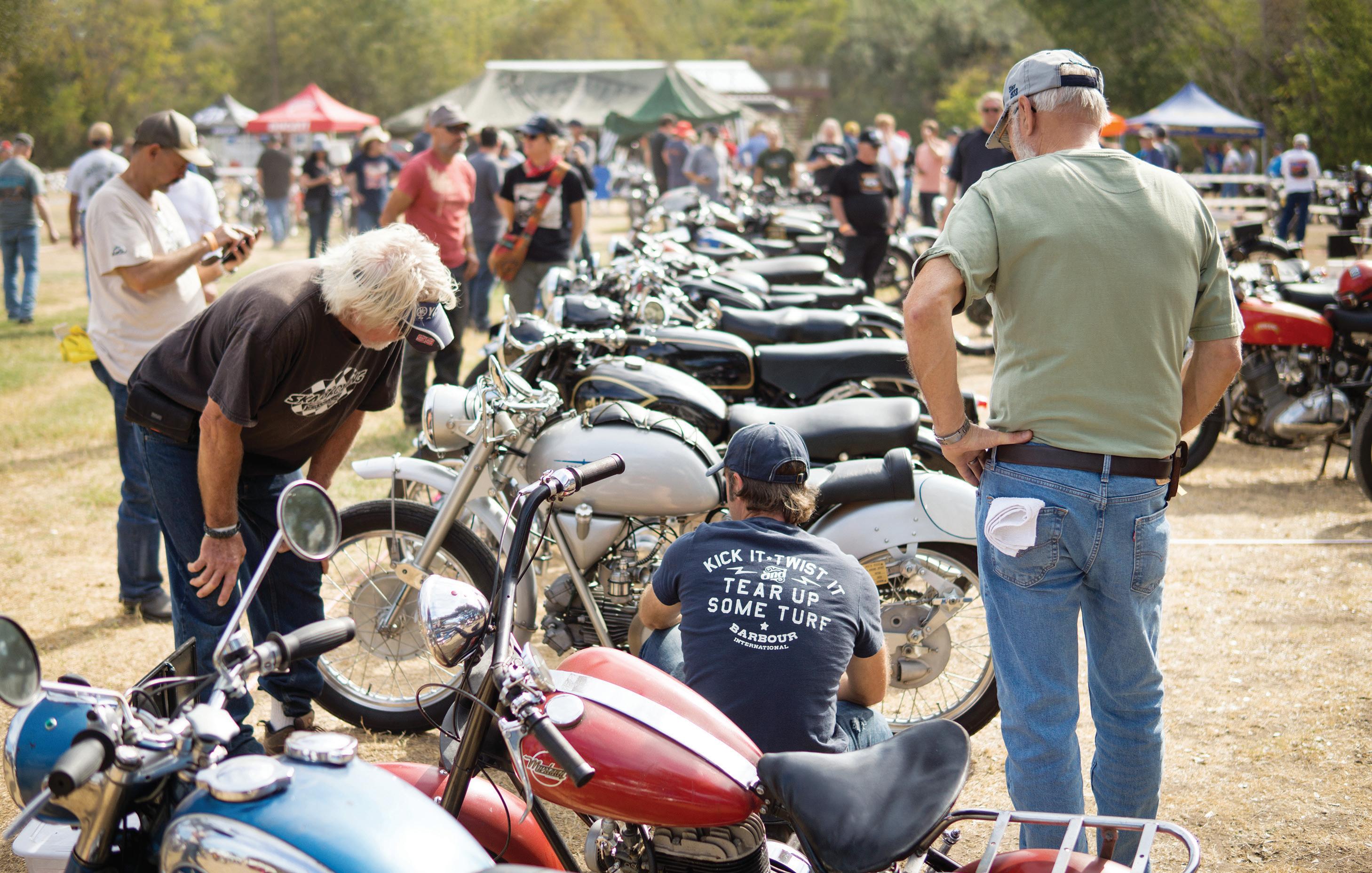
Faithful readers of this magazine may remember the Harvest Classic Rally which has been featured in these pages several times over the years. It saddens me to report that the edition held in Luckenbach, Texas, in October 2022, was the final chapter
for this special event and marked the end of a wonderful 20-yearlong run. Back in 2003, a group of friends who shared a love of classic and European motorcycles started the not-for-profit rally as a way to bring the community together while raising money for Candlelighters, a charity that helps hundreds of Texas families struggling with the challenges of childhood cancer. The rally’s honcho, Russell Duke, and his wife, Kathy, had recently lost their 4-year-old daughter, Emma, to the disease and saw the rally as a fitting way to honor her memory.
Over the years, the activities on offer varied somewhat but there were some features that defined the event: on-site camping, trials competitions, a bike show, a raffle, an auction, a swap meet, a Saturday night moto-movie, BBQ, live music and a Fun Run for 100cc tiddler bikes. Some years there were demo rides, special exhibits and the infamous Globe of Death.
Looking back on two decades of the rally, Russell says: “As the rally founder, the Harvest Classic was always important and special to me. But one of the cool things that I discovered over the
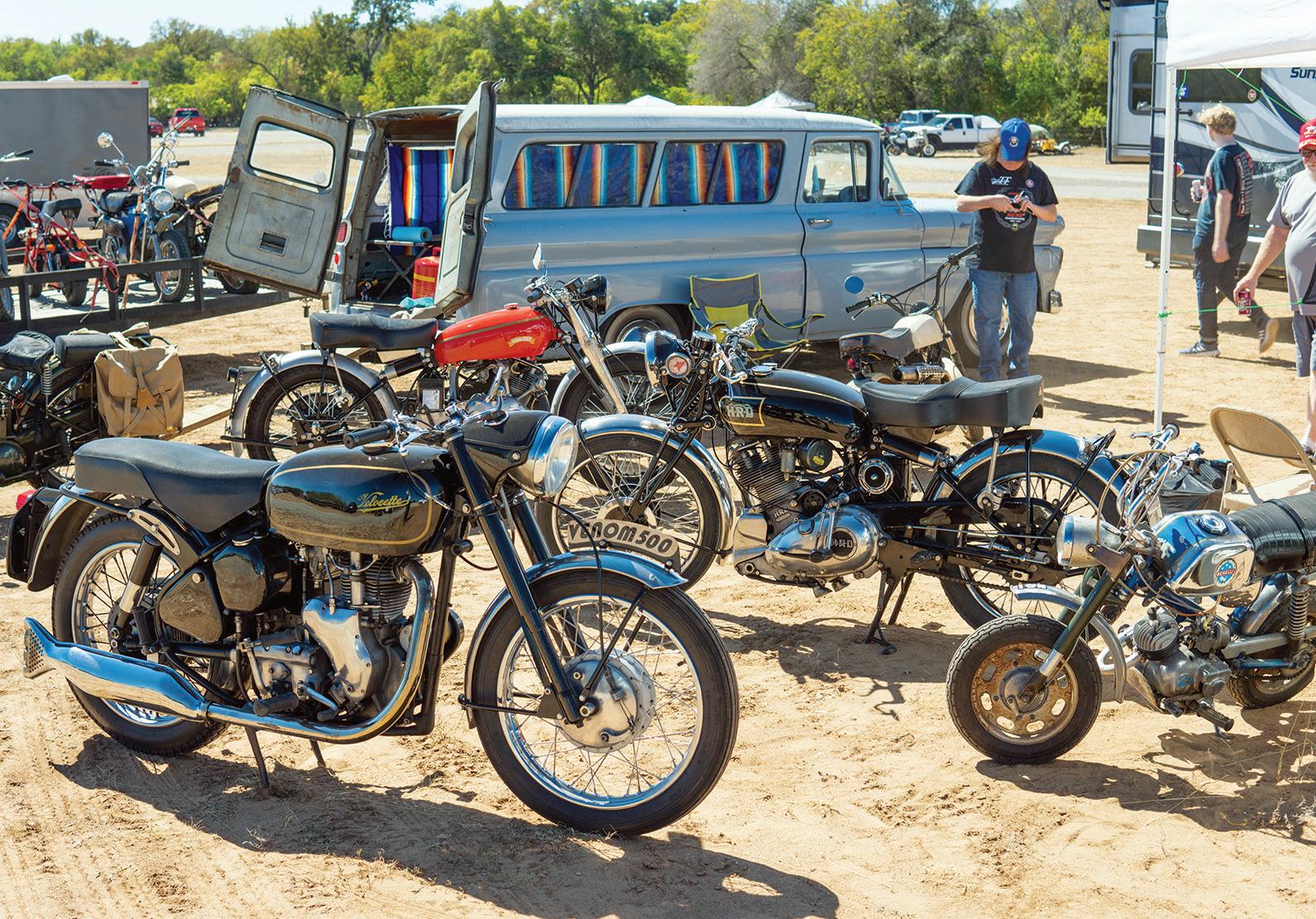
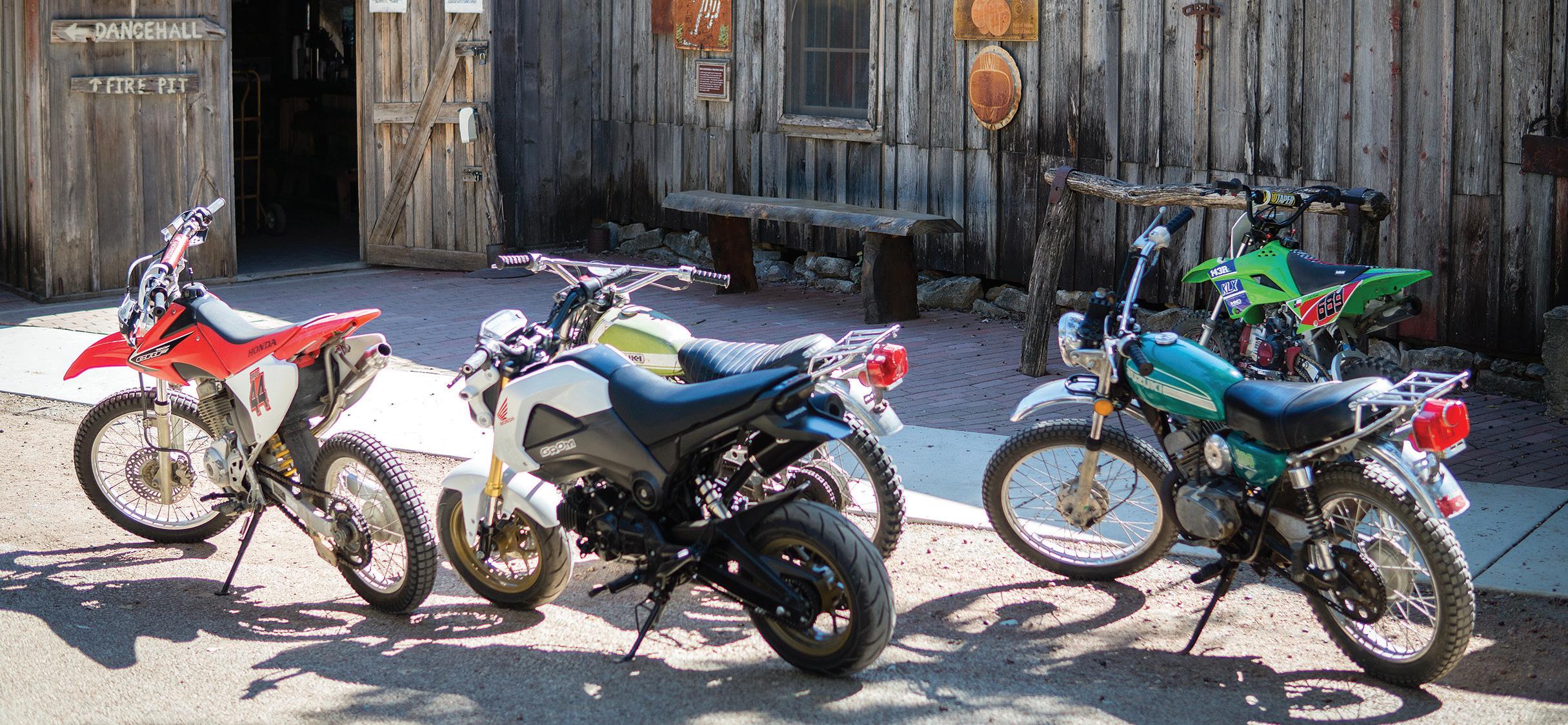
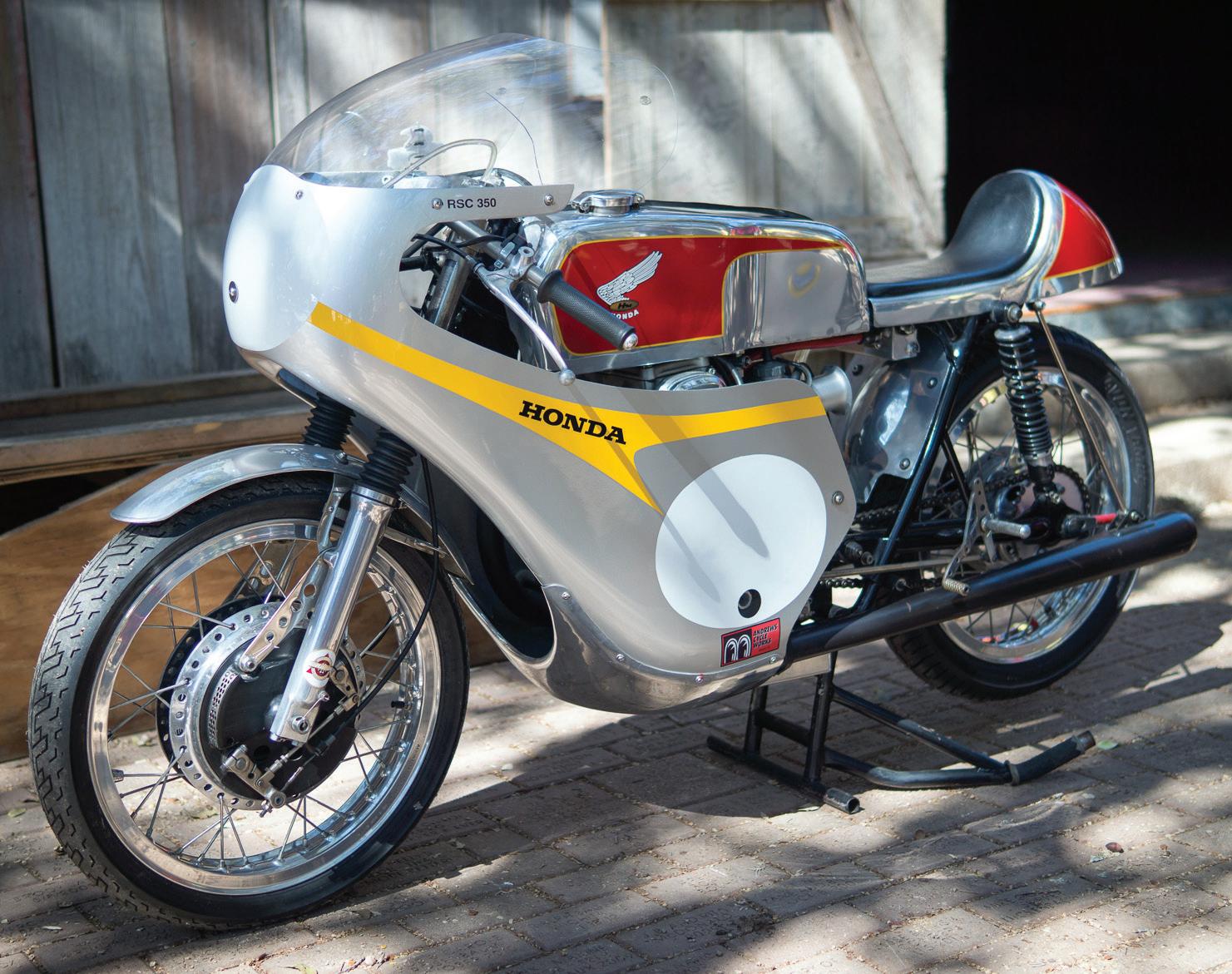
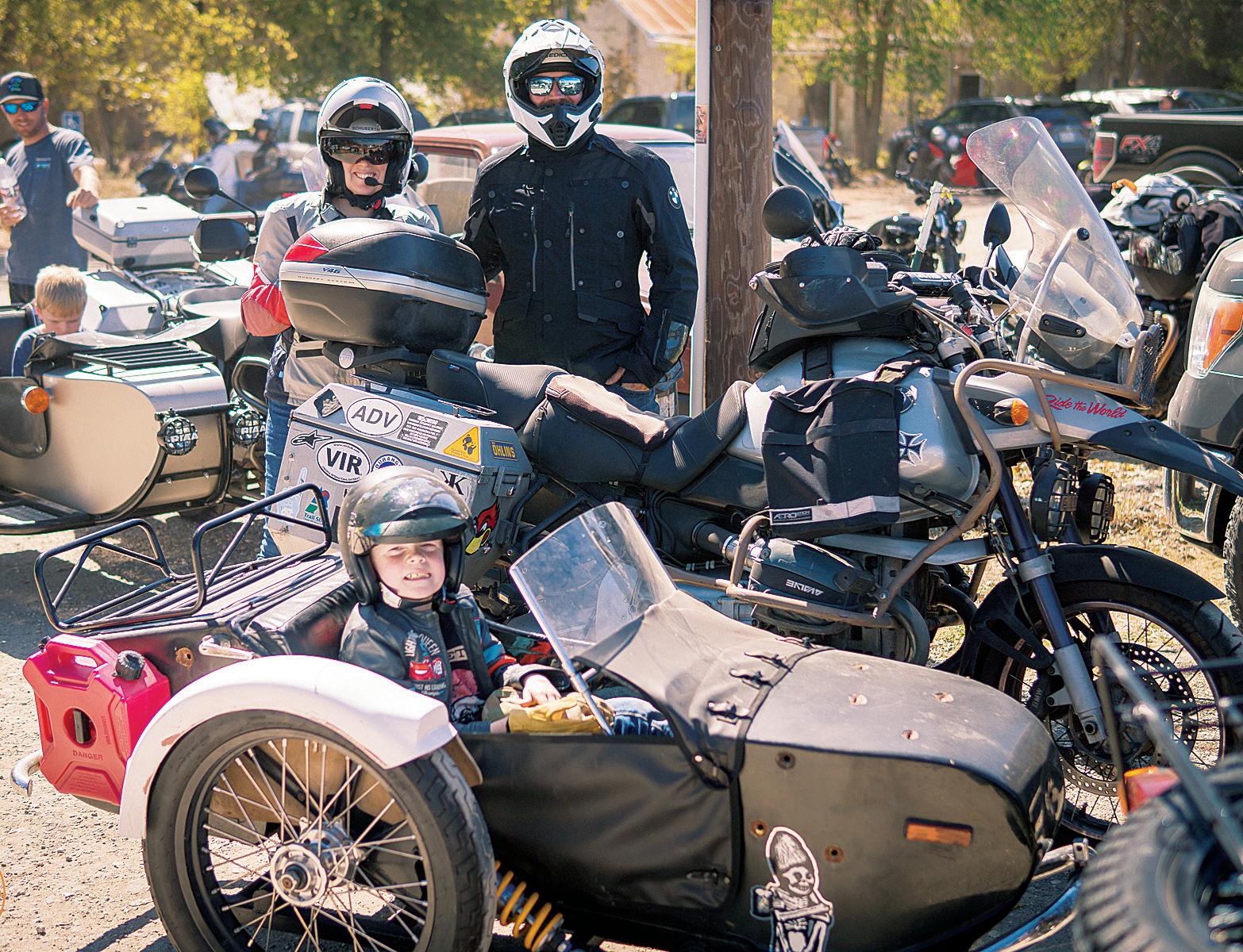
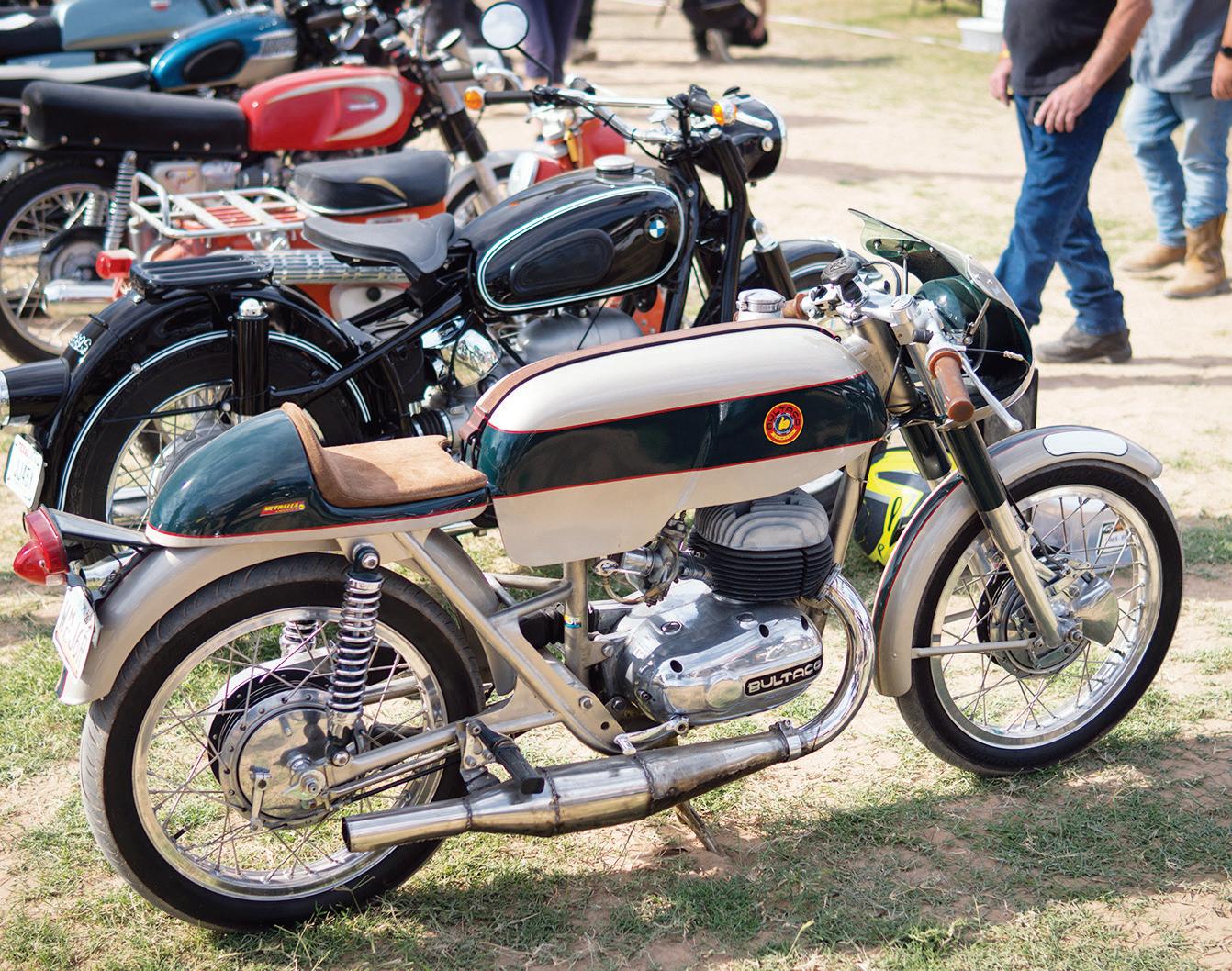
years was how special it was to so many other people. Each year, I loved hearing stories about how folks have watched their kids grow up at the rally, got exposed to Trials here, met their future bride here, built up a Fun Run bike, made so many friends and memories in Luckenbach, and were touched at a deeper level. Our daughter Emma died from cancer at the age of 4, but through the rally, her legacy lived on, and she motivated us all to look within and find a way to support other families who were going through cancer together. This is the spirit of the rally.”
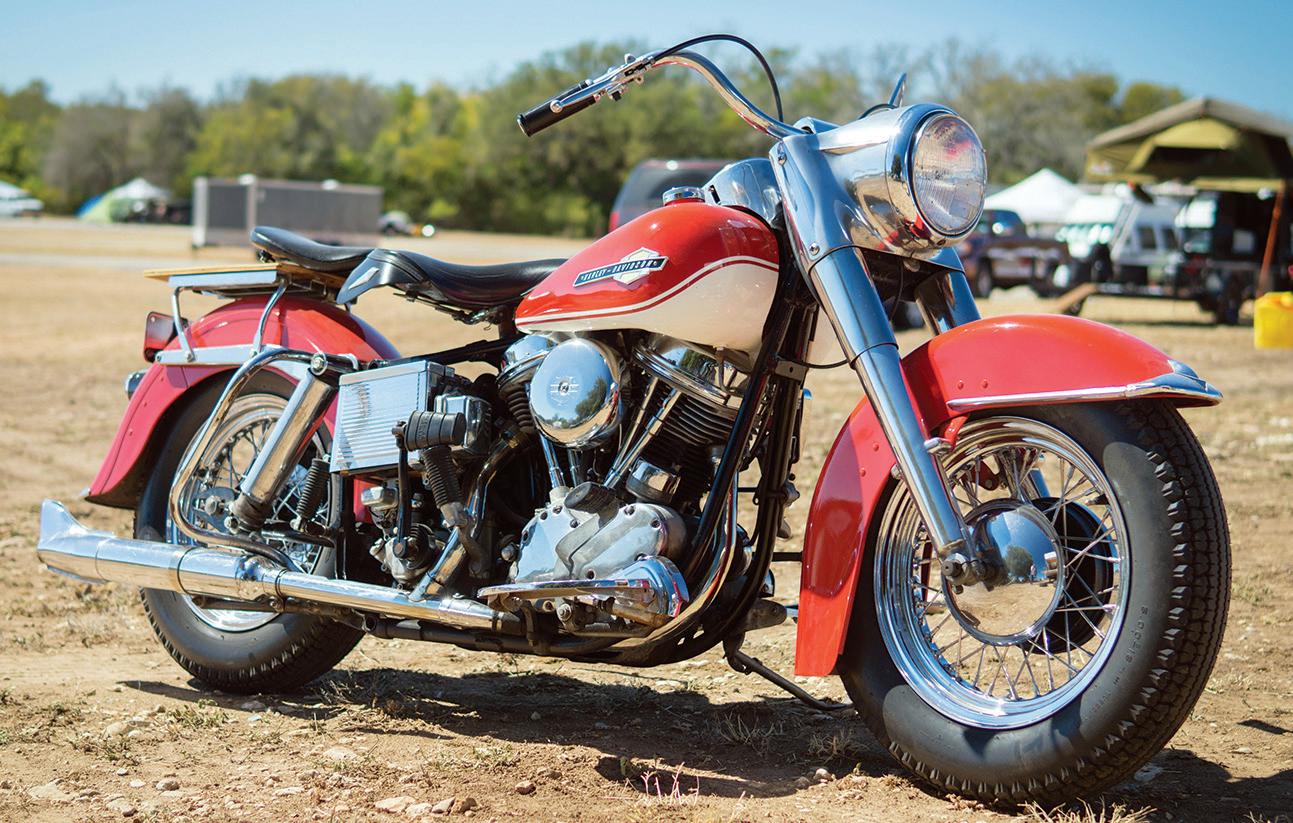
Through attendance fees and sponsorships of the 20th and final Harvest Classic Rally, Russell and his team of volunteers
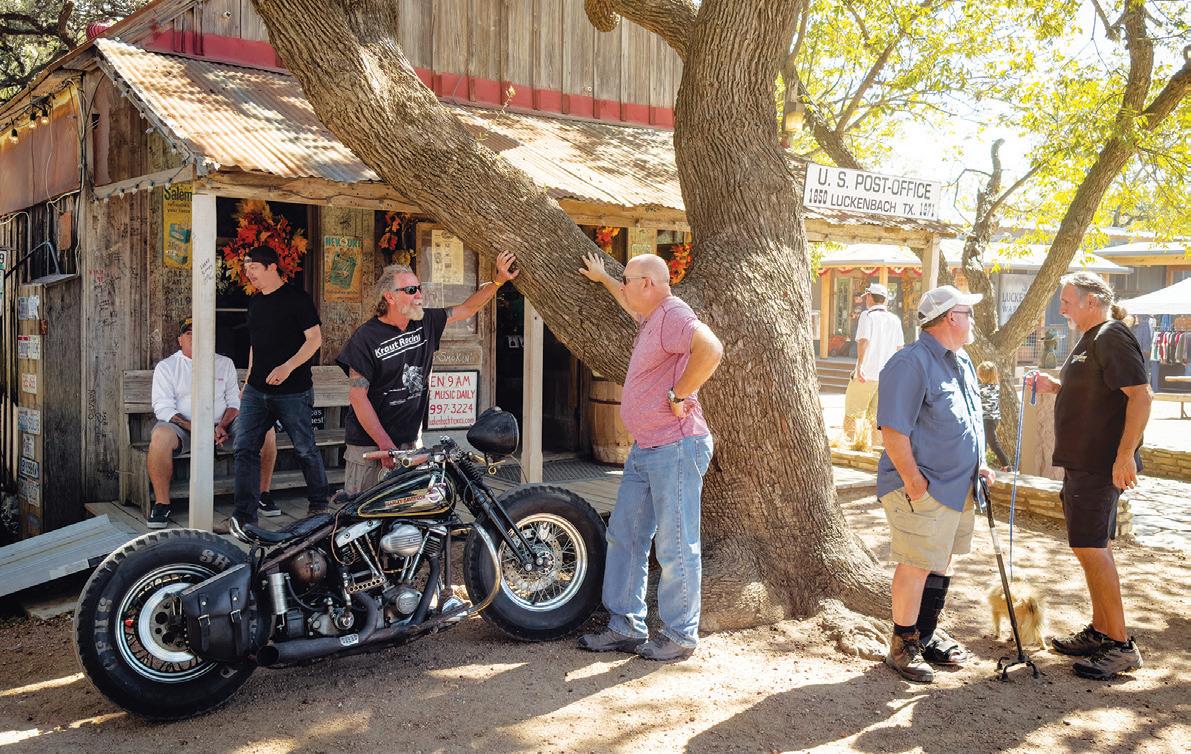
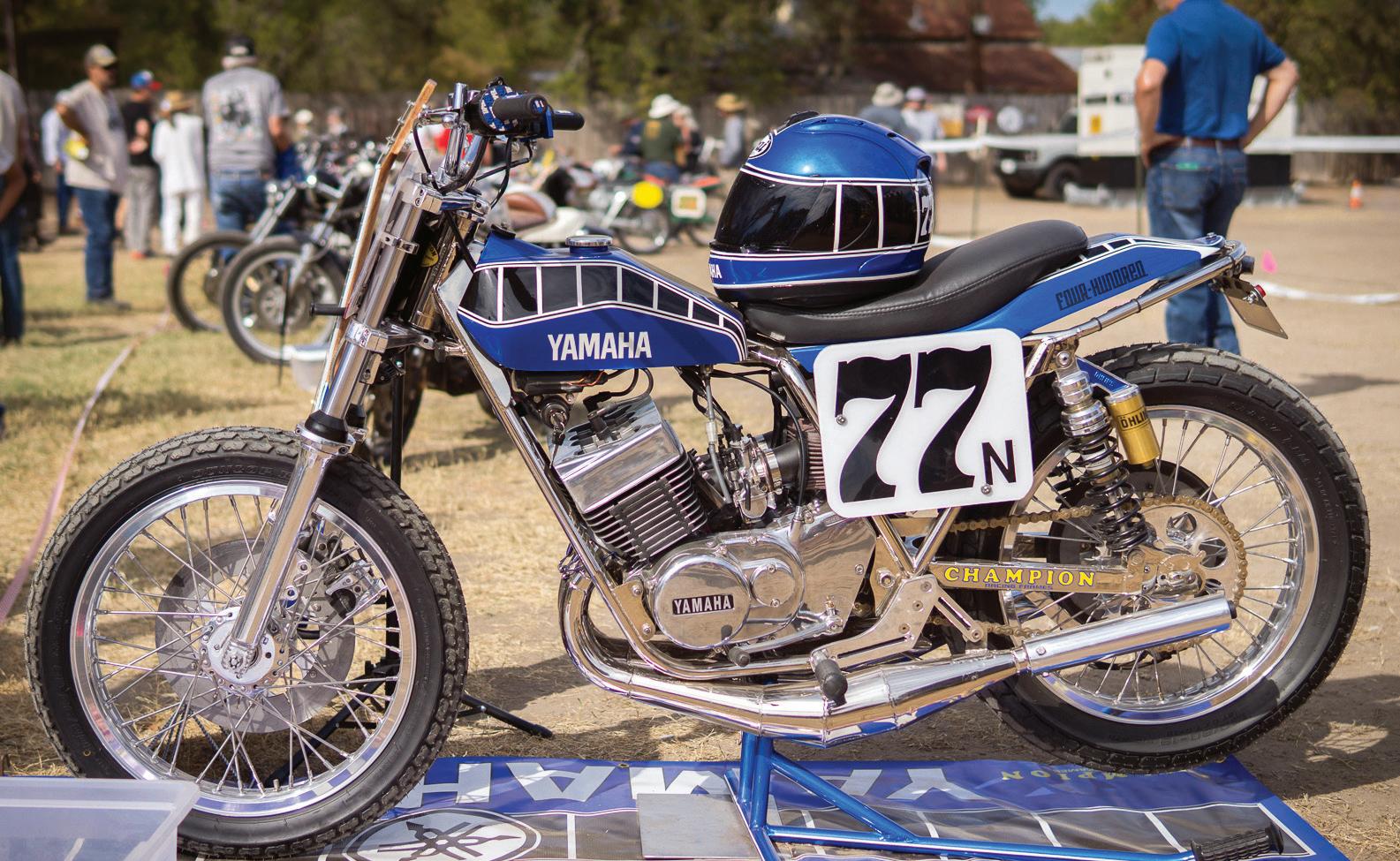
raised over $100,000, bringing the 20-year cumulative donation to the Candlelighters program to over a million dollars. About the decision to end the event after two decades, Russell said: “We wanted to end the rally just like we started it — on our own terms. We didn’t want to sell out, fizzle out, or fade away. It was a hard decision, but one that we haven’t regretted. Now go start your own rally!”
The rally was always a fun time and something we all looked forward to every year. It’ll be missed by many but, fortunately, as the sun sets on the Harvest Classic Rally, I’m happy to report that another local event is on the upswing.
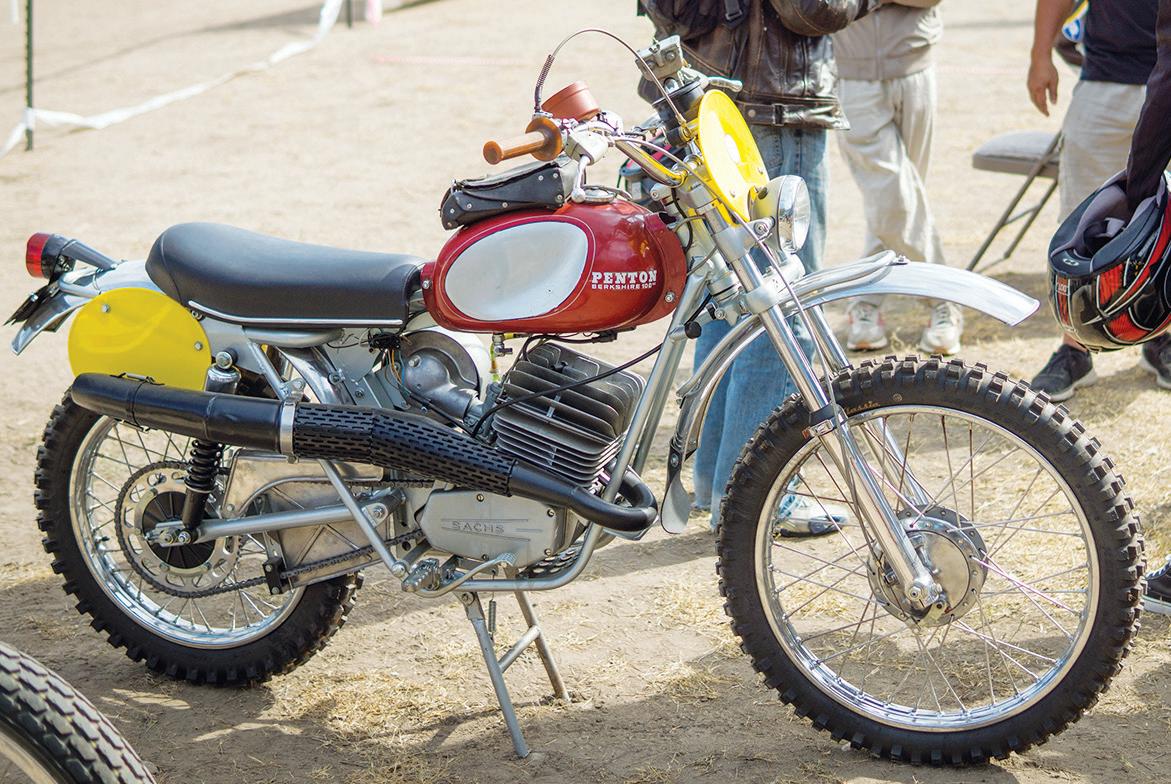
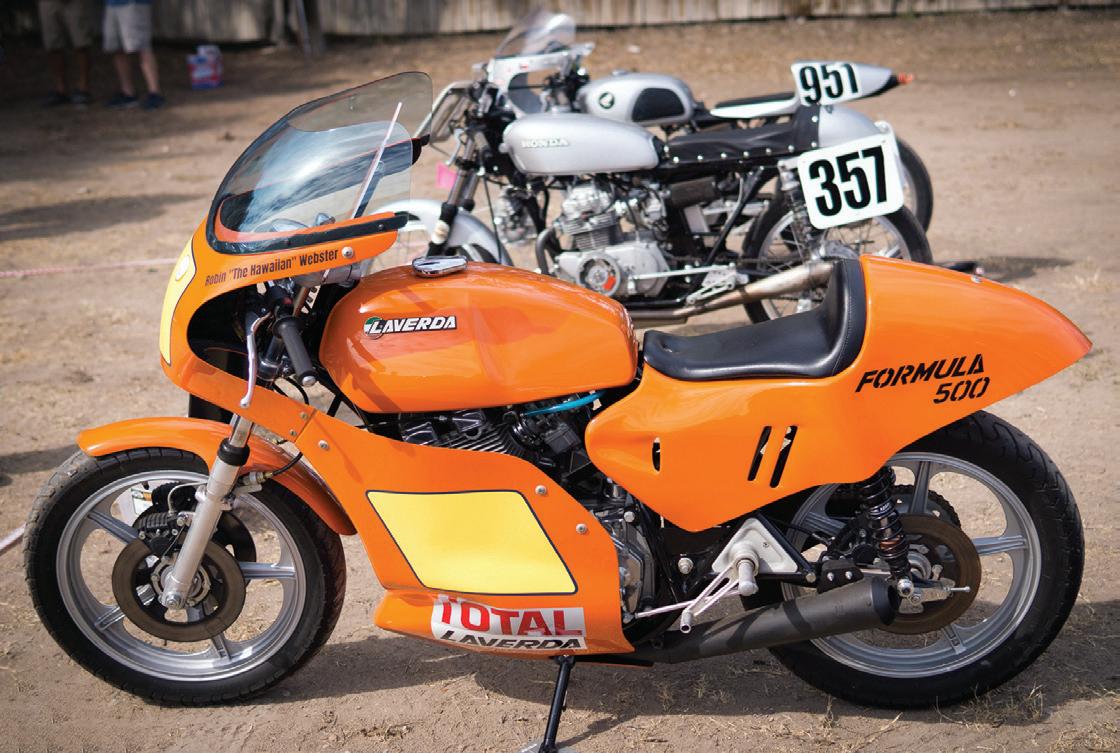
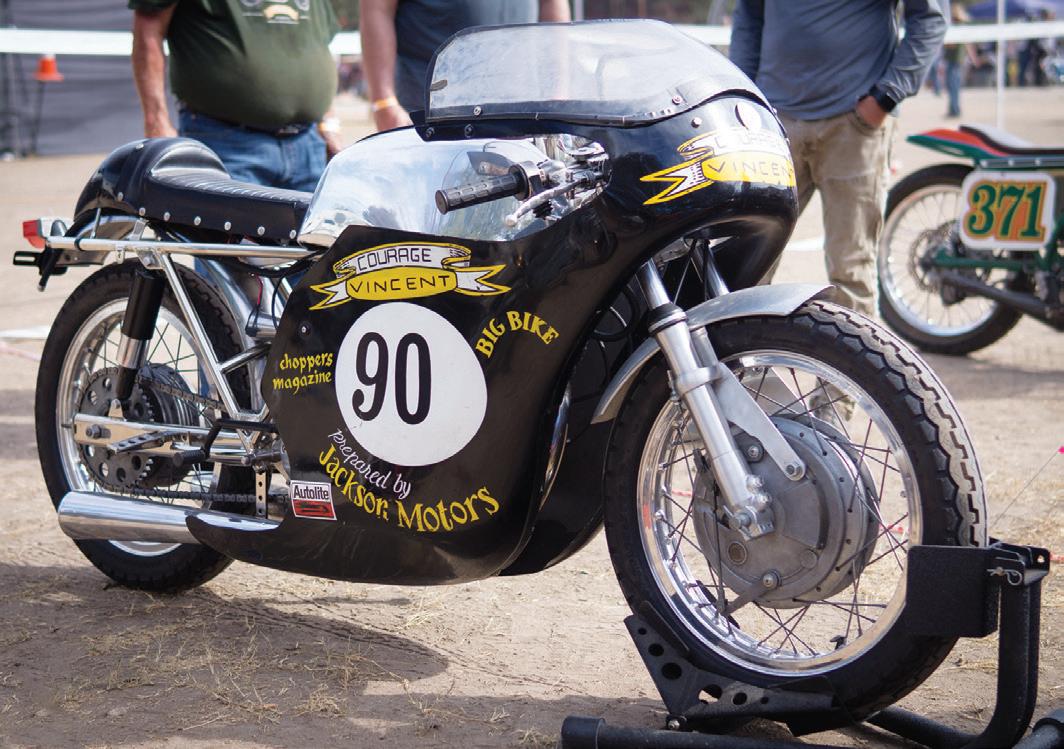
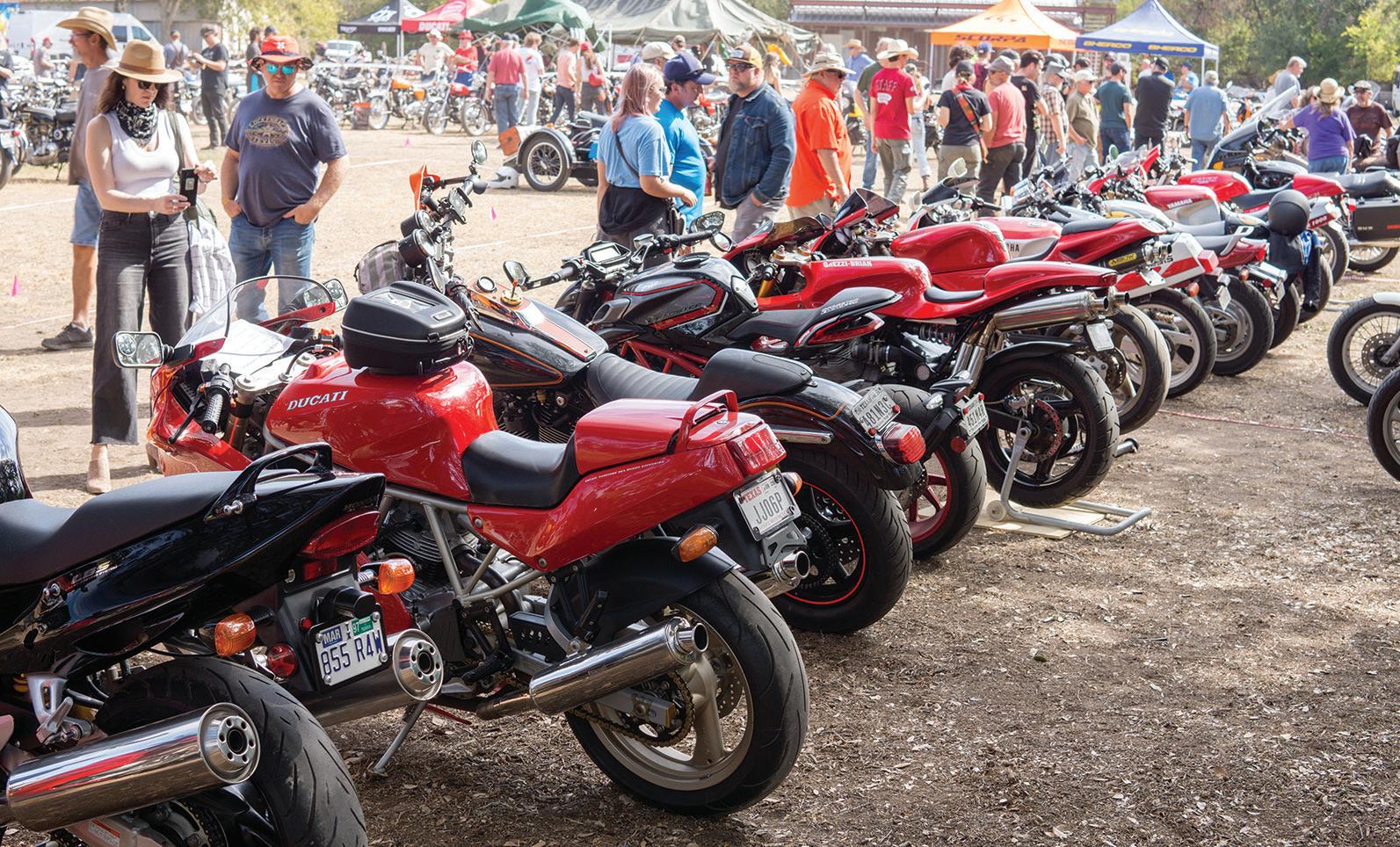
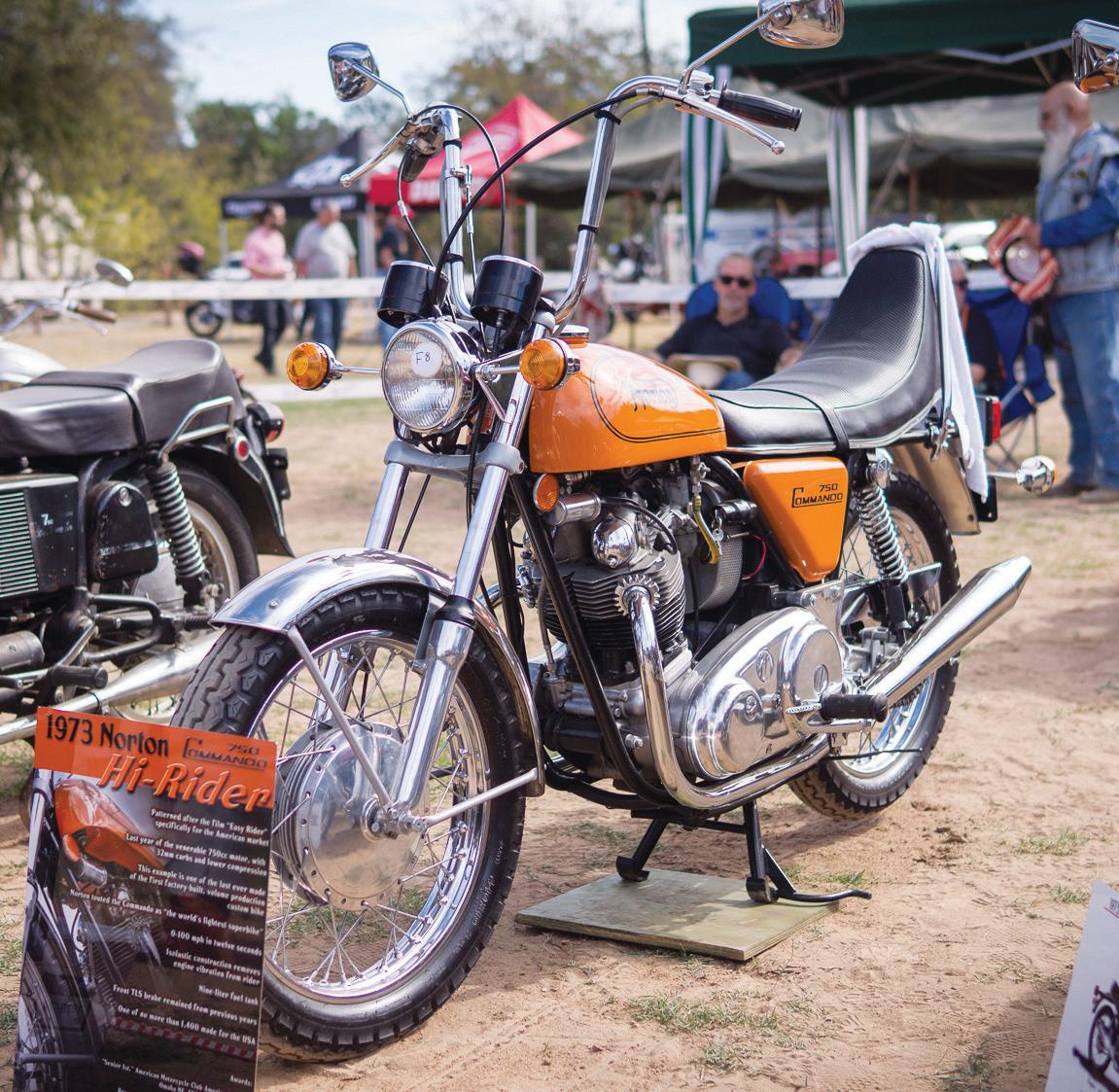
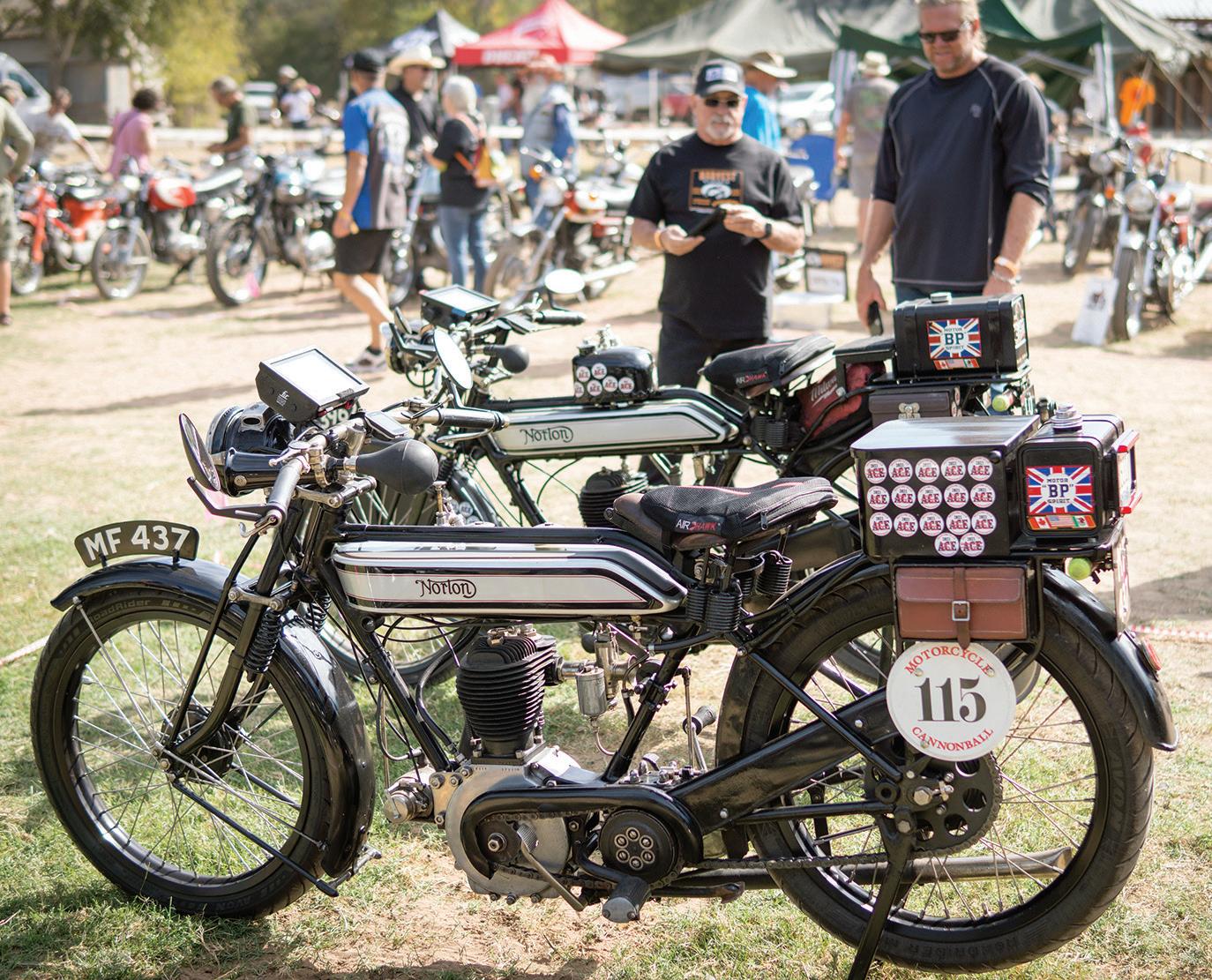
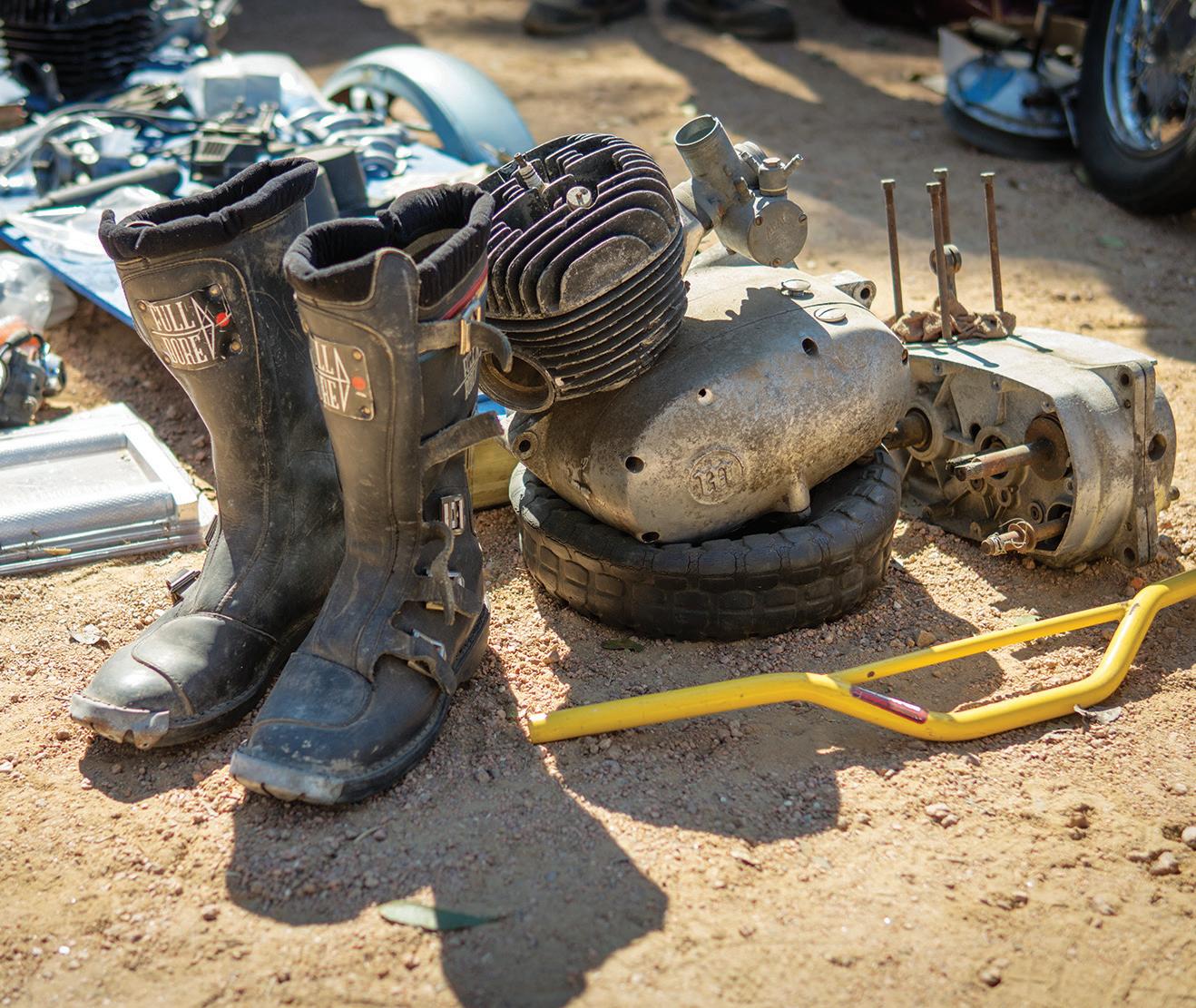


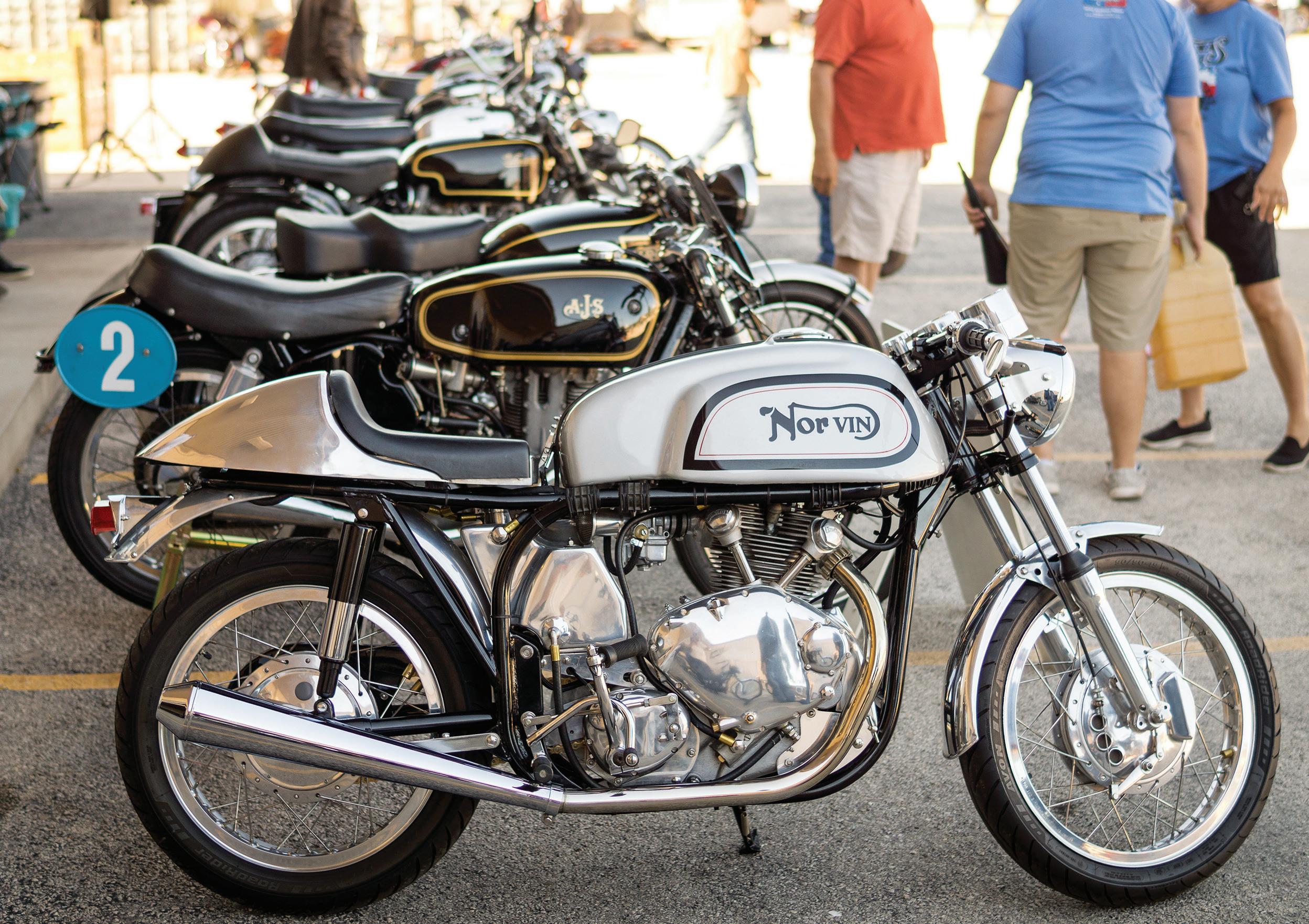
The 10th edition of the Texas Motorcycle Revival was held at the Hill Country Motorheads Museum in Burnet, Texas, in November 2022. This was the second year that the event was held at the museum, but it was the tenth edition because the event was previously hosted by a motorcycle dealership in Georgetown, Texas, starting in 2009. The dealership was eventually sold, and the new owners weren’t interested in continuing the event, so the Revival went on a two-year hiatus.
Steve Littlefield, the original owner of the dealership, reached out to Pat Hanlon, owner of the Hill Country Motorheads Museum and the two vintage motorcycle enthusiasts agreed that the show must go on. The Texas Motorcycle Revival was reborn at the museum in 2021 and proved very popular, with hundreds of attendees at the one-day event. In addition to the machines on display in the museum, the parking lot was full of classic and vintage bikes brought by local enthusiasts.
The 2022 event honored former racer Ronnie Lunsford, who passed away earlier in the year from injuries suffered in a motorcycle accident. During his racing career, Ronnie won multiple championships and was inducted into the Central Motorcycle Roadracing Association Hall of Fame in 2004. Lunsford owned and operated the Northwest Honda Ducati dealership, and he organized the Honda-sponsored Houston Ride for the Kids, a fundraiser for the Pediatric Brain Tumor Foundation which continues today. One of Ronnie’s racing pictures was featured on this year’s Revival event T-shirt and
three of Ronnie’s prized Hondas are on display in the museum. The Texas Motorcycle Revival was a bargain — the $5 admission fee provided over 500 attendees access to more than 100 vintage motorcycles brought by show entrants, in addition to the 130 machines on display in the museum. There were several special motorcycles on display from the Sierra Madre Motorcycle Company including a 1914 Yale, an inline 4-cylinder 1922 Henderson Deluxe and a 1902 Indian Camelback. The Henderson was parked out in front of the museum and Steve Klein, Sierra Madre owner, entertained the crowd by firing up the 100-year-old bike several times throughout the day.
Hosting the Texas Motorcycle Revival fits well with the Hill Country Motorheads Motorcycle Museum’s mission to exhibit, restore and preserve vintage motorcycle history. For husbandand-wife team Pat and Jenell Hanlon, running the museum and sponsoring the event is a labor of love. Says Janell: “I love the slow-paced feel of the Texas Motorcycle Revival. People can take their time to enjoy the exhibitor motorcycles and museum displays, swap stories with friends and relive the good old days.”
With the demise of the Harvest Classic, the Texas Motorcycle Revival has become the main Fall event of its kind in Central Texas. The near-term goal is to maintain the overall feel of the event but eventually grow the number of bikes on display in the parking lot to 300 and attract more attendees. Plans include expanding the age range of eligible bikes from 25 years old to 20 years, adding more classifications and featuring special guests.
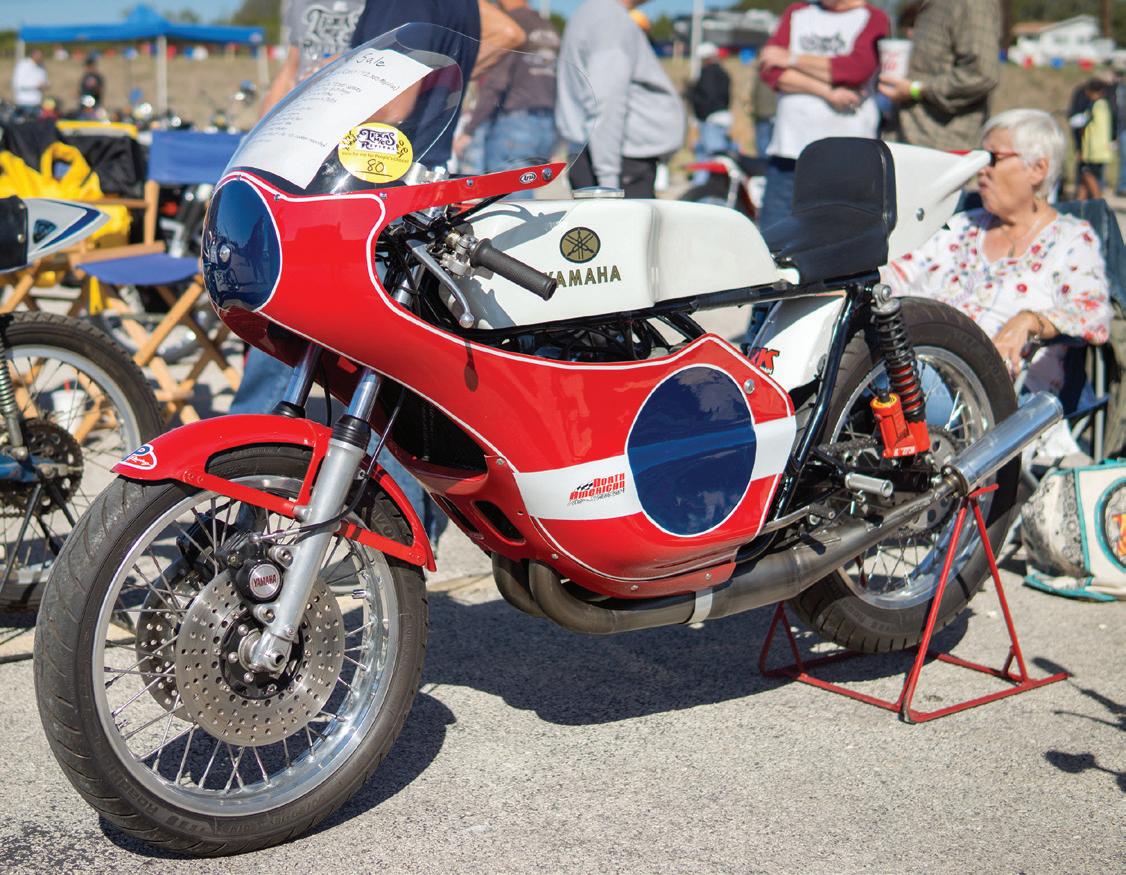
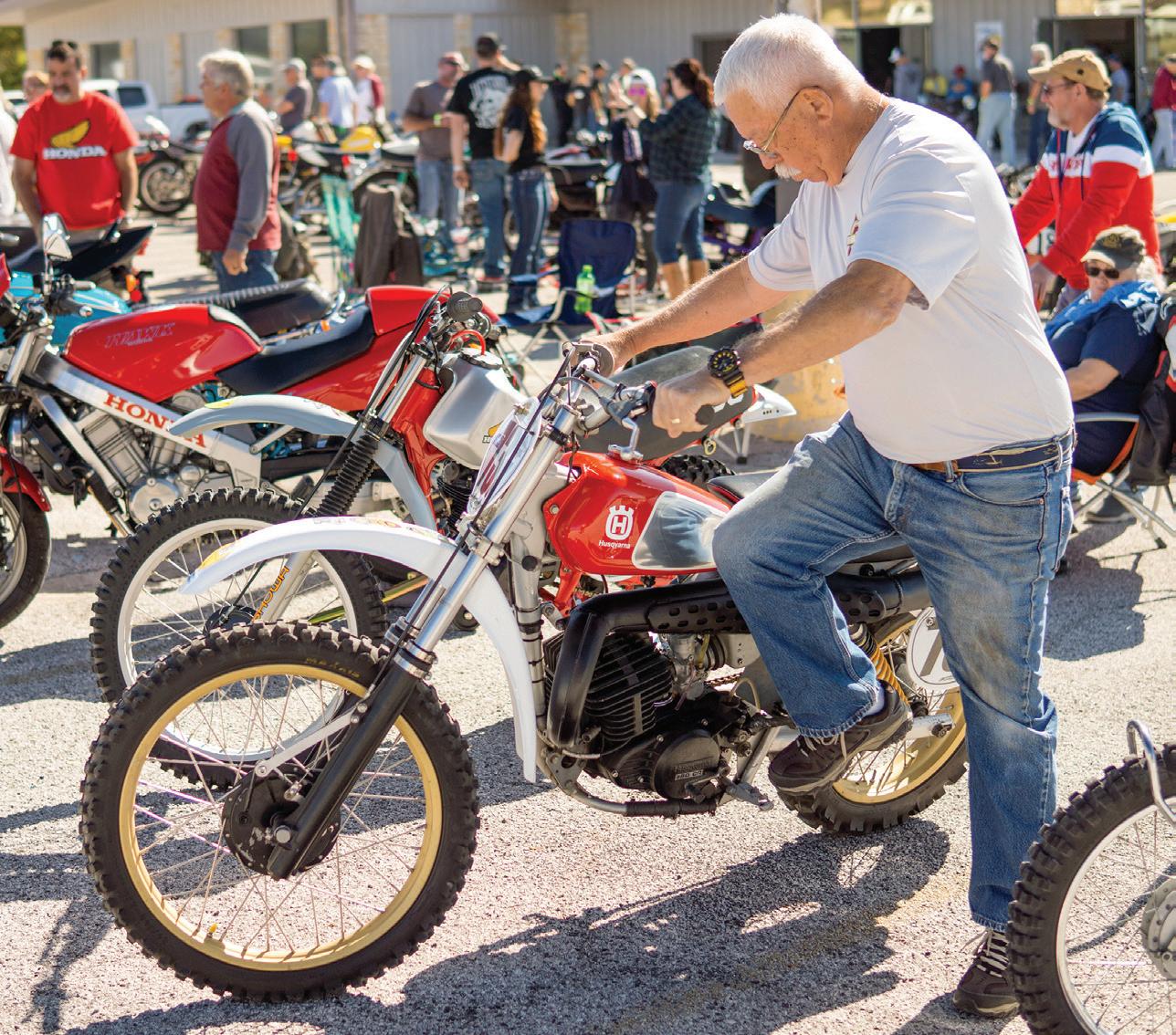
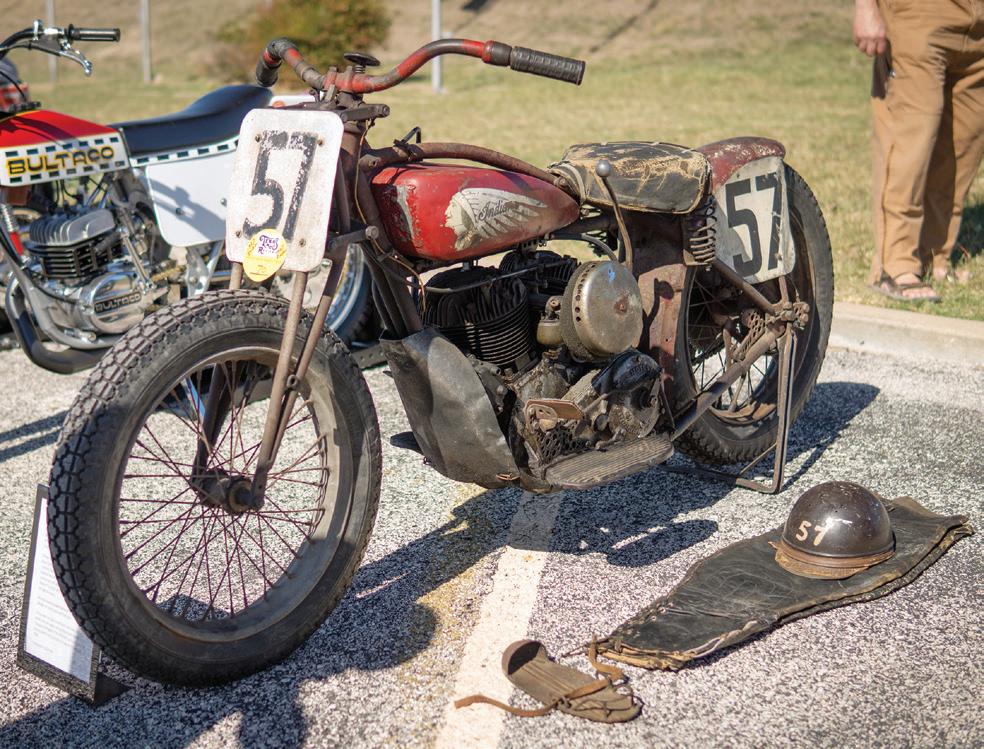
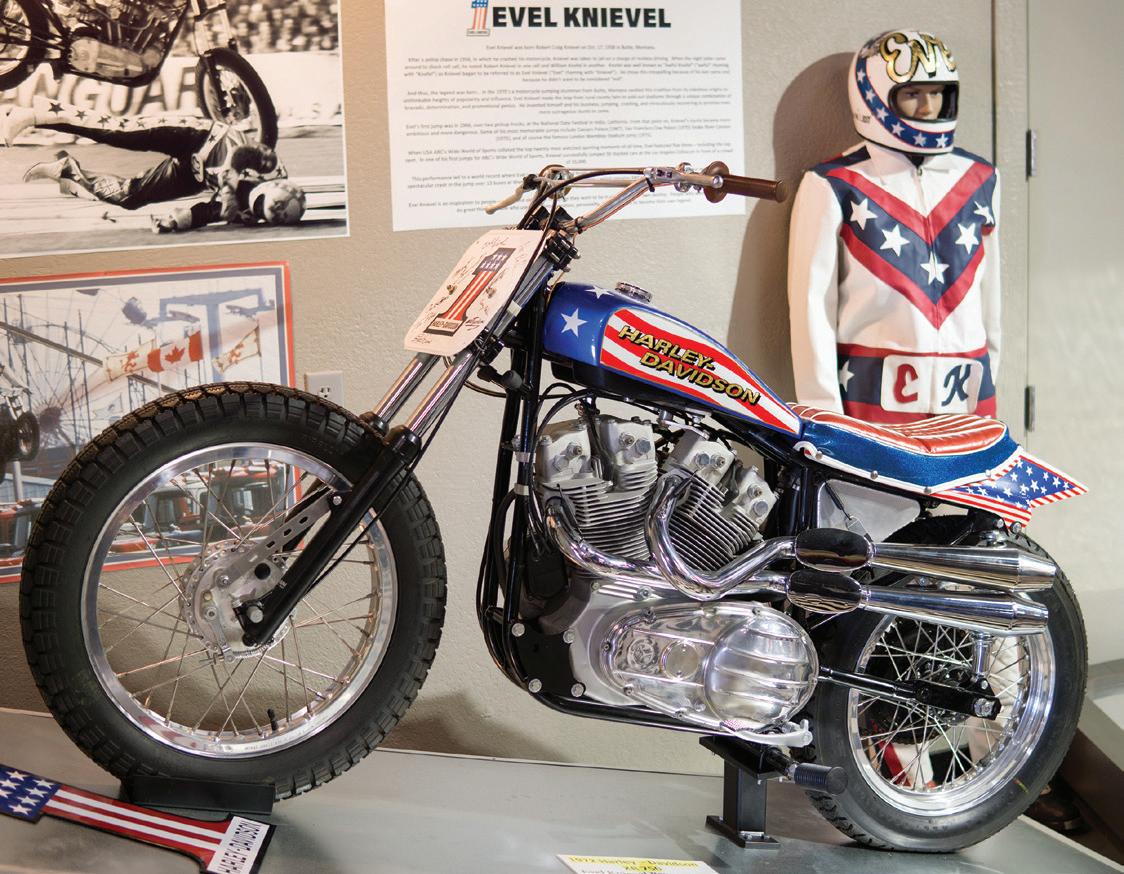
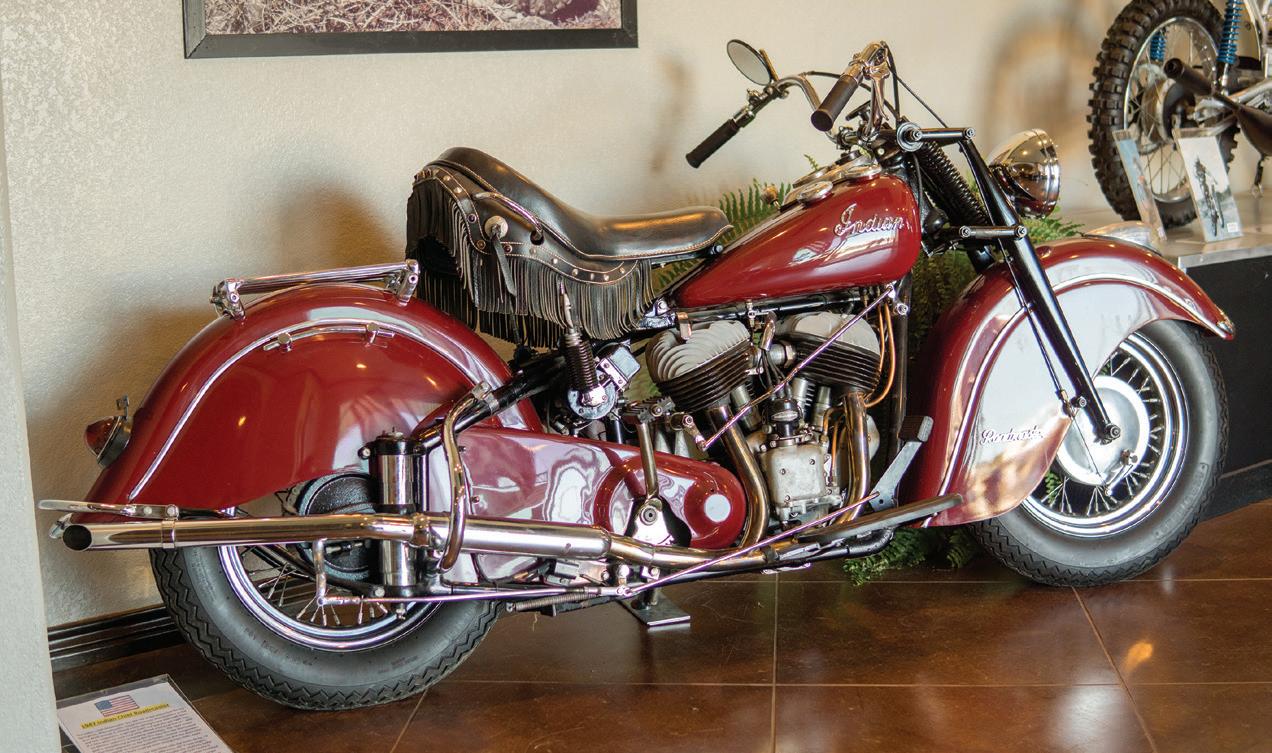
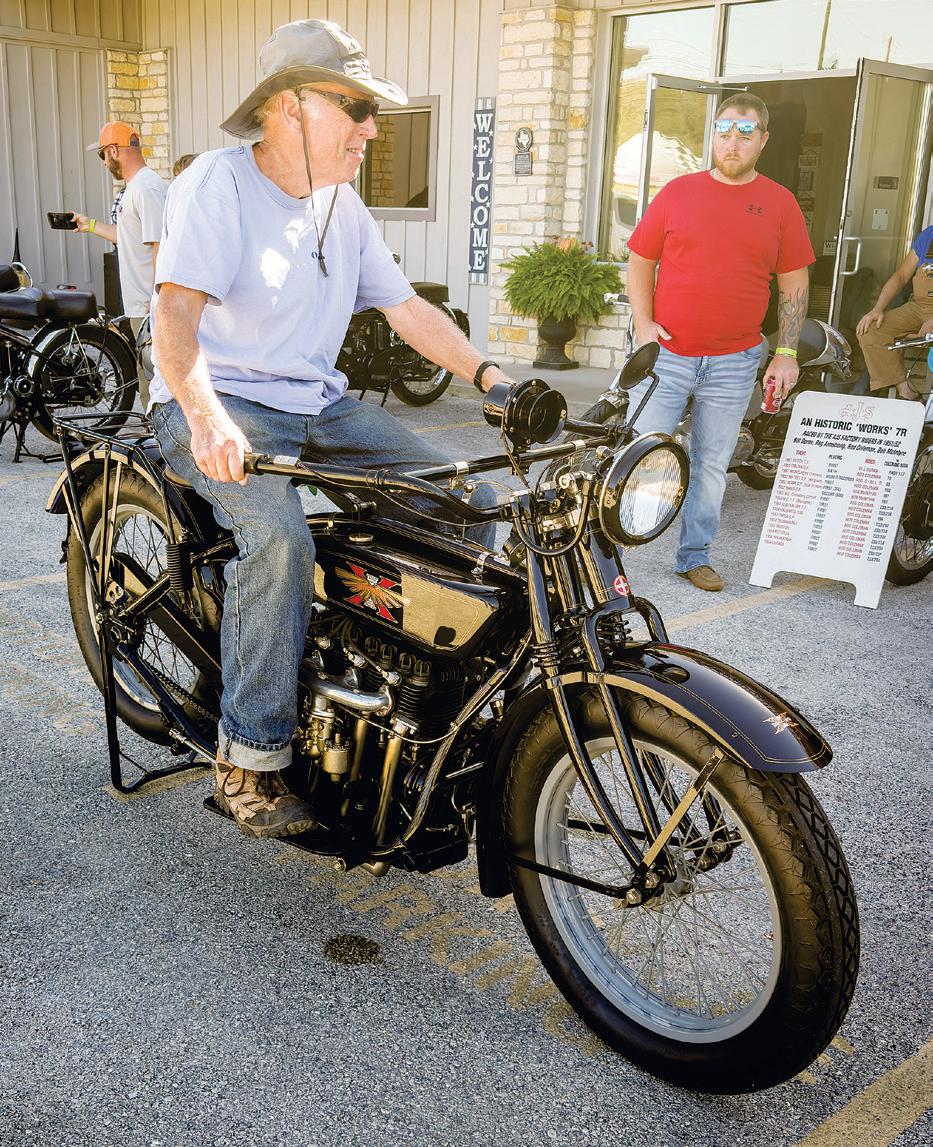
Pat Hanlon shared his thoughts about the end of the Harvest Classic Rally and the future of the Texas Motorcycle Revival: “We’re disappointed to lose the much-loved Harvest Classic Rally. We moved to the Hill Country in 2014 and once we discovered the Harvest Rally, we became faithful supporters. The Harvest team did a phenomenal job of educating and promoting vintage motorcycle collecting and, with the Harvest’s exodus, enthusiasts will be searching for new venues to display their bikes and share them with the public. We hope the Texas Motorcycle Revival will help fill the void as a low-cost, accessible, one-day event appealing to vintage bike collectors and enthusiasts, especially considering our typically mild weather and small-town setting in the Texas Hill Country.”
The 11th annual Texas Motorcycle Revival event is planned for Saturday, November 4, 2023. For more information about
the Hill Country Motorheads Museum and next year’s event, visit hillcountrymotorheads.com and click on the Texas M/C Revival tab at the top of the page.
The Texas vintage motorcycle world keeps spinning
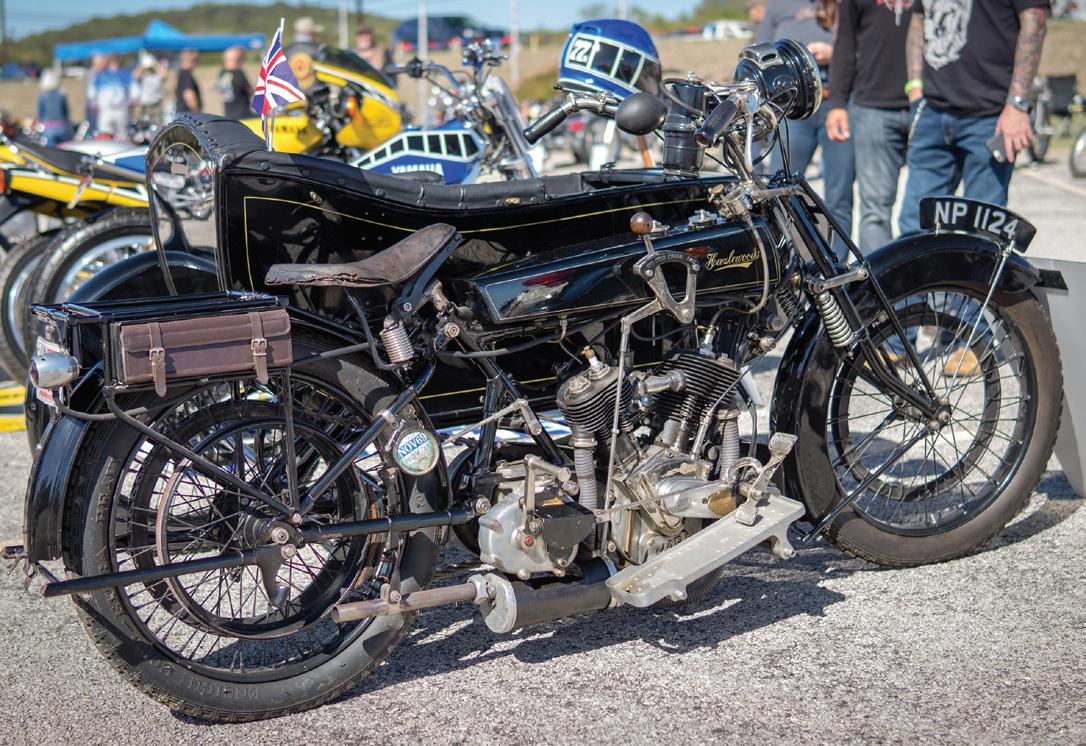
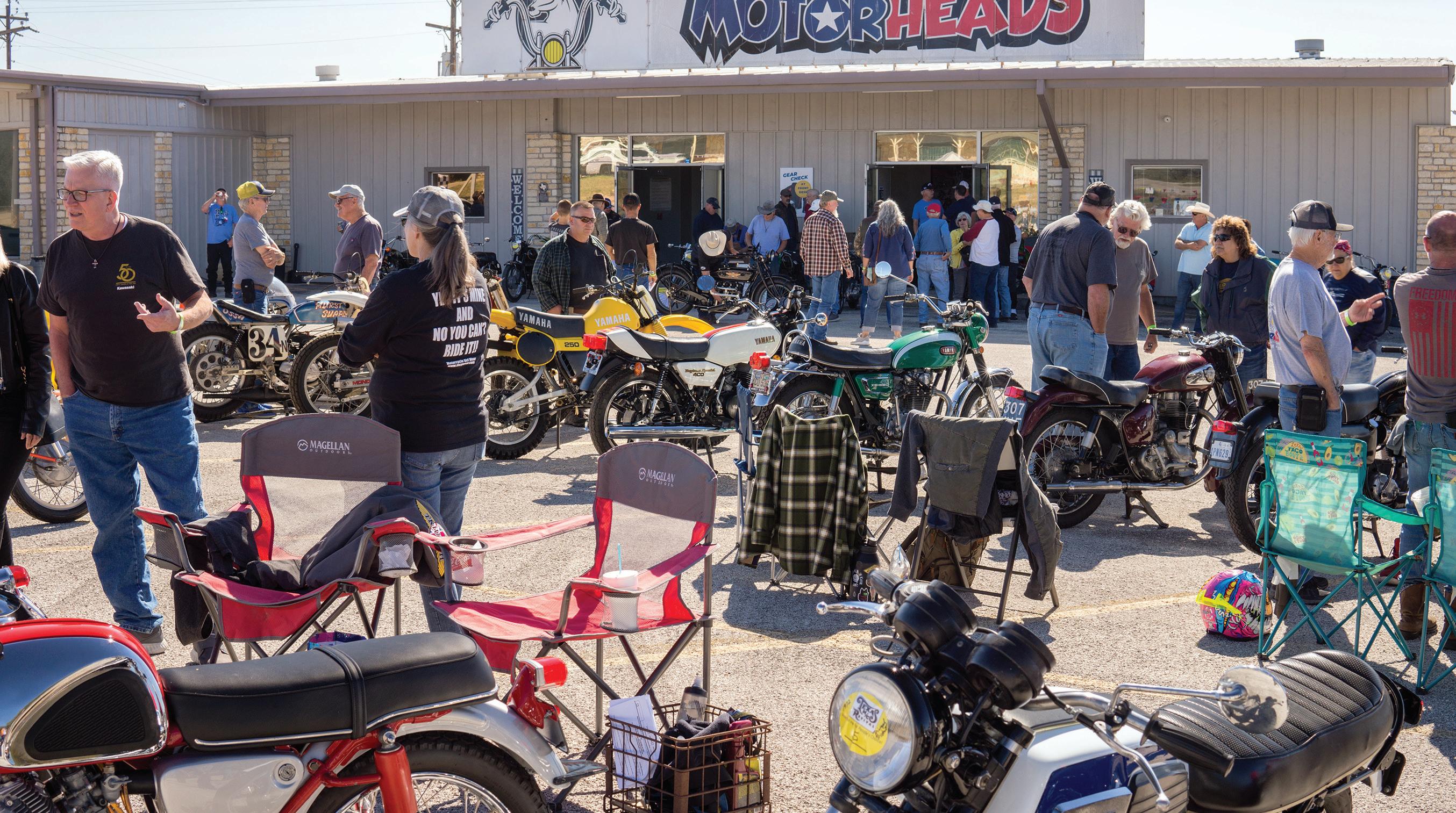
The natural world is cyclical — hot and cold, day and night, wet and dry — and this tale of cycles is about more than motorcycles; it’s also about life’s endless cycle of renewal and continuation. The Harvest Classic Rally was a very special event, and it will be greatly missed, but it’s comforting to know that the Hill Country Motorheads Museum has stepped into the breach and is breathing new life into an exciting event that we can look forward to each Fall. I believe the legendary Texas musician, Robert Earl Keen, was right when he sang: “The Road Goes on Forever and the Party Never Ends.” MC
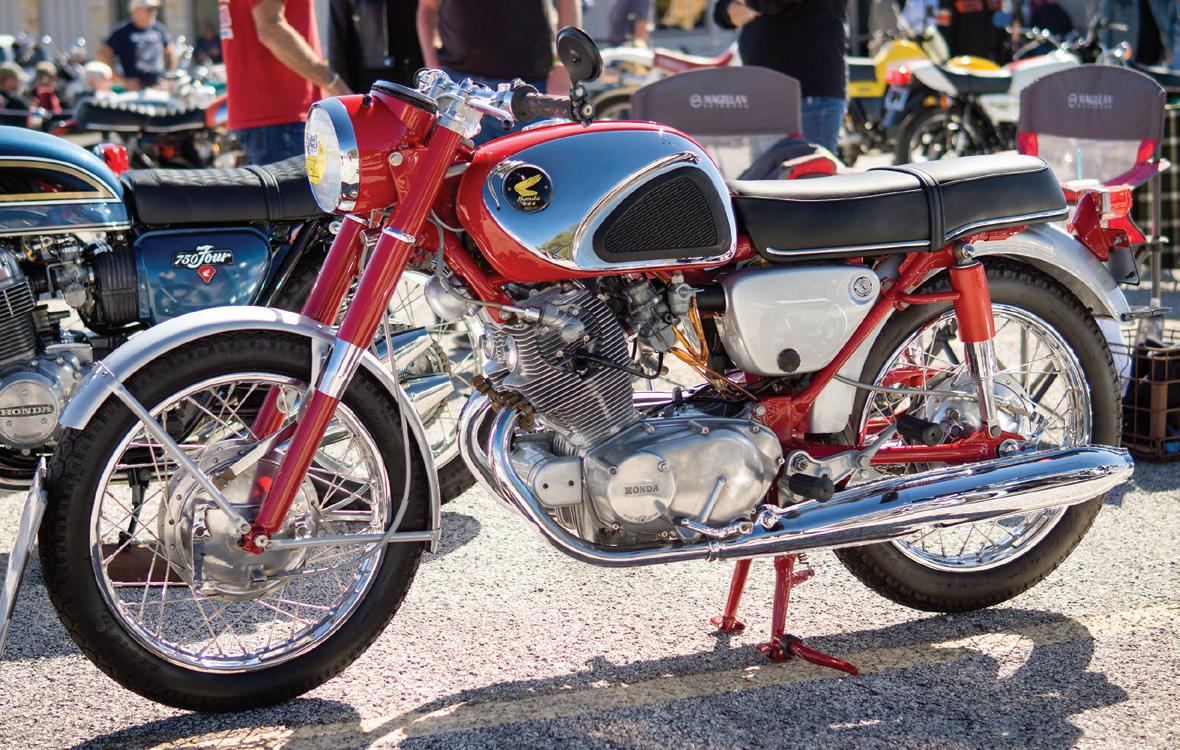

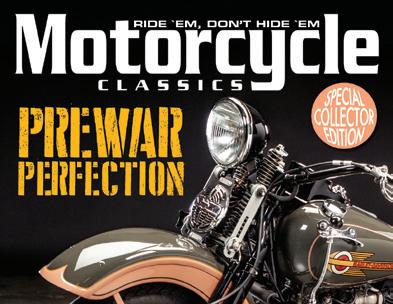






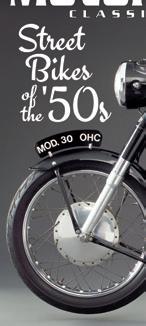
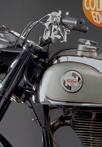
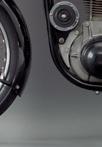
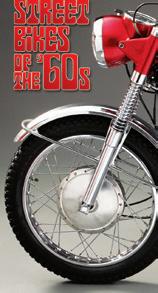
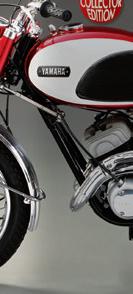
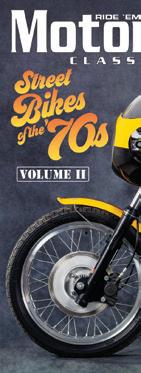




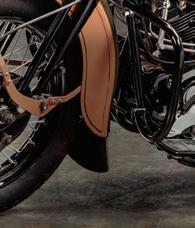

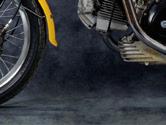
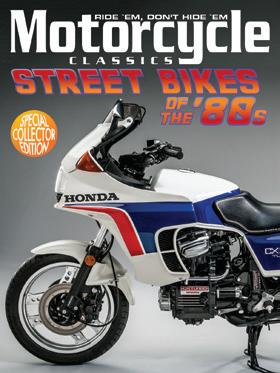


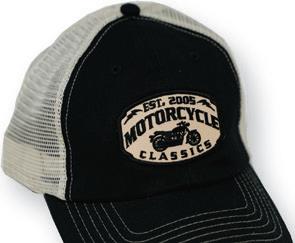














 Story by Alan Cathcart
Photos by Kel Edge
Story by Alan Cathcart
Photos by Kel Edge
VVincent’s OHV Comet single is invariably considered the poor relation of the historic British marque’s series of V-twins that are widely accepted to be the first Superbikes of the modern era. But the 31 examples of the Grey Flash racing version built in 1949-1950 are a different matter.
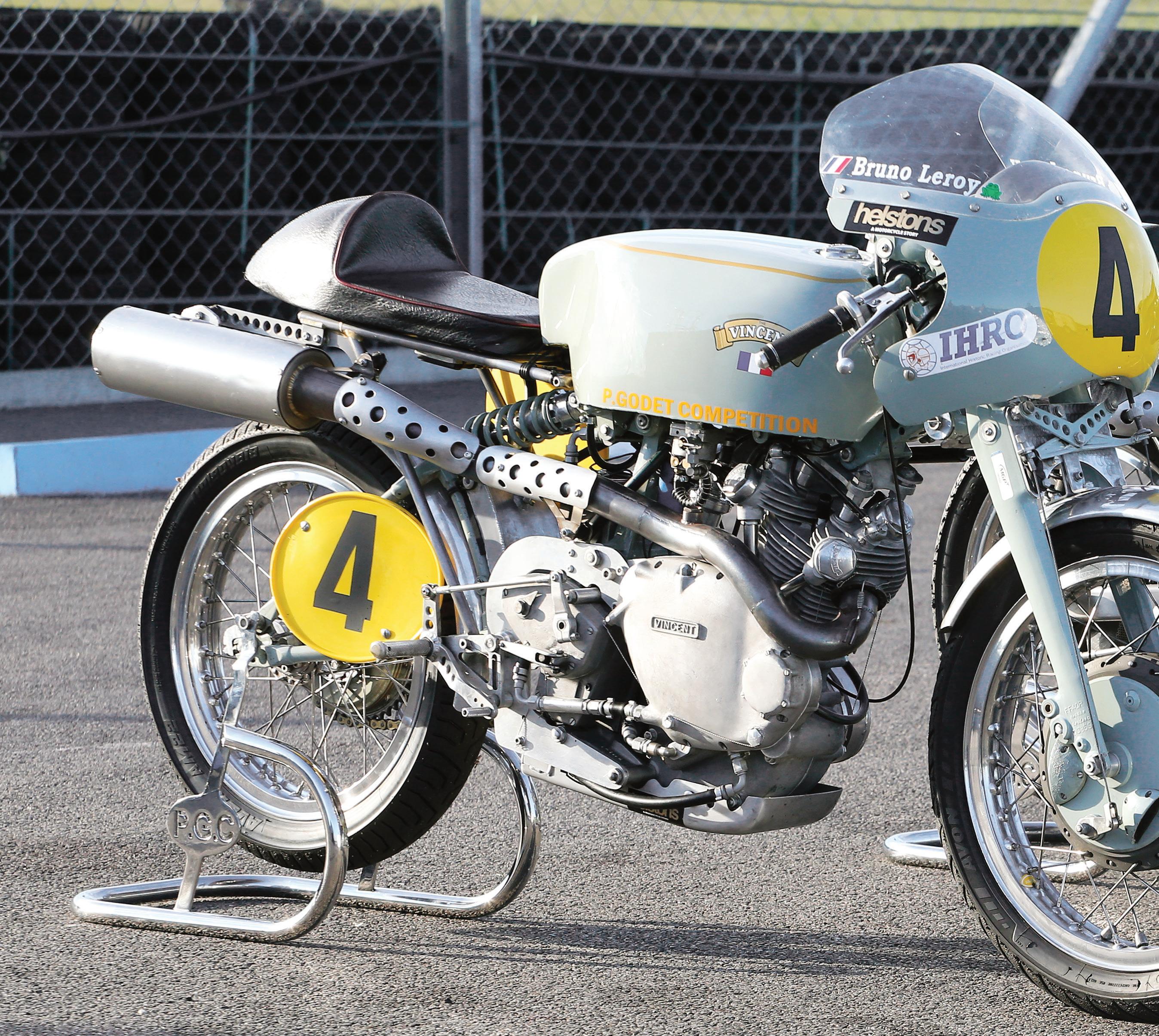
The Comet was conceived by Vincent’s Aussie designer Phil Irving in 1935, by reputedly selecting the smallest cylinder bore he could get his hand into to clean the inside! That turned out to be 84mm, which matched to a 90mm stroke delivered 499cc, and these remained the cylinder dimensions of all Vincent twins and singles built up until the company’s demise in 1955. The Comet remained in production through this period, and the success of the high performance Black Lightning version of his V-twin models introduced in 1948 prompted company owner Philip Vincent to attempt the same strategy with his single-cylinder model by producing the first Grey Flash in 1949.
Unlike the Lightning which was only produced as a racer, the Grey Flash was available in three variants: a stripped-down racer, a 100% road version, and a hybrid model which came as a road
bike, but “with all the extras necessary for stripping and preparing for racing,” as it said in the Vincent catalog. Heavily based on the Comet roadster, its performance was augmented by porting the cylinder head and fitting bigger valves — a 45.6mm inlet and 42.55mm exhaust, each fitted with triple valve springs — plus a 32mm 10TT9 Amal carb. Other tuning mods included higher lift Mk2 Lightning cams, polished Vibrac nickel chrome steel conrod and flywheels, a 51mm diameter straight-through exhaust, and raising the compression ratio to a heady 8:1 thanks to the poor octane level of Pool petrol then in use. These were combined with a BTH racing magneto, and a separate 4-speed Albion race gearbox in a magnesium casing but still with chain primary drive, replacing the 7-pound heavier Burman unit of the roadster, requiring different frame brackets for installation, but resulting in a closed-up set of gear ratios.
Chassis modifications entailed stripping off all the Comet’s
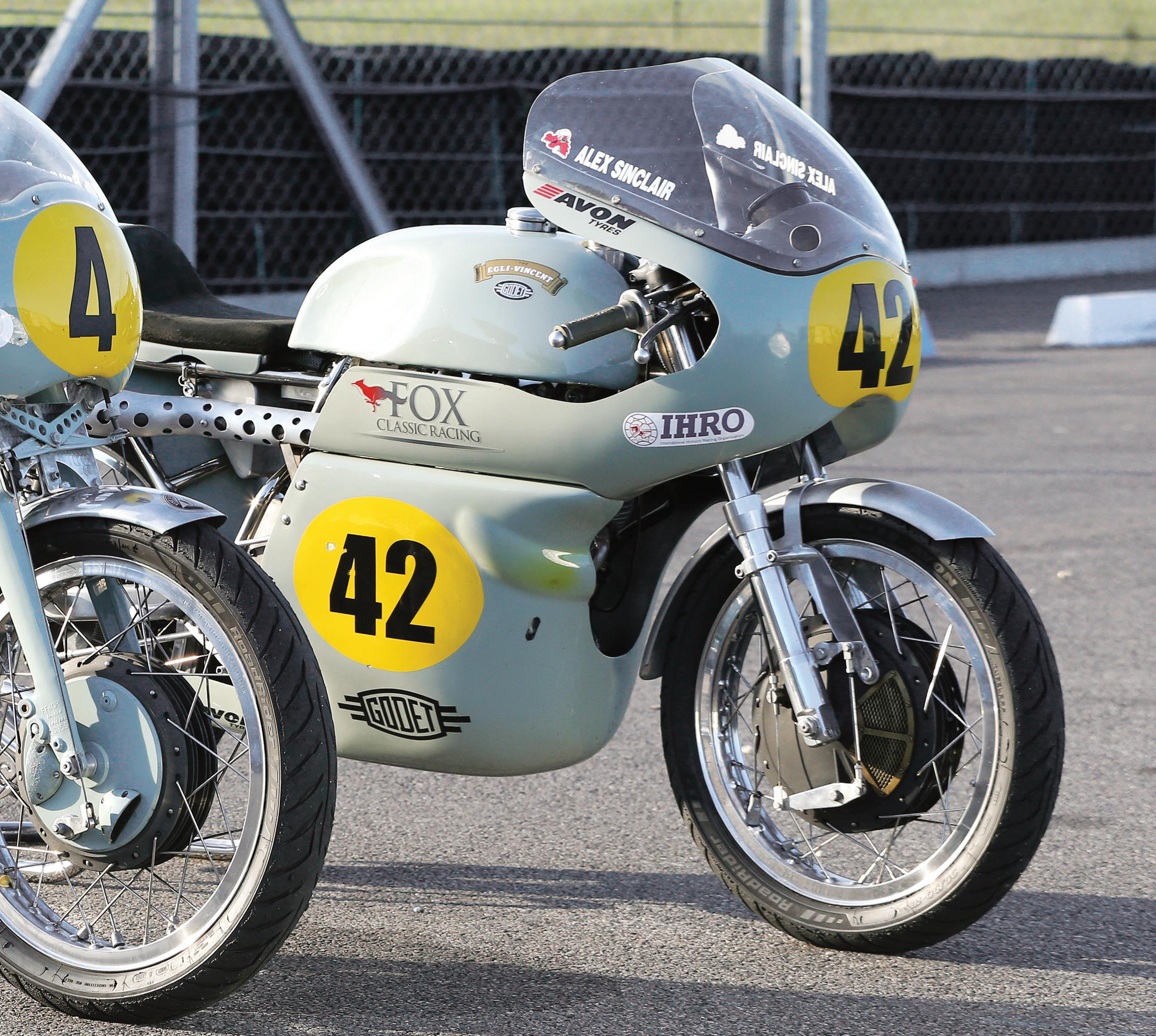
Engine: Air-cooled 499.9cc 4-stroke pushrod OHV single-cylinder, 92mm x 75.2mm bore and stroke 11.8:1 compression ratio, 58hp at 7,900rpm (at rear wheel), 44.12 ft-lb at 5,500rpm
Top speed: 120mph (est.)
Carburetion: Single 40mm Gardner
Ignition: Ignitec CDI with 12v battery
Gearbox: 6-speed TT Industries Albion
Frame/wheelbase: Fabricated steel monocoque backbone chassis incorporating the oil tank, with engine comprising a fully stressed member/56in (1,422mm)
Suspension: Vincent Girdraulic parallelogram wishbone fork with Thornton shock front, cantilever swingarm with Thornton monoshock rear
road equipment, fitting the Grey Flash’s unique design of a one-piece racing seat (quite unlike a Lightning V-twin’s one, though), and grooving the inside of the Girdraulic fork’s twin blades to reduce weight further. Twin 7-inch Vincent SLS drum brakes were fitted up front with one at the rear, with magnesium brake plates, and a 21-inch front wheel and 20-inch rear carrying alloy rims. In this form, the standard Flash weighed 330 pounds dry and yielded a quoted “40 horsepower and upward at 6,200rpm, depending on fuel,” though in 1949 tester George Brown wound the factory prototype up to 8,000rpm and 115mph on Pool petrol at Gransden Lodge circuit, without anything breaking. Brown finished third in the bike’s May 1949 debut race against a quality field in front of 35,000 spectators at Eppynt in Wales, prompting the official receiver E.C. Baillie (who was by then in charge of Vincent’s affairs
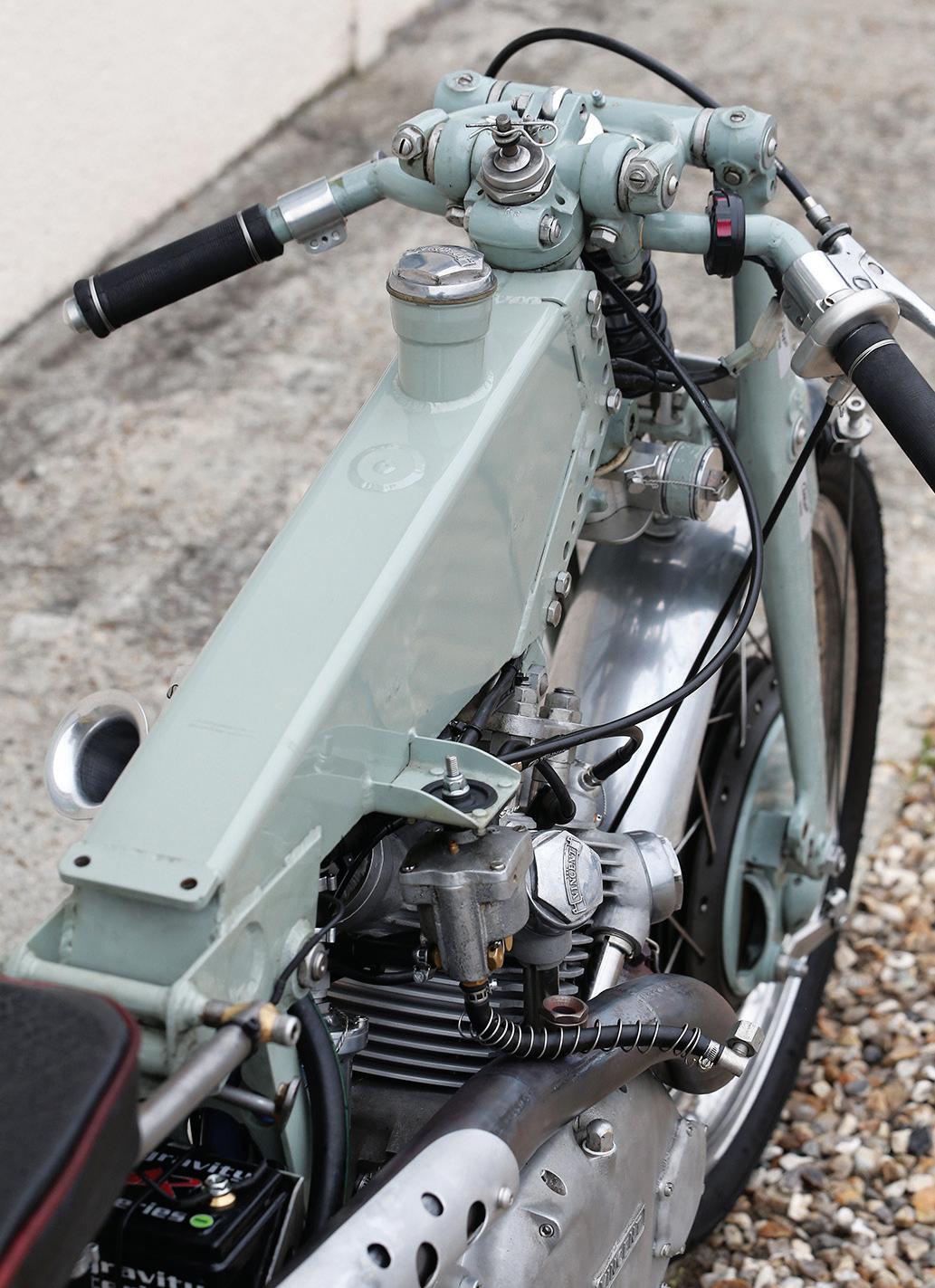
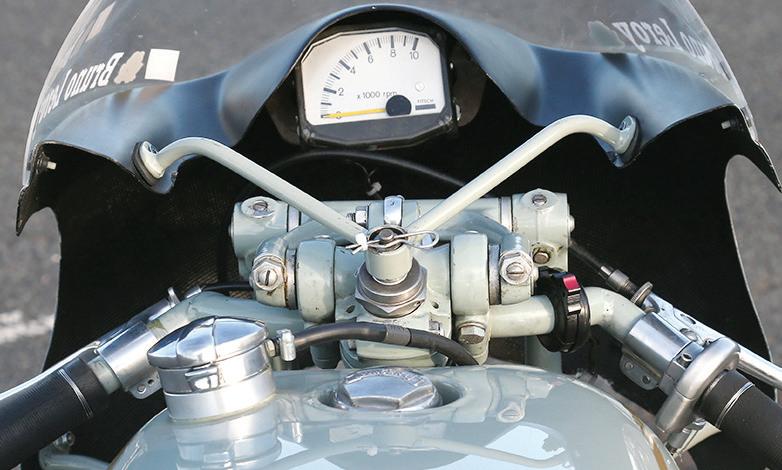
Brakes: 8.3in (210mm) Seeley TLS drum with floating shoes front, Vincent 7in (178mm) SLS drum rear
Tires: 90/90 x 19in Avon Roadrider front, 110/80 x 18in Avon AM22 rear
Weight: 123 kg with oil, no fuel
Year of manufacture: 2014 to 1950 specification
Owner: Godet Motorcycles, Malaunay, France, godet-motorcycles.fr
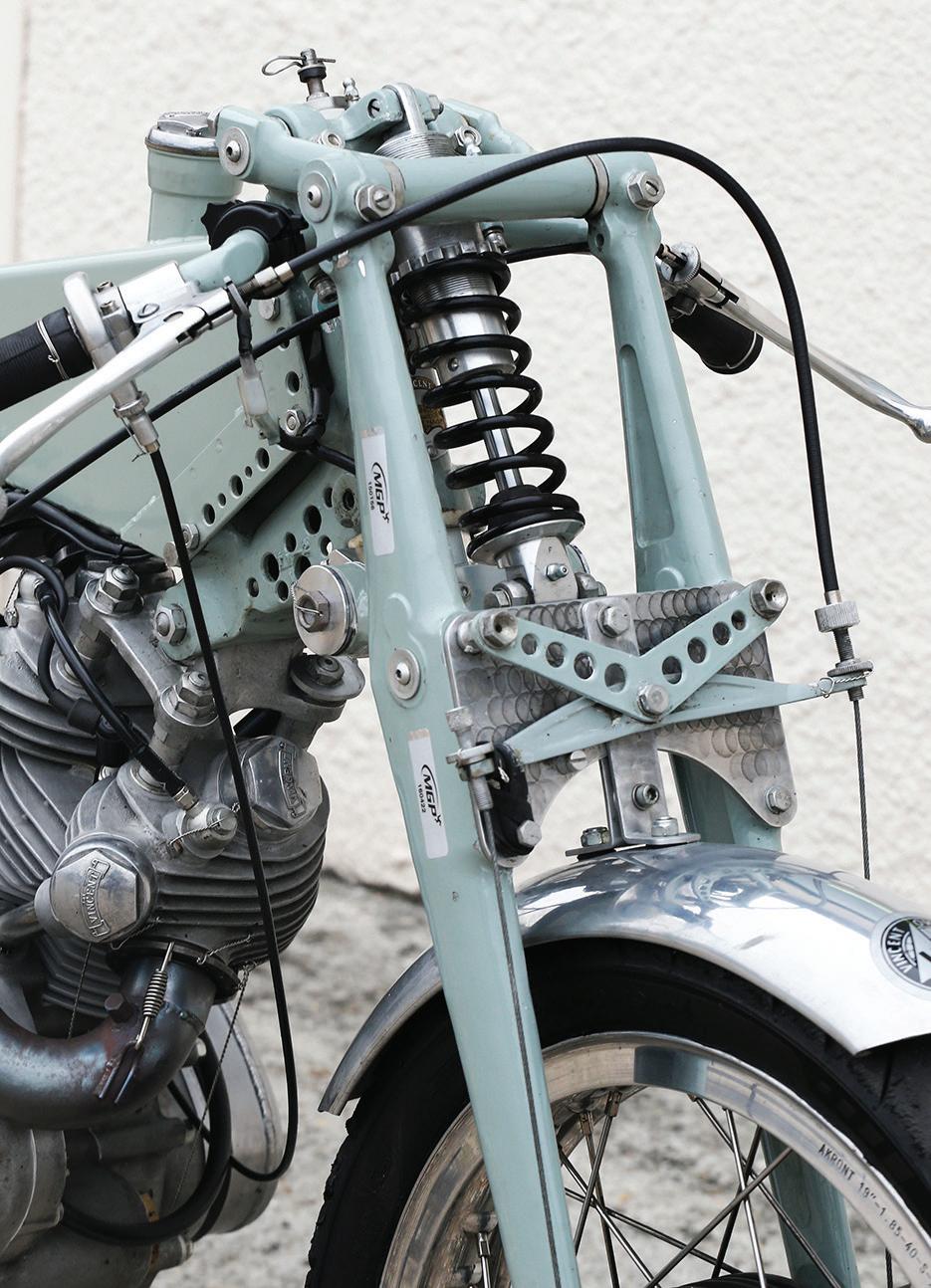
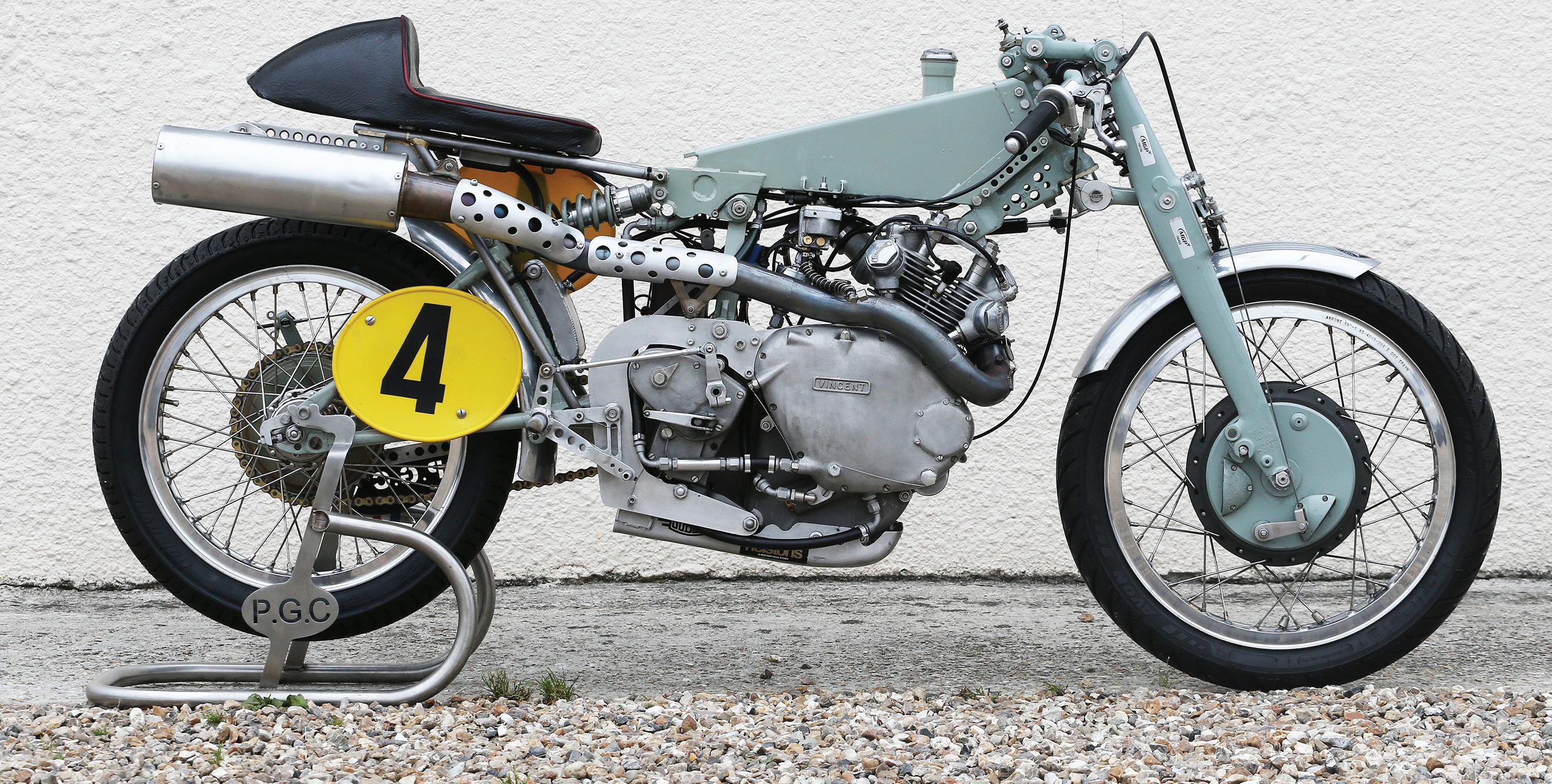
while the company was in administration) to sanction the entry of four bikes in the Senior TT in an attempt to reassure customers that HRD-Vincent was very much still in business. Sadly, problems with an experimental plain-bearing crank and larger valves, which broke at the higher revs demanded of the engine, resulted in only one bike of the four finishing the seven-lap race, ridden by Ken Bills to 12th place at 83.79mph.
Though export sales had been good, with four bikes sent to Brazilian customers, three each to France and Rhodesia, two to Canada etc., only five Grey Flashes found homes in the U.K., and the disappointing TT results meant sales of what had been intended to be a more affordable pushrod alternative to the “cammy” Manx Norton tailed right off, with the model officially deleted from Vincent’s range in August 1950. Even the sterling
The Vincent Girdraulic front fork uses a Thornton shock absorber. The fuel tank is incorporated into the monocoque backbone chassis.performances the following year on short circuits of Vincent apprentice John Surtees on a bike he’d built himself from a partly dismantled test hack, including leading World champion Geoff Duke’s Norton for many laps at Thruxton in August, didn’t endow the Flash with enough appeal to be commercially viable. Pity.
Fast forward seven decades, and it’s ironic that for the past several years pre-pandemic, the most committed and most successful waver of the Vincent marque’s flag in topline Classic racing on the Isle of Man, in Australia and all over Europe was not British, as would befit one of our most historic if shortlived motorcycle marques, but a “bloody Frog.” Using that term denotes no sense of chauvinism (though, of course, Monsieur Chauvin was indeed, er — French), for that’s what the late Patrick Godet, French Vincent expert par excellence, always called himself!
Patrick Frog sadly passed away in November 2018, aged 67, at his home in the Normandy countryside north of Rouen, and his loss has been keenly felt by Vincent owners and enthusiasts all over the world, as well as by his many friends in the Classic
racing scene. Many of them have used the vast array of high quality Godet Motorcycles parts to restore or maintain their original Vincents, while others are fortunate to own one of the 280 superbly constructed Egli Vincent V-twins produced by Godet Motorcycles over a 25-year period, with the approval of Fritz Egli himself.
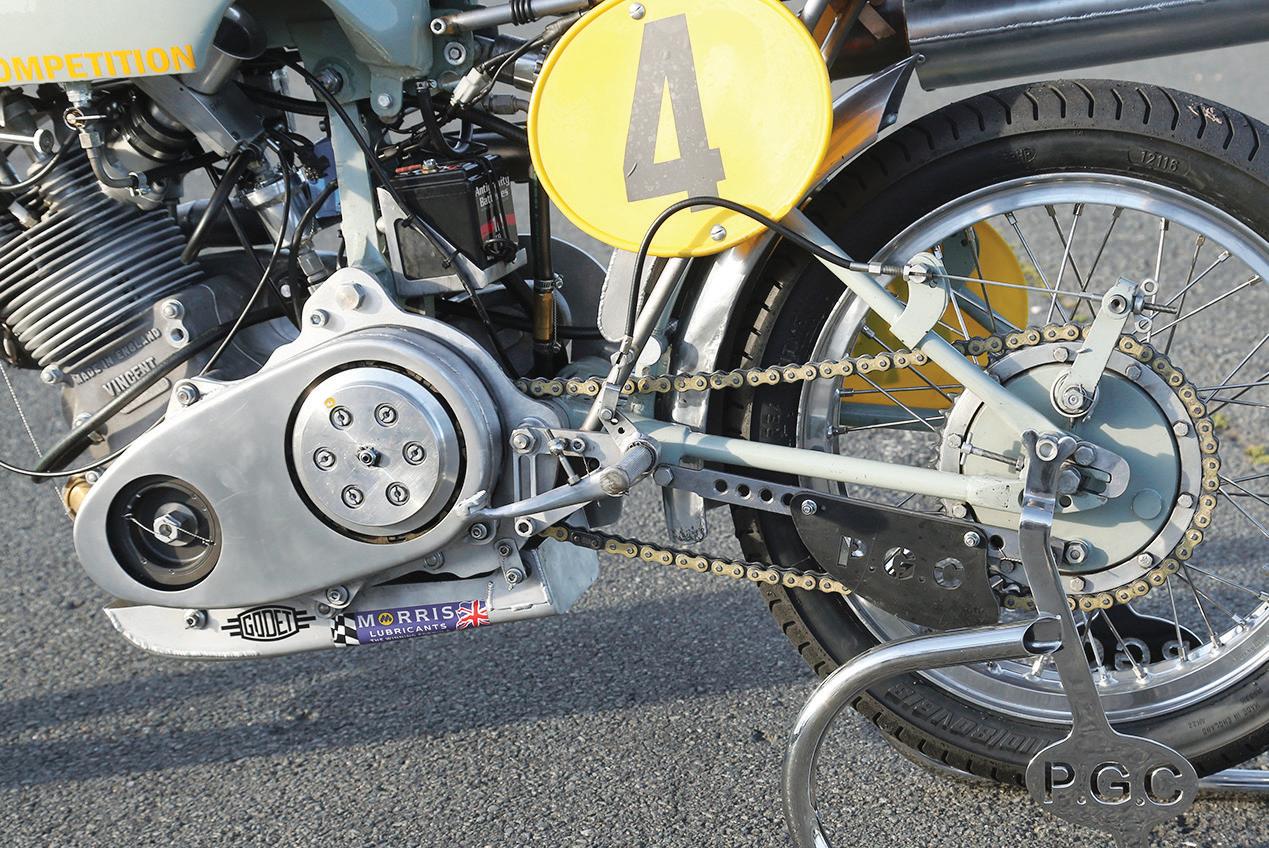

After a topsy-turvy business career which at one time saw him restoring cars for a living with Vincents just a sideline, in 1994 Patrick Godet restarted his motorcycle business, originally focusing exclusively on making Vincents live again. After various ups and downs, Patrick’s long hours of hard work eventually paid off in 2006, when he formed Godet Motorcycles in partnership with one of his customers, legendary French singer Florent Pagny. Today 61, Florent has a collection of 40 Triumphs and half a dozen Vincents in his garage, many of which he rides regularly. After expanding into a 600-square-meter factory at Malaunay, just outside Rouen, with a six-man workforce including his long-time helper Bruno Leroy, (the only French rider to win a race on the Isle of Man TT Course, the 1998 Junior Classic MGP on a Linton Aermacchi), Patrick’s great attention to detail and dedicated enthusiasm in satisfying his customers brought him orders from
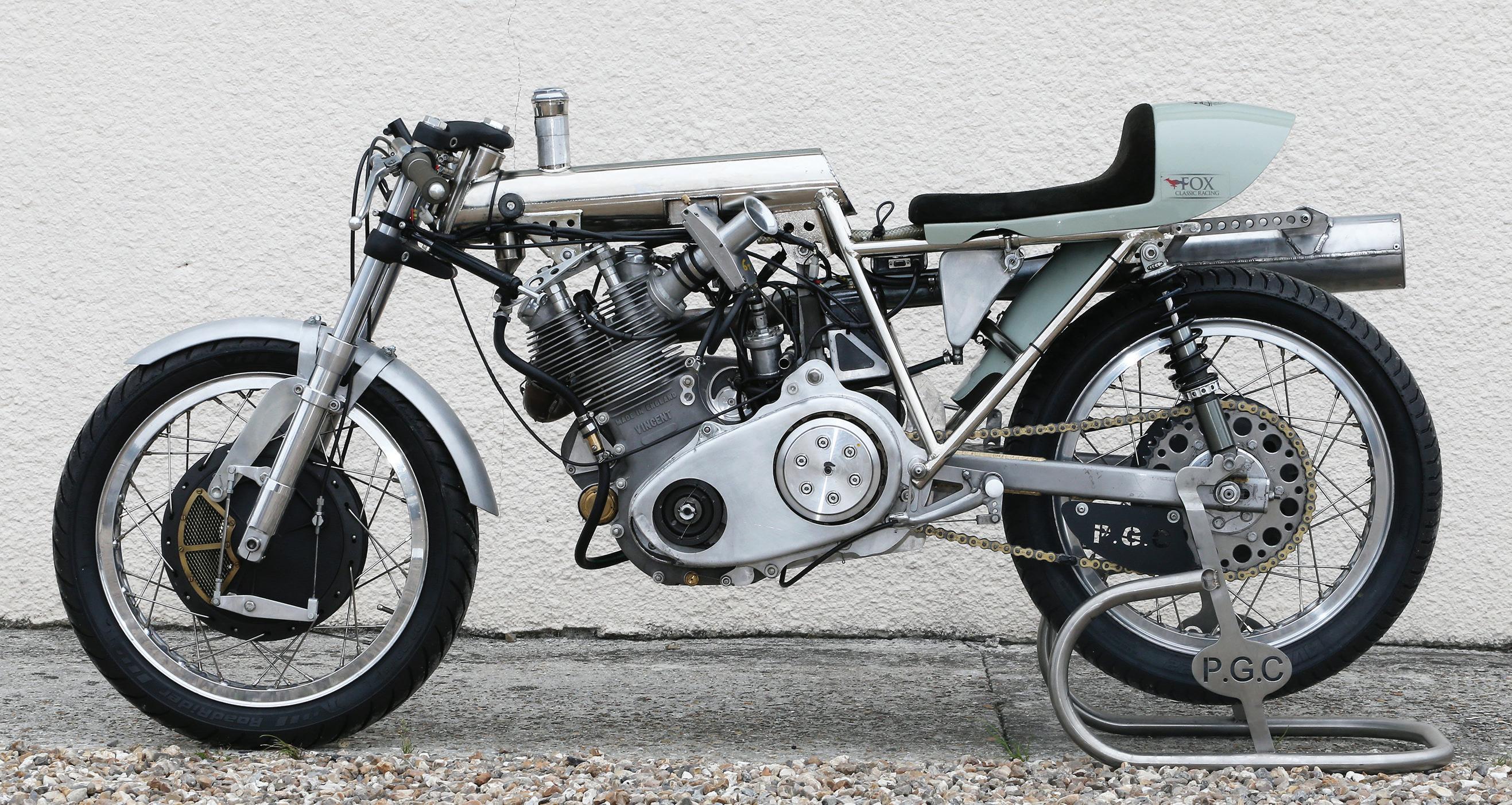
all round the world, including several for Godet-built Vincent 500cc Classic racers.
For as far back as the 1980s, Godet had focused on building a competitive Grey Flash replica for 500cc Classic racing. “I may not be able to get the speed of a cammy bike like a G50 or Manx Norton, but on tight circuits it should be possible to stay with them if I can develop the engine’s good torque further,” he affirmed when he began the project in 1986. Undaunted by various setbacks as he struggled to find the fine balance between making the Vincent single fast enough to stay with the G50s and reliable enough to finish races, in September 1988 he finally achieved his objective of reaching the rostrum in a Historic GP, finishing third at Pergusa in Italy of 27 starters in the IHRO support race to the TT F1 World Championship round, on a circuit circling an extinct volcano whose four chicanes negated the top speed advantage of the cammy bikes.

Thereafter Patrick built five PGC Replicas (Patrick Godet Competition), each a visually authentic Grey Flash built to 1950 specs. But then the demands of business meant he had to set aside his ambitions to chase down Manx Nortons in favor of the day job building Egli Vincent V-twins. But in 2012 with the future of Godet Motorcycles ensured after Florent Pagny’s arrival, he returned to the single-cylinder project — by purchasing a Petty-framed Manx Norton! “Bruno had retired, so I told him I had plans to race the Vincent Comet again, so let’s take the Petty Manx back on the track so he can relearn the TT Course,” Patrick explained. “So he did two seasons with the Petty, including finishing 5th in the 2012 Classic TT, but then once the Comet was ready we retired the Petty, and moved to the Vincent.”
Reasoning that it was impossible to wrap the fairing needed for top end speed so vital at the TT around the Grey Flash chassis, Godet originally developed a more conventional tele-forked Egliframed bike which he used as a rolling test bed for his radically
redeveloped 500cc OHV Vincent engine. Bruno Leroy rode this to 14th place in the 2014 Classic TT at 97.44mph, but the following year despite no bodywork went two places better in the Godetbuilt Grey Flash’s debut race, finishing 12th at 97.48mph — a remarkable performance on the fastest girder-forked bike ever to race at the TT, despite running out of fuel at Governors Bridge on the final lap, and limping across the line with a spluttering engine! Sadly, DNFs came in 2016 with engine problems, and in 2017 when a piece of plastic from the carb jammed between the inlet valve and its seat! The team did not contest the 2018 TT race because of Patrick Godet’s illness, but after his sad passing and the Covid debacle, the overall direction of the company has been taken over by Florent Pagny. It is now flourishing once again, with a seven-man team working on restorations and building new bikes, with a first-ever racing 1,330cc Egli-Vincent up next. Eight 500cc Egli-Vincents have been built and sold so far, with Cameron Donald dominating the 500 singles class in Australian Historic racing on customer Luis Gallur’s bike, and Alex Sinclair has been a regular rostrum finisher in Britain on the Fox Racing bike. Meanwhile Bruno Leroy has been racing a customer’s Grey Flash in France, winning the 500cc AFAMAC title in 2021, and two other such bikes have been sold at a price of €62,000 (€55,000 for an Egli-framed version), another remaining in France, and the third to an American customer named Brad Pitt. Yup, the very same …
Before his sad passing, I was able to spend a day at the Carole circuit on the outskirts of the French capital riding both the current Godet-built Egli and Grey Flash 500cc models, with Patrick himself in attendance to supervise matters. Both had the same radically redeveloped engine delivering an almost incredible 58 horsepower for a pushrod OHV 500cc design at 7,900rpm at the
rear wheel, with peak torque of 44.12lb/ft at 5,500rpm. The engine had been completely revamped internally, with the previous long stroke layout replaced by 92mm x 75.2mm short-stroke dimensions, making the hi-cam/short-pushrod OHV engine now safe to 8,500rpm, Patrick told me. “I have totally redesigned the cases, so they are now exact copies externally of the original ones, but are now in magnesium which saves about five kilos. But inside the timing side it has a modern oil pump which is the key to the extra performance, because the Vincent engine as it is designed cannot

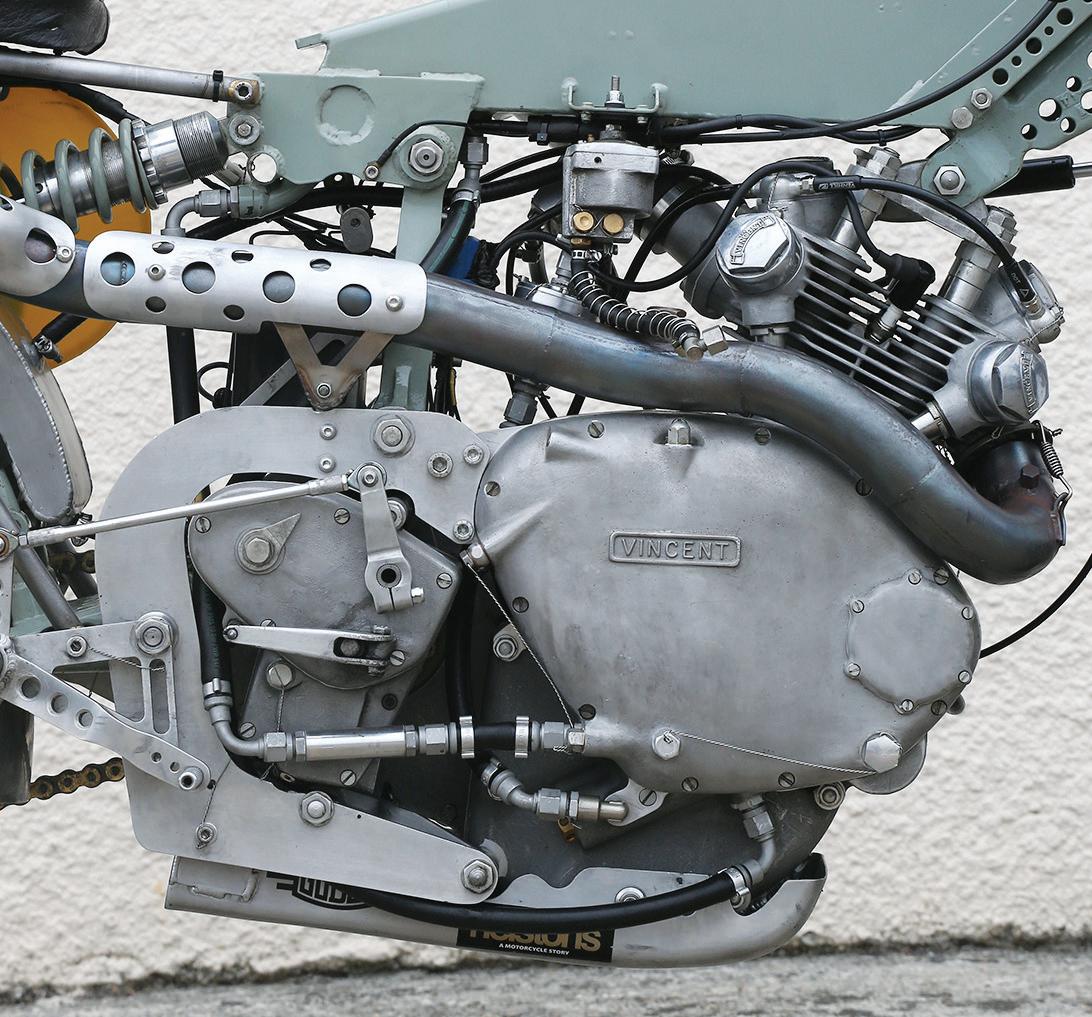
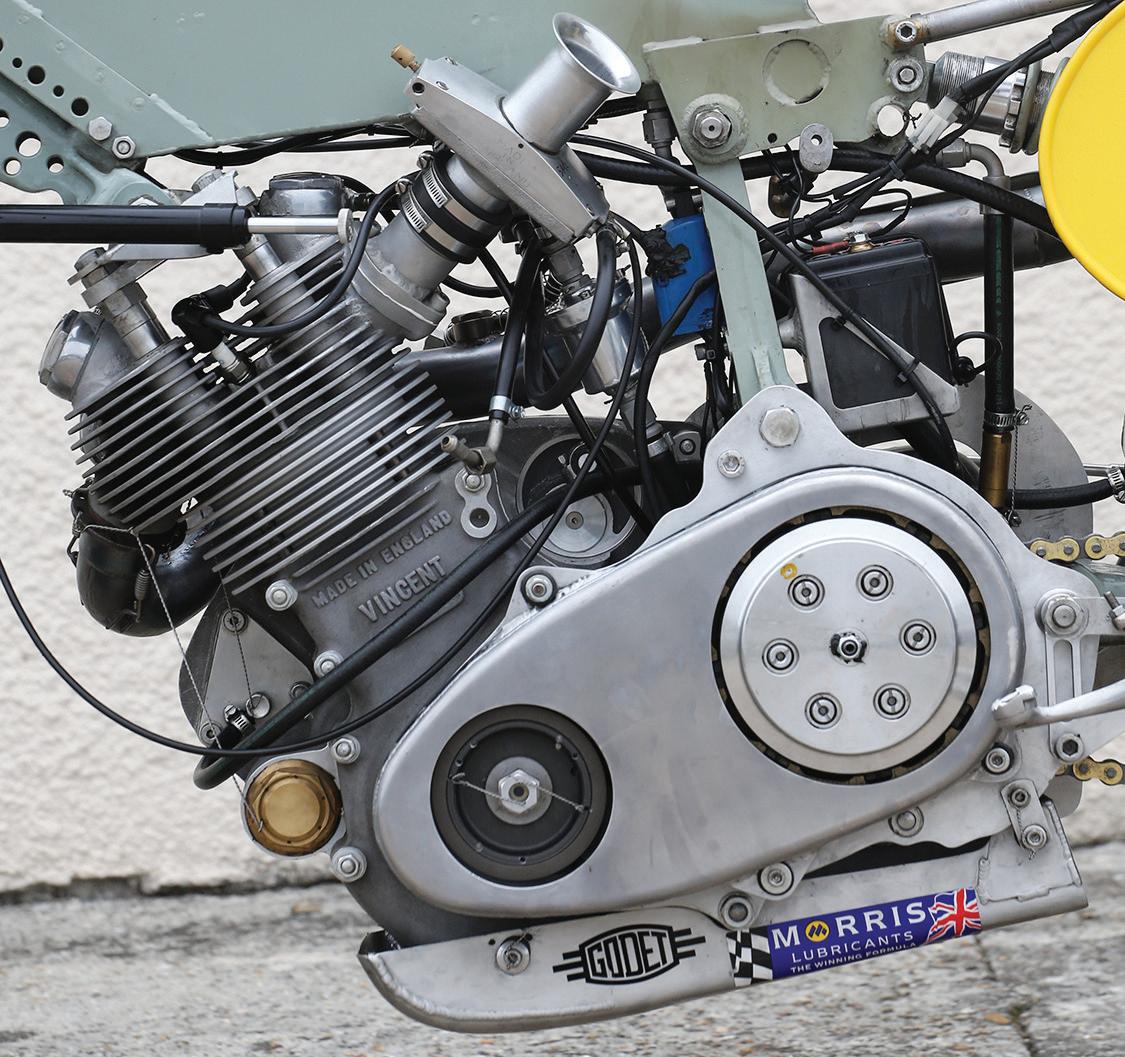
rev that high or go that quick without the improved lubrication.” Compression ratio was now 11.8:1.
The titanium connecting rod mounted on the plain bearing one-piece crankshaft carried a 2-ring forged Omega piston running within the aluminum cylinder coated with Apticote 2000, a low friction nickel ceramic solution derived from the aerospace sector that’s made in England by Poeton Industries, and is claimed to provide superior adhesion to Nikasil. The ported but not yet gas-flowed cylinder head had been extensively modified
The same engine is featured in both bikes, and it makes an incredible 58 horsepower at 7,900rpm at the rear wheel. Alan and the Godet Vincent Grey Flash on track that same day.compared to the original Grey Flash version, with a spherical combustion chamber which now had a squish band, and was fitted with a larger 49.20mm inlet valve, but a smaller 39mm exhaust — both hollow-stemmed stainless steel items, set at an included angle of 35 degrees. “The Vincent exhaust valve is a bit big for ideal extraction of the gas,” said Patrick. “This new smaller size gives us much better flow, and makes space for a bigger inlet valve.” Mark 2 Lightning racing cams were fitted, with a 40mm Gardner carb matched by a Ron Herring-designed straight pipe exhaust carrying a pretty hefty silencer. Ignition came from a Czech-made Ignitec CDI with a 12-volt battery, and a 6-speed gearbox (made in New Zealand by TT Industries) was improbably housed within an identical replica of an original 4-speed Albion casing, with an NEB multi-plate dry clutch and belt primary drive.
The engine was attached as a fully stressed member to an original Comet fabricated steel monocoque backbone chassis incorporating the oil tank. The Girdraulic fork set at a 28-degree rake was also an original Comet part, said Patrick, with fully-adjustable Thornton shocks both front and rear, with a cantilever swingarm. The 56-inch (1,422mm) wheelbase saw a 49.5/50.5-percent distribution of the 270.6-pound (123kg) dry weight. To anchor this up there was an 8.3-inch (210mm) Seeley twin-leadingshoe drum front brake with floating shoes, and an original Vincent 7-inch SLS rear drum. The 19-inch front and 18-inch rear wheels were shod with Avon rubber.
Carole has eight corners in its short 1.3-mile distance, and that made it home turf for the Grey Flash thanks to an unlikely turn of speed out of its slower bends. It positively thundered out of them in second gear with a barely subdued crack from the twoinch straight pipe, whose dimensions
were critical, according to Patrick, in wresting performance from the Vincent single: “Megaphones don’t work with the Mark 2 cams,” he said, “and a short straight pipe like this one gives a lot more power, even at higher revs, than a longer one.” He didn’t mention the main advantage though, which is the engine’s tractability: even with the racing cams, I could allow the revs on the Kröber revcounter perched in front of the upper link of the Girdraulic front end to fall as low as 2,500rpm, and then crack the throttle wide open. The engine responded unhesitatingly, without any need for even a bit of clutch work to get it back in the power band — try doing that with a megga-equipped cammy racer like a G50 or Manx, and see how soon you run into the brick wall of megaphonitis!
The responsiveness and flexibility of the pushrod engine negated its lack of top end power on many of the British short circuits in the early 1950s, enabling George Brown and of course the late John Surtees to score many victories on Vincent singles. John’s first-ever road race victory came on the experimental factory Grey Flash prototype with an alloy big end that his father bought as a wreck from the factory in 1951, and it was achieved at Aberdare Park, a track so twisty and short it must have been tailor-made for the straight-pipe Flash. Back in 1983 John lent me the bike which he had since reacquired and uprated for a French Vintage race at Montlhéry after my Matchless G50 had expired
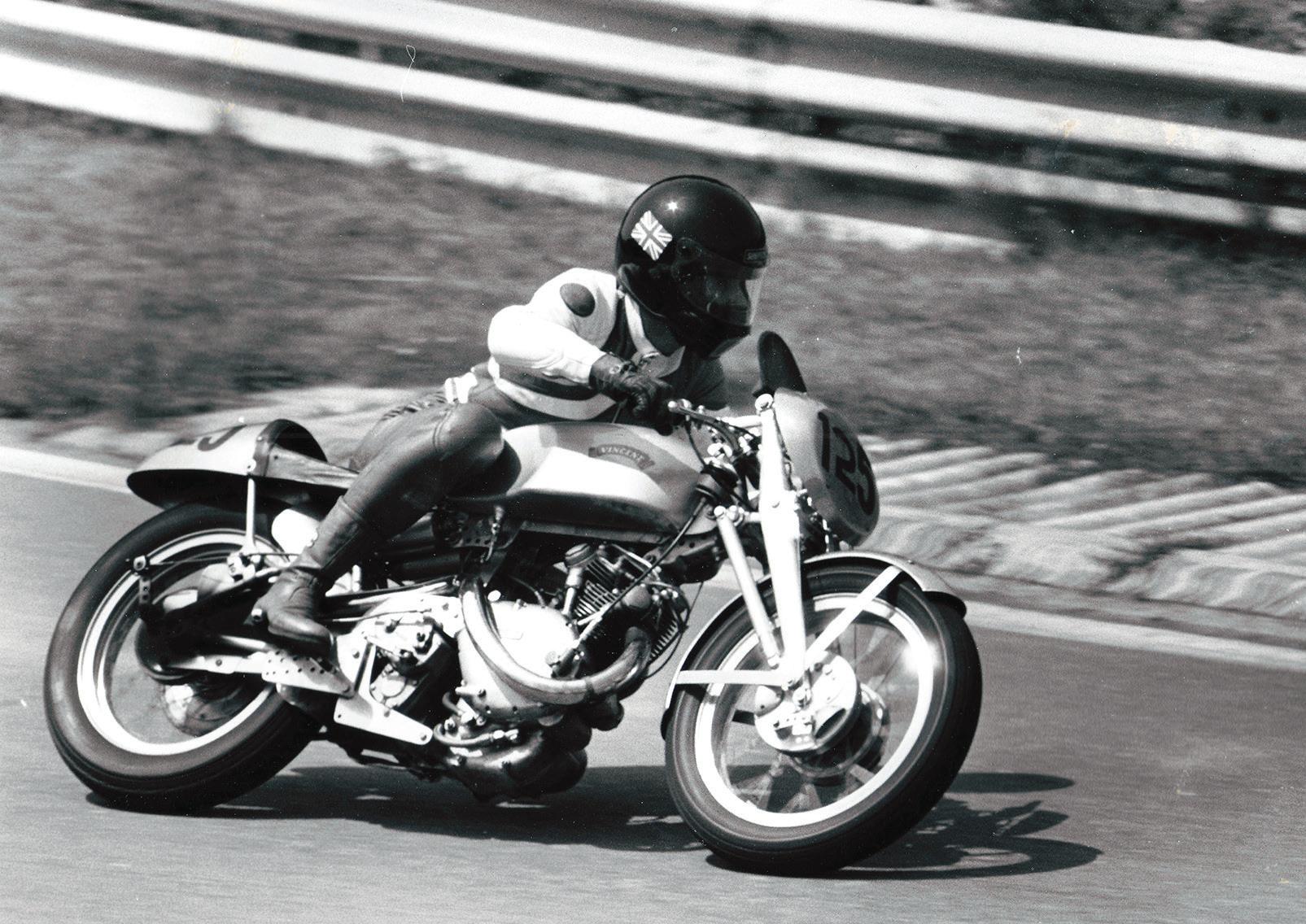
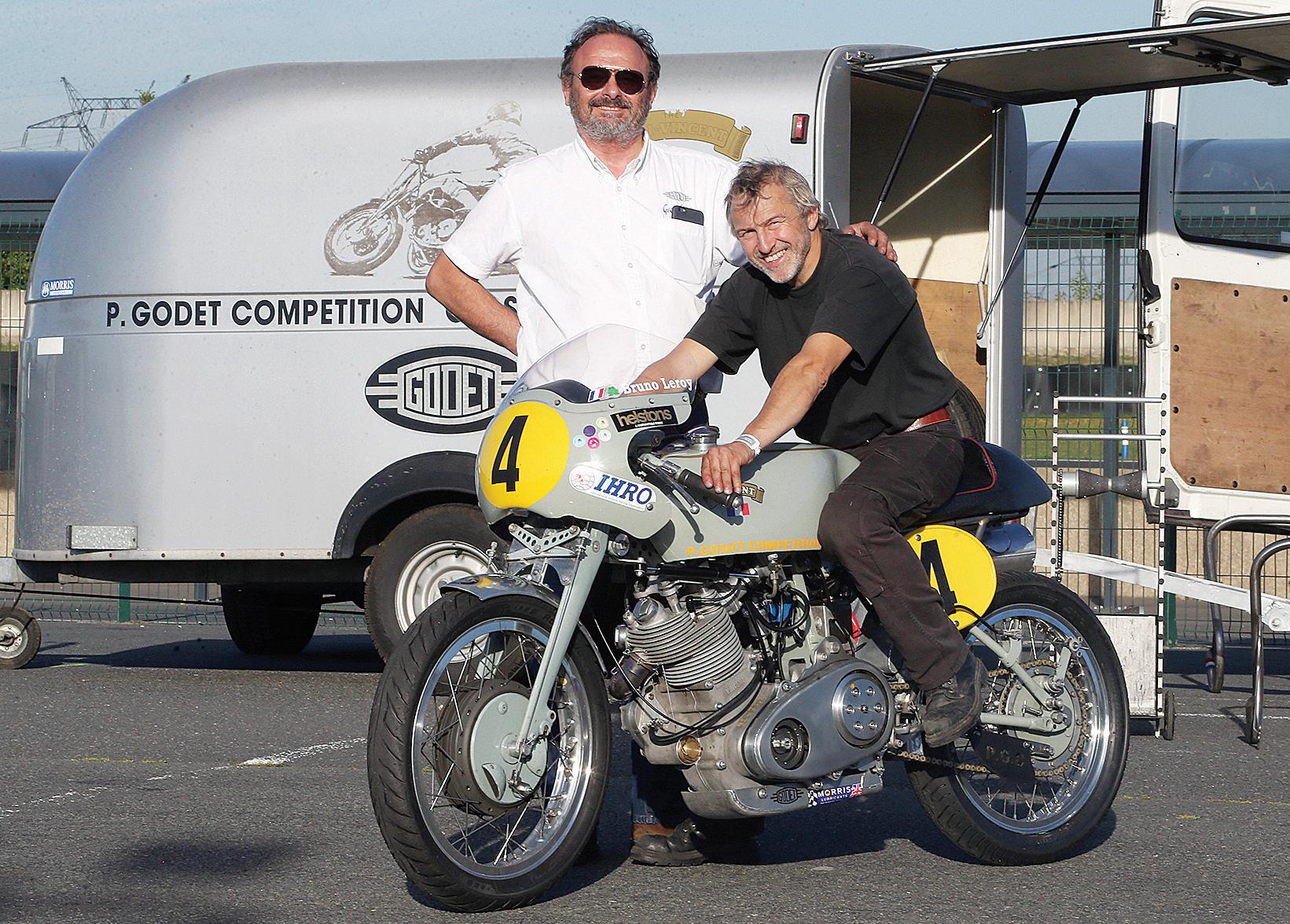
in practice [see photo opposite page]. This generous deed enabled me to sample the ultimate original Grey Flash racer, complete with later 5-speed gearbox, yet I must say that it was just as tractable through the trio of chicanes which littered the banking of the historic old track as Godet’s Replica later proved at Carole. There, I found the power on the Godet engine came in stronger above 4,000rpm, up to the 7,500 revs appointed for my test — though I’ll admit to revving it a couple of times to 8,000rpm, and it still kept pulling even stronger. This made it best to use the rather stiff-action right-foot one-up gearshift to keep the engine pulling above that four grand mark, and though I couldn’t use sixth gear at Carole on the long TT gearing the bike still sported, I found that second, third and fourth gear were really close together, which kept the engine pulling strongly as I shifted up. And I didn’t ever need to use bottom gear, even at Carole’s walking-pace hairpin at the end of the main straight.
The Godet Grey Flash felt really taut and together — Bruno Leroy is shorter than me, but not to the point I felt cramped on the bike, which felt really chuckable on the short French circuit. It steered very well from side to side despite the quite rangy 28-degree rake for the Girdraulic fork. This worked quite well in eating up bumps, just as I remember the Surtees bike did on the corrugated surface of the Montlhéry bankings, though it occasionally chattered over the rough surface exiting the hairpin, and the rear shock bottomed out a few times, presumably thanks to my extra weight compared to Bruno. Easily fixed with more preload, I’m sure.
Less easily fixable would be the disappointing performance of the replica Seeley front brake — and I remember that on Patrick Godet’s first attempt at a Grey Flash replica which I rode back in 1987 at Brands Hatch, I also had problems with brake fade on the replica Grey Flash brakes. Here, the TLS Seeley drum had precious little bite to start with, so I discovered you must plan any outbraking movements very strategically on the Carole track day I was riding at. Using the rear brake hard didn’t help a whole lot — I reckon you could get a fair bit closer to your 100mph TT lap if you could get it to stop better, Bruno!
Switching to the Egli Vincent for a couple of dozen laps revealed a bike that instantly felt more modern — and whose 9-inch (230mm) Fontana replica 4LS front brake was much more effective than the Grey Flash’s, stopping the bike from hard on to
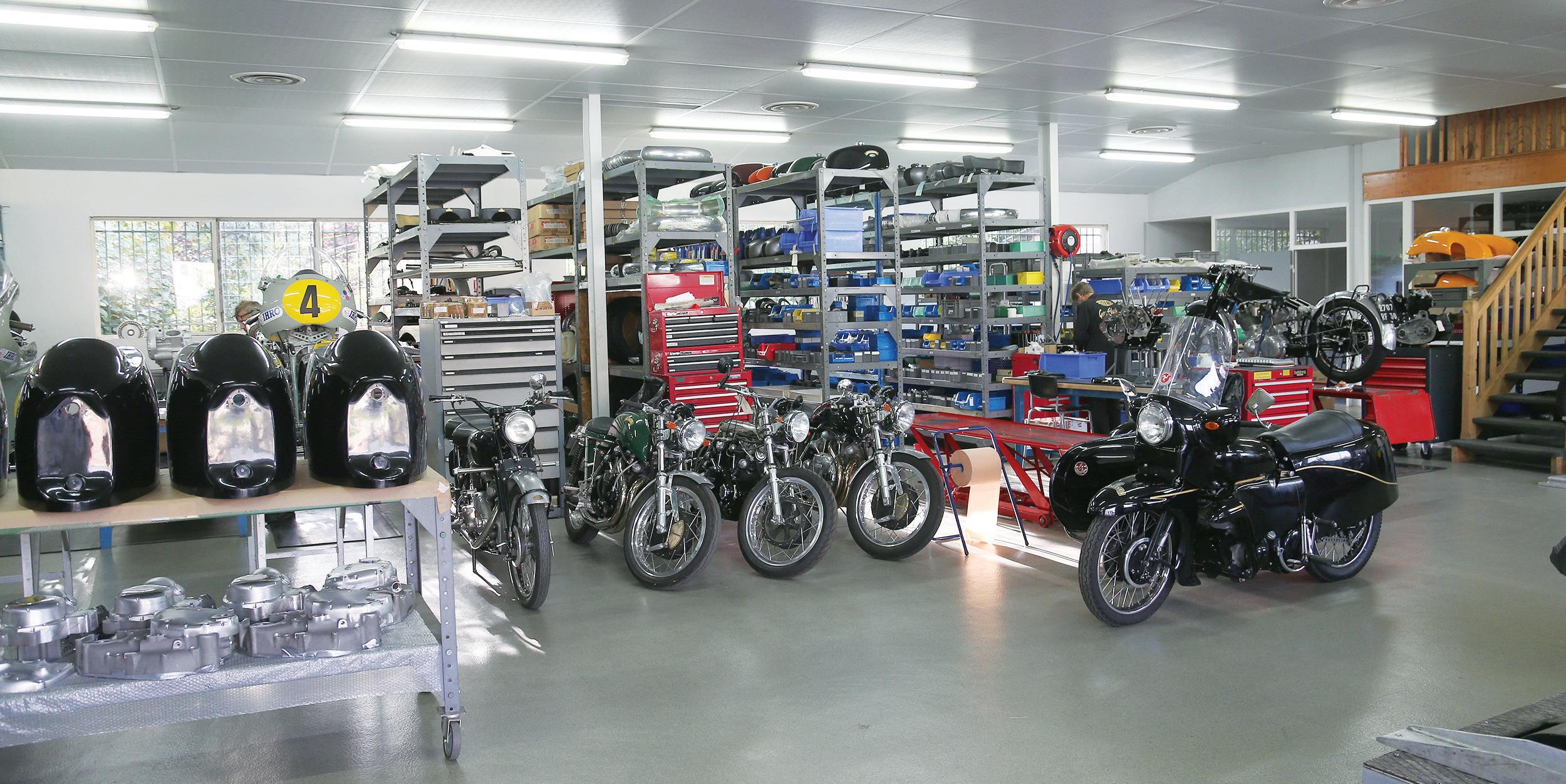
a slow turn very well three times per lap at Carole. At the cost of slightly heavier steering the suspension was beyond reproach, and the identical TT Industries 6-speed gearbox’s change action was much lighter and more precise, too. What a nice bike — though with an identical engine and one kilo of reduced weight, performance was almost the same on a tight track like Carole — but on the TT with the bodywork to try to tuck yourself behind for minutes on end, it’d be a different matter.
One thing I had to compliment Patrick Godet on was the completely predictable steering of the Grey Flash. On other Vincent racers I‘ve tested — including his 1000 Spéciale V-twin when he let me race it in a couple of events at CRMC Snetterton in 1986 — the steering would completely unpredictably suddenly produce a fearful shimmy for no apparent reason in a straight line, seemingly when hitting a longitudinal ridge in the road surface. The Godet Grey Flash steered in a light and positive manner, and never threatened to frighten the rider — but it wasn’t always like that, according to Patrick.
“Bruno started racing the bike in 2015, and he was extremely fast at Spa, even as fast as the Paton — but he also had two very fierce wobbles. So I decided we cannot go to the Isle of Man with the Girdaulic design as it is — we have to fix it. But I was extremely lucky — a guy named David Dunfey in the U.S. sent me a drawing about how to change the geometry to prevent that happening. He’d been involved with Vincents for decades, and he has a Grey Flash which he’s been racing a lot there. He told me to modify the front suspension by repositioning the lower link — and it fixed it! Never another wobble for Bruno — and the same for you here today!” Too right.
This mod brought Patrick a lot of satisfaction. “The Egli is the machine I must race to get nearer to the rostrum,” he said. “The Vincent Grey Flash is the machine I love — it’s my life, and I have created it and raced it because I love it. But it is a different machine from the rest. If you want to reach the Classic TT rostrum, the Grey Flash which has no fairing will never be as quick as the Egli. Even if we make it extremely light, there is no point in enclosing the Vincent chassis. So to get the result we did in the Isle of Man, beating the same rider’s race speeds and lap times with the Vincent over the Egli — that gave me a lot of satisfaction! So now we can afford to dream about that rostrum!”
Sadly, it was not to be. Godspeed, Patrick. MC

Editor’s note: This gem of a story was originally published in the August 1985 issue of Cycle magazine. Please enjoy the tale, along with an exclusive new postscript starting on page 44.
Story and photos by John L. Stein
TThe yard sale: There it sat, as appropriately as a discarded Sunday edition of the Los Angeles Times might lie crumpled in a dumpster, awaiting a Monday morning trash pickup.
Desirable when new and useful, the 1965 Yamaha Big Bear Scrambler now seemed lost in a rolling wave of litter that washed over the lawn. The 250 Big Bear belonged to an industrious young man intent on pursuing his fortune, such as it might be found, in
the operations of a Samoan fish-processing plant. Not running, lame with worn-out tires, a weak generator and a faulty crankshaft bearing, the 20-year-old Yamaha had been scored and ravaged by two decades of salty ocean air. Its Autolube oiling system, meant to civilize 2-strokes of that generation, had long ago been discarded. The Big Bear was junk. It was also $5. Sold.
An inventory of the 60 former and present occupants of the Stein garage for senior citizens of the motor world reads, in part, something like this: Eight Ducatis, three OSSAs, an AJS twin that used National Geographic magazine covers as its cylinder-base gaskets, a 1958 NSU Super Max and a score of hyper-kinetic 2-stroke street and off-highway Japanese bikes. The automobile roster has included about a dozen ’50s and ’60s American and English convertibles, an elderly Cadillac hearse, a New York City
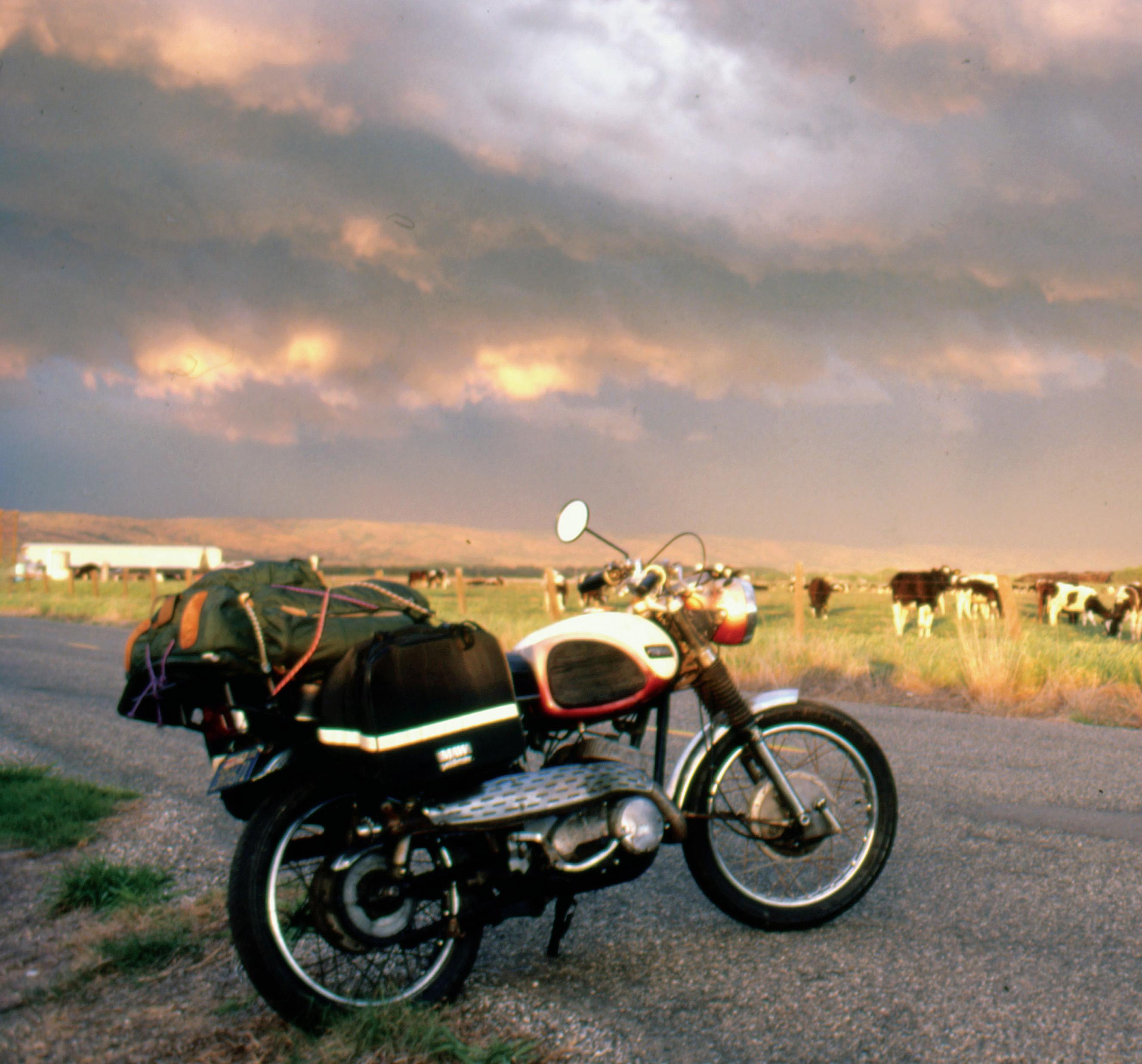
Checker cab, a Kaiser Special and, most recently, a rumpled Lotus. Close to two-thirds of these vehicles did not run at the time of purchase, and the vast majority were more appropriate for a dismantler than for the highway.
It would be very nice, very avant-garde , to suggest my collection currently glistens with Porsche Carreras and newly restored Vincents, but that’s not the case. For the most part I own worn-out things. Some have cultural value, yet those that do not I like just the same. To me these well-worn vehicles show more personality than shiny stuff fresh off the showroom floor, and while New Things are certain to become worn, dirty and dented, Old Things can only improve with time and care. Well, okay, at least they can’t disintegrate much more.
As you can see, the Yamaha fit perfectly into my garage. But I had grander plans for this $5 throwaway. What better vehicle to use to make a point about waste, about revival and utility, about
Besides mechanical problems, the trip was beset by rain and cold. Here, sunshine and scenery invited contemplation.
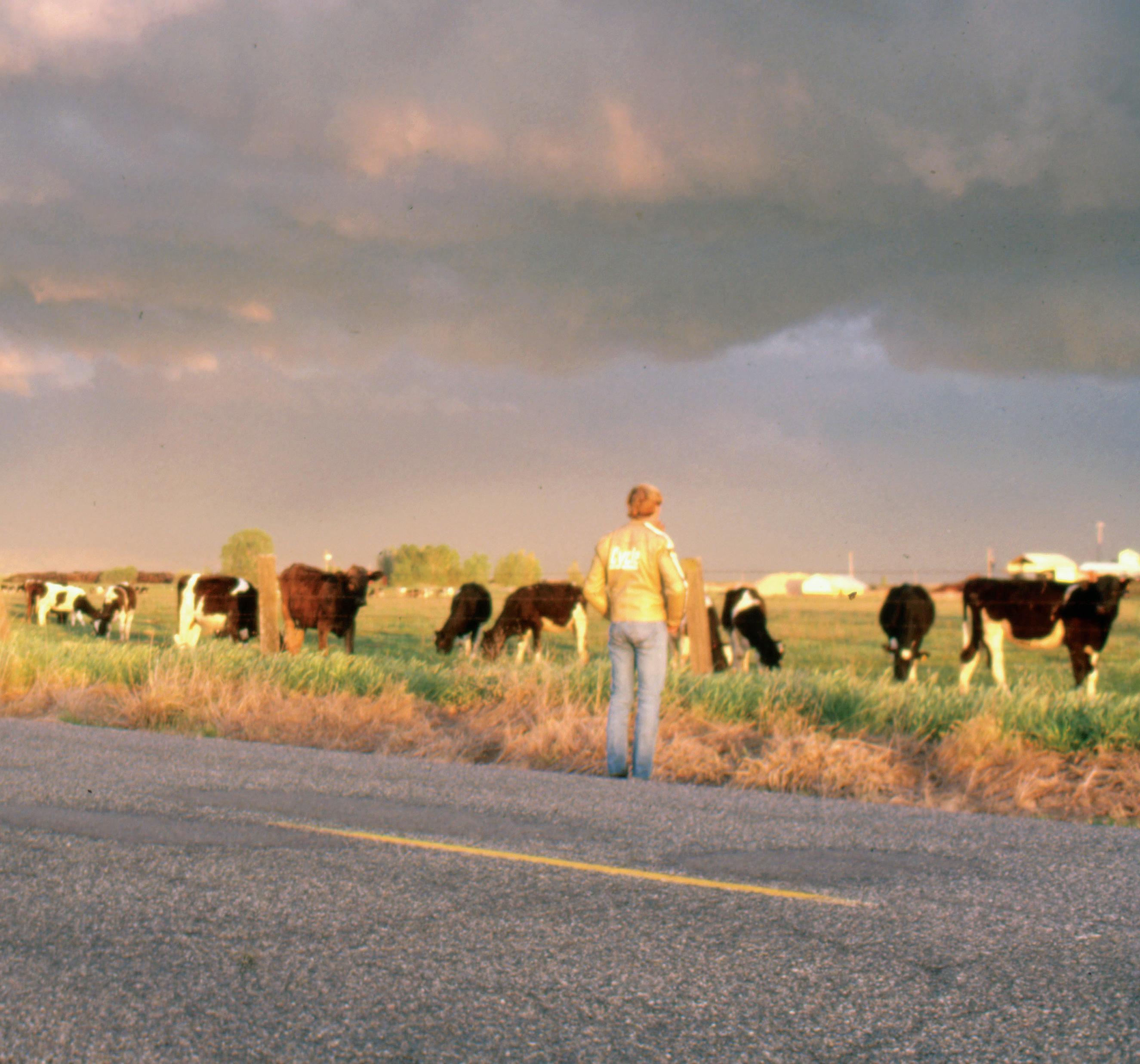
attitude and travel? Why not do something outrageous with this poor, beat-up old Yamaha — get it running, load it up with a satchel of tools and clothes and take off? Why not head toward Canada and see just how far I could go on a ride that costs as much as a hamburger and fries?

Maybe the Big Bear would keep running to the border; probably not. No matter. To prove its worth and the worth of the idea behind it, the Yamaha needed only to run a short distance. For anyone who measures his fun in accountant’s terms, 100 miles would be plenty far. Five cents a mile is as good as bus fare, and the Yamaha would certainly be a better ride than a Greyhound coach. Yet, what if … what if the Yamaha should run all the way to the Canadian border or beyond? Then it would be a dazzling affirmation of the beauty and value of junk.
But first the Yamaha would have to run.
With a bit of tinkering (a borrowed battery, beating the
What if this five-dollar Scrambler runs all the way to the Canadian border? Then it will be a dazzling affirmation of the beauty and value of junk.
pistons loose with a plastic mallet) the Yamaha was resuscitated. Only one thing remained in the way: The faulty main bearing rattled so loudly I couldn’t keep myself from reflexively switching off the ignition each time the engine rumbled to life. Finally, a pair of ear plugs offered a cheap and painless solution.
Other details required attention, and I vowed to deal with them without spending any money. The Yamaha’s throttle cable was broken, so I shortened the cable housing and resoldered the steel cable end. The kickstarter lever spun freely — but uselessly — on its once-splined shaft. Solution? Direct and strong, albeit a bit crude — I drilled the kickstarter arm and its shaft and throughbolted the two together.
For Operation Big Bear North I allowed one week; with delays for general slowness and breakdown, I figured an average of just over 200 miles per day. Should the YDS-3C break in a really big way, tough. If I couldn’t repair it in a day, under the shade of a nearby tree, I would remove the pack and license plate and walk away.
As much as I’ve prepared for this trip, the Big Bear is still unfamiliar; in truth, I’ve ridden the $5 Tourer no more than around the block since I trucked it home from the sale. Crawling tentatively north, the Yamaha first conquers the steep hills outside of Santa Barbara. Peak engine speed is 6,000rpm at best; the aged clutch will hold no more power.
A hundred and fifty miles out, a nice little downhill present itself. Here clutch slip is not a problem, and the Yamaha seems to run so well I loosen the reins. Its revs soon soar to 7,000rpm, and instantly I hear a sickening change in engine pitch that can only signal a piston seizing in its cylinder. This is it, I think — 150 miles on five bucks.
Satisfied with the Big Bear’s effort, I pull in the clutch, turn off the ignition and coast to a stop. After a minute I roll the bike back and forth to hear an ominous clunking. It’s only slightly worse than normal, so I give the Scrambler another try. The Yamaha starts right up and runs fine.
Somewhere farther north, the Yamaha’s battery goes flat. I discover that the generator’s armature windings have completely disintegrated, and, desperate, I gut the wiring and run on a total-loss system. Then, at 280 miles, the whole electrical system shuts down as I roll into Fremont, California, just southeast of San Francisco. Somehow, the YDS limps to a local Yamaha dealership on one cylinder. The end is certainly near now. Yes, the generator armature is history, and the Yamaha store has no parts. No juice, no hope. But for $5, the Yamaha has served well. It’s been interesting, and so long, Big Bear.
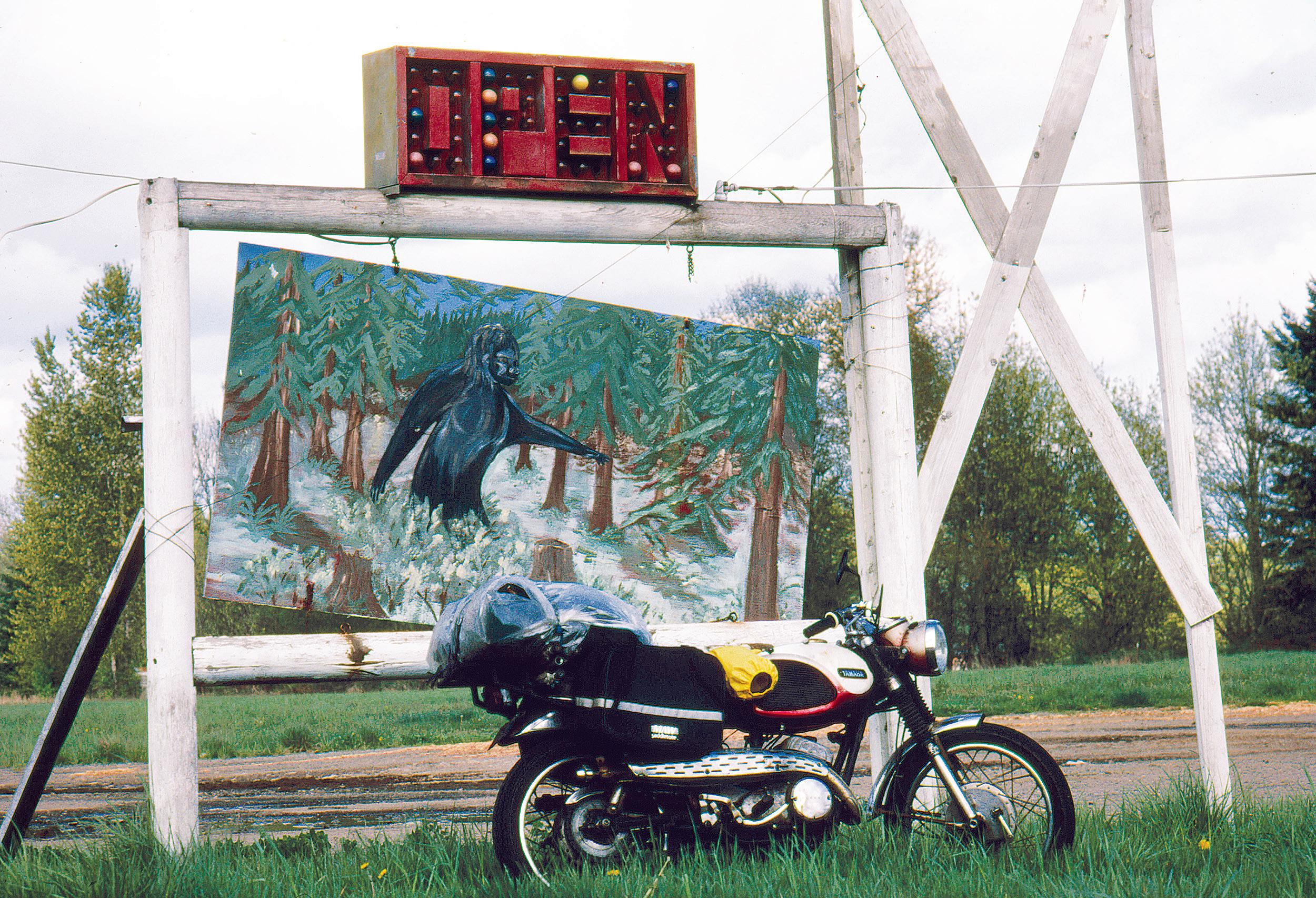
Not so fast.
Just as I open my mouth to ask the location of the nearest bus station, the Yamaha dealer opens his. He directs me to a motorcycle salvage shop two blocks away. It’s a long shot, I know, but I halfheartedly check this place anyway. Incredibly, they have not one, but four Yamaha YDS generator armatures (probably the only four in California). With one of these installed and a quick regulator adjustment, the Yamaha charges its battery perfectly. I find an old, used Michelin PZ2 tire and fit it to the back of the Scrambler as well. Every bit helps; the original Dunlop K70 had no pattern left whatsoever.
Nearly 400 miles out and the ride has become, well, uncomfortable — the seating accommodations stink. I now understand why Yamaha tacticians designated this thing a Scrambler; they named it for what it does to your body and internal organs. To improve matters, the Scrambler could use a 6-speed
Though desolate, Pacific Northwest forests offered at least an illusion of comfort and safety. And perhaps a Bigfoot sighting (opposite)!
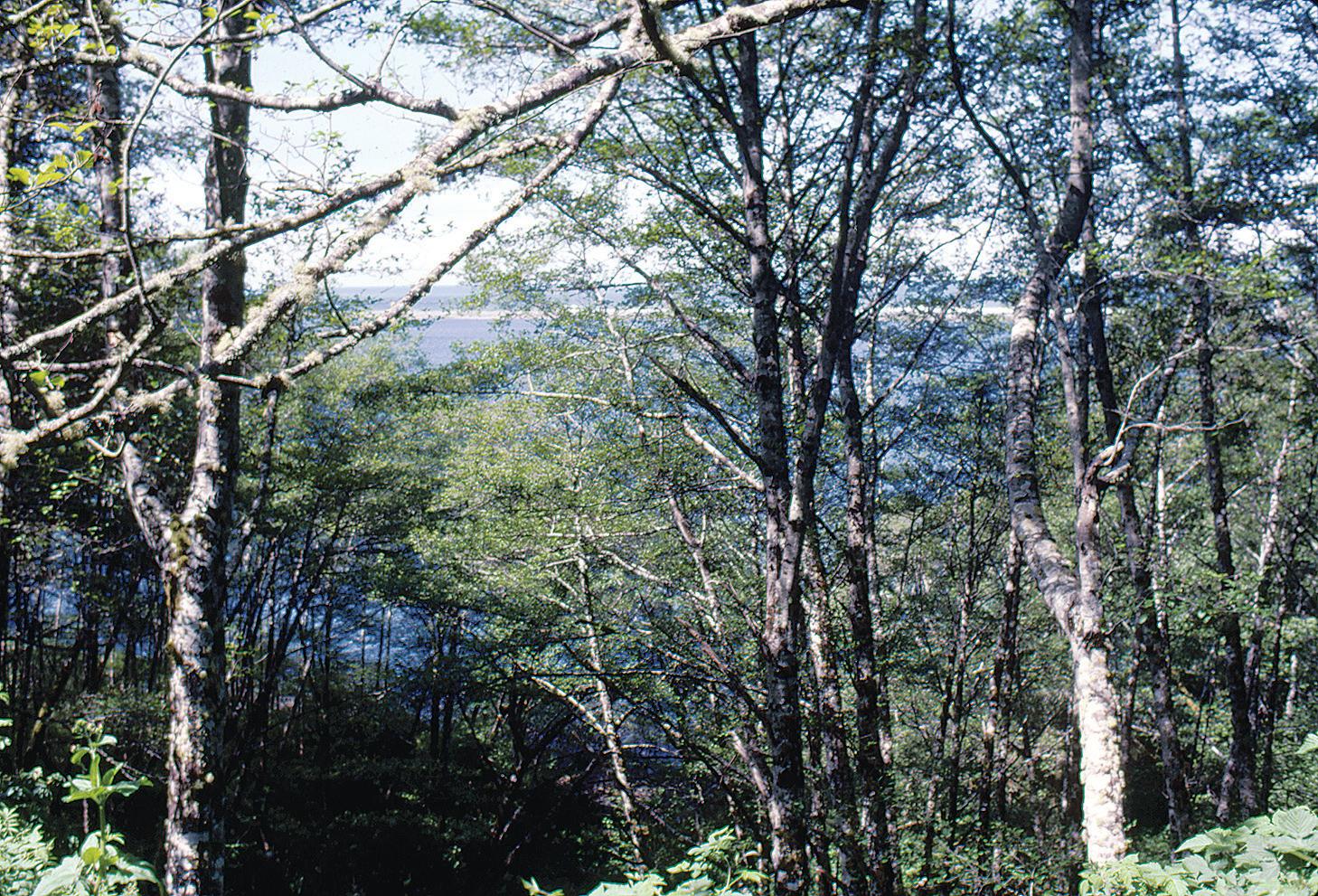
gearbox. It could stand to be quieter. It could vibrate less, and to this end a new crankshaft might help. Nonetheless, it refuses to quit. I envision the Scrambler as a bloody and beaten prizefighter crawling by instinct into the ring for each new round, each time to be knocked flat and then saved by the bell.
On down the road the Yamaha seizes for the second time. It’s a harder seize, so sudden I don’t have time to pull in the clutch lever. The back wheel, skids a little on Interstate 5’s cement slab. Surely, I say to myself, this is the end.
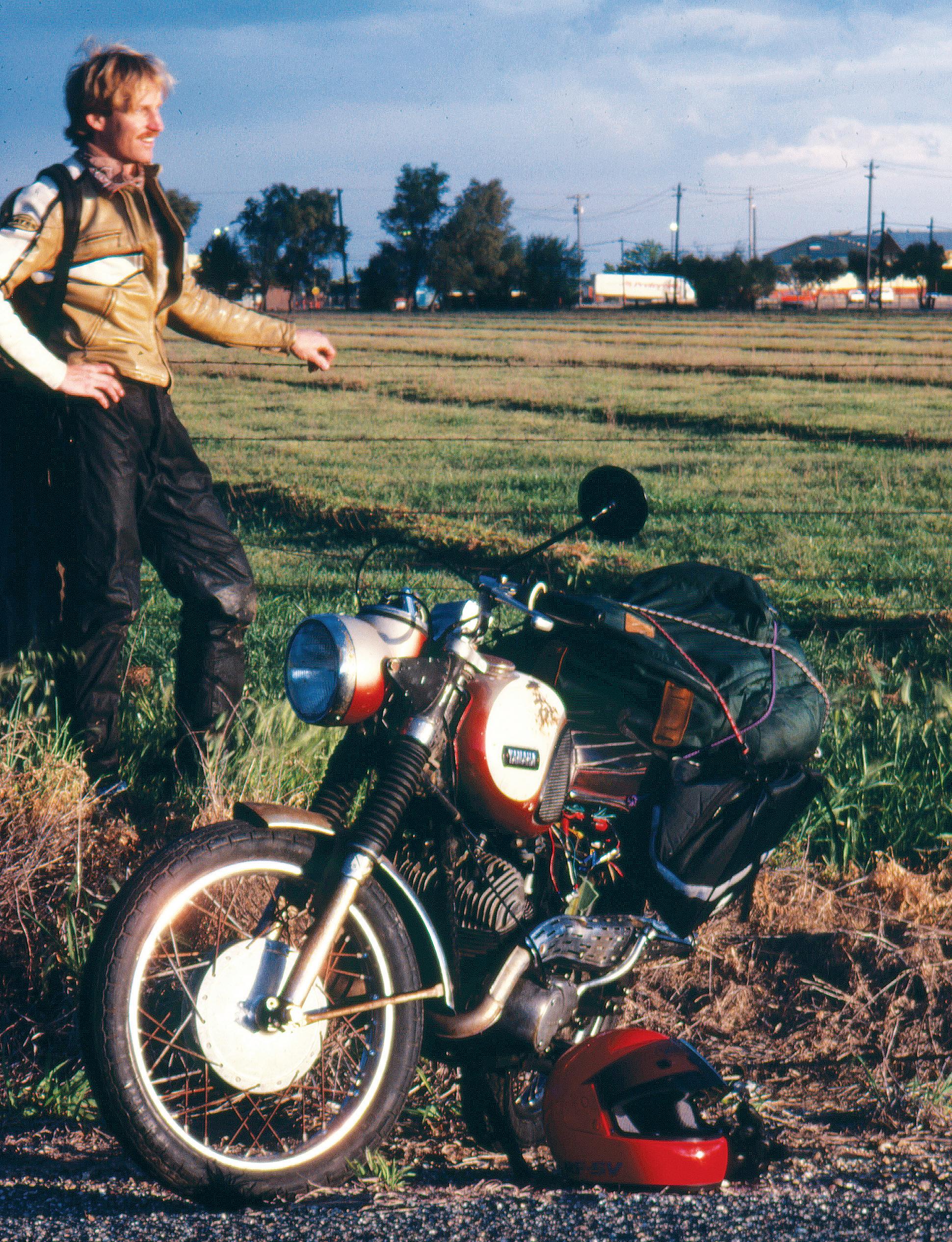
Or is it?
Once more I start the Big Bear, and once more it begins to move north, clattering even more alarmingly. We reach Red Bluff, California, 480 miles out, and the Cinderella Riverview Motel, sitting on the bank of the Sacramento River, offers a respite from the excruciating ride. It offers something else as well, a compelling thought: Why not retire the Scrambler now? As I look out at an eddy swirling close to the shore I am sorely tempted to ease the Scrambler down the bank, ever so gently and inconspicuously into the cool current.
I can’t do it.
A morning adjustment of the YDS3C’s ignition points and spark plug gaps improves performance a lot, but now the clutch slips terribly. I can’t use the good part of the power band starting at about 5,800rpm, the bike will definitely seize beyond 6,000rpm, and below 5,000rpm the engine bogs uselessly. That leaves a working range of about 800rpm. With the clutch repaired I might expect 200rpm more. I can no longer attack major hills or highways.
A full day’s ride through the mountains, fighting snow flurries and nursing the smoking, glazing clutch plates, brings us to a Best Western Lodge, 650 miles out. The Yamaha continues to run. Blindly, faithfully, at 5:30 in the afternoon, I begin dissembling the Yamaha’s clutch case. This clutchrepair operation will do one of two things: it will improve the clutch or totally ruin it. Either way, I win: the Big Bear will grow stronger or die on the operating table. I can pick up the pace or go home.
With a dogbone wrench and oily rag locking the clutch I use my
After 38 years, the “analog-ness” of this $5 Big Bear trip feels hugely compelling. Nothing but an old bike, a rider, some tools and faith. Maybe try it sometime!
sturdy helper, a 12-inch Craftsman adjustable wrench, to remove the Loctite-secured clutch-hub nut. Once free to disassemble the clutch basket, I fool a taut, 6-inch snap ring out of position without the help of Yamaha factory tools. The clutch plates are fried, though the springs appear to have retained their temper. With a piece of emery cloth I remove the slime and rough up the plates, then bolster the springs by adding a 6-millimeter lock washer to the bottom of each spring cup.
Now, in the fading light, I must reconfront the massive snap ring. With the Yamaha carcass as a weight, I leverage the clutch basket closed and replace the ring. The odds against having done this with only the tools at hand seem tremendous, but the Big Bear scores again.
In the amber glow of the motel sign I finish my task. The clutch still slips during hard acceleration, but less so. Finally, the Yamaha holds steady at 6,000rpm, or about 60 miles per hour.
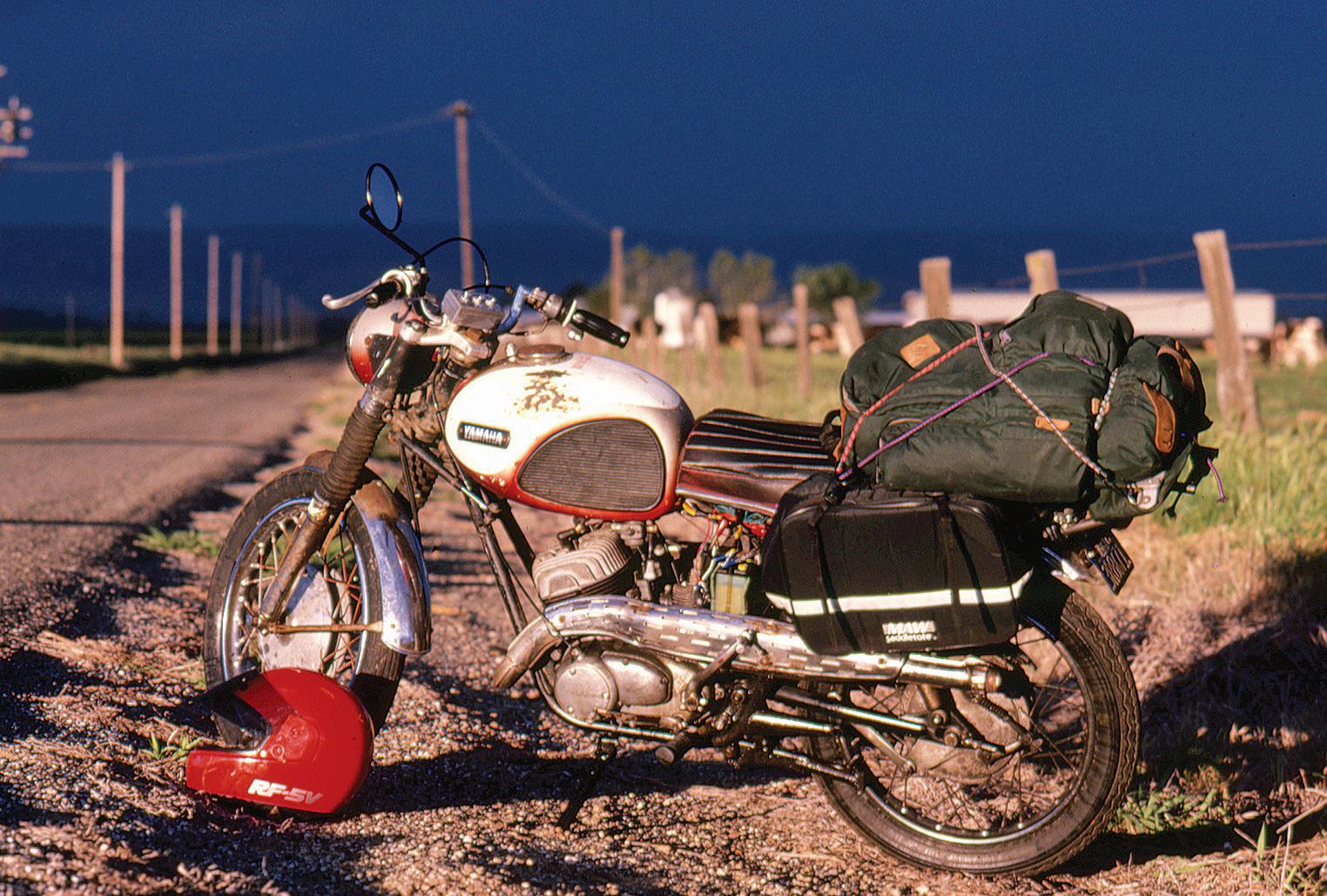
As we reach the California/Oregon border, over 750 miles out, the wretched Yamaha is still running — better than ever. The generator and regulator behave perfectly, and the Yamaha can now actually flow with the traffic. There’s more. The Scrambler seems to have gained strength from my agony. For the first time in the whole trip I am able to pass cars. I do so. The Yamaha motors on. And on. I pass a thrashed Datsun B-210, a diesel Volkswagen Rabbit and a pickup pulling a trailer.
On Oregon’s Highway 199 I’m led away from the coast, north-
east back to Highway 5. It’s the prettiest stretch of the whole trip, and the Yamaha pulls smartly up a long series of deserted wooded canyons.
We sweat it onward. And upward. There is little to report about Highway 5 through Oregon except that it’s beautiful and has a lot of hills — and the Big Bear seizes twice attempting to climb one. I wonder what people must think seeing this derelict Big Bear Scrambler outfitted for touring, glossy with oil from leaking clutch-cover seals, standing, seized, by the side of a major interstate on a dark Oregon afternoon.
Once cooled, the Yamaha is ready for a new round. It starts, rattles, and runs on. Of course.
Six days, 1,200 miles north of Santa Barbara, the Big Bear is still running. This bike defies all fundamental rules of




of a Junkie in 1985, readers wrote the editor to say how the trip inspired them by showing it’s not about having the perfect bike, but rather what you do with what you have. Learning that my pain and suffering had inspired others was unexpected and gratifying. Also after the issue was out, Larry Huffman invited me on his Motorcycle World radio program, where I tried to explain why, exactly, I had made the trip and answered questions from callers. I was nervous being on the air live but enjoyed doing it.
Then thoughts of the Big Bear went dormant. That is, until seven years later, when I heard that the land where the bike was interred would be developed, and that exhuming it might be a good idea. Heck, I figured, with luck I might even be able to service it and ride home. I booked a flight and set out with a friend to find the poor
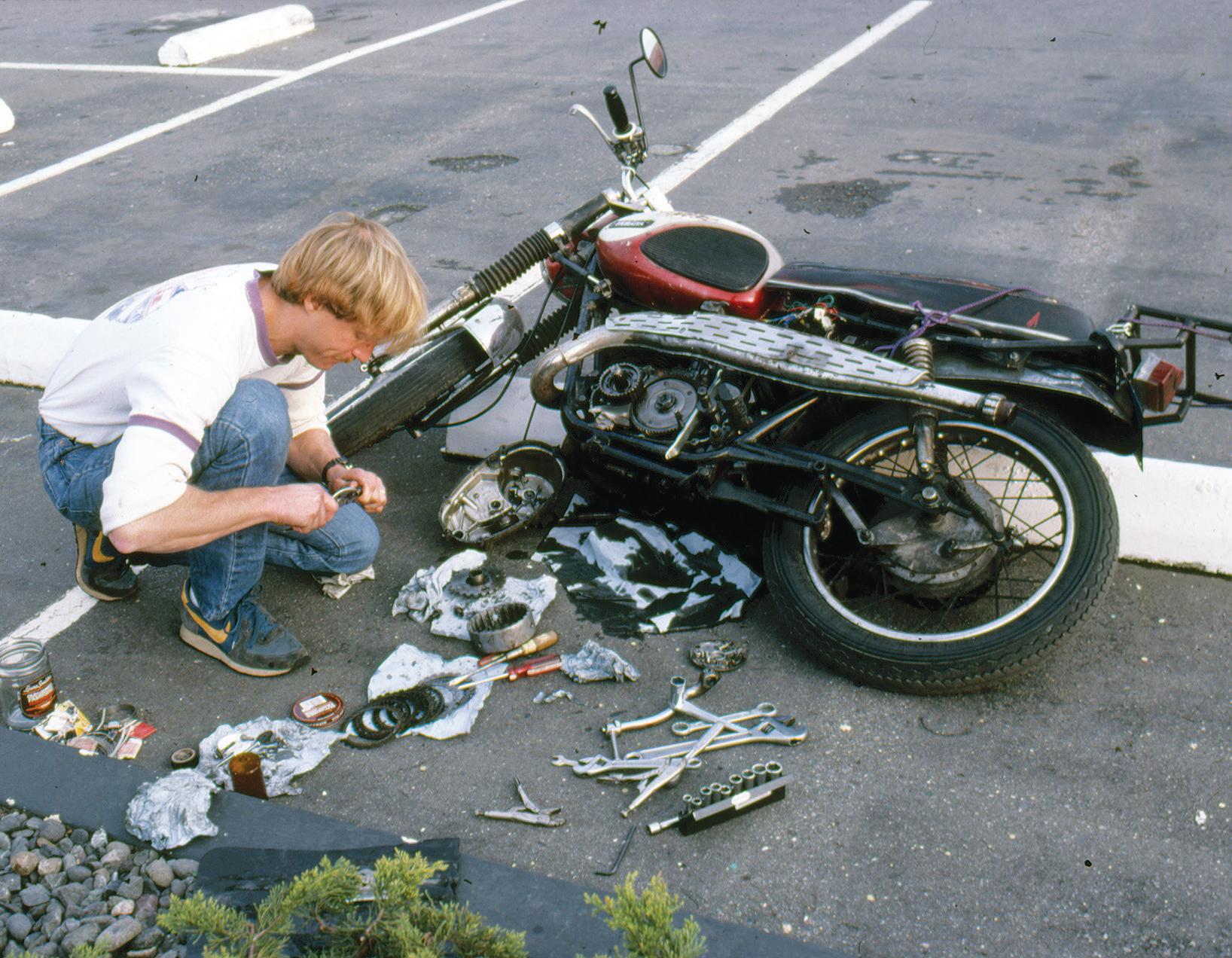 Shockingly, this parking-lot clutch repair let the YDS3-C finally cruise at 60mph.
Shockingly, this parking-lot clutch repair let the YDS3-C finally cruise at 60mph.
mechanics, pressing along the road by what appears to be sheer tenacity. I half-wish, no, I now dream the Big Bear will terminally seize, throwing chunks of crankshaft right through the engine cases in a last heroic charge up a mountain pass. More likely, I fear, it will deliver me in its slow and painful style all the way to the Canadian border.
Olympia, Washington. They brew beer here, and I sure could use some this morning. Yet I’m hopeful. The western window of my Victorian lodging is positively filled with light-blue sky and the sounds of a half-dozen chirping birds. Today, I’m sure, will be the Yamaha’s last. As I prepare to ride, dark gray clouds blow in and a sharp spring rain begins to rake the window.
The road to Port Angeles, the last stop in the United States, is a removed, 2-lane affair, and the machine shuffles along it, all
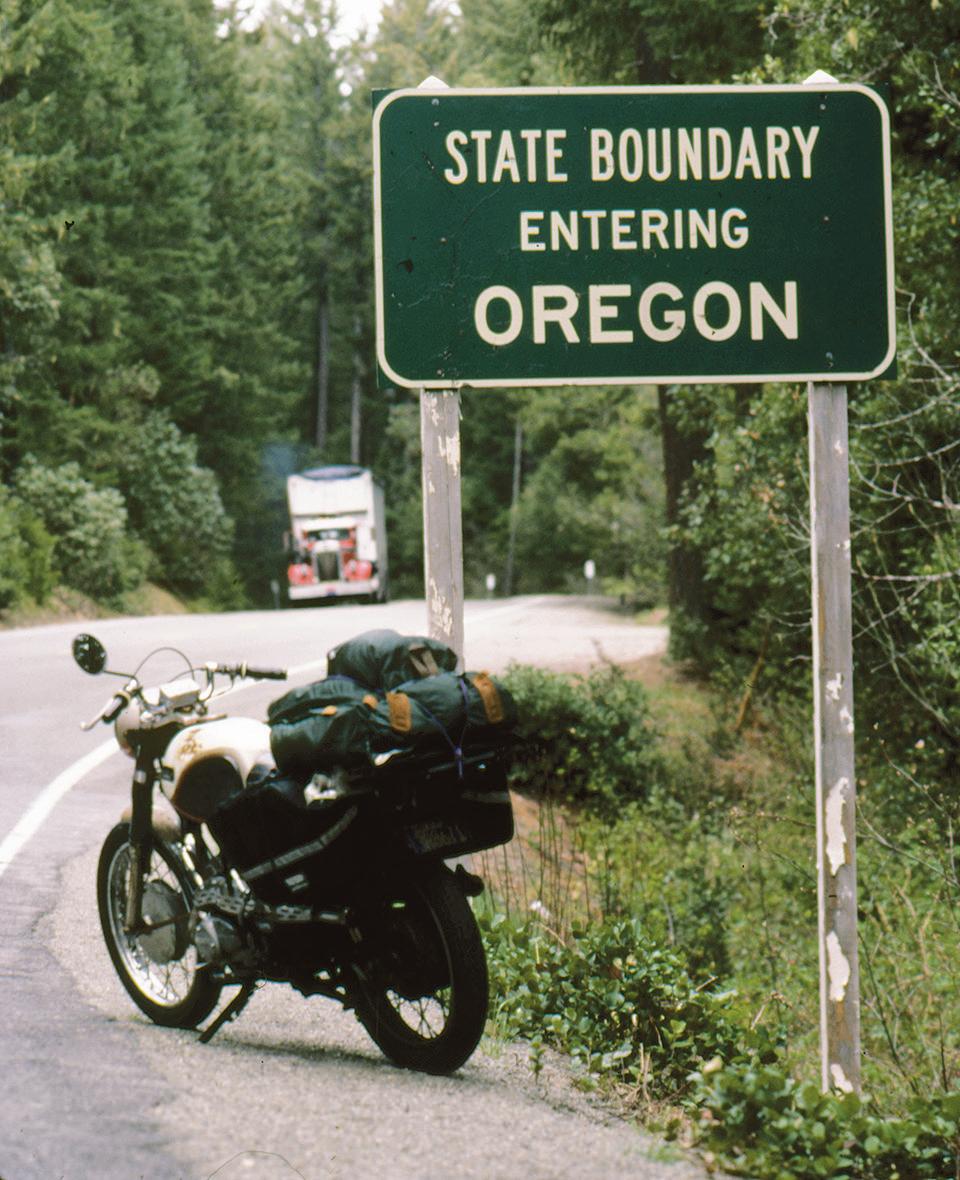
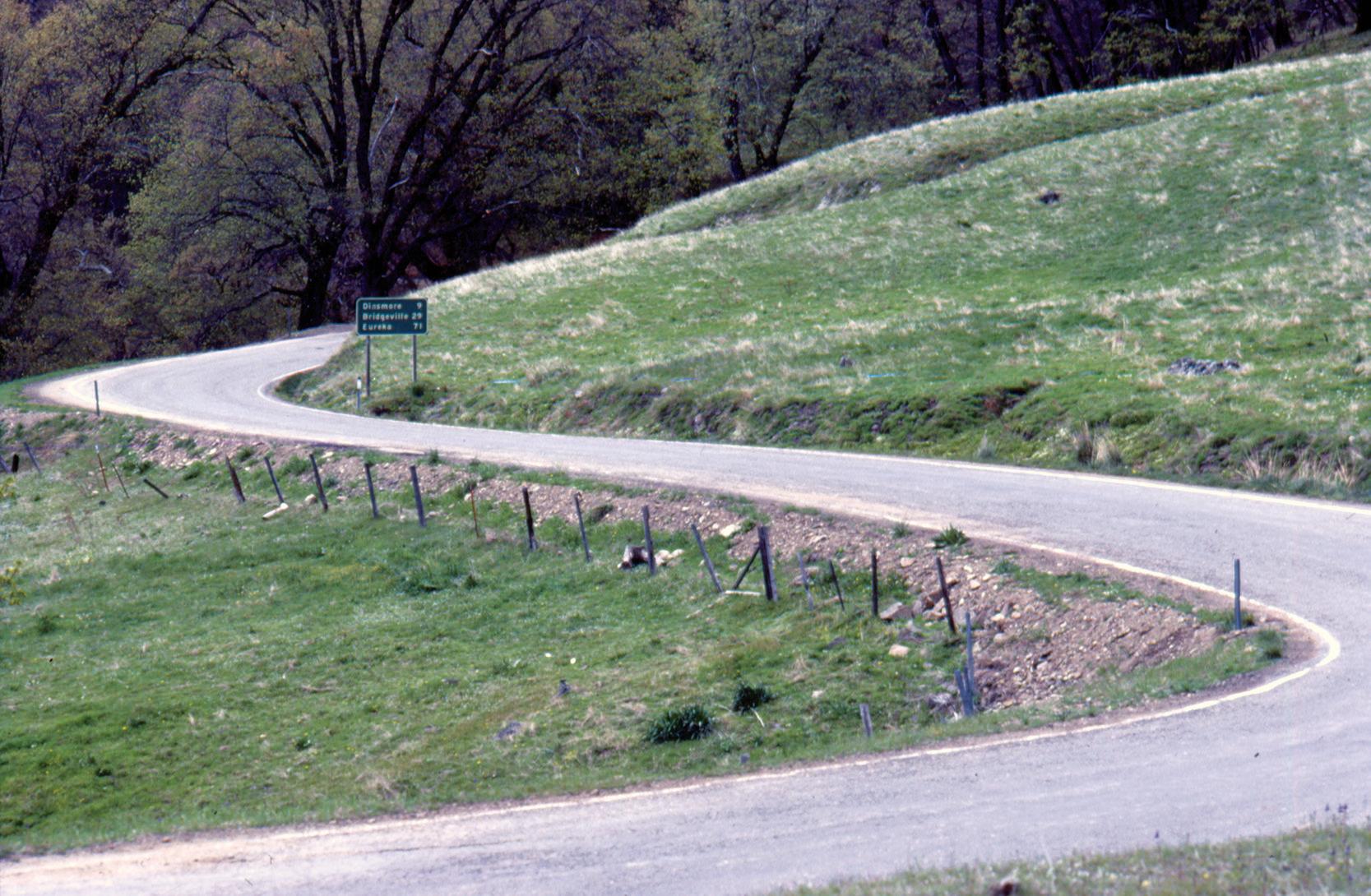
scrambler. This took some sleuthing (a metal detector would have helped), but eventually we succeeded when our shovels hit something hard.
It was terribly exciting to dig the old machine out of the ground, as in some demented version of Treasure Island, all the while hoping it would be in the same condition as before. But predictably, due to damp soil, the heroic Big Bear most certainly was not. Most of its steel and iron — paint and chrome alike — had rusted, and the aluminum was even worse. This was illustrated when I grabbed the left handlebar to pull the bike upright in its grave, as just lightly grasping the alloy clutch-lever perch broke it right off the bar. That sudden “Snap!” reversed my thinking about ever riding the Big Bear again, because it introduced doubt about the integrity of all critical aluminum parts including wheel hubs, brakes and engine cases.
After carting the Big Bear into town, washing it revealed that what had been a decrepit machine on tour, was now functionally worthless. Had a bike sunk aboard the Titanic, it couldn’t be much worse off.
the way to a ferry and across the border, nearly 1,400 miles from home. The Canadian border crossing offers no grand climax and the border guard is unaffected. Just another worn-out traveler.
I admire the Big Bear’s durability, but I can’t stand to ride it another second. So in a wooded section of British Columbia, near the Vancouver city limits, I disconnect the Yamaha’s battery and note the last spark of life arc across the ground cable. I dig a sizable trench, drop the Yamaha key into the gas tank, and roll the Big Bear down inside. I mumble as much of the Naval Officer’s prayer for burial at sea as I can remember from a childhood of John Wayne matinees, cover the Big Bear with earth, stand on the shoulder of the southbound lane and stick out my thumb, with a story to tell whoever gives me a ride home. MC
So, we removed the cylinders and heads to use as bookends, fished the ignition key out of the gas tank, and arranged for the Yamaha to meet its maker — once and for all — at a recycling yard. After returning home, I eventually tired of looking at the cylinders so they got recycled too. All that remains today is the original Yamaha key.
Likely the whole affair sated my appetite for Yamaha twins, because in subsequent decades my attention shifted to other machines. Then the 2010 Catalina Grand Prix was announced, and I got the sudden urge to build a Big Bear-style desert sled to race in the event. Surprise! As a cosmic penance, perhaps, the donor was a rustbucket 1962 YDS2 twin, found at an old motorcycle shop. Three months of focused work — with much outside assistance — turned it into a wonderful racer.
That success, and the almost symphonic, wailing performance of the Catalina GP racer, reopened my eyes to 2-stroke twins. So more followed, including a pair of Ascot Scramblers, a YDS3 Catalina, and two more YDS2s. In truth, these bikes are a bit unusual — even for
classic-bike enthusiasts — but I still like their essential engineering. And being virtually all metal rather than plastic makes working on them satisfying. Metal can usually be saved — unless it’s been underground that is.
Nearly four decades after “Operation Big Bear North,” that week remains one of my cheekier adventures — a sizable rock in life’s collection of experiential rubble. And I’m amazed that it was entirely done in the pre-GPS, pre-Google Maps, pre-cellphone days (with the story written on an IBM PC with 64k RAM, twin floppy drives and a chromatic-green CRT monitor). On the trip, I never worried about what might happen if the bike broke miles from nowhere; I trusted in my skills and tools, and that was enough. Recalling this, I’m chagrined that I now take my smartphone almost everywhere, and so clearly I need to fix that with a new and completely unplugged trip. Say, maybe Big Bear No. 2 is out there somewhere in a garage or barn, just waiting for its yard-sale day.
Yes, of course I’d buy it! What do you think I am, nuts? — JLS




Bringing you the most brilliant, unusual, and popular motorcycles ever made … delivered on a flash drive that contains more than 3,700 articles and plugs into the USB port on your favorite device. Whether you’re interested in a particular manufacturer or repairing a specific part, use our search function to bring up 18 years of Motorcycle Classics’ relevant content! For collectors and enthusiasts, dreamers and restorers, newcomers and lifelong gearheads, we have you well covered. Also included on the USB drive are 119 articles in PDF format, written by longtime Motorcycle Classics contributors Alan Cathcart and Phillip Tooth.
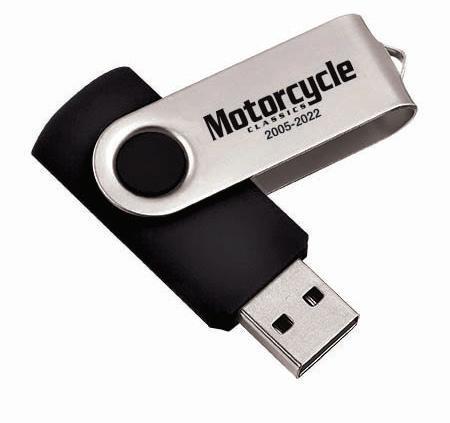




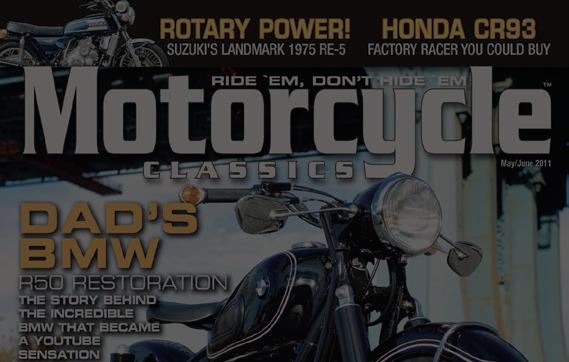




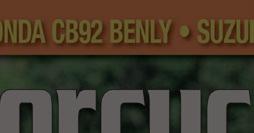
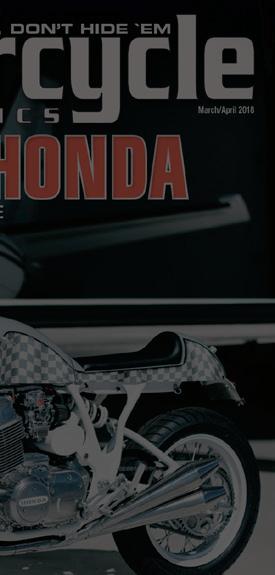


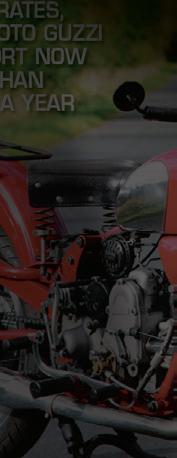
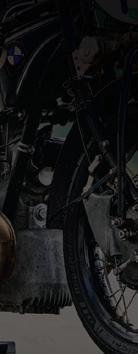
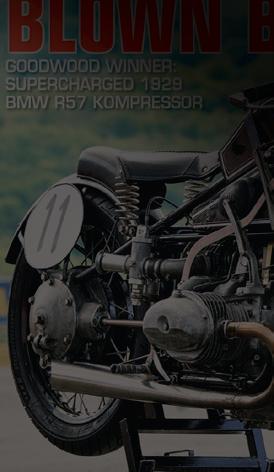
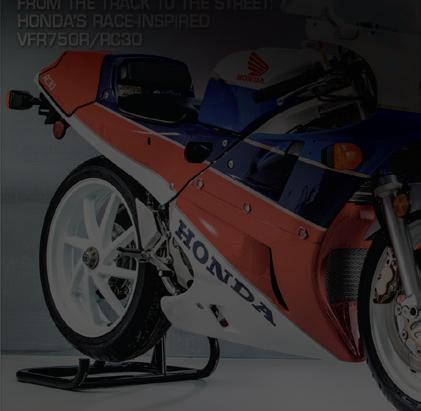
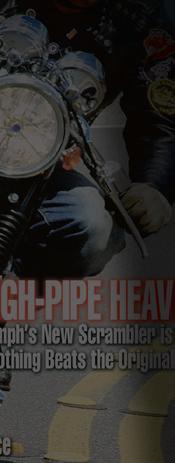
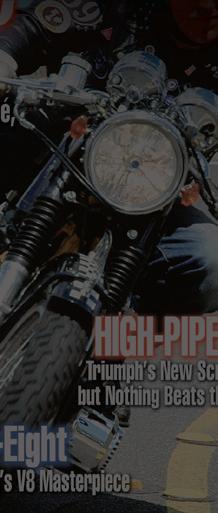
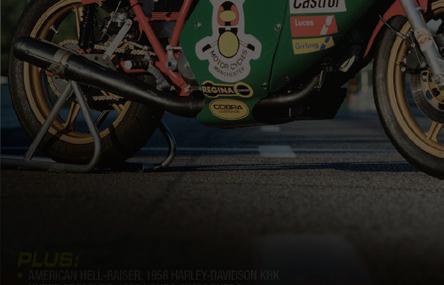


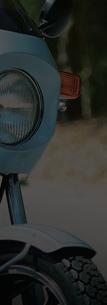
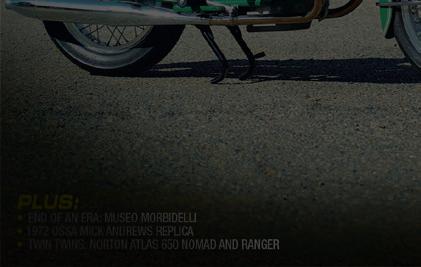

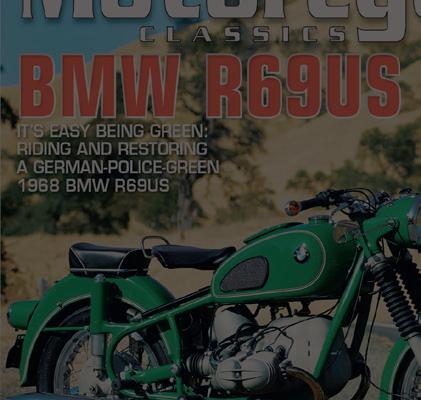
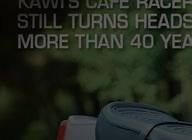

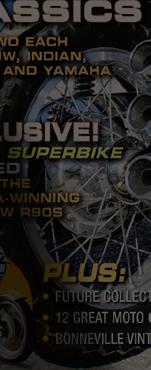
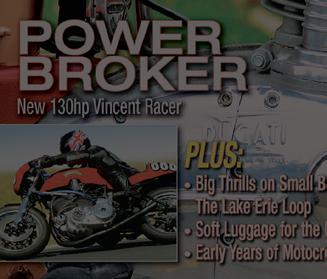
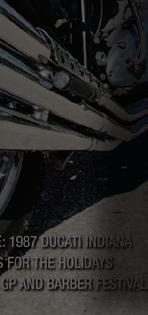
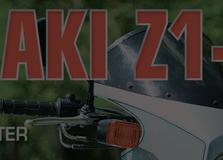

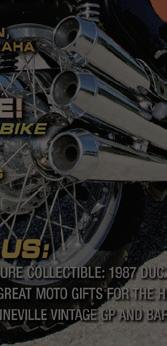
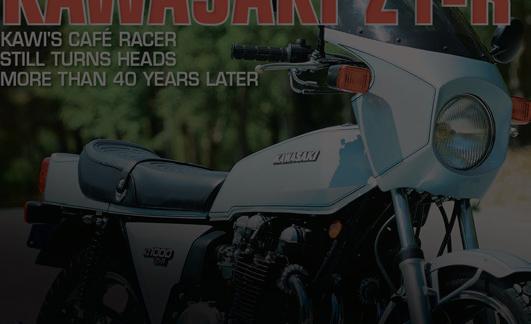

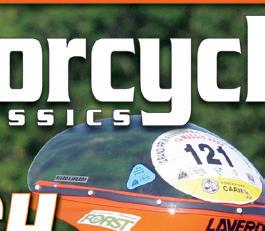

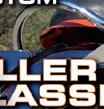

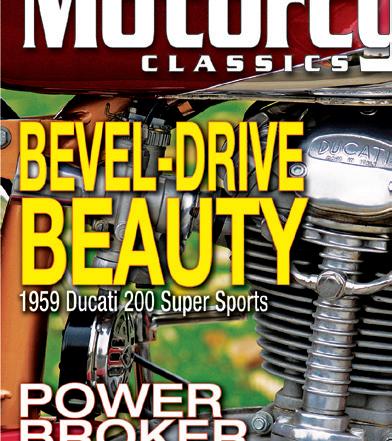
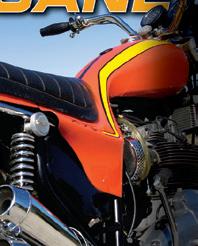
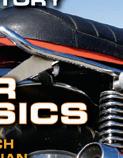
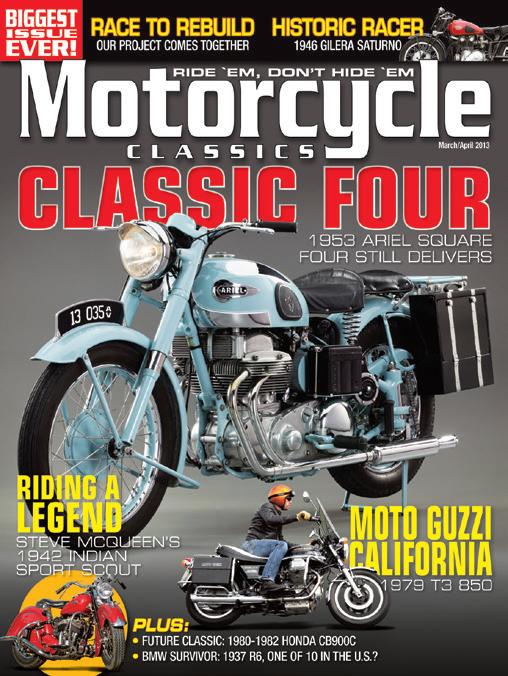
$














































1954 Triumph T100/110
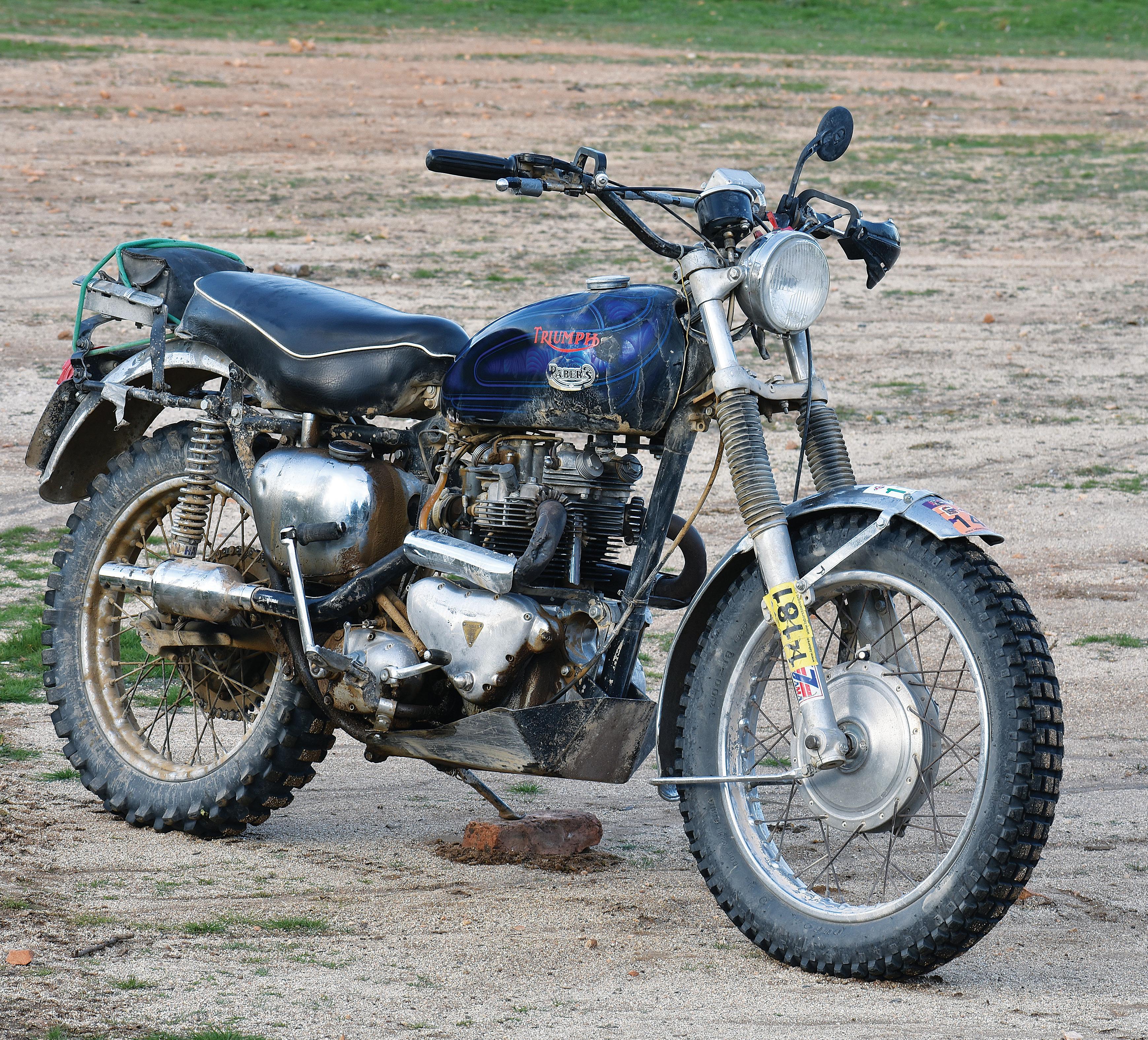
Story and photos by Dain Gingerelli

TThey’re called Desert Sleds, and for good reason; those hefty, somewhat bastardized motorcycles were built to carry their riders quickly and efficiently across portions of what constitute the Great American Desert.
Desert Sleds came to be during the 1950s and early 1960s when motorcyclists realized they could race their motorcycles practically unimpeded over vast stretches of California’s Mojave Desert, much of which is located within AMA District 37’s boundaries. Up to then few people, motorcyclists included, cared much about that big, unsupervised sandbox. When
District 37 desert racing got underway shortly after World War II ended, who cared that hundreds of motorcycle racers at a time were plowing across the sand at breakneck speeds?
Oh, to be fair, select indigenous Americans had, for eons, occupied the desert with little disruption from outsiders, plus prospectors and miners searching for precious metals spent a fair amount of their time scurrying about in that hot wasteland. And not to be overlooked, pioneers striking out for new beginnings in California and Oregon had to venture into that vast unknown before
Engine: 649cc air-cooled 4-stroke vertical twin, 71mm x 82mm bore and stroke, 8.5:1 compression ratio, 42hp @ 6,500rpm
Top speed: 109mph (period test)
Carburetion: Single Amal 289 1-1/8in bore
Electrics: Lucas K2F magneto
Transmission: 4-speed, foot-shift, chain final drive
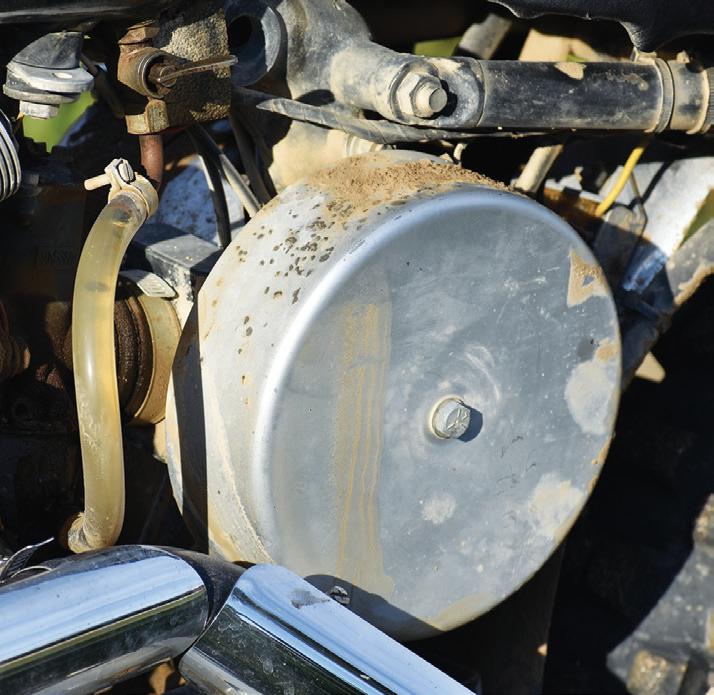
Suspension: Telescopic fork, two rear hydraulic shock absorbers
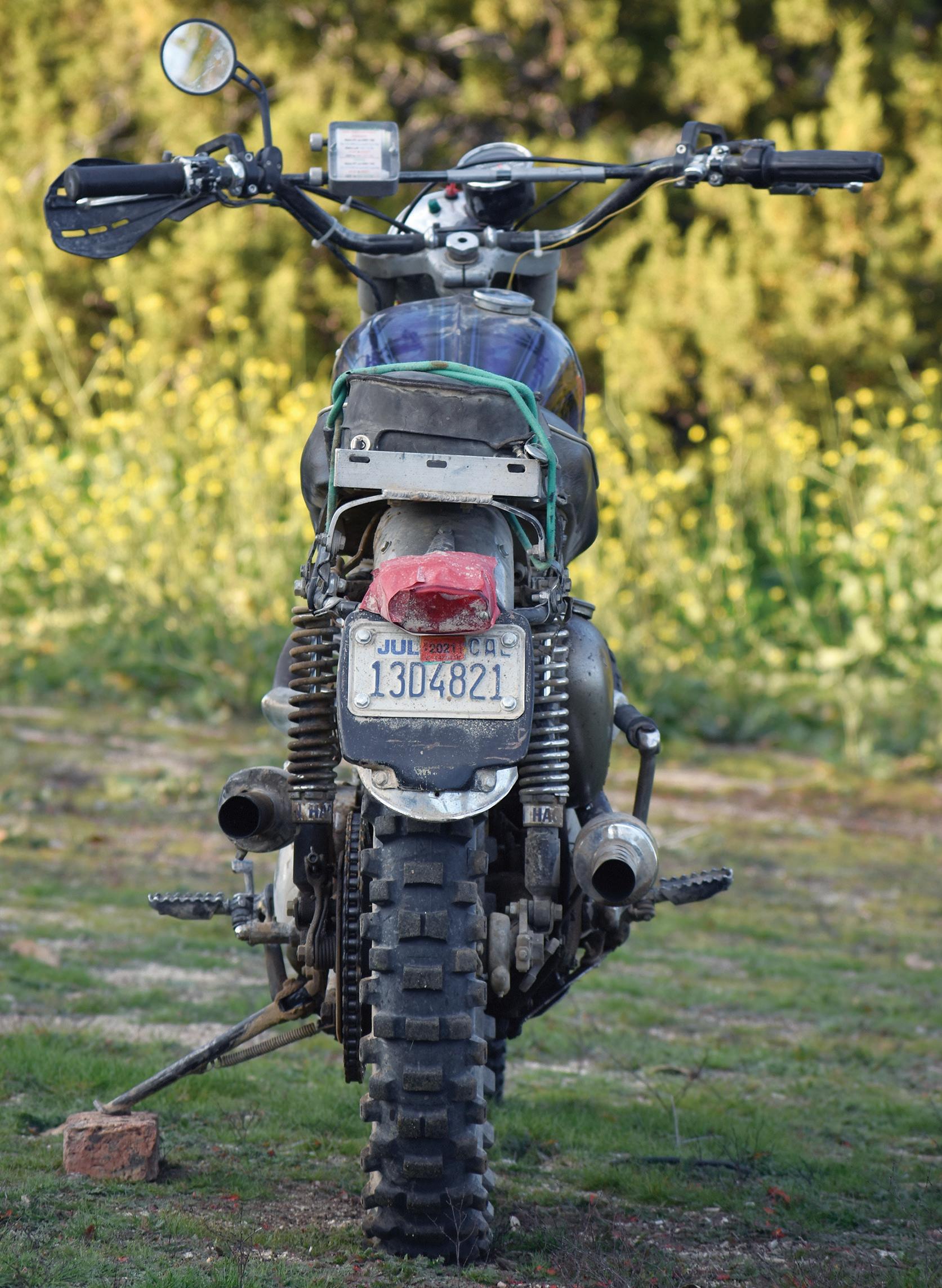
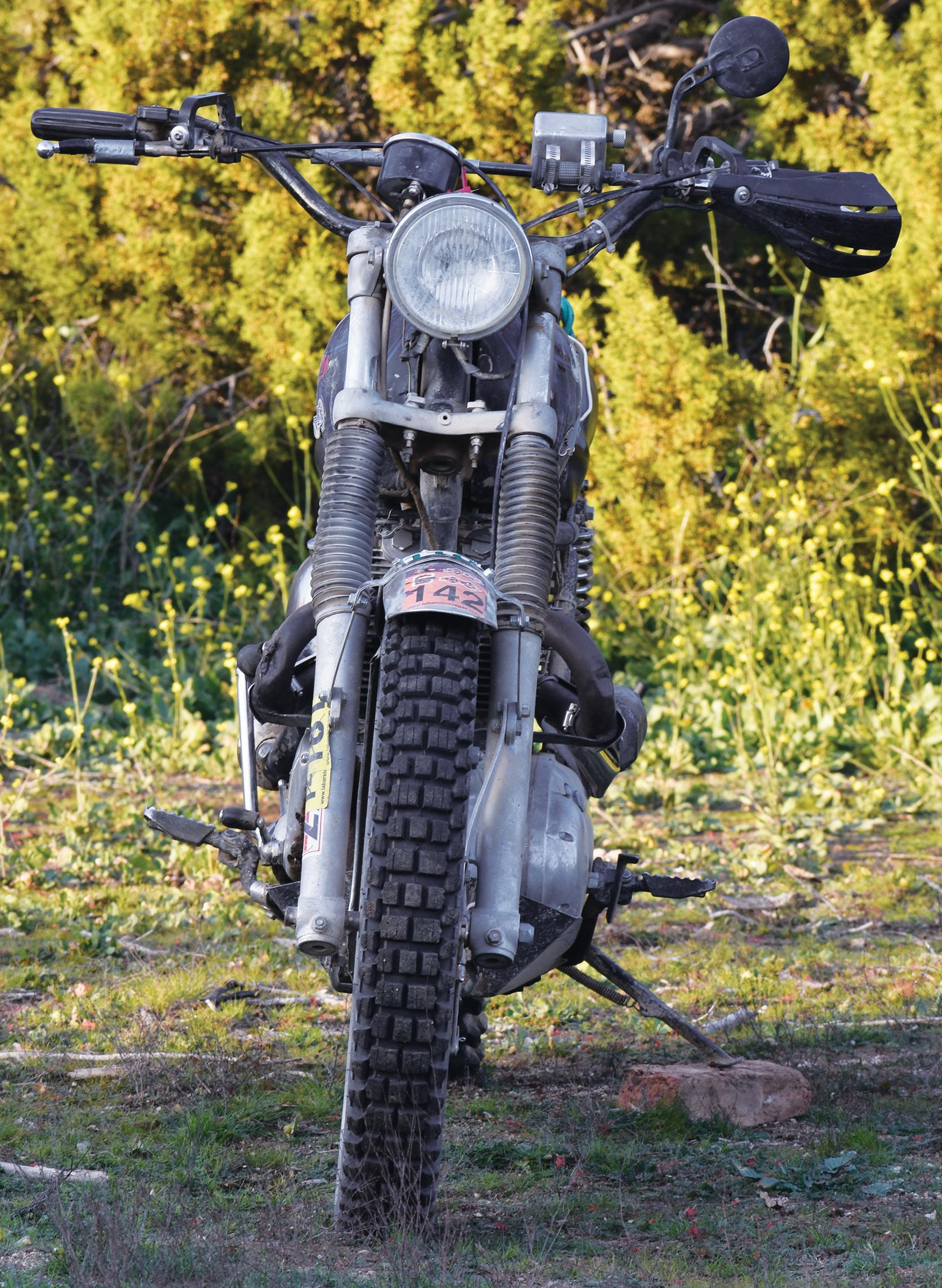
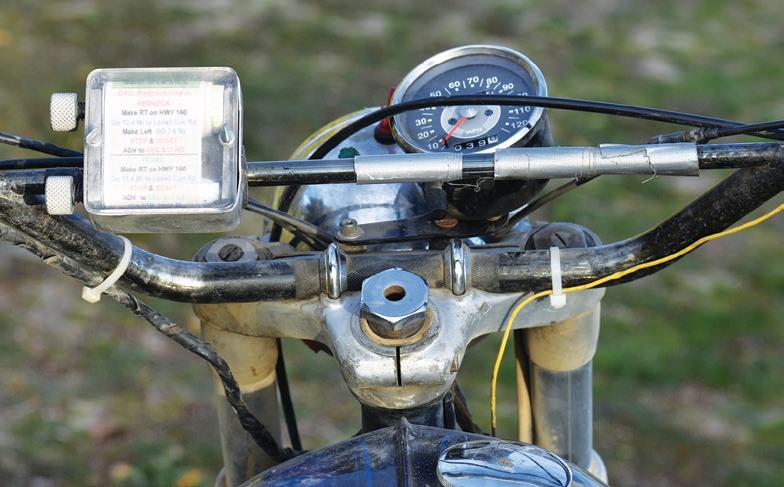
Tires: 3.25 x 19in front, 3.50 x 19in rear
Brakes: 8in (203mm) drum front, 7in (178mm) drum rear
Weight (dry): 395lb (179kg)
reaching their new Promised Land that stretched along America’s bountiful western coastline.
Eventually, though, motorcycle racers realized they could race practically una-
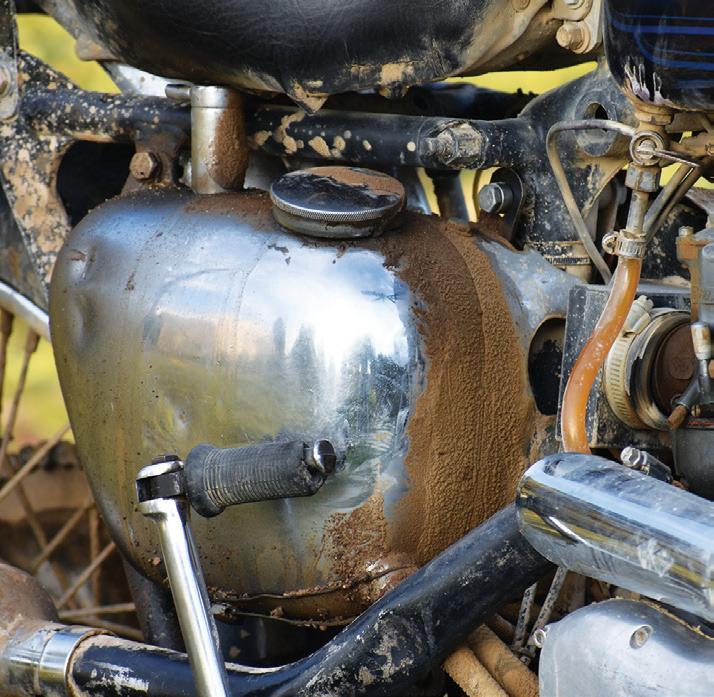
bated on the desert floor, and the racing boomed.
Most early racers based their Desert Sled conversions on street-going British bikes powered by the most modern vertical twin- or single-cylinder engines of the time. As happened, most of the Sleds were Triumph twins, although all brands and models were acceptable. As time passed and the Sleds became more sophisticated in their composition, a properly prepped Sled in capable hands could steamroll
The front fender of Bill’s Sled wears registration stickers from several Barstow-to-Vegas events. Popeye lives on the left side of the gas tank.
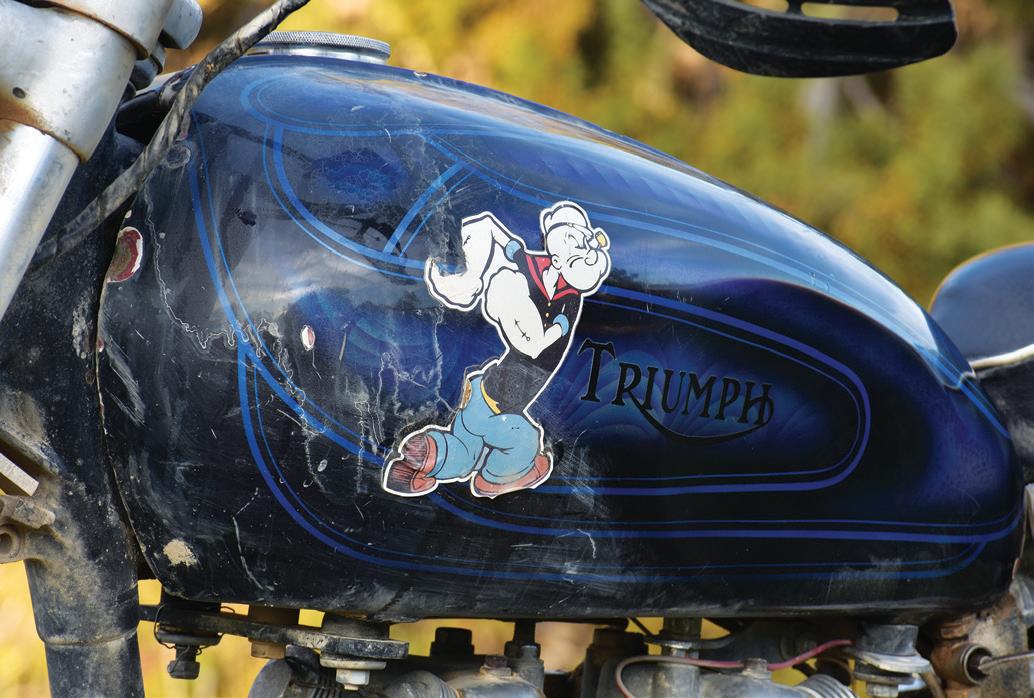

across wide open stretches of barren Southern California desert with surprising efficiency.
Two major factors accounted for a Sled’s performance over rough terrain. Foremost, even though based on ordinary street bike platforms, a Sleds’ modifications included a mixture of make-do and can-do engineering that readied them for 100-plus miles of constant pounding served up during typical desert races, scrambles and hare-and-hound events.
Factor number two focused on the human factor itself — the Desert Sled’s rider. It took a forceful and strong-willed person to pilot a 375-pound motorcycle supported by only a few inches of suspension travel to navigate around, over and through pucker bushes, abandoned mine shafts and sand washes so deep they seemingly could swallow an ordinary motorcycle whole. Yes indeed those early Sleds were ridden by real men (and women!), and after we examine the Desert Sled featured here — a 1954 Triumph T100 powered by a T110 Tiger 650cc engine that was built, owned and ridden by Bill Getty who’s a “long-time motorcycle nut” (his words) — you’ll understand why those Sleds were so capable of taming the desert as well as they did.
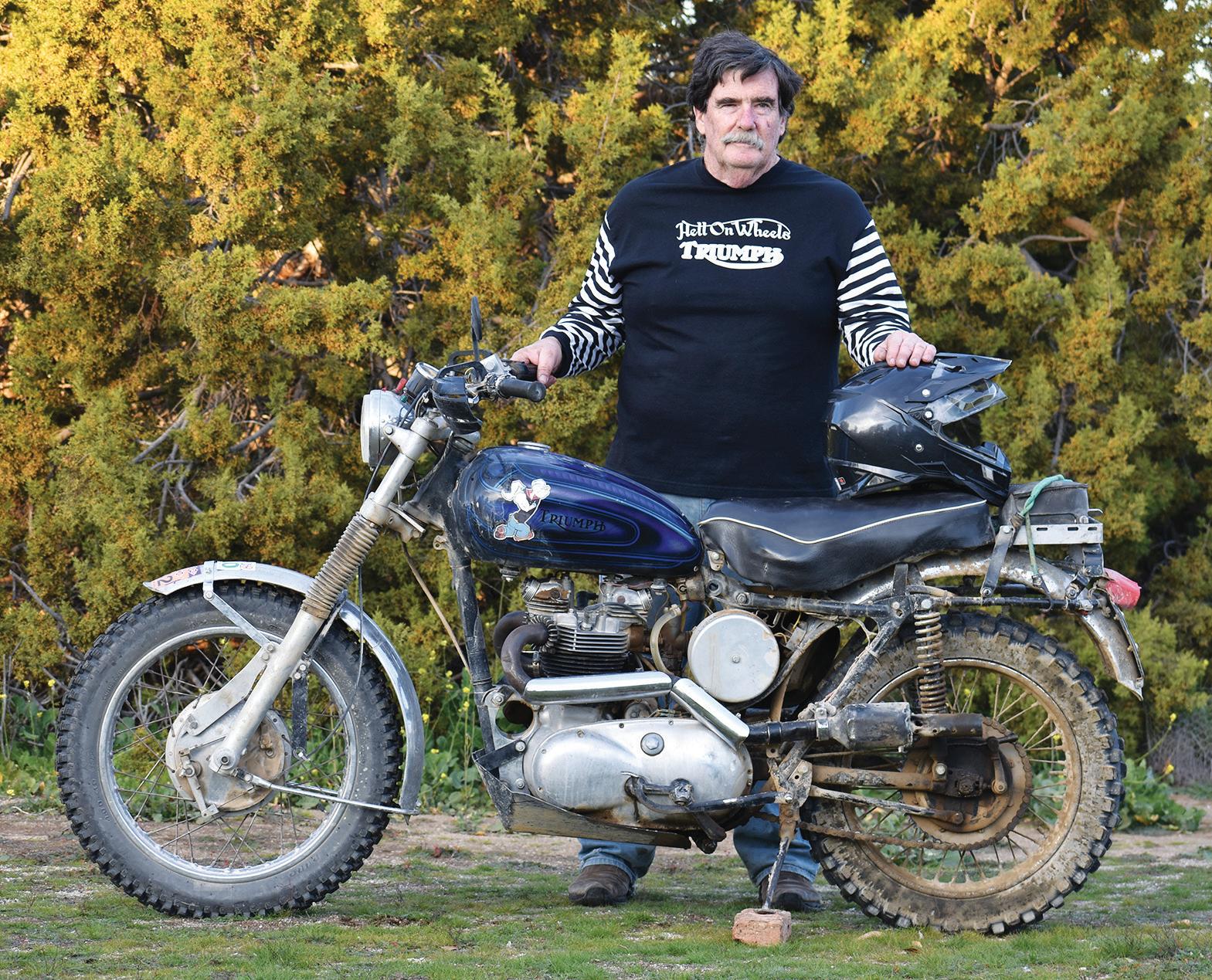
As if ordained by the Divine Creator himself, the Desert Sled motorcycle species evolved within the confines of America’s Southwest deserts shortly after World War II. For a bit of history that celebrates the days of the Desert Sleds we can refer to the March 1974 issue of Cycle magazine where Gordon Jennings wrote a metaphorical passage that “as late as 1965, the motorcyclist’s desert was ruled by a dinosaur, the classic and now almost totally-extinct Desert Sled.” Jennings went on to explain how survival of the fittest favored “the 650cc Triumph twin over all other motorcycles of the time.” The Triumph twin, he explained, “was a lightweight by the standards [of the day].” Jennings could have added to that last
statement, proclaiming Triumph’s TR6 the ultimate model with a DNA strand pattern that weaved its way back to several Triumph twin models before it. The TR6 proved to be the bike to beat in desert racing. The TR6’s lineage included the T100 (first model with a rear swing arm), the Trophy (its 650cc single-carb engine producing a wide power band congenial for slogging through thick, deep sand) and others. In the end the TR6 proved to be the most successful of all those desert dinosaurs, regardless of brand. In reality, though, none of those mechanized giant lizards compare to the motorcycles available for desert duty today, but that’s another story for another time.
Truth is, there was some careful, even scientific, thought in how Sleds evolved into those magnificent creatures that plied the deserts well into the 1970s. Steering geometry was important, and
many racers settled on about 32 degrees of rake. Wrote Jennings: “it was common to have Buchanan’s frame shop crank an extra 4 or 5 degrees of rake into the steering, and maybe add a couple inches to the swingarms,” which set wheelbase at about 60 inches, creating “a high level of stability and an equally high level of resistance to steering inputs.”
Most Sleds rode on 4.00-section Dunlop tires, a 19-inch Trials Universal up front and an 18-inch Dunlop Sports on the rear. Raise the exhaust pipes up and out of the way, and weld a skid plate beneath the engine so that rocks the size of a desert tortoise won’t spoil the ride and you had the makings of a worthy Sled. Of course, the bike’s lights, mirrors, and horn were stripped off for weight savings, and mufflers were replaced with megaphone or straight-through pipes.
Bates often got the call when it was
time to find a place for the rider to sit, and foot pegs (preferably folding type) usually got a reinforcement weld seam. Interestingly, air cleaners were looked upon as optional equipment; few companies offered suitable filters in those early years. In his magazine article Jennings quoted established desert racer Mike Patrick (who often rode Nortons) that “dust would really get to your engine. I tried everything, including Brillo pads to stop the stuff and nothing worked. Eventually K&N began selling air cleaners that worked pretty well, and then Filtron came along, but before that you always had worn out engines and sticking throttle slides,” continued Patrick. His explanation was further proof that Necessity truly is the Mother of Invention, and thank you, K&N.
Perhaps one of the most significant strides made by the Sledders was when Ted Lapadakis, an enterprising Triumph dealer in Los Angeles, modified standard TR6C models for desert racing, selling them as complete racers to aspiring competitors who, in the process, helped
And through it all, dinosaurs, er, Desert Sleds, thrived. That is, they thrived until the advent of 2-stroke off-road race bikes proved to be better at conquering the desert. It was as if an unexpected asteroid plummeted smack dab into the middle of the racers’ beloved Mojave Desert, the only survivors being lightweight and agile 2-stroke motorcycles.
the sport grow. Oddly, Triumph distributor Johnson Motors, operating out of nearby Duarte, never pursued a similar course of action, leaving many racers to patronize Lapadakis’s dealership, or to rely on their own devices in preparing their bikes for battle.
But among the human survivors is a man who remains loyal to the Desert Sled, and that’s Bill Getty, owner of our featured bike. Moreover, his T100/110 hybrid is still capable of roaming the Mojave Desert as if it were its natural habitat (which, in truth, it is). In fact, Bill makes sure the old gal gets to stretch her legs and sink her toes deep into the warm, sunbaked sand at least once a year during Thanksgiving
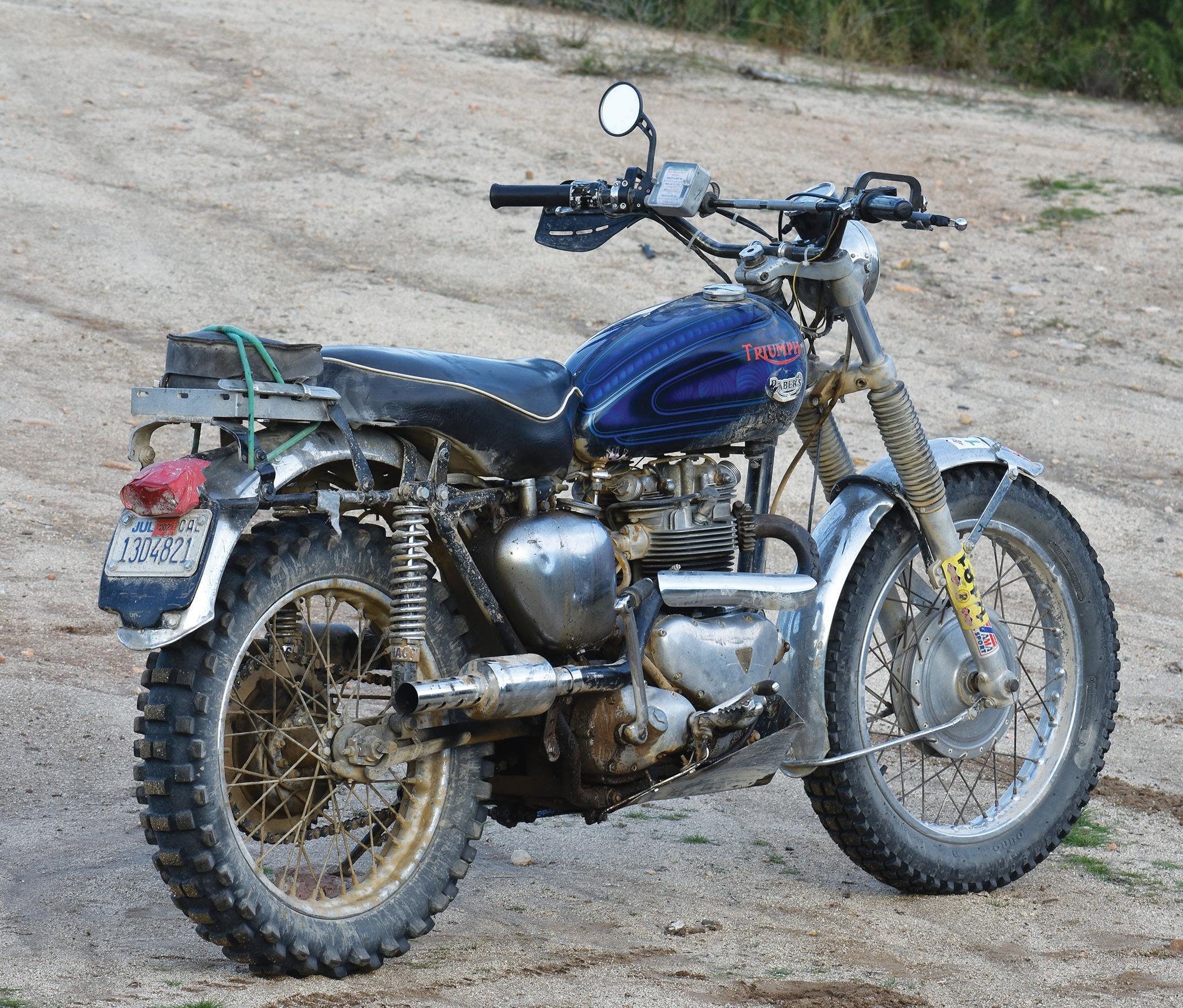
“Necessity truly is the Mother of Invention, and thank you, K&N.”
weekend. That’s when dual-sport riders who harbor a sense of loyalty to one of the most famous desert races of all time — the Barstow to Vegas — gather to pay homage to its history, and to ride through the desert in the process.
In the interest of preserving the desert’s environment, the Barstow to Vegas Race, first run in 1964, is now celebrated only as a non-competitive dualsport ride. Participants gather for a two-day jaunt starting in Palmdale, California, arriving in Barstow to overnight before resuming the chase the next day to finish in Las Vegas, Nevada, itself. The original B-to-V lasted from 1964 through 1974 before, in the interest of preserving the habitat for the endangered desert tortoise, the BLM (Bureau of Land Management) shut down the racing, only
to reinstate it before shutting down again after 1989’s race. The on-again/off-again debate led to much controversy and legal squabble that eventually spawned the heavily monitored annual dual-sport trail bike ride that remains today. The ride
followers are people like Bill and his buddies, many who ride Desert Sleds. This past year Bill teamed up with friend Dominqic Froech, Jr., both on Triumph twins of their own makings for the ride. Unfortunately, Dominiqic DNF’ed after he did the unthinkable, loaning (!) his bike for one stretch of the ride to a friend who crashed (unhurt), disabling the bike enough that it rode into Sin City on the chase truck.
emerged, in large part, through the efforts of a shadow figure known as the Phantom Duck of the Desert who spearheaded a movement that challenged the BLM.
Today the dual-sport ride remains a favorite among Southern California off-road fans, and among its loyal
Bill and his Triumph finished the 2022 ride, and he picks up the story: “I’ve finished more than 20 of the B-to-V rides with this bike,” says Bill, proud that the old bird still has some flap in its wings, because even the dual-sport rides account for about 500 miles, mostly off road, if you’re to finish both legs. And as a diehard enthusiast (Bill is also a member of the BSA
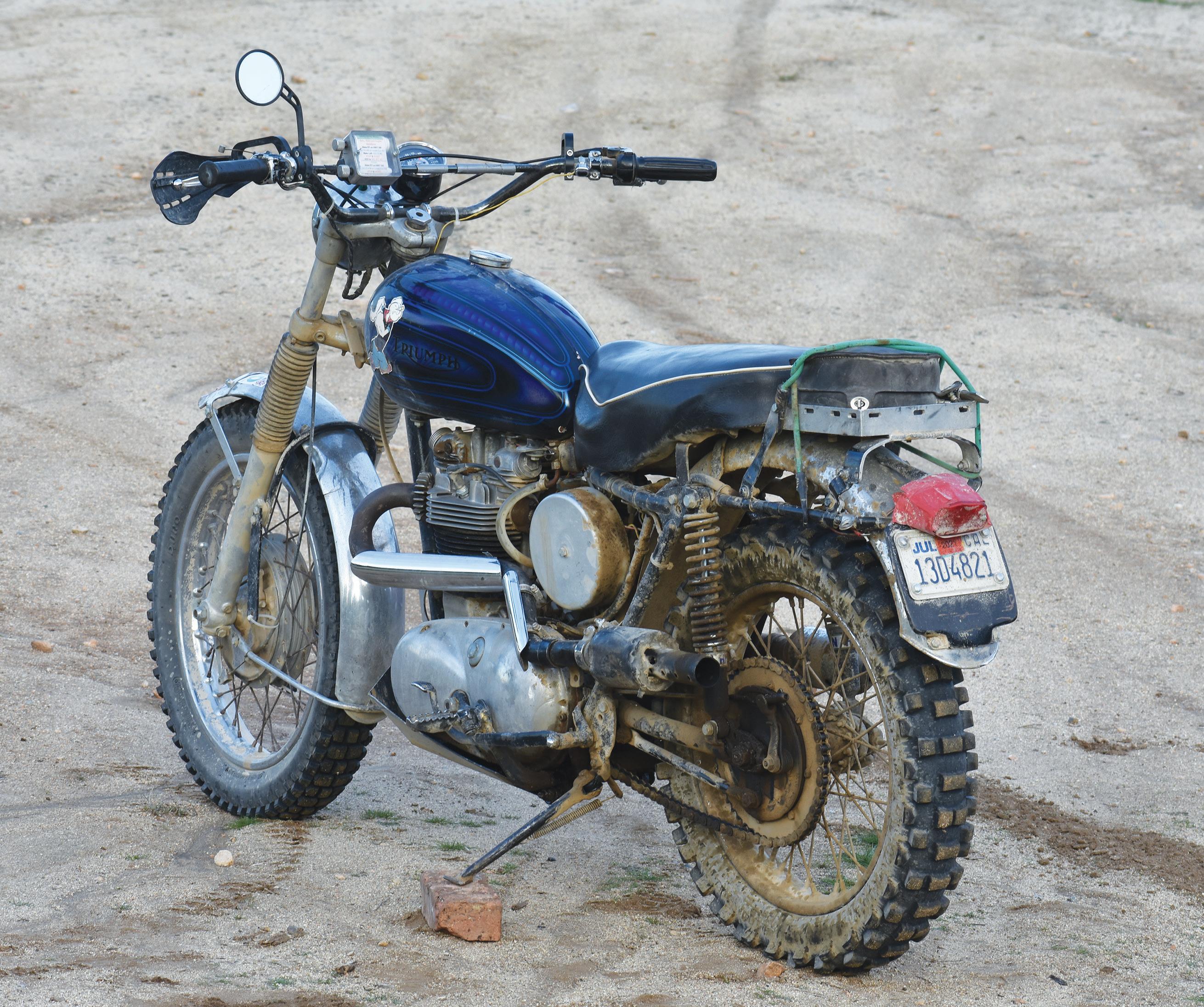
“Today the dual sport ride remains a favorite among Southern California off-road fans.”
Owner’s Club and he writes and edits the monthly online newsletter for the Trailblazers organization) his goal is to first finish whatever event he signs up for.
But before his 1954 Triumph could fly in the first of many B-to-V gatherings, it had to learn how to walk again, and that alone represents a colorful chapter with the bike’s past. Its origins date back to the days when desert racer Larry Benton owned it. It turns out that Benton had removed its engine for use in another desert racer project, and that transplant relegated the 1954 T100 to undeclared “T50” status; the bike sat for years leaning against a shed wall. That changed when Bill acquired the dusty and rusty bike to reactivate it for desert service. First order of business was to shoehorn a rebuilt T110 engine into the chassis to get the Triumph rolling again.
“I traded a wrecked BMW 1000 for it in ’92,” recalls Bill. “I installed a 1954 engine into the rolling chassis. I’ve retained the bike’s patina, but I replaced all the worn components with fresher parts.” The following year Bill, aged 40 at the time, entered it in the 1993 B-to-V dual-sport ride, the first of more than 20 he’s entered since, finishing all but a few of them aboard the revived Triumph.
More than just a happy-go-lucky racer, Bill also happens to be the quintessential
environmentalist who’s always prepared to recycle as many old parts as possible into his “restoration” projects. That translates to creating his own upgrades for each project, and among them for this T100/T110 hybrid was replacing the suspension, placing a vintage Ceriani fork up front to make full use of its 6 inches of travel. And that’s twice the travel offered by the two vintage (used) coil/over rear shocks. He settled on a (used) 19-tooth countershaft sprocket, matching it with a (used) 47-tooth rear sprocket, with standard Triumph gears still churning
carb shows signs of being “pretty won out,” the Lucas magneto that he pirated off a blown-up Norton 600, coupled with alternator primary cases from a 1962 650 means that when the desert sun dips menacingly below the horizon, Bill has 12-volt lighting to help guide the way to the finish. So much for the Prince of Darkness disrupting this ride.
away within the pre-unit transmission cases. “Third gear could be a bit lower,” confesses Bill, “but the engine makes remarkable torque down low and it will climb amazingly well.” He also sourced (that is, recycled) the exhaust system (two well-worn upswept pipes, one on either side) from a friend, Johnny Green, paying full list price of $25 for the pair.
Clearly, Bill takes pride is recycling as many old parts into the “new” bike as he can. For instance, while the Amal 930
The bike shows up occasionally at other events, too. Every now and then Bill takes it to nearby Glen Helen Park for some on-track exercise. And at about the time this article reaches the sticky fingers of our dedicated readers, the bike will be shown at the annual Tom White Memorial Bike Show that’s held leading up to the annual Trailblazers Banquet. And, just as the bike appears in the photos on these pages, Bill’s old Sled will proudly wear its coat of Mojave mud that’s been caked on it since finishing the 2022 Barstow-toVegas Dual-Sport Ride at the Tom White bike show. Clearly this bike lives up to the motto of this magazine — “Ride ‘Em, Don’t Hide ‘Em.”
Finally, this: The Popeye caricature on the gas tank’s left side is there for a reason. “What purpose is that?” I asked Bill during our photo session.
“I yam what I yam,” Bill replied.
But most of all, like Popeye himself, this old Desert Sled is strong to the finish. MC
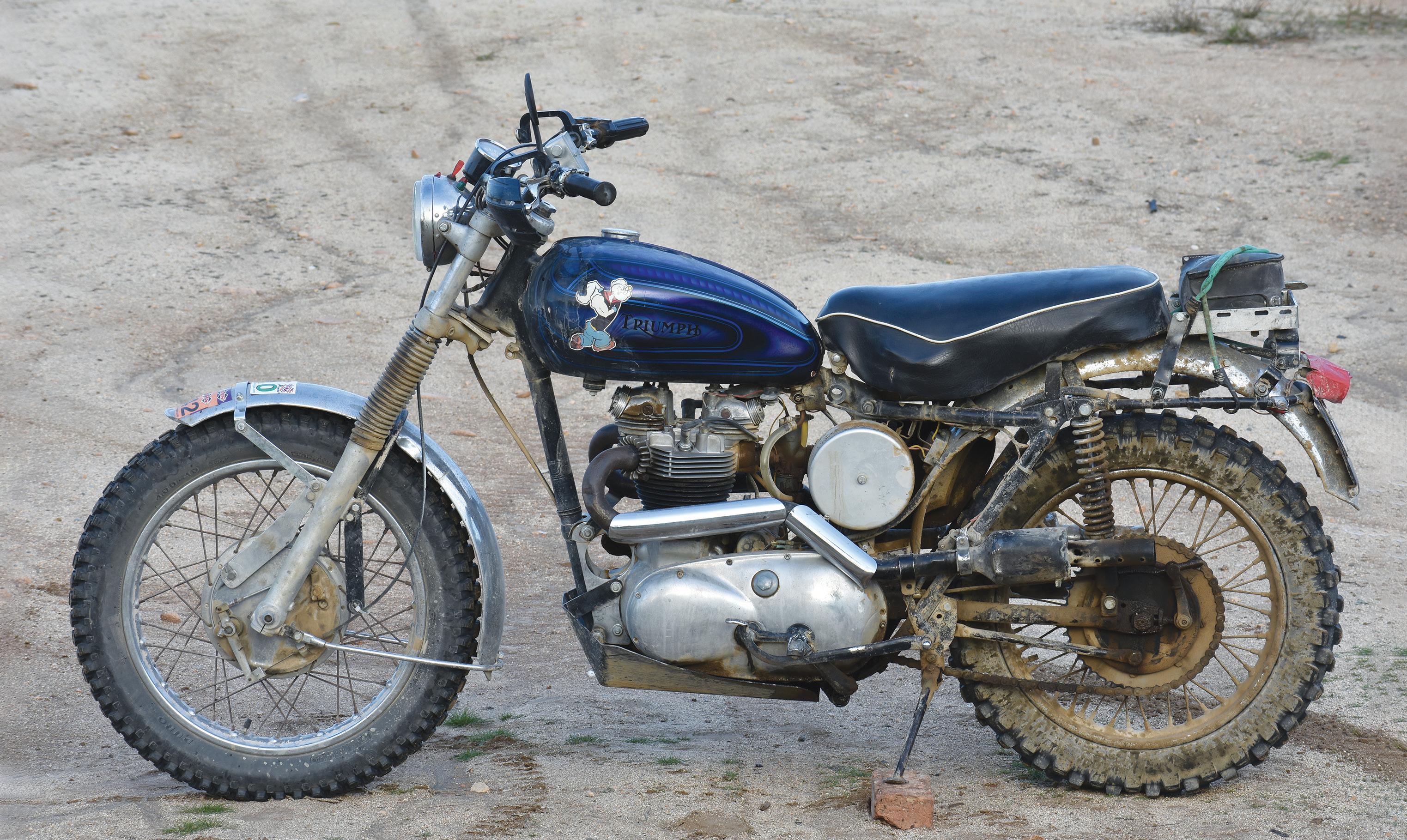
“Bill’s old Sled will proudly wear its coat of Mojave mud that’s been caked on since finishing the 2022 ride.”
Enjoy stunning, classic motorcycles year round with the new Motorcycle Classics 2023 calendar! This calendar features glossy photographs of your favorite classic bikes from Ducati to Suzuki, BMW to BSA and more. This calendar will look perfect in any office, garage, or man cave. It’s the ideal gift for any classic motorcycle enthusiast!
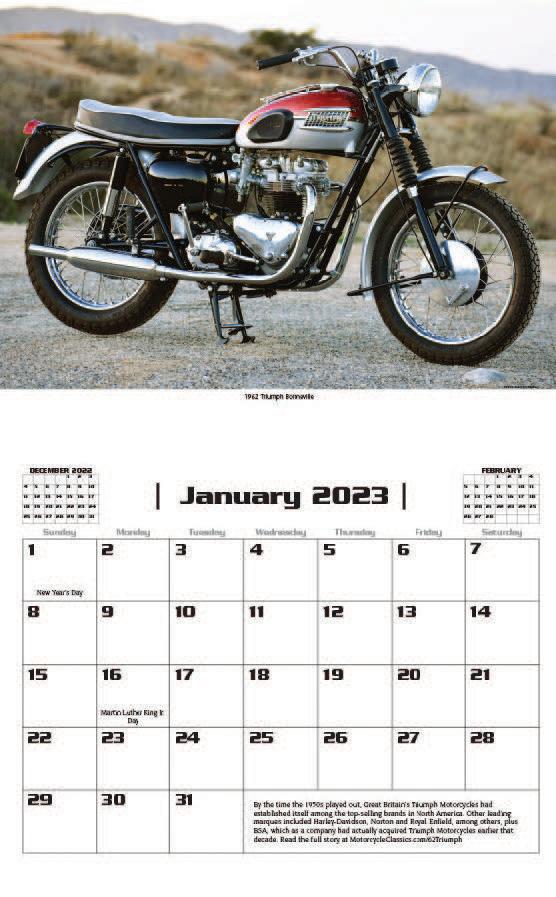
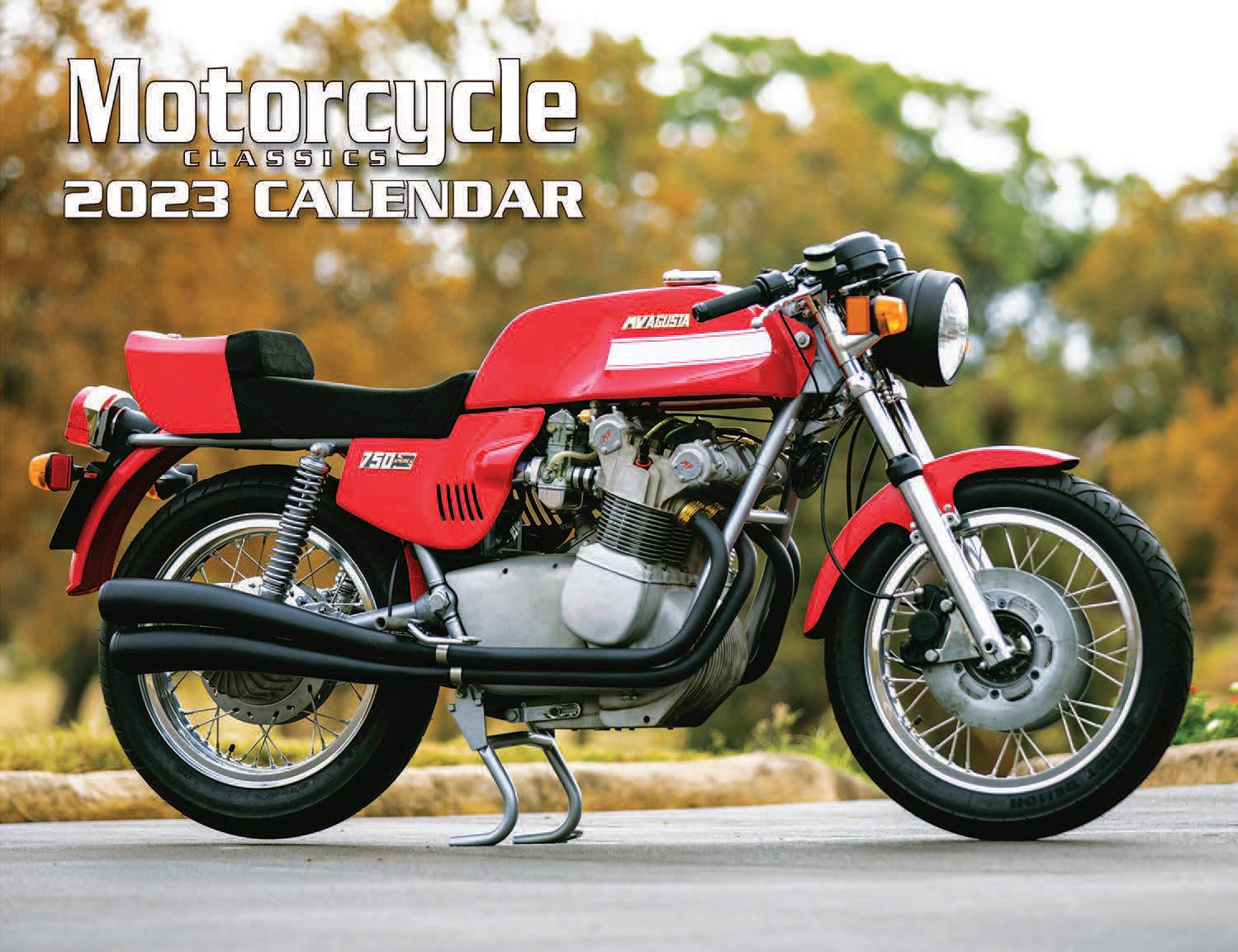
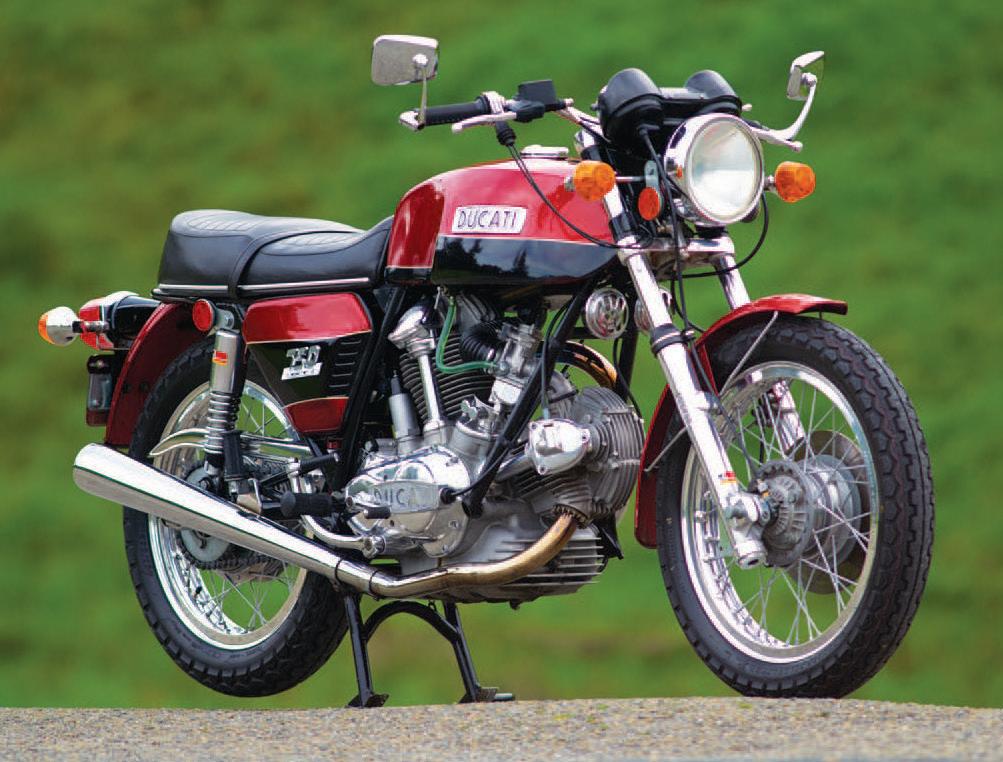
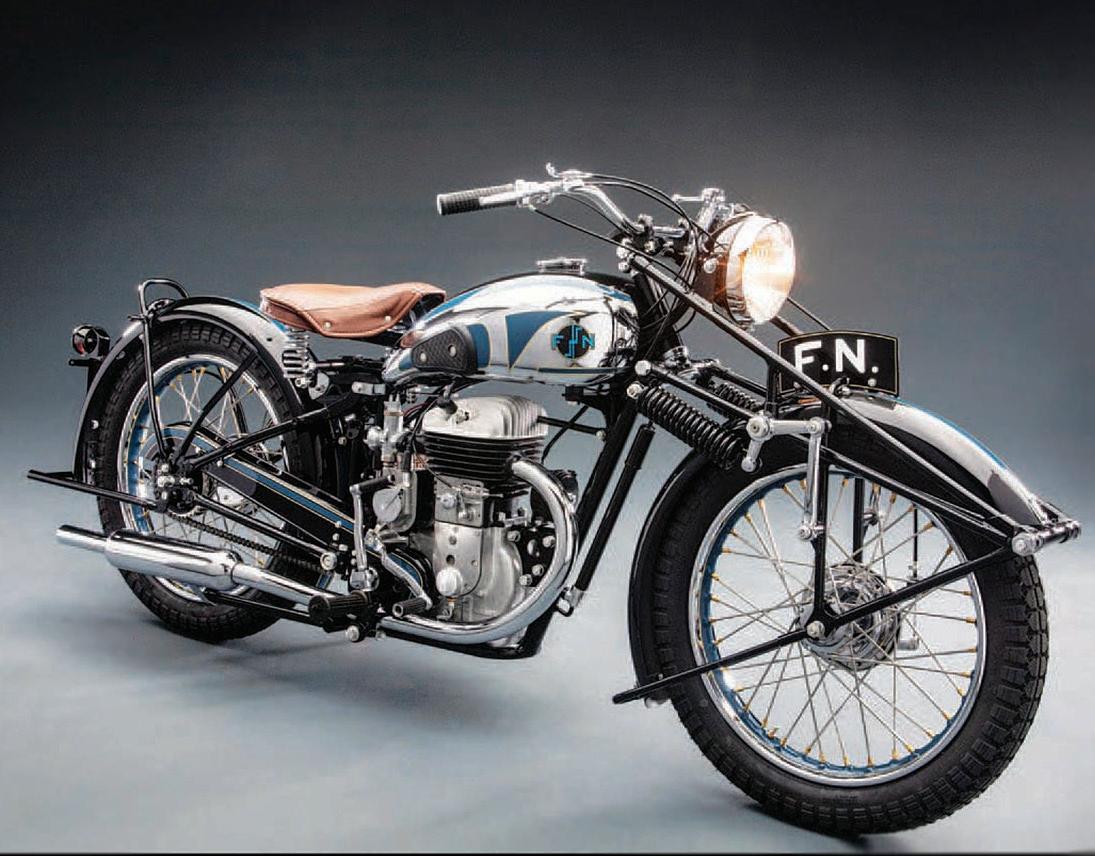

$17.99
Calendar Size: 13.75’’ x 10.5’’ | Item #11799








It promotes discomfort, breaks parts, turns lubricating oil into a foam bath, and eats up power. Nowadays there are more bikes built with a balance shaft, or counterbalancer, than those without — certainly over 250cc, anyway. Yet it was only 50 years ago that the first ever motorcycle fitted with one reached the global marketplace, in the form of the Yamaha TX750 parallel-twin.

Only the most dogmatic fan of any of the other Big Four Japanese marques would dispute the notion that Yamaha has always been by some way the most innovative Japanese motorcycle manufacturer in terms of product design. Sometimes Yamaha’s wilder R&D bets haven’t paid off, but they failed because they didn’t thrill customers enough to make them whip out their credit cards, whereas the Yamaha TX750 was that rare thing, an apparent category-topper that turned out to be an unreliable mechanical catastrophe Made in Japan.
The weird thing is, it only came about because Yamaha played the conservative card at a time when its three J-rivals were pushing the barriers of road bike technology. Honda of course had led the way in October 1968 by unveiling its 4-cylinder 4-stroke CB750 at the Tokyo Show — but there across the hall was Kawasaki’s 3-cylinder 500cc H1 Mach III 2-stroke, the replacement for its 650cc W1 neo-British OHV parallel-twin. Two years later at the same venue Suzuki debuted its version of the 2-stroke triple theme, the liquid-cooled GT750 — followed a year later at Tokyo ‘71 by Kawasaki’s ultimate drag-strip dominatrix, the 750cc H2
Mach IV 2-stroke triple, and then by the 903cc Z1, the most powerful Japanese 4-cylinder 4-stroke yet marketed, trumping Honda’s smaller, slower 736cc rival.
So this meant that, commercially speaking, against their rivals’ high performance, high tech new models, Yamaha’s engineers were fighting the war before last, when Japanese manufacturers tried to beat the British at their own game. Hence the 1969 debut of the XS650 Yamaha parallel-twin with its SOHC unitconstruction engine and horizontally split crankcases, which underpinned the firm’s attack on an American market then dominated by British bikes. Yamaha had obtained the design almost by accident when it purchased Showa (as in, suspension) in 1960, who had in turn acquired it by buying minor bike brand Hosk earlier that same year. Hosk was a former licensee of the German manufacturer Horex, whose 500cc SOHC Imperator parallel-twin had entered production in 1955, but was phased out two years later and the design then sold to Hosk when Horex went bankrupt in 1958. After acquiring Showa, Yamaha duly used the Hosk/ Horex design as the basis for the XS650 (aka XS-1), its first 4-stroke twin, which sold sufficiently well in the U.S. for them to consider developing a follow-up version of the model which addressed its customers’ No.1 complaint — the vibration endemic in such 360-degree two-up twins.
The result was the TX750 duly launched in 1972 as Yamaha’s range-topping model, dead-heating with the Kawasaki Z1 — despite which sales initially boomed, with 15,511 examples shipped to dealers in the last five months of the year. While superficially similar to the XS650, the TX750 was an almost entirely new design, so although its all-aluminium, horizontally split, dry sump engine remained a
VVibration is the enemy of just about everything that makes motorcycling fun.
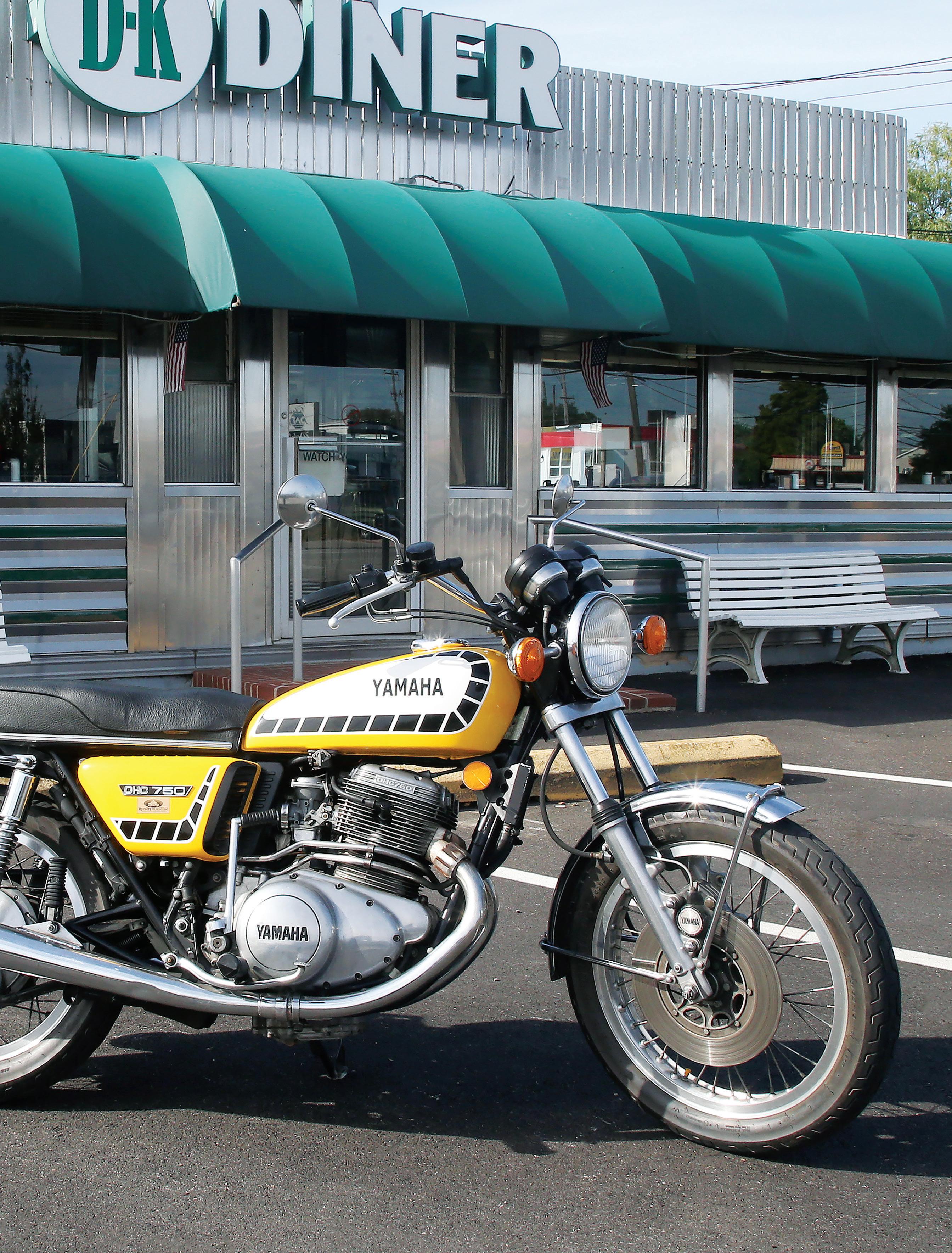
Brit-style air-cooled parallel twin with two valves per cylinder, a 360-degree crank and the same 74mm stroke as before, its pistons delivering 8.8:1 compression now ran in 5mm oversized 80mm cast iron bores for a capacity of 743cc, resulting in a claimed output at the four-bearing crank of 63 horsepower at 7,500rpm — up from the XS650’s 53 horsepower. Much beefier peak torque of 50.7lb/ft (against the 650’s 35.8lb/ft) was produced at 6,000rpm, transmitted via a 5-speed gearbox, straight-cut gear primary drive, and an oil-bath clutch. It retained its predecessor’s chain-driven SOHC with four short, finger-type rocker arms operating the valves, while twin 38mm Mikuni Solex carbs fed the reworked cylinder head, with relatively shallow combustion chambers sculptured to produce a better bang. Other new features included a crankcase ventilation system where gases were fed via a reed valve into the airbox for recirculation, along with sintered alloy valve seats suitable for unleaded fuel, and a balance tube in a cast manifold which connected the two exhaust ports together at the front of the engine.
Apart from the 100cc greater capacity and increased power and torque, the major new feature on the tough-looking new TX750 engine was its so-called Omni-Phase Balancer positioned in a cavity beneath and slightly to the rear of the crankshaft — hence the dry sump engine’s oil tank was positioned just
under the seat. These vibration-sapping balance shafts consisted of two counterrotating weights driven by a single chain running directly off the crankshaft. One of these was designed to eliminate the primary imbalances created by the firing

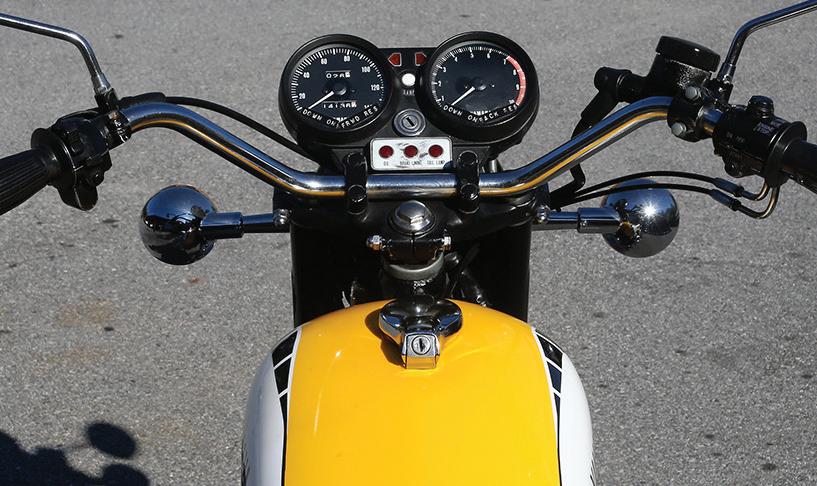
Engine: 743cc air-cooled dry sump 4-stroke paralleltwin, 8.8:1 compression ratio, 80mm x 74mm bore and stroke, 63hp @ 7,500rpm, 50.7lb/ft at 6,000rpm
Top speed: 114mph (183kmh)
Carburetion: Two 38mm Solex Mikuni Type BS38
Transmission: 5-speed unit-construction gearbox
Electrics: 12v, coil ignition
Frame/wheelbase: Tubular steel duplex cradle frame/ 57in (1,455mm)
Suspension: 36mm telescopic fork front, swingarm with dual Hagon shocks rear
Weight/distribution: 518lb (235kg) wet, split 45/55 percent
Brakes: 11.8in (300mm) steel disc front, 7in (180mm) SLS drum rear
Tires: 3.5 x 19in front, 4 x 18in rear
Seat height: 32in (810mm)
Fuel capacity: 3.7gal U.S. (14ltr)
Owner: Joel Samick, Retro Tours, Kennett Square, Pennsylvania, retrotours.com
strokes of the crankshaft against which it counter-rotated, and the other (smaller) one to counter the rocking couple created by the first balancer. It worked, providing this big-bore twin with a similar feel to a 4-cylinder bike. “The result is smoothness beyond belief,” wrote Cycle World in its October 1972 issue. “Shut your eyes, and you are on a four. It couldn’t be a twin.”
Unfortunately, all was not so rosy, and it took only a few months — especially after sales began in Europe early in 1973 — for word to get out of serious reliability problems with the new engine, with broken cranks aplenty seemingly caused by the Omni-Phase balancers heating up the engine lubricant at high revs and whipping it into a froth, so the aerated oil then starved the crank bearings and connecting rods of lubrication, while flooding the two ignition points housings. Additionally, the balance chain apparently tended to stretch, knocking the counterweights out of phase and making the engine run even rougher than a standard twin without the balancers — before eventually breaking, with imaginable results. It seemed that Yamaha had unforgivably not tested the bike under the more extreme riding conditions prevalent in Europe compared to Japan — or even America.
Still, the company responded quickly — as it had to, with sales of 7,770 such
bikes in January to March 1973 tailing right off to 3,360 units in all the other nine months of that year — via what was the first technical recall of a current model in modern motorcycle history. This was for no less than 18 different component replacements or adjustments, up to and including new crankcases now incorporating external balancer chain adjusters, a deeper oil sump with anti-froth baffles, a factory-developed oil cooler, and doubled up gaskets for the points housings. But the damage had been done, with the model already synonymous with poor design and unreliability. The 1974-model TX750A had no such issues but sales still
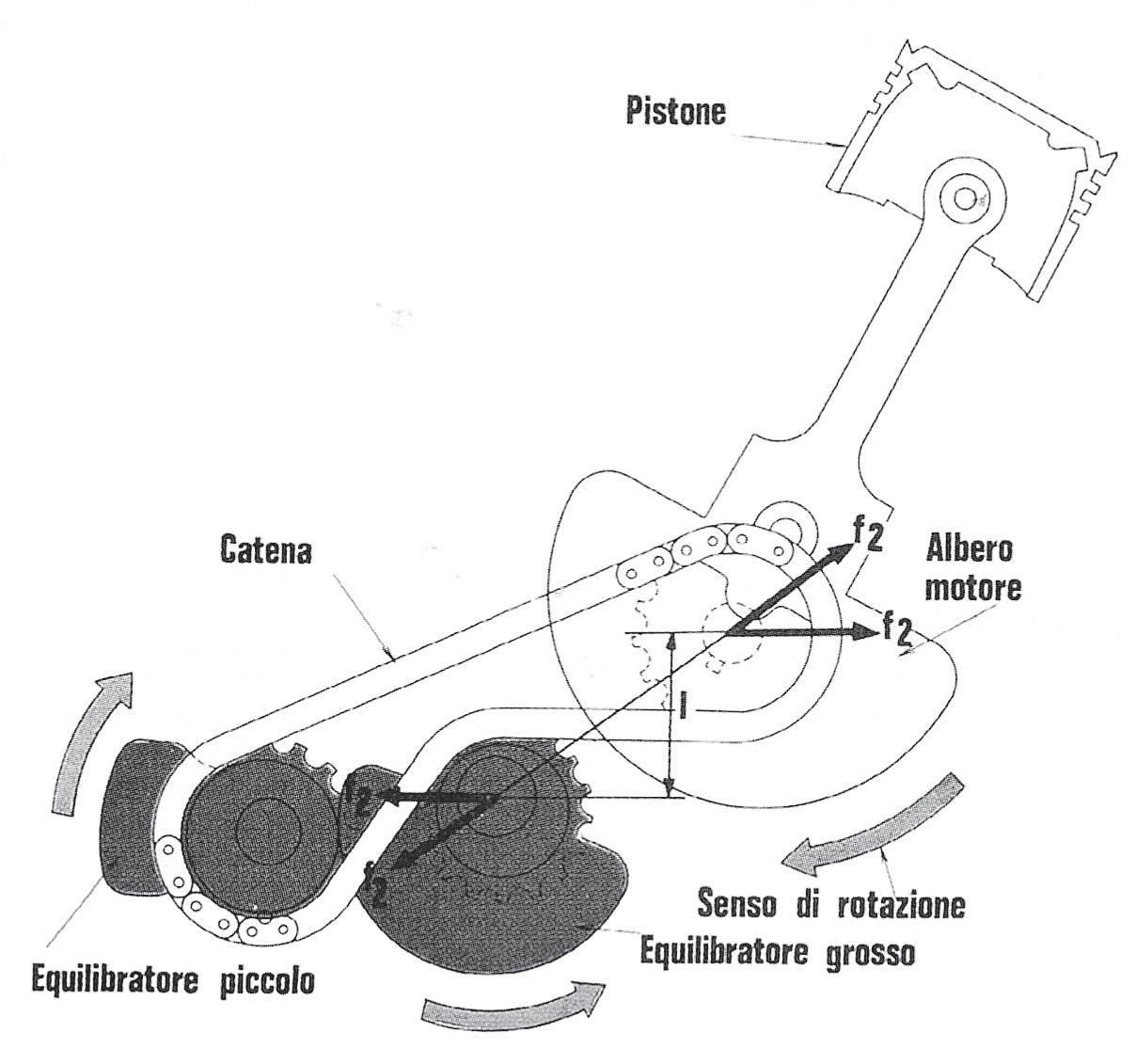
flopped, with just 900 examples finding owners that year, and 400 more in 1975 as remaining stocks were sold off at massive discounts. In just two and a half years Yamaha had sold 33,441 examples of what some today regard as the best Classic-era parallel-twin ever made. It’s just a shame that its engineers needed two tries to create it.

Still, the TX750’s well-earned reputation for unreliability made it a surprise to find an early example from September 1972, which today earns its keep in southern Pennsylvania as one of the fleet
of classics available for hire from Retro Tours (Retrotours.com). We’ll let owner Joel Samick explain how he came to acquire the 1972 TX750.
“It was the dreariest part of the winter of 2003,” Joel recalls, “and I was thinking about how I could add a big 4-stroke twin from the tuning fork folks to the Retro Tours fleet. But XS650 Yamahas were too commonplace, almost prosaic, so when I happened across an obscure, probably obsolete listing for a TX750, it sparked some real masochistic interest, because it was renowned as the worst bike that Yamaha ever built — they blew up like hand grenades! The problems were
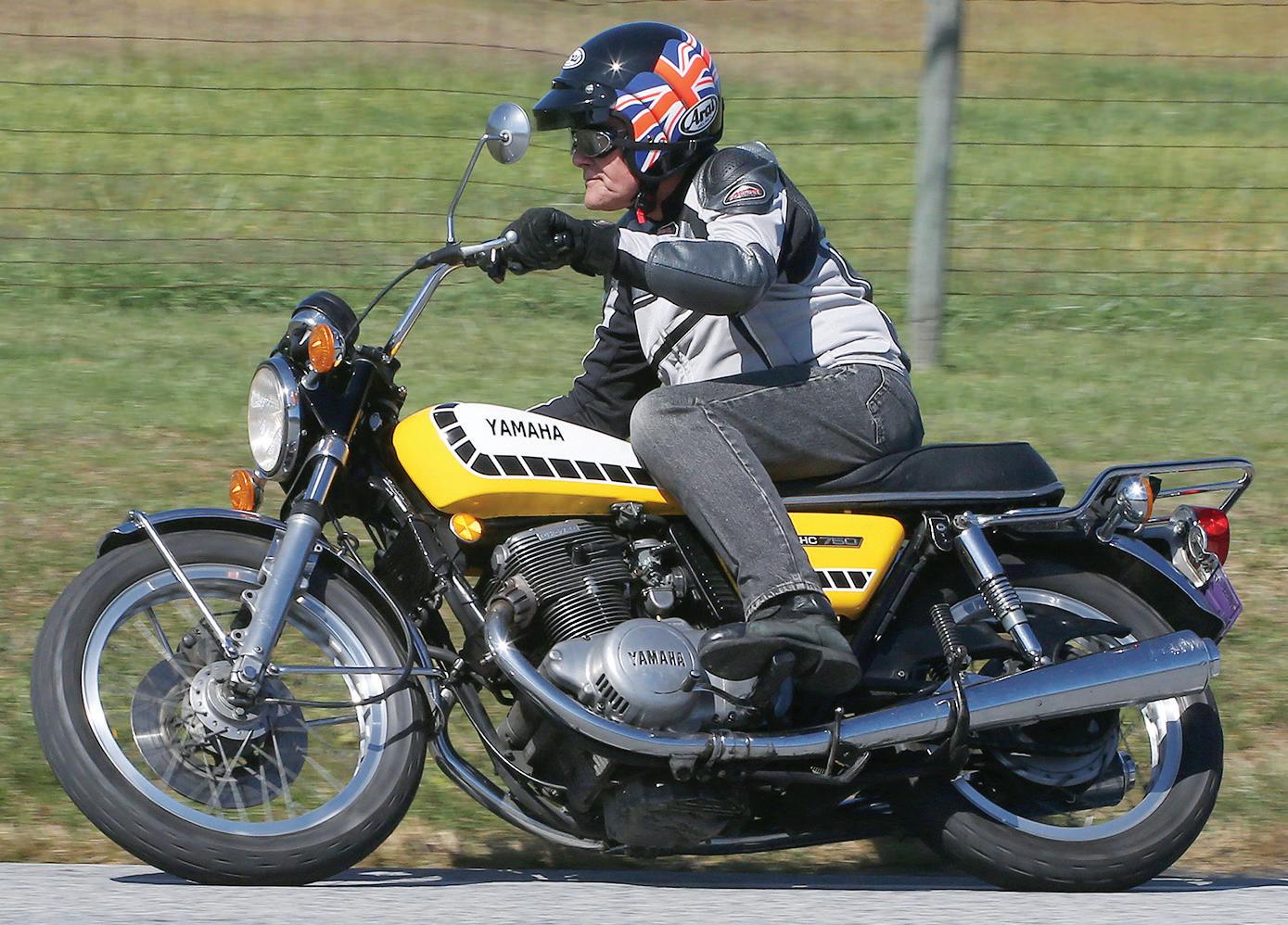 A diagram of the balancer shaft (labeled in Italian, no less).
A diagram of the balancer shaft (labeled in Italian, no less).
serious and numerous. Oil got into the points case, ending spark production. Balancer chains were non-adjustable, and broke — major internal shrapnel. If the balancer chain didn’t break, then the balancers were likely to churn the oil into froth, much to the demise of rod and main bearings. If the oil didn’t turn to foam, it would soon leak past the head gasket, making a real mess. I had never seen one that ran.
“So for a motorcycle related diversion from the cold winter, and to spend some quality time with the missus, we took the pickup truck and headed for New Jersey, not too far away — three hours or so. I’d called the guy and he said, yes, it’s a very nice bike, it had been real reliable for him and his wife going touring, he had
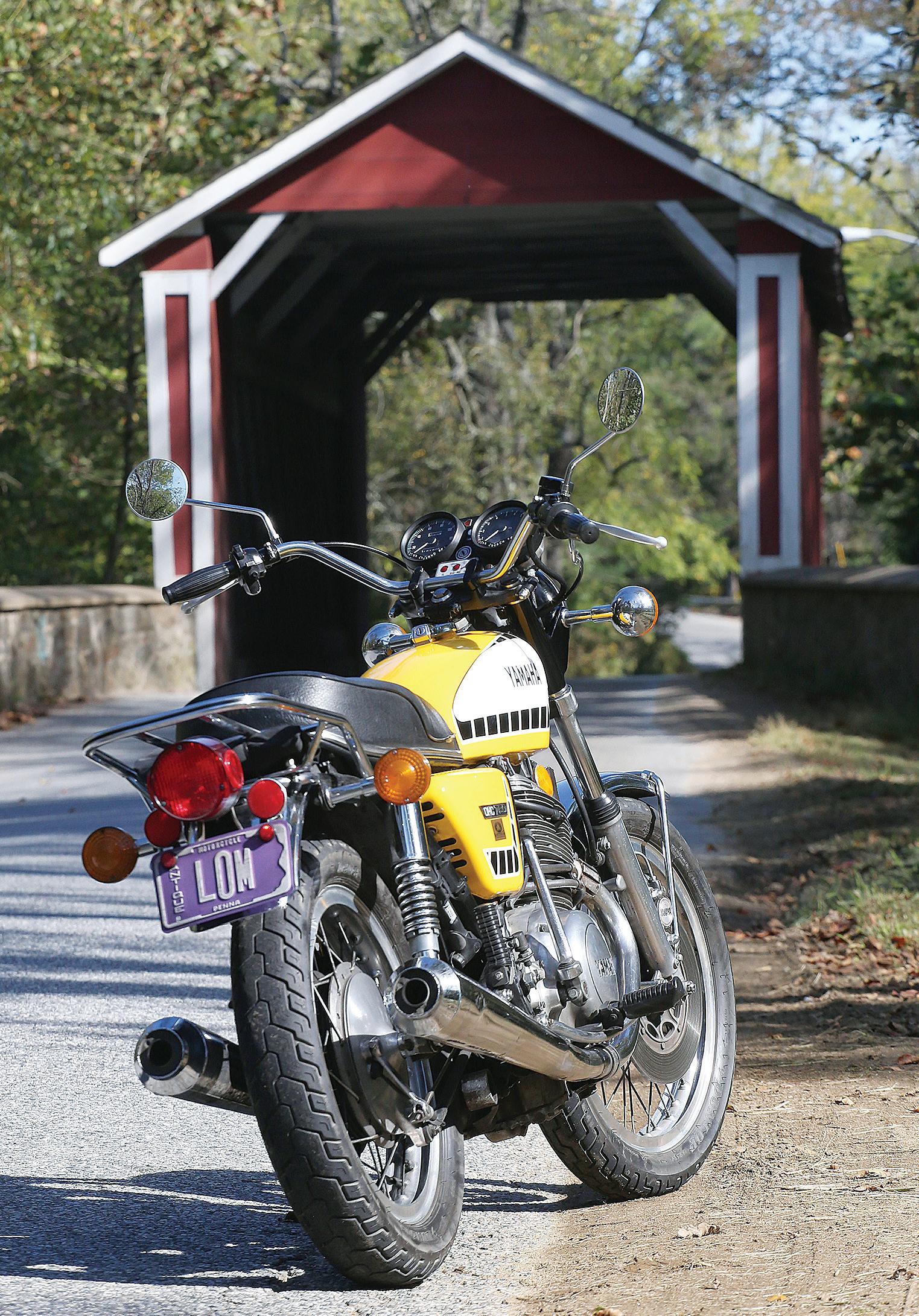
been riding a newer bike, but he and his wife still preferred to tour on that one, for some reason. My wife happened to have a bunch of money in her purse from our dealership she ran — always risky. Can you see where this is going? We found it ran and in fact sounded healthy — somehow it had accumulated nearly 30,000 miles, a record for the model, for sure! I test rode it half a mile in the snow, paid the asking price which was really low, loaded it up and took it home. I just had a feeling, and I’m glad I did. I did some work on it and rode it for a year or two, but the paint was just so ugly that it almost detracted from the enjoyment of riding it. So I eventually got it painted, and the guy who did it was a real artist — I told him I wanted a strictly non-standard Kenny
Roberts paint job, and in my opinion he did it brilliantly well.
“During my research, I came across a website in Newark, Delaware, detailing every bit of known information on the model: a fantastic find. I soon discovered that before bailing out, Yamaha had methodically updated and improved the TX750 to bring it up to their usual high standard. New crankcases with balancer chain adjusters, a deep oil sump with anti-froth baffles, factory installed oil cooler, doubled up oil seals for the points compartment — every flaw had a cure. These updates had all been performed on my new acquisition, including the new crankcases, plus all the usual work needed to rekindle the flames idled by time. So fine, now we have ourselves a TX750 that runs as designed, and blows up much more slowly than before — and we’ve had it for almost 20 years during which time it’s done another 14,000 miles with practically no hiccups. It’s just a very good bike that Yamaha should have got you guys in Britain to ride hard before they let it loose on the rest of the world. Then they’d have known what they still had to fix before shipping them to dealers.”
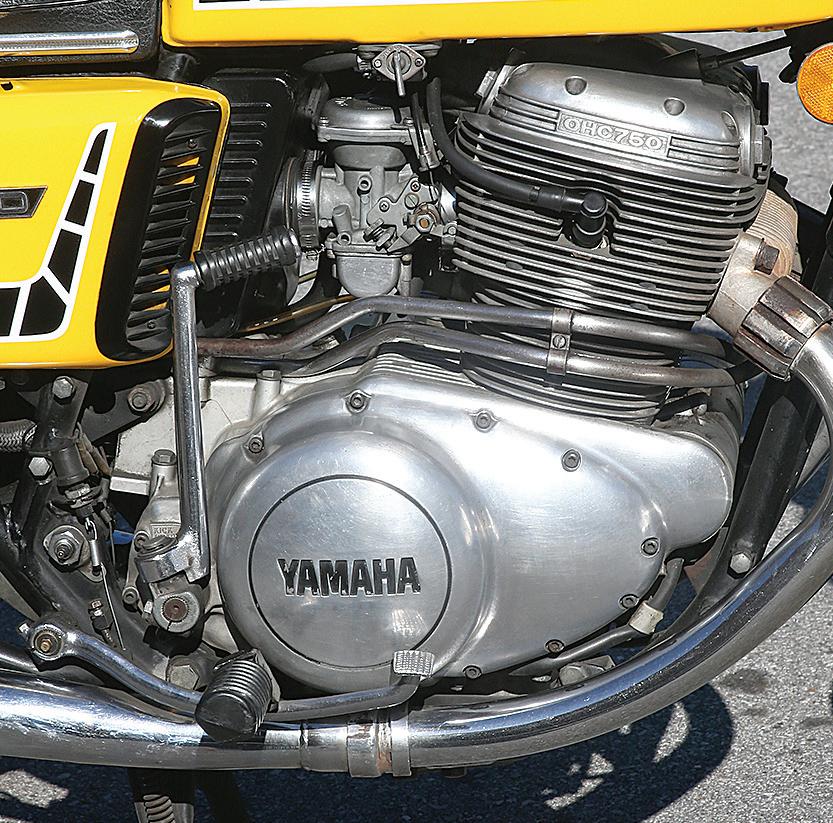
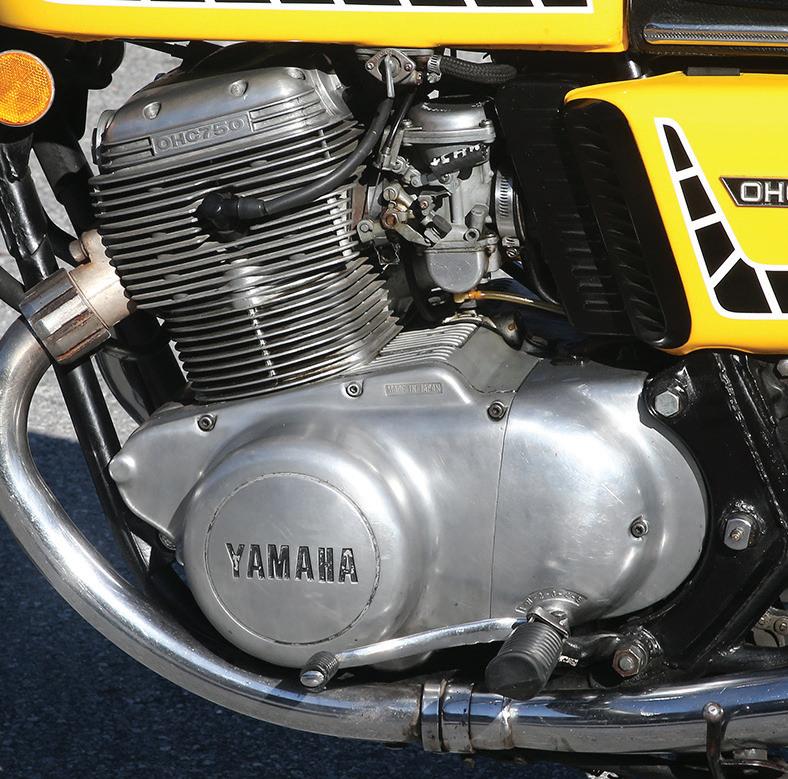
I will admit that I’d never knowingly seen a TX750 before throwing a leg over Joel’s bike’s broad, well-padded 32-inchhigh seat, so I wasn’t quite sure what to expect. I pushed down on the choke lever to the left of the carbs, thumbed the starter and it fired up eagerly before settling to a 1,500rpm idle with a greatsounding thrum from the long, tapering megaphone exhausts that sounded 100% like a higher-revving version of a traditional British twin. But instead of the shake, rattle and roll of any such bike, the Yamaha was completely free of vibration, as in none, nada, zero, zilch. Not from that plush seat, nor the quite low footrests which didn’t however scrape even with the decent grip from the Dunlop D404 tires. Nor was there any vibration in the quite high-set U.S.-market handlebar delivering an upright riding stance via its pulled-back grips — the Euro version had a lower, flatter bar — which made me feel I was perched quite high up on top of the bike, with the 3.7-gallon fuel tank seemingly rather far away from me.
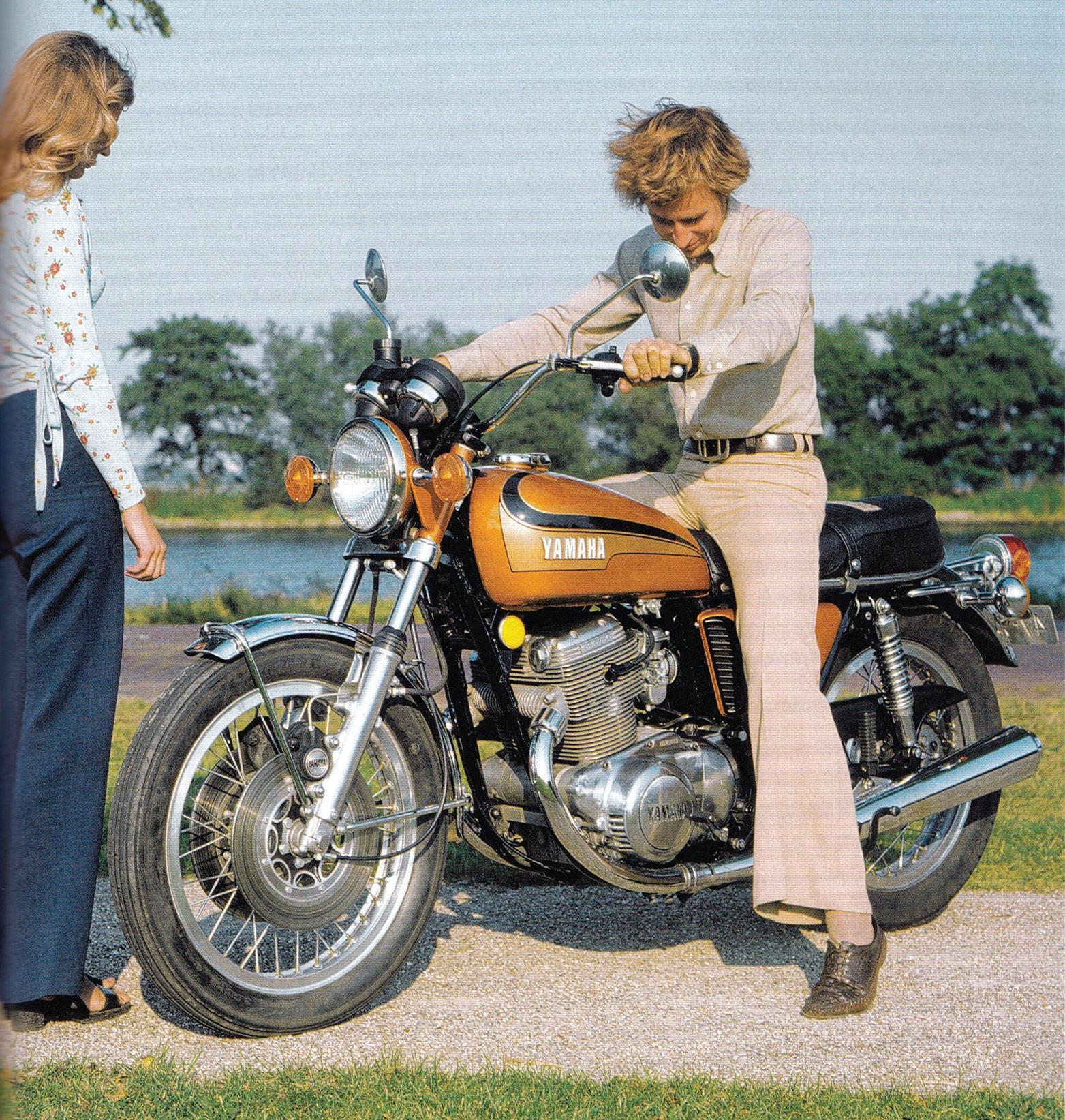
That lack of vibration was almost uncanny. For a start, it sounded really great, and I’ll admit to using the gearbox
just a little more enthusiastically than absolutely necessary while carving curves through the Delaware River Valley. Not only was there heaps more grunt on the TX750 compared to the XS650, but the torque curve is much flatter, too, so it’s really forgiving in terms of which gear you throw at it. This is just as well, as the onedown four-up gearshift is quite notchy and not so pleasant to use — I didn’t miss more than a couple of shifts in my total of 220-plus miles on the Yamaha, but it’s by no means a smooth shift action, and you need to use the clutch for the bottom two upshifts. Plus the clutch is pretty heavy — you’ll want to use the wide spread of torque for town work and cut down on changing gear, to stop your left hand cramping up unduly. Oh, and neutral is impossible to find at rest — you have to select it while still on the move coming up to a set of lights.
But that smooth operator of an engine will pull cleanly away from little more than idle speed. From 2,000rpm upwards, it pulls hard and strong wide open to the 7,000rpm mark where I shifted gear, 500 revs below the point at which peak power of 63 horsepower is delivered. Even at higher revs there’s no undue
vibration, just that low down thrum from the exhaust becomes a higher-pitched howl. Like I say, it’s a great-sounding bike, and long-legged, too — at 60mph it ran at 3,500rpm, rising to just 4,200 revs at 70mph, and 5,000rpm at 80mph. No wonder its previous owner Joel acquired the bike from liked to use it for touring, especially with zero vibes.
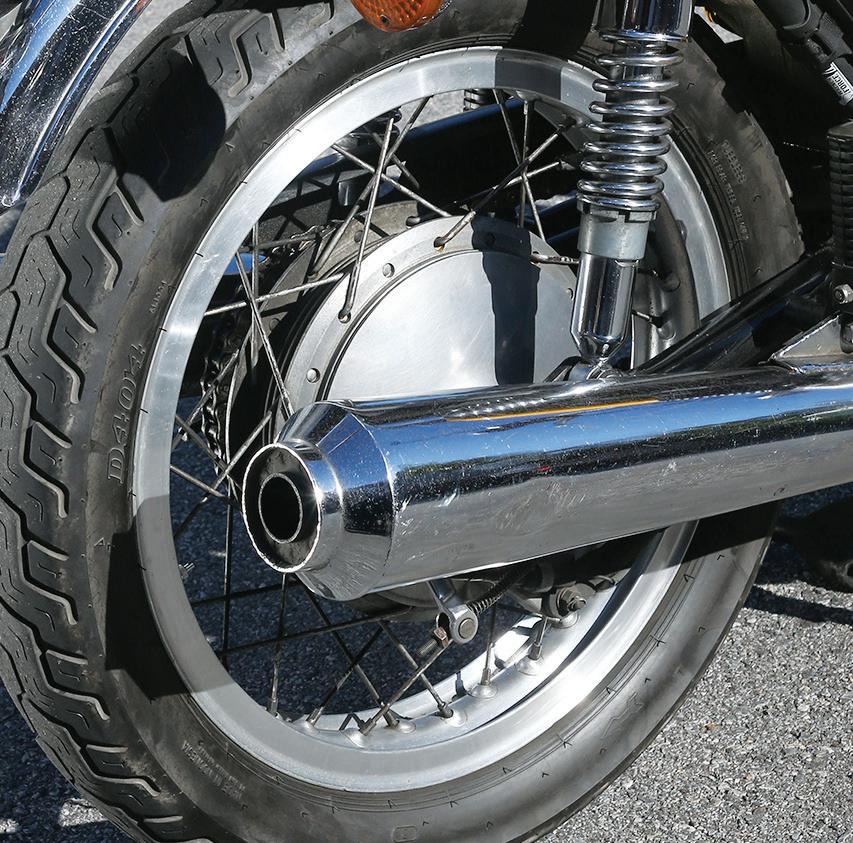
The TX750’s duplex cradle chassis comes close to rivalling the Featherbed frame it’s copied from in terms of rocksolid stability, but it does feel lighter than a Norton Manx in the way it steers, and those Dunlop tires Joel has fitted really suit the bike — especially on the DIDmade Borrani-style ridged aluminium rims, which add to the sense of lightness. So you can use lots of lean angle to keep up turn speed, and even with no steering damper fitted the Yamaha didn’t shake its head if I hit a bump cranked well over, with the fork doing its job of eating up the road rash. Furthermore, the ease and stability with which the TX750 flicked from side to side through a series of third-gear bends showed that Yamaha got the steering geometry right, with a 27-degree rake and 99mm of trail for the 36mm telescopic fork delivering

wheel (matched to an 18-inch rear). Joel had obviously been experimenting with fork oil because he had just enough dive dialled in to make you know you’re stopping, without sacrificing the ability to eat up bumps — I presume it’s a Showa fork since Yamaha owned them back then, and it works pretty well for such an elderly item. “The stock fork is actually pretty decent,” agreed Joel, “but we’ve improved it with shimmed springs to stiffen things up a tad, and more viscous oil to keep dampening in control.” He’d also fitted a pair of Hagon shocks at the rear, and despite the restricted 80mm of wheel travel, in terms of Classic-era rear suspension they don’t come better than these.
Perhaps inevitably, the Japanese brakes fitted to the Yamaha I rode aren’t in the same league as the fork, though the reason isn’t hard to find, because




up front there was just a single 300mm stainless steel disc gripped by a wimpy single-piston caliper, with a 180mm single leading-shoe rear drum. With the TX750 clocking in at a porky 518 pounds split 45/55 percent, a single front disc is quite insufficient for spirited riding, and indeed the left-hand fork leg already has the mounting boss for a brake caliper. That’s because for European markets the bike came with doubled-up front discs, with Japan and the U.S. only getting a single one — making Yamaha’s decision not to test engine performance in Europe all the stranger, if they already knew they had to provide extra braking capacity for Euro-riding.
Stopping was the one thing the Retro Tours TX750 didn’t do very well, either from high speed in the dry or the wet, when the disc/pad combo proved as inadequate in stopping the device as I
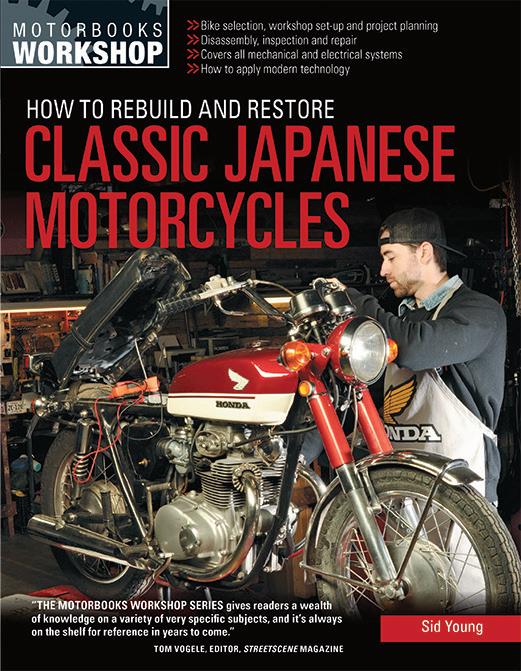
remember my year-old Suzuki GT750’s had been in early-‘70s U.K. rain, after Heron Suzuki recalled it to substitute a single front disc for the drum brake it had been supplied with! Not ideal.
But correctly set up and well maintained, the TX750’s Omni-Phase Balancer really works, and in so doing has civilized what’s potentially the worst of twowheeled shakers — a rigidly-mounted 750cc 4-stroke parallel-twin, with a twoup 360-degree crank. No wonder other manufacturers quickly began to develop balancer systems of their own — but Yamaha was first, with this nowadays little-known model, whose rarity probably derives from the likelihood that most of the 33,441 examples made blew up, and were then scrapped.
What an unexpectedly nice bike — but what a shame it took Yamaha two goes to get it right! MC
Whether you want to correctly restore a classic Japanese motorcycle or create a modified custom build, you need the correct information about performing the mechanical and cosmetic tasks required to get an old, frequently neglected, and often long-unridden machine back in working order. How to Rebuild and Restore Classic Japanese Motorcycles is your complete, hands-on manual, covering all the mechanical subsystems that make up a motorcycle. From finding a bike to planning your project to dealing with each mechanical system, How to Rebuild and Restore Classic Japanese Motorcycles includes everything you need to know to get your classic back on the road. Japanese motorcycles have been the best-selling bikes globally since the mid-1960s, driven by the “Big Four” Honda, Yamaha, Suzuki, and Kawasaki. This is the perfect book for anyone interested in classic Japanese motorcycles and prepping a bike to build a café racer, street tracker, or other custom build. This title is available at store.MotorcycleClassics.com or by calling 800-8807567. Mention promo code: MMCPANZ5. Item #10936.
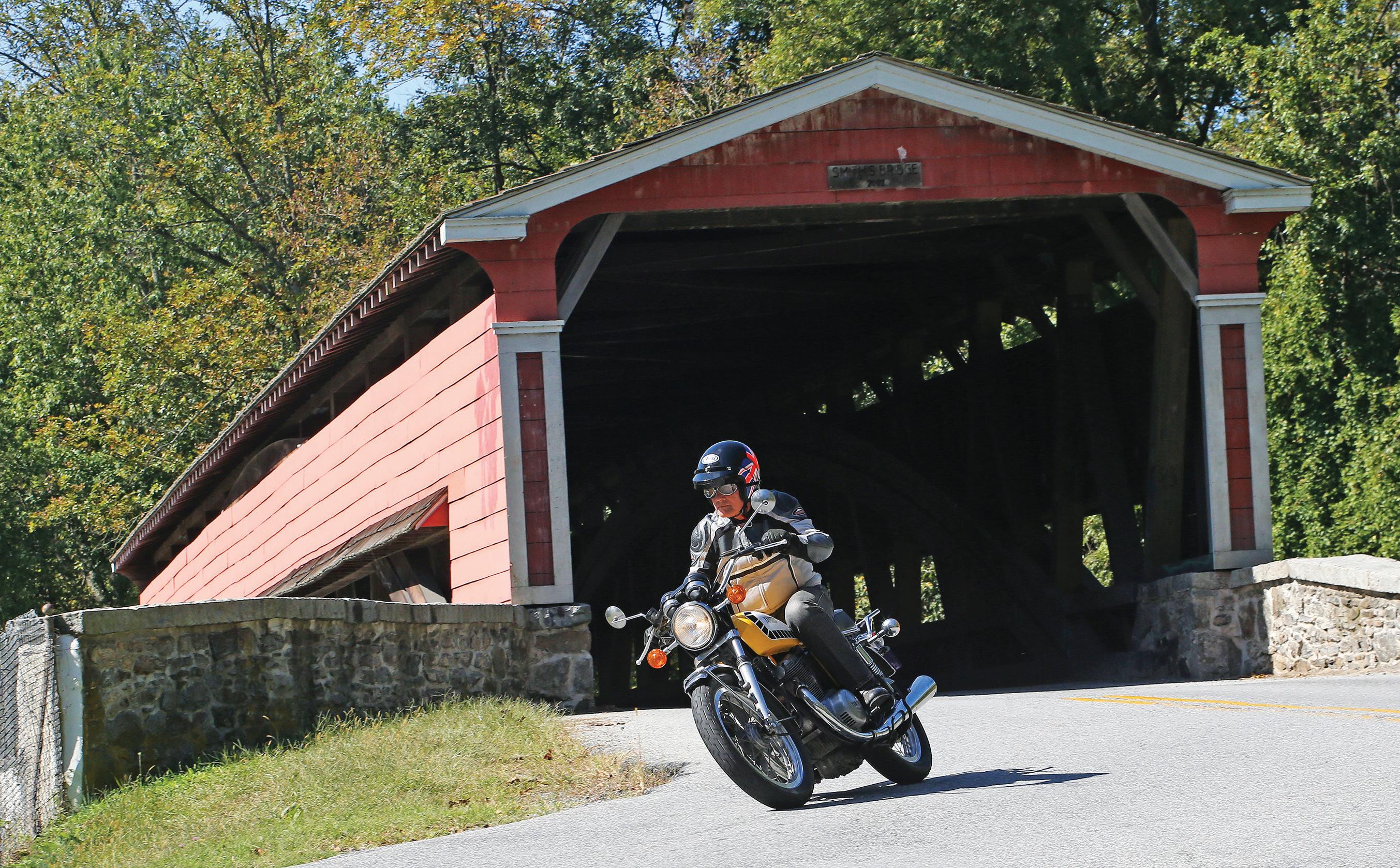




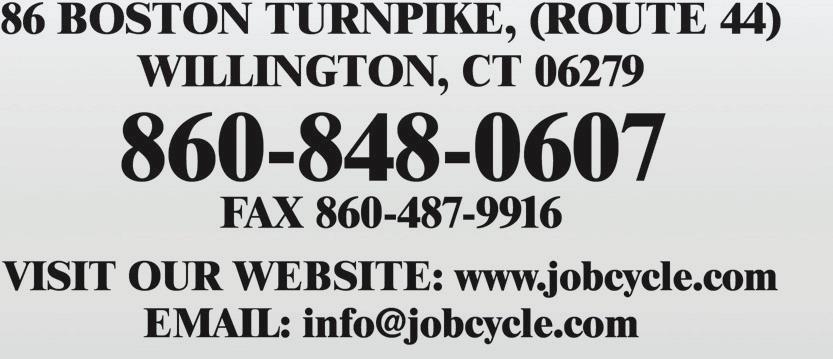


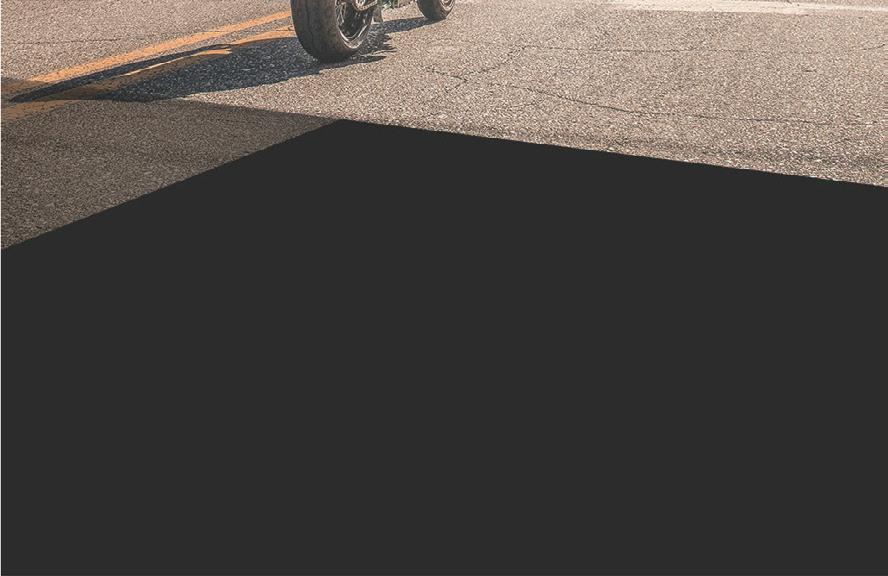

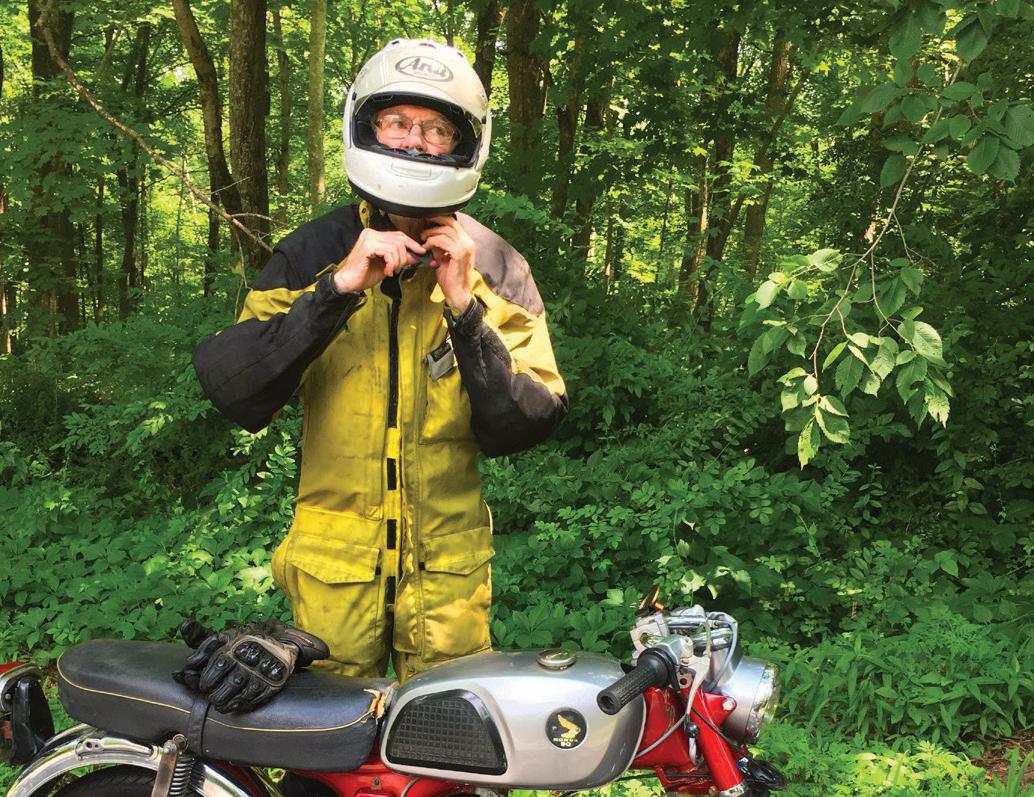





The best place to start any project is at the beginning, so let’s kick-start this review of veteran photographer and moto-journalist David Dewhurst’s new book Motocross The Golden Era with Chapter 1’s opening sentence: “Almost 100 years ago, on a grassy hillside near Camberley in Surrey, England, what we know today as motocross was born.” What follows in Dewhurst’s lead chapter is a 20-page (of 480 total pages) recap on how motocross racing grew to be one of the most popular forms of motorsport competition on our planet.
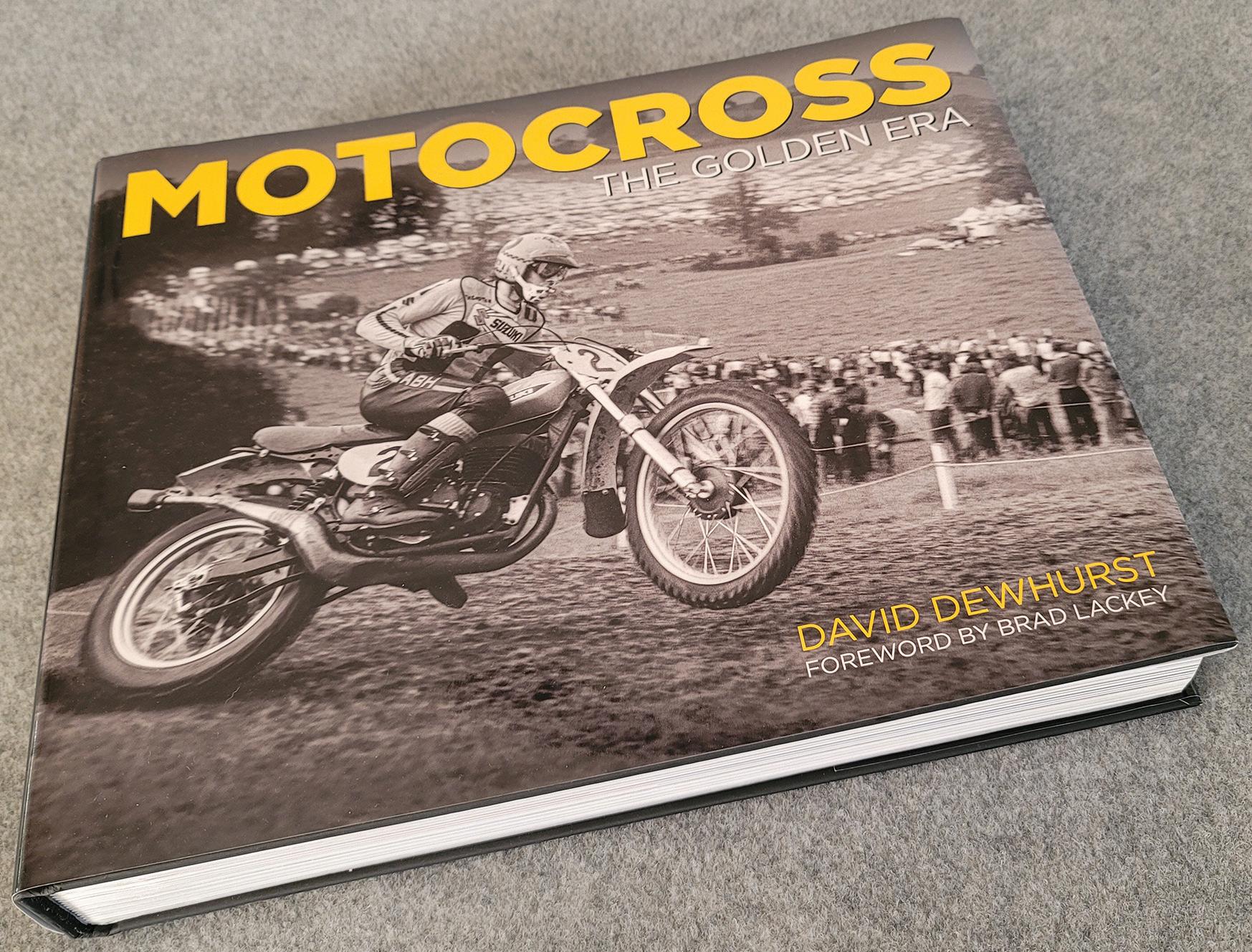
But Dewhurst (an expatriated Englishman who competed in motocross racing in England before moving to America with wife Anne in 1980 to join America’s motorcycle magazine press corps) doesn’t sugarcoat any of the sport’s early history. He reminds us that the sport was originally termed Scrambles, and that most early scrambles bikes were simply road bikes piloted by riders who ventured onto those rutty scrambles courses because they wanted to compete and … win! Golden Era readers are also reminded that, in the beginning, Husqvarna really wasn’t interested in selling off-road motorcycles at all, or even competing against other brands for market shares. Instead, selling everyday commodities such as chain saws, cooking stoves, rifles and sewing machines spurred the Swedish company’s business acumen during the early part of the 20th Century.

Yet, by the early 1960s two things became apparent, even common knowledge: Scrambles had simultaneously morphed in name and in the manner of its racing into Motocross, and Husqvarna had a lock on the competition. Other makers of 2-stroke MX bikes shared the limelight with Husky, among them Greeves, CZ, Jawa and Maico to name a few. The Golden Era of Motocross was born, soon to be joined by Supercross, a similar form of
racing that marched into the Los Angeles Coliseum in 1972 when a wild and somewhat reckless promoter named Mike Goodwin realized that a gladiator persona among the racers would be just the thing to bring even more people trackside to feast their eyes up close on famous riders named Gary Jones, Brad Lackey, Jim Weinert and others.
Indeed, Motocross The Golden Era was written with that same basic goal — to put readers up close and personal with those early heroes who helped make Motocross and Supercross the popular forms of motorsport competition that they are today.
Packed within 480 pages of the large coffee-table book format are 600 images devoted to Motocross and Supercross racing. Many of the photos (most taken by Dewhurst over the years, some gathered from other photographers of the era, still others culled from personal photo collections) fill the book’s 12 1/4-inch x 10
In addition to insightful interviews of riders, team managers, engineers and other key players, Dewhurst places some of racing’s storied motorcycles in front of readers. And let’s not overlook that age-old topic: MX vs. SX!
1/4-inch pages with life. Color and black and white images compose the mix, all presented in clean layouts for an up-close and personal feel. My favorite photo: Page 275 showing a spirited Hakan Carlqvist seemingly leaping off a cliff and onto the distant racecourse far below. Thank goodness for long-travel suspension, and for the record practically every photo in the book has a purpose and meaningful impact on the story that it supports.
As expected, a majority of interviews focus on racers (Chapter 2 starts with a bang, featuring The Man, Roger DeCoster). However, later chapters also focus on insiders such as team managers, promoters, sponsors, engineers, plus up-close looks at some of the key bikes that helped form the era. Most of all, though, readers are treated to more than “this is how I won that race” tales by the featured celebrity racers. Dewhurst dug deeper than that.

Among my favorite rider chapters was that of Bob “Hurricane” Hannah, who always gave us reporters from that era colorful quotes to put in our race reports. Oddly, though, the takeaway quote from Hannah’s chapter was from an insightful David Bailey about Hannah, and it deserves repeating here: “He [Hannah] set the bar for all of us to follow. He lifted and carried the whole sport on his back for a while. He taught us how to be tough, how to interact with fans, how to train, how to win.” That’s top-shelf stuff, and a rather stoic reminder of how and why American motocross racers, starting in 1981, dominated the Motocross de Nations competition for 13 years straight during the Golden Era’s zenith.
But Motocross The Golden Era is more than a history about an unforgettable time because it addresses the core of how and why the racing panned out in America and Europe. Fittingly, Dewhurst goes full circle, returning to his English schoolboy roots for the final chapter that’s dedicated to Britain’s 500cc world champion David Thorpe. Then Dewhurst, perhaps influenced by a photographer’s background, closes out with a section simply labeled “Magic Moments,” a 30-plus page ensemble of truly remarkable and classic photos that showcase the Golden Era.
With a price tag of $199.99, the book ain’t cheap, but if you’re truly a fan of Motocross and/or Supercross, this book certainly is for you. You get more for your money, though, than a top-rate coffee table tome. Dewhurst has set up his website for readers to join in the conversation, or to purchase Golden Era merchandise and souvenirs. Foremost, he invites Golden Era readers to submit their comments, questions and other thoughts and ideas to a link for continued conversation. I suspect the truly enthusiastic readers might even share some of their own Golden Era experiences and memories. Who knows, some of those very comments might make it into future print; rumor has it that Dewhurst is already contemplating a followup book to Motocross The Golden Era. And you can bet that it, too, will be a golden read. — Dain Gingerelli
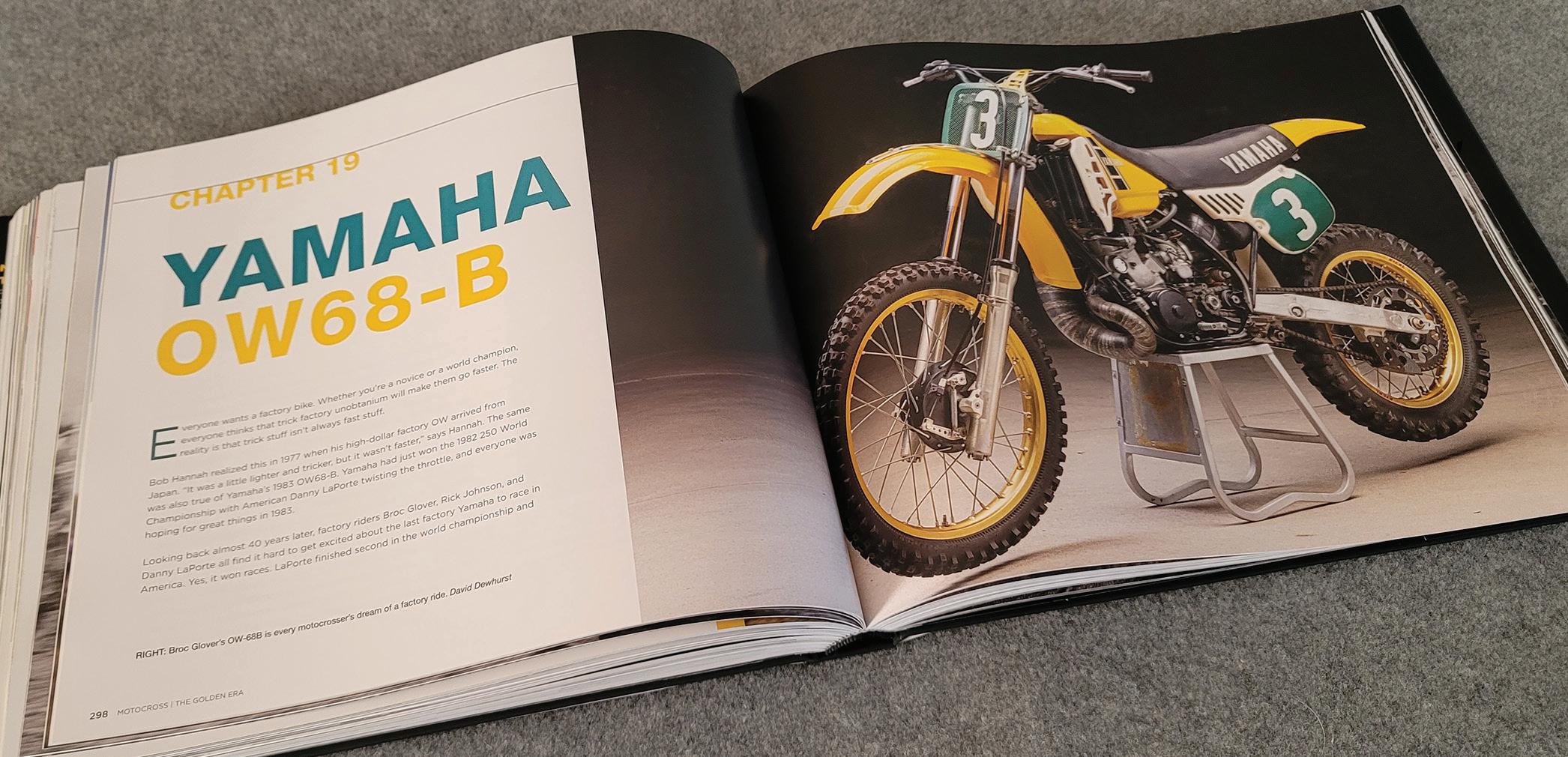
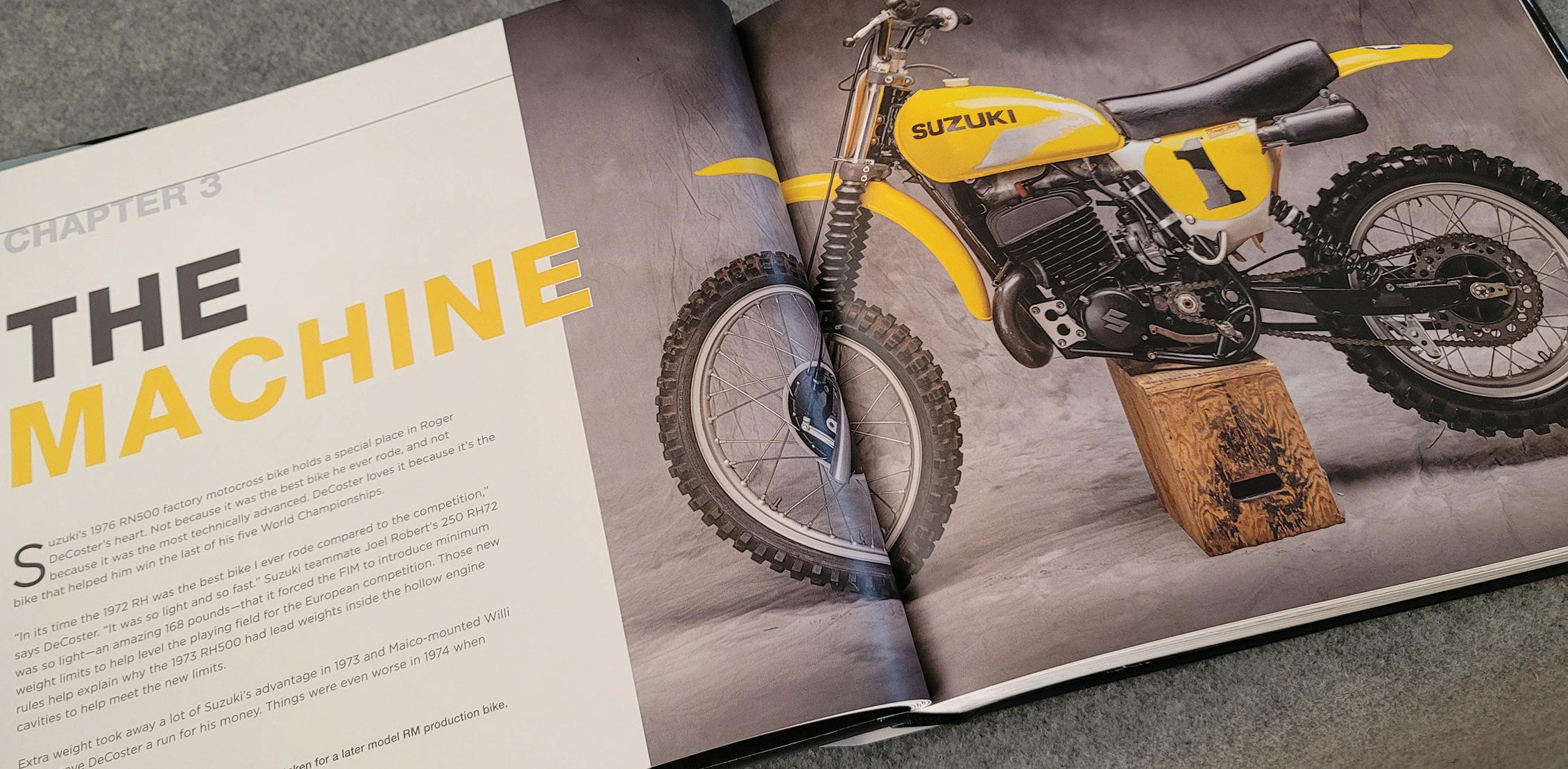
Our bike for this project is a 1971 Honda CB175. In previous issues we cleaned the carburetors and reinstalled them.
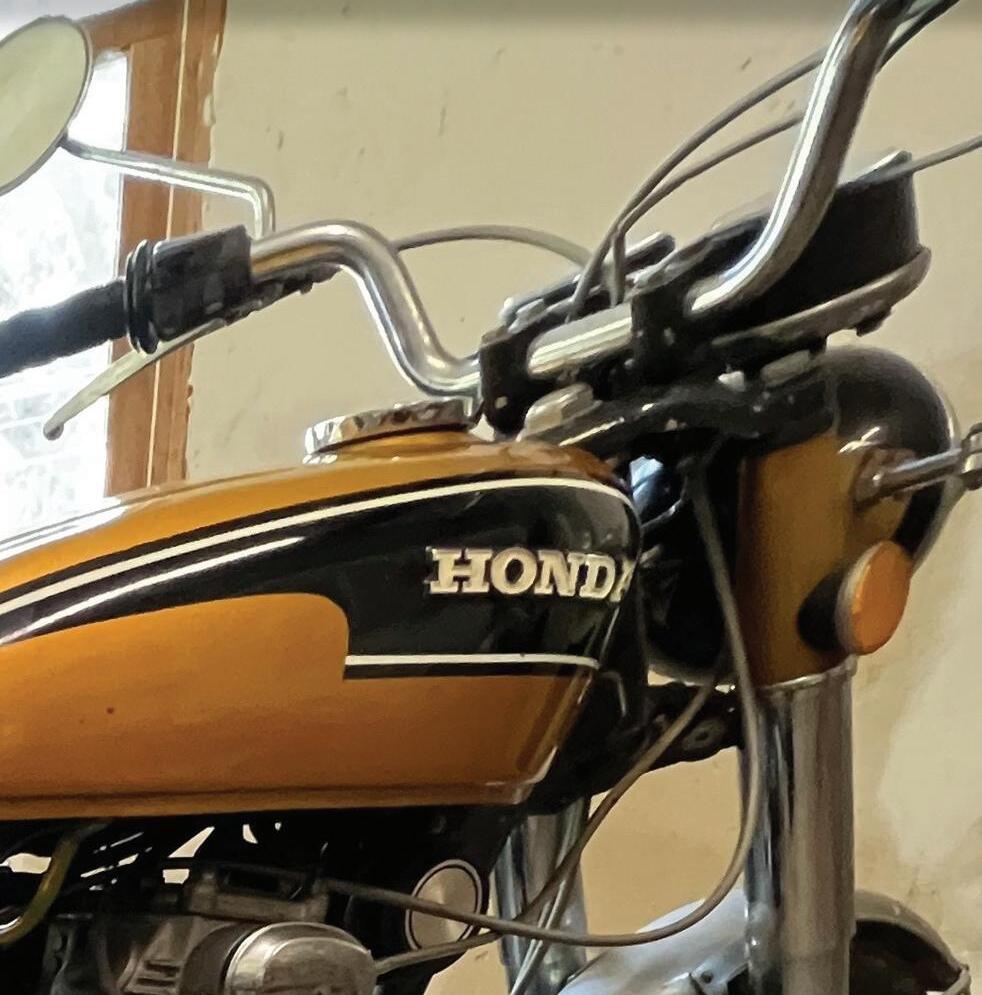
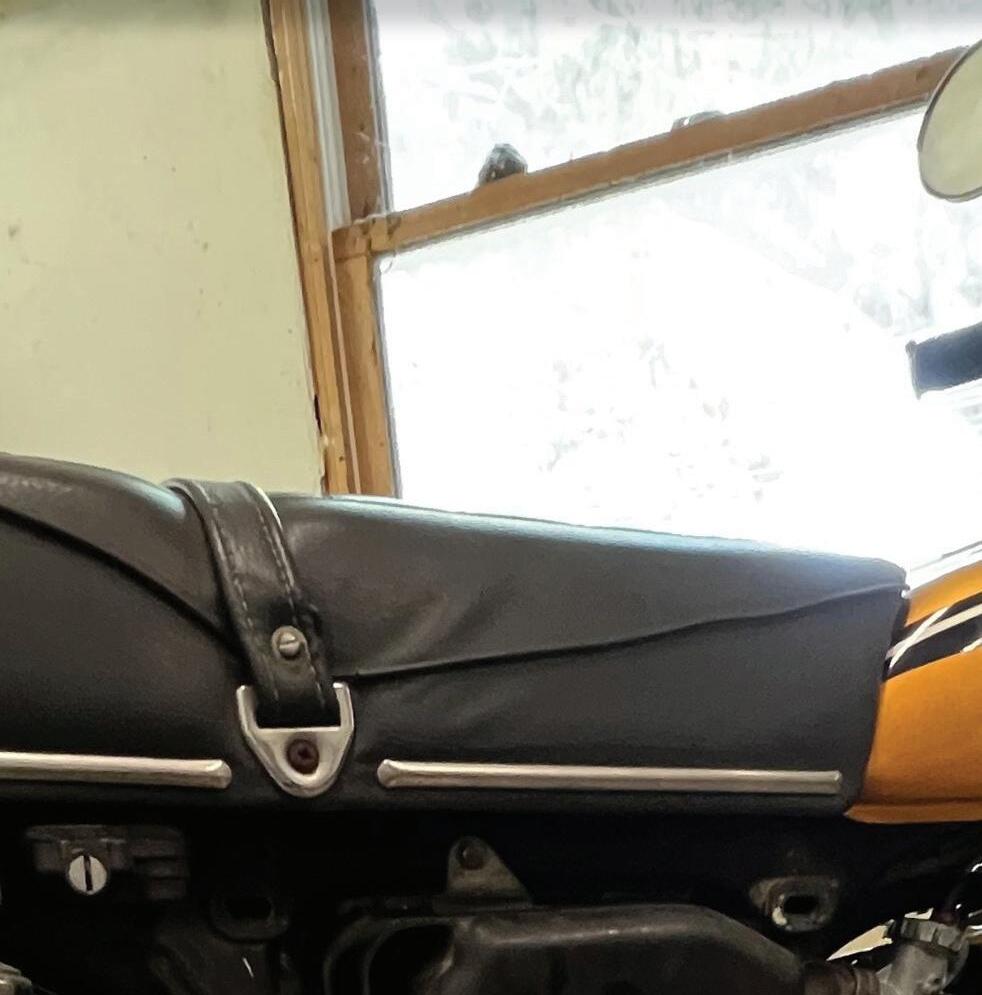
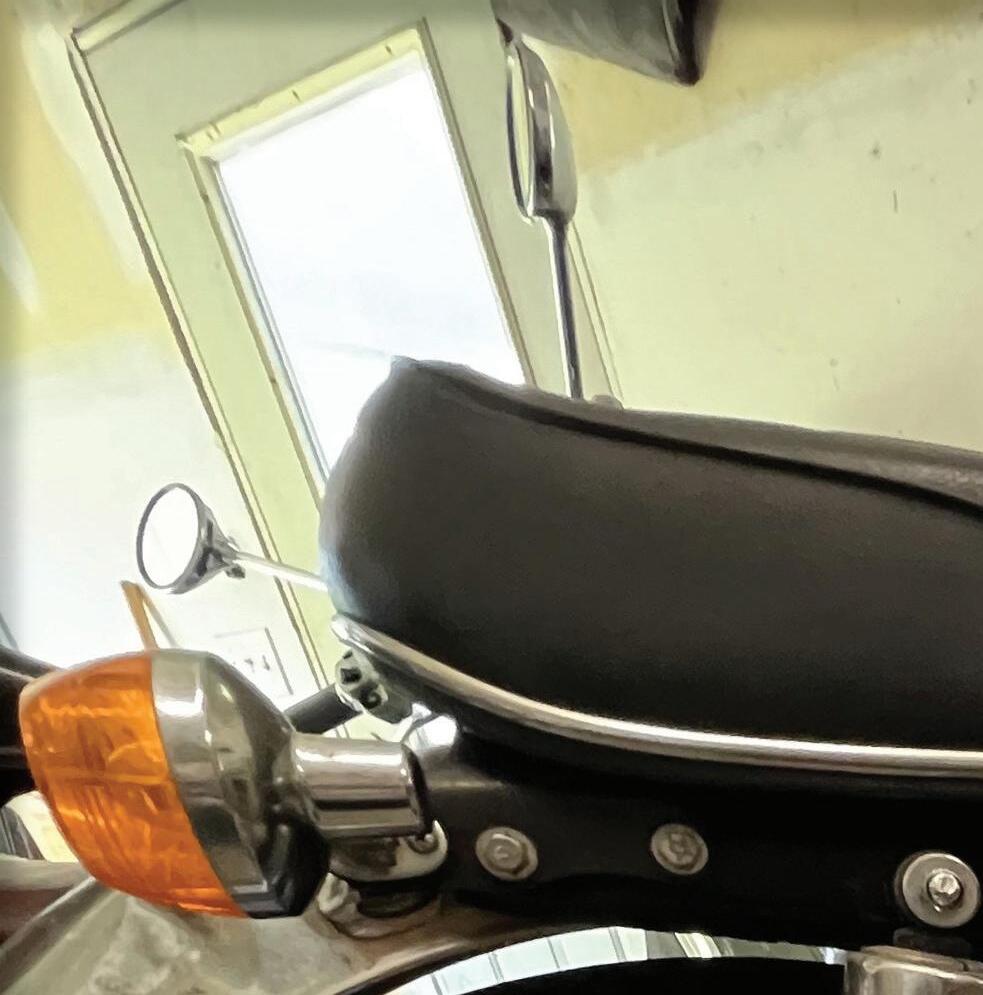
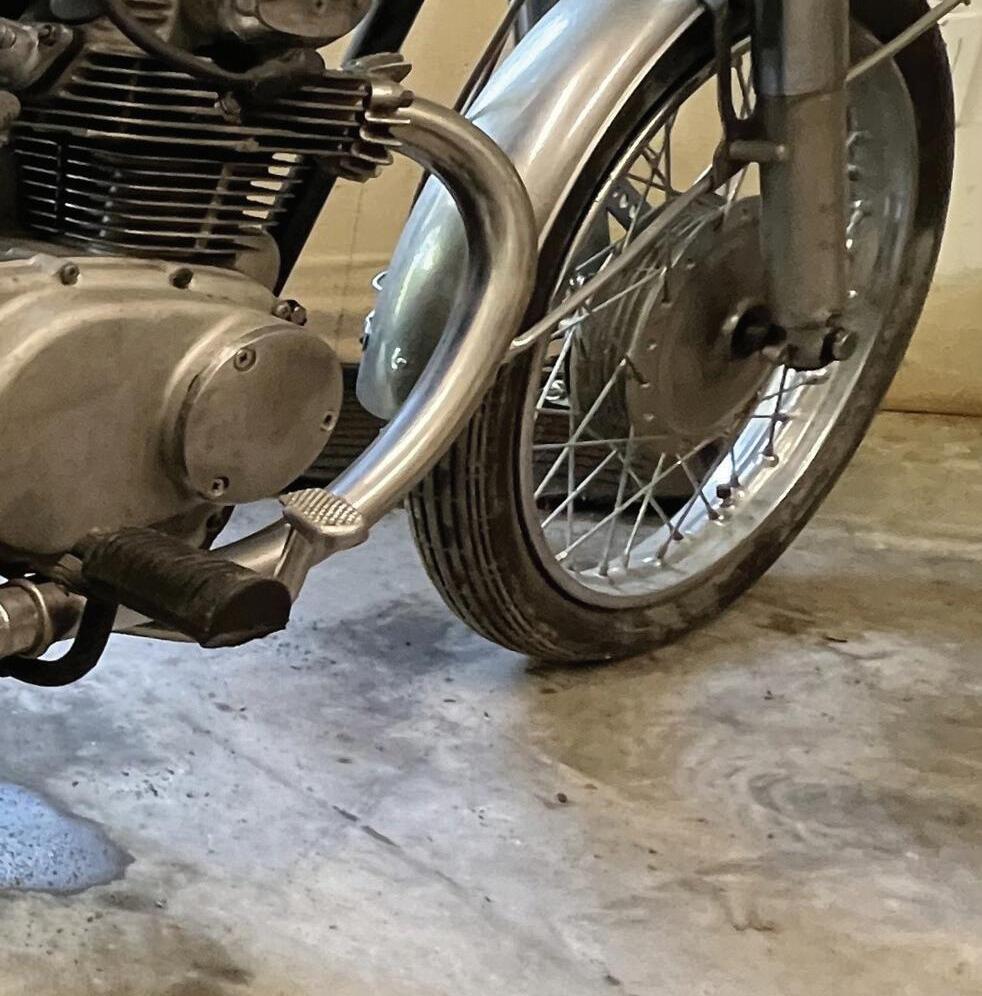
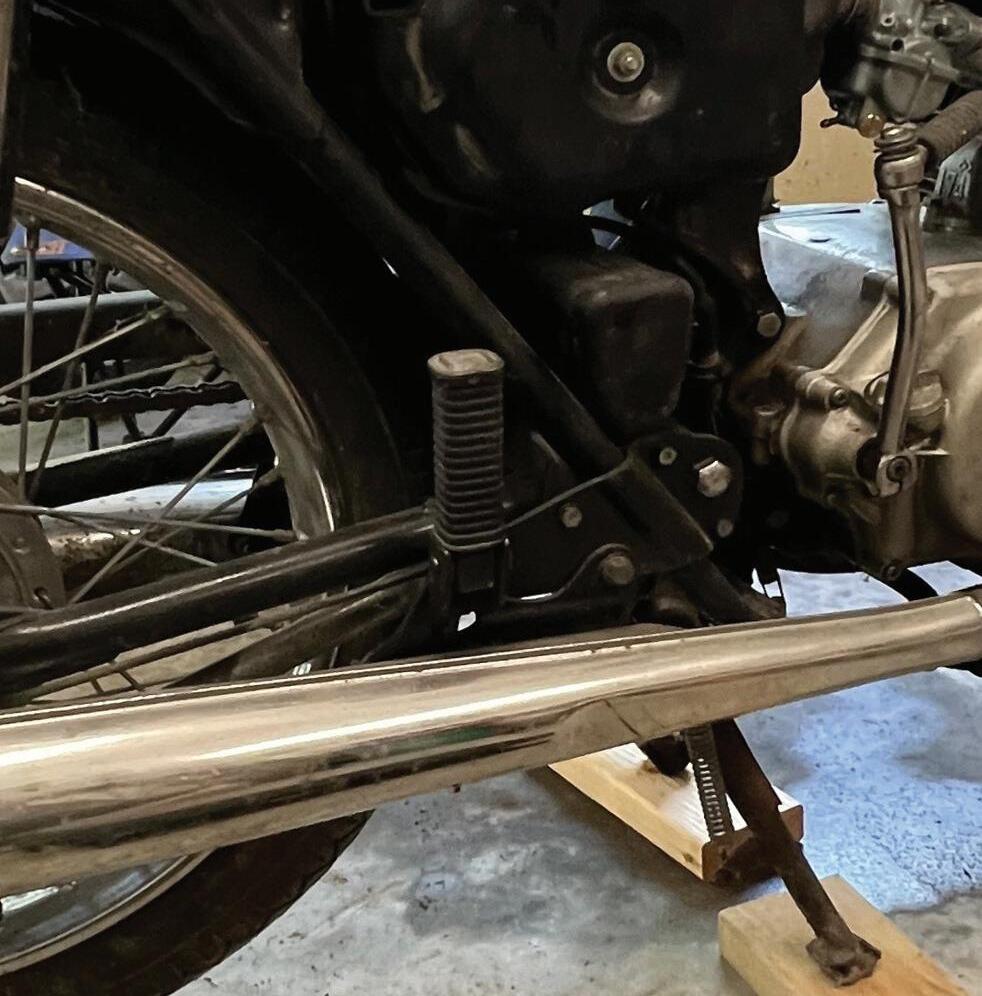
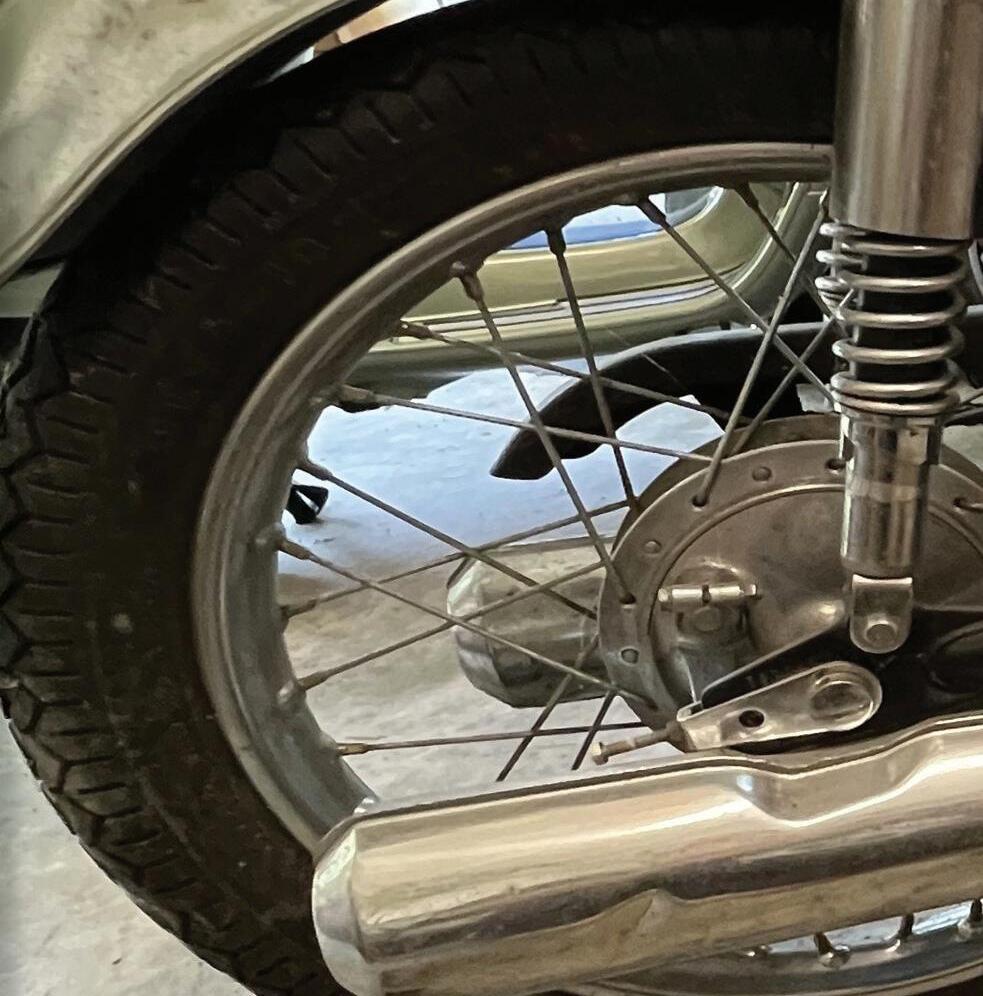
Well we’re down to the wire on the final installment of our Honda CB175 revival. This issue we will take a look at checking and cleaning the ignition points, followed by checking the engine timing and adjusting it if necessary. After that we’ll show you how we removed both wheels in anticipation of having the tires and tubes
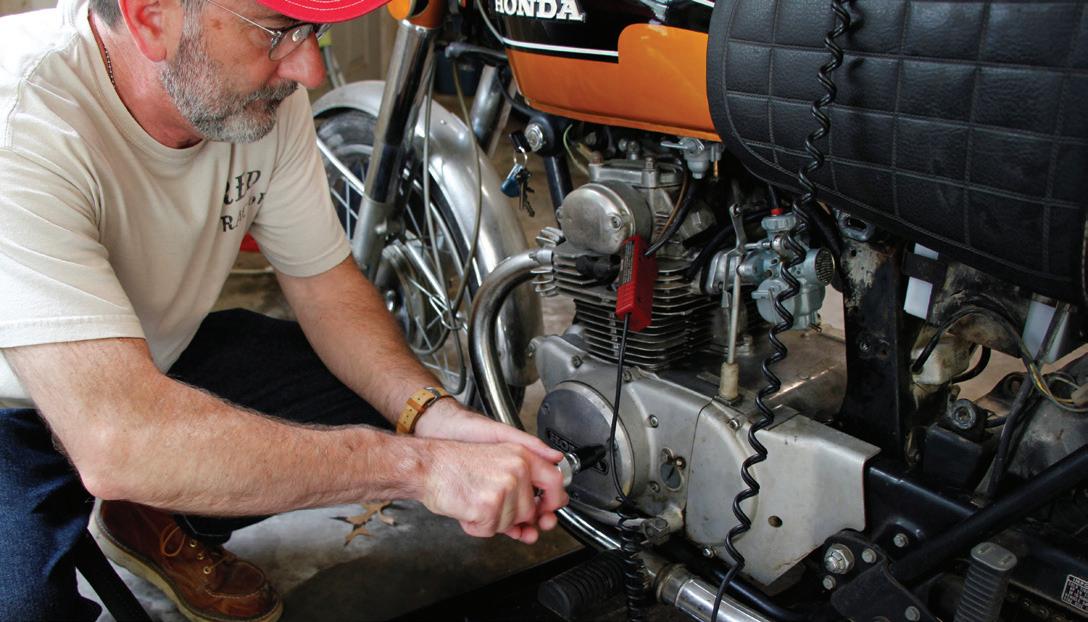
replaced. Once that’s done, we’ll install a new battery, double check our tire pressures, and reinstall the tank. After hooking up the carburetors and filling the tank with fuel, we should be ready for a road test. Let’s get started.
— Keith Fellenstein1 We start out by removing the alternator cover on the left side. We’re using our impact driver because the bits fit the cover screws better than the screwdrivers we had on hand. Have a tray underneath to catch any oil that flows out of the crankcase.
2Next we remove the points cover, also on the left side of the engine. Paper is abrasive without being too abrasive, so it’s always a good choice to clean up the points without changing the gap. If paper doesn’t do the job, you can always move on to a points file or emery cloth.
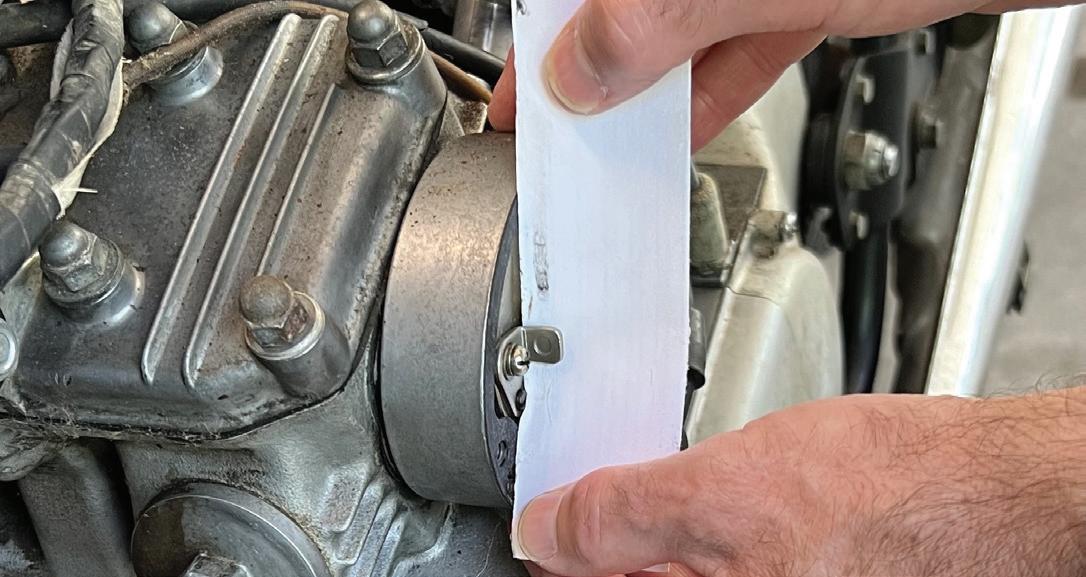
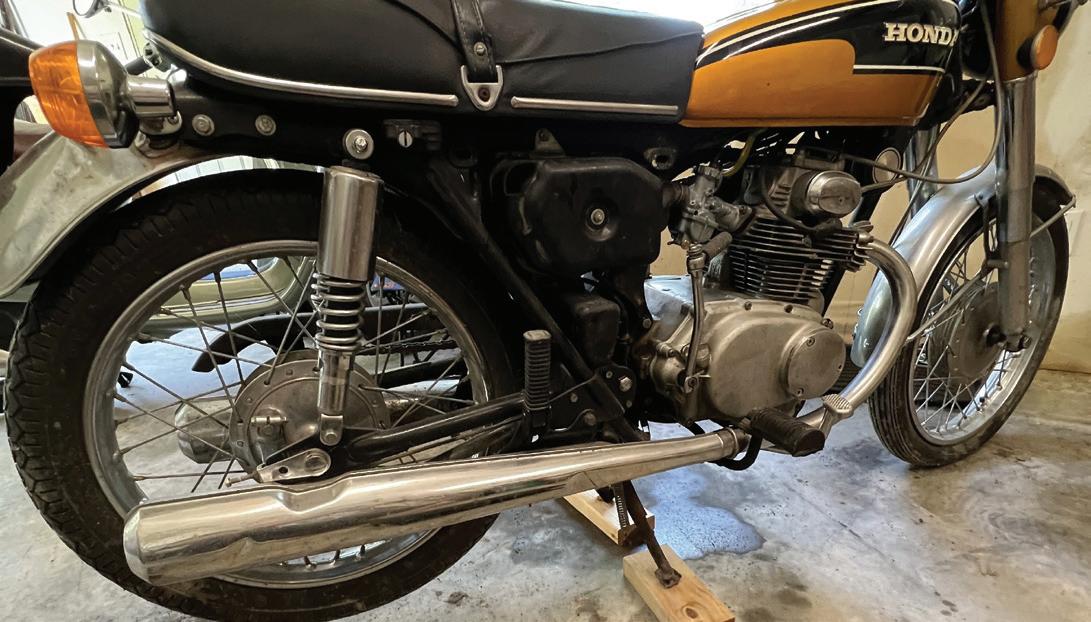
4
Once we have the points clean, it’s time to check the gap. The nominal gap is .016” and we’re using a spark plug wire gauge here, so our choices are .015” and .018”. I prefer using a wire gauge as it’s easier to feel the gap. In this case the .015” slides freely while the .018” won’t pass at all. So we’re close enough to .016”.
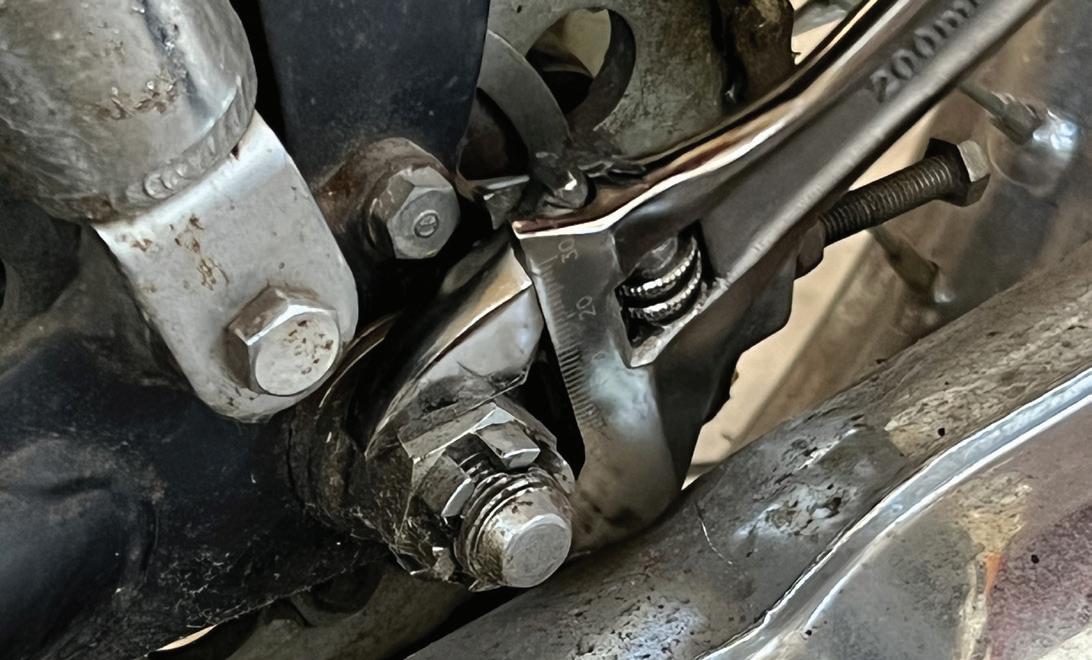
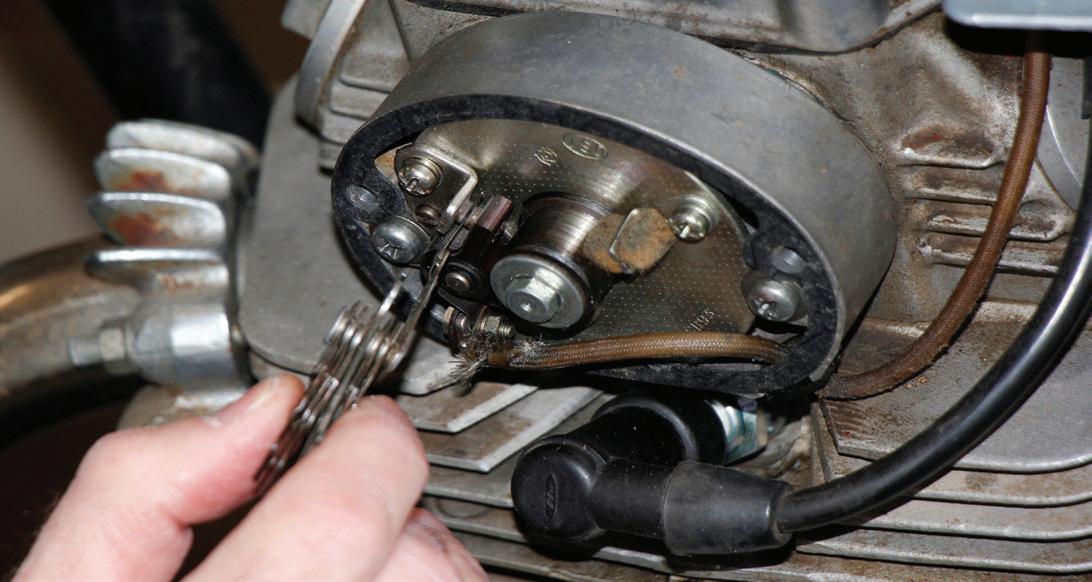
3
Now we can move to checking and adjusting the timing. I was going to use a Xenon timing light, but this 175 liked to sling oil for distance while running with the cover off, so the old school static timing light was used instead. This one is self powered, so we’re testing with the ignition off. Here you can see that we have arrived at the F mark where the points should be opening but the light is still on, so we have some adjusting to do.
5
In the last photo, the timing light was still on when the rotor mark F passed the index mark on the crankcase, so we needed to move the timing. Slightly loosening the 2 large phillips head screws in this picture allow you to move the points plate to adjust the timing. The cam rotates counter clockwise, so rotating the plate clockwise advances the timing, which is what we need here.
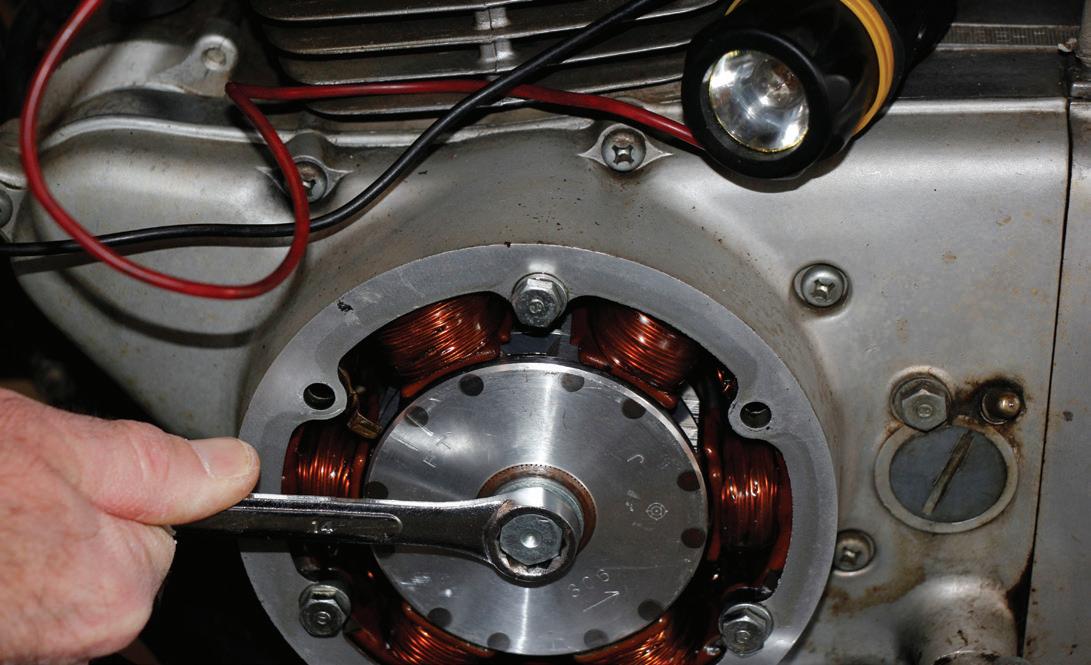
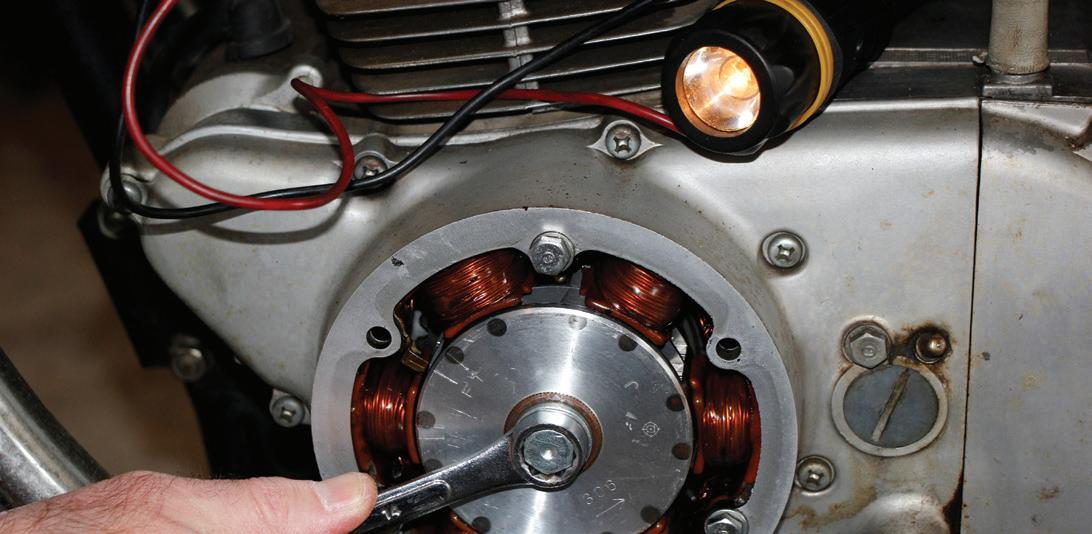
7 Now we’re on to changing the tires. Since we didn’t have a lift, we had to use the old method of raising the bike with a couple of 2 x 4s under the center stand. If you do this, find a way to lock the stand so the bike won’t roll off if you accidentally push it forward. I have a scar on my left forearm from learning that lesson the hard way when I was 15.
6
It’s a trial and error adjustment because tightening the screws can slightly change the timing. Be patient and your result will be as here, where the timing light goes out just as the rotor passes the index mark.
8 Straighten the bent legs of the cotter pin and remove it to allow you to remove the axle nut. Loosen and remove the axle nut. While not optimum, this adjustable wrench is just fine for the job if you’re careful. As always with an adjustable wrench, the movable jaw should face the direction of travel if possible.
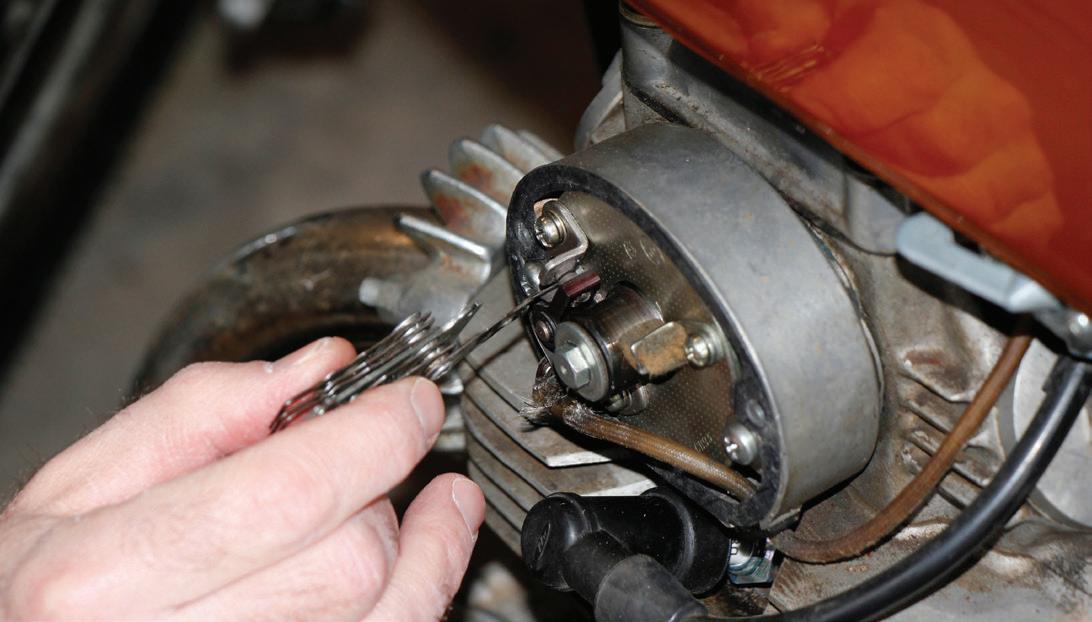
9
10
11
Loosen and remove the brake adjusting nut. Depressing the foot lever should allow you to disengage the brake rod from the brake lever on the wheel.
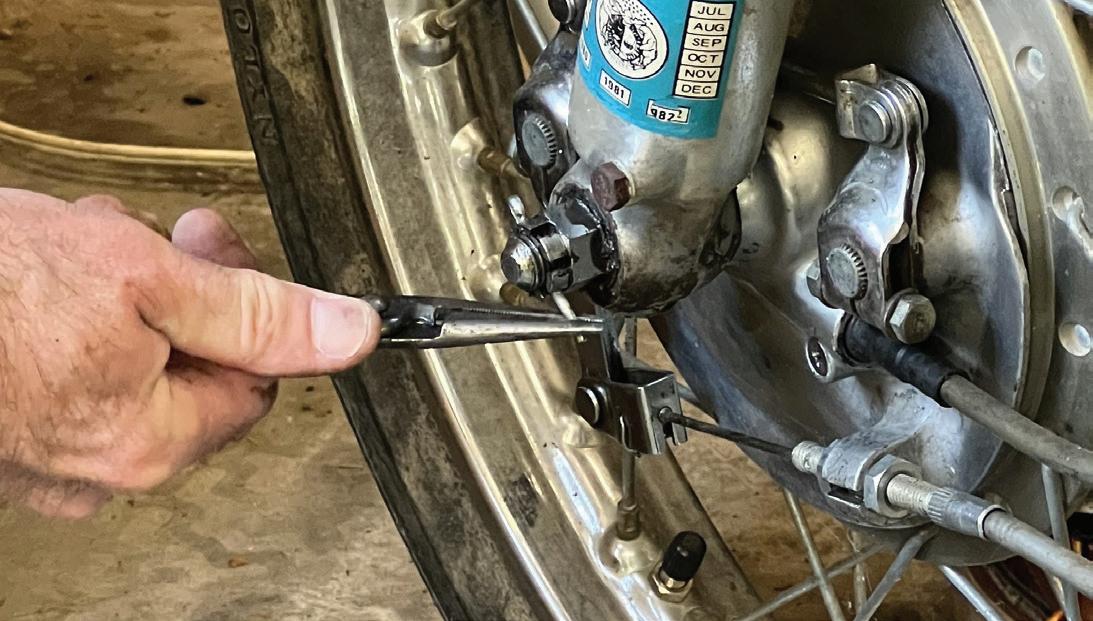
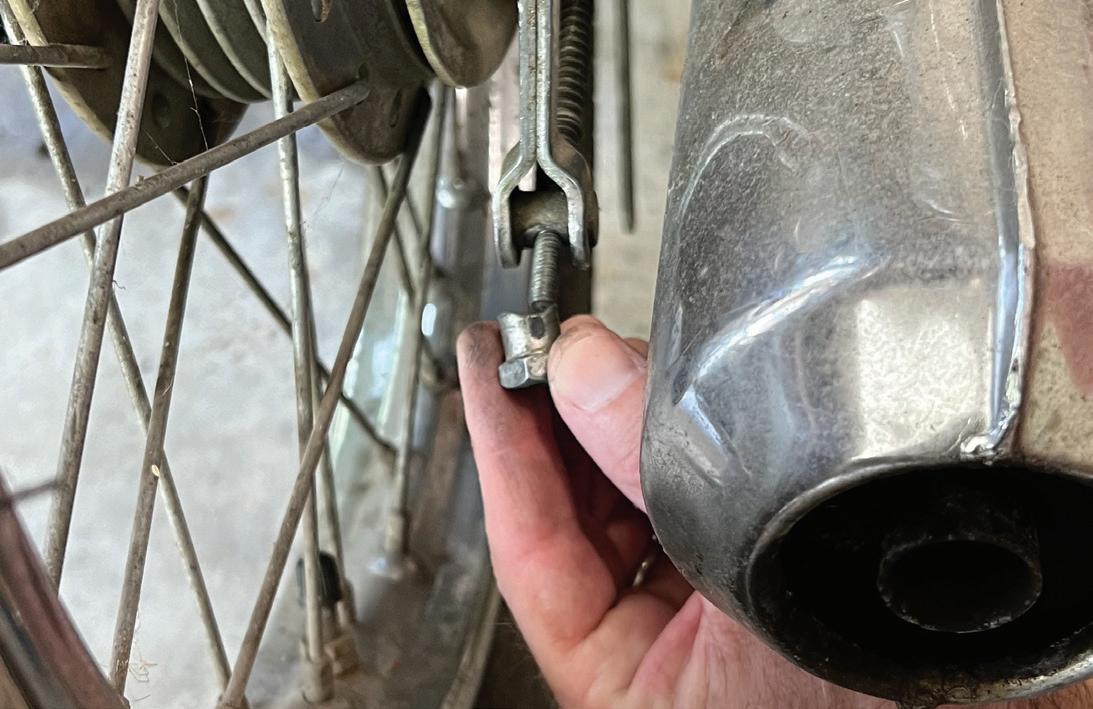
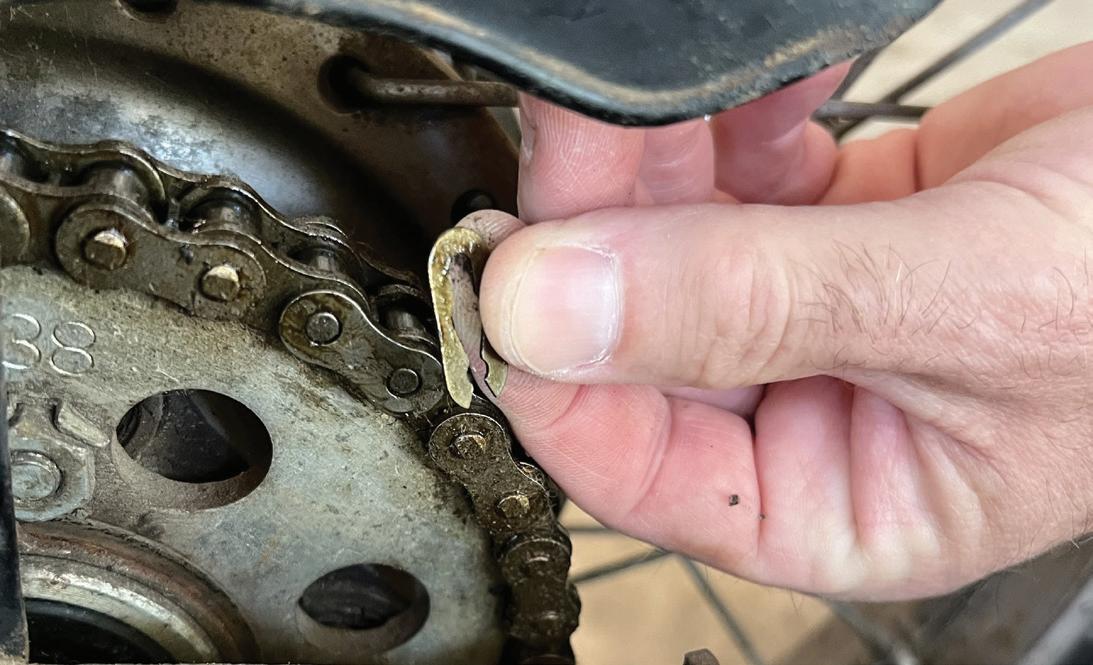
12Using a screwdriver in the through hole in the axle bolt for leverage, twist and pull the axle out of the wheel. Having a helper makes this much easier, but you can do it alone if needed.
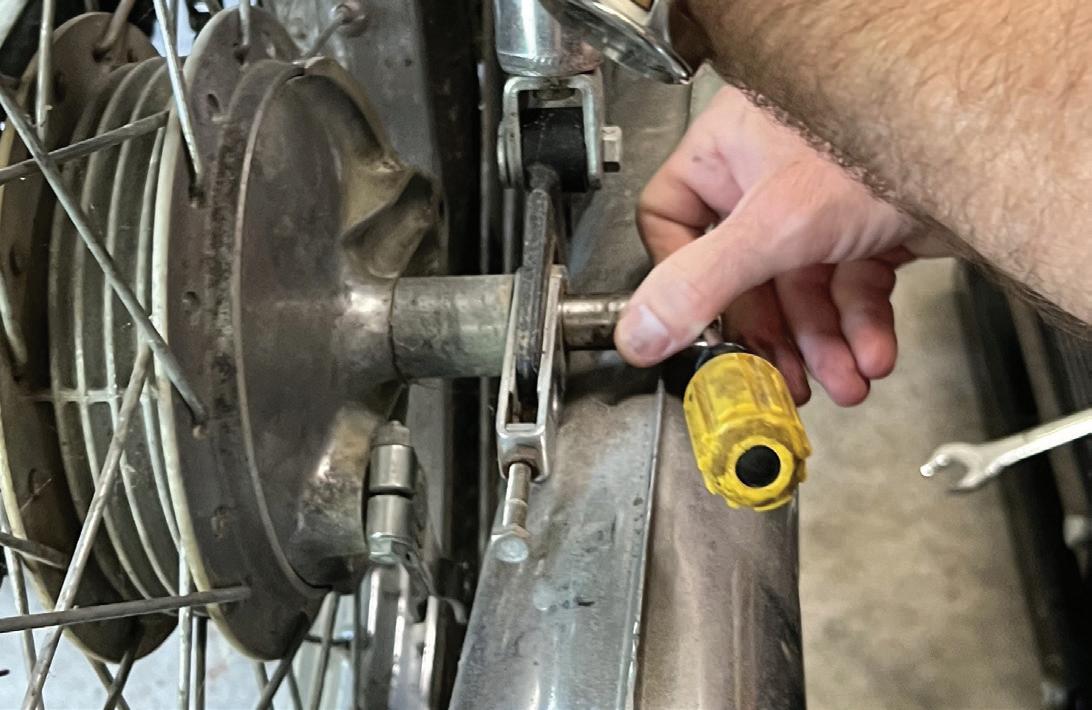
13
With a little careful maneuvering, you can free the rear wheel from the swingarm and fender.
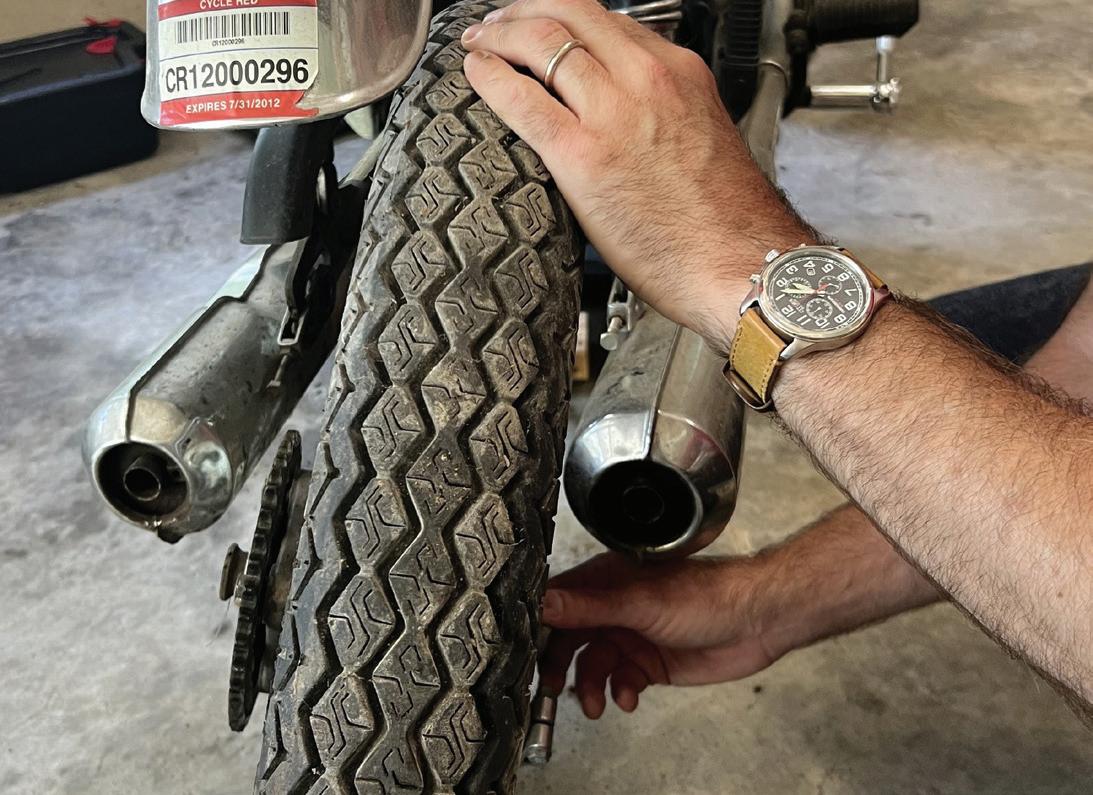
14 Moving to the front wheel, again you need to straighten and remove cotter pins, one holding the axle nut and the other keeping the brake cable in place. Not shown, the plate jack we are using to steady the bike so we can remove both wheels at once. Otherwise we’d be forced to take the wheels off one at a time.
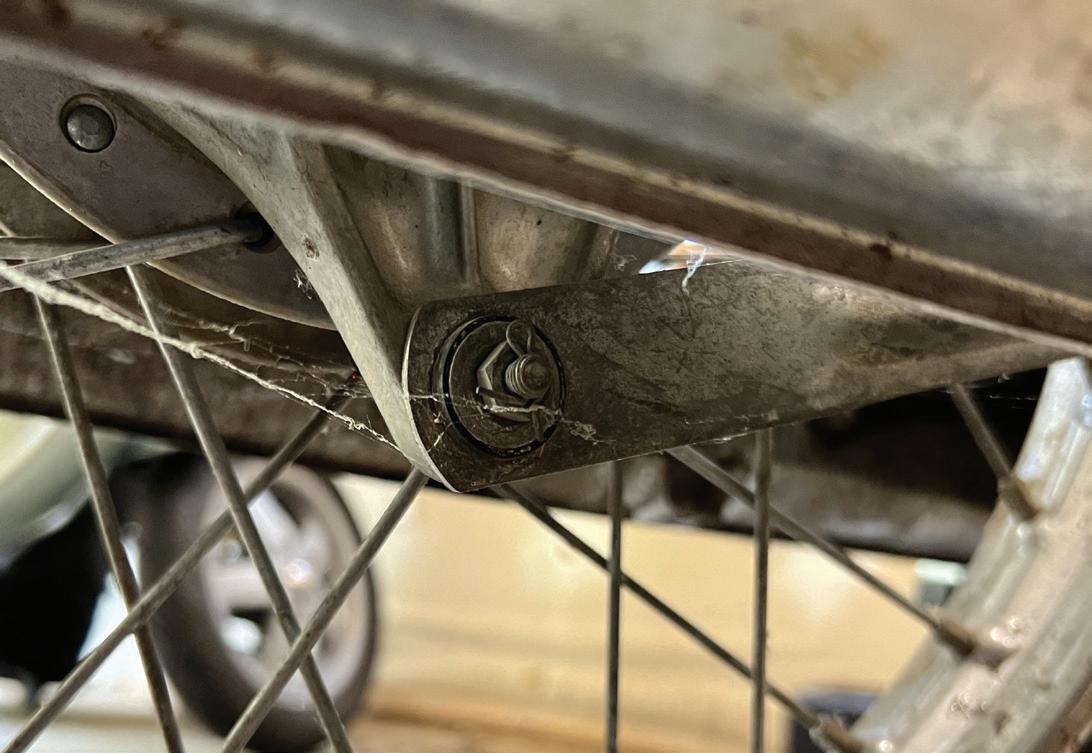
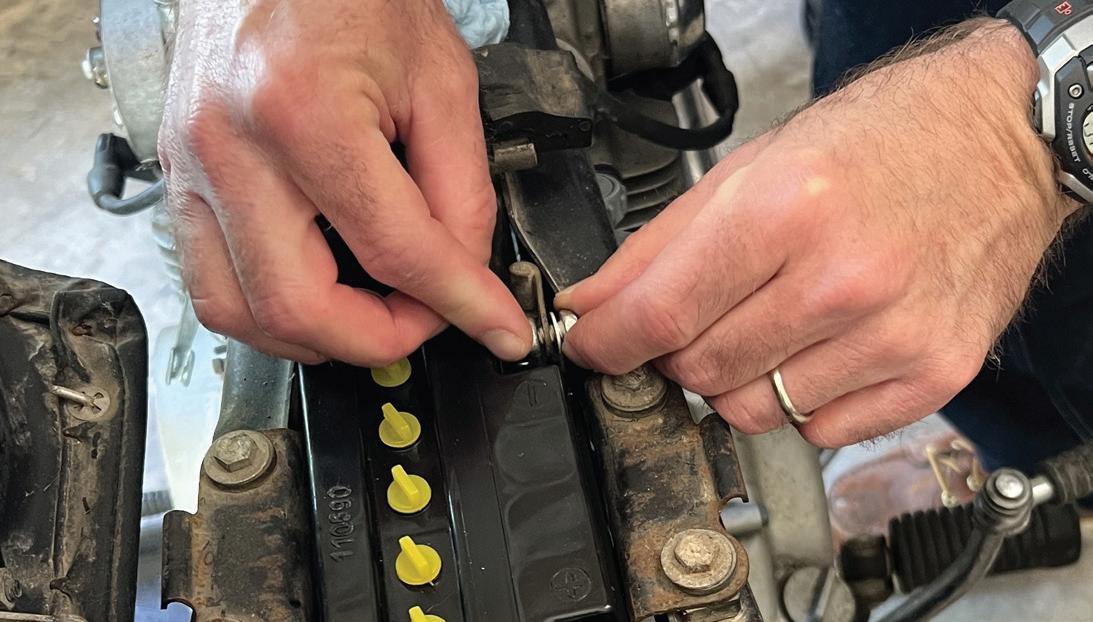
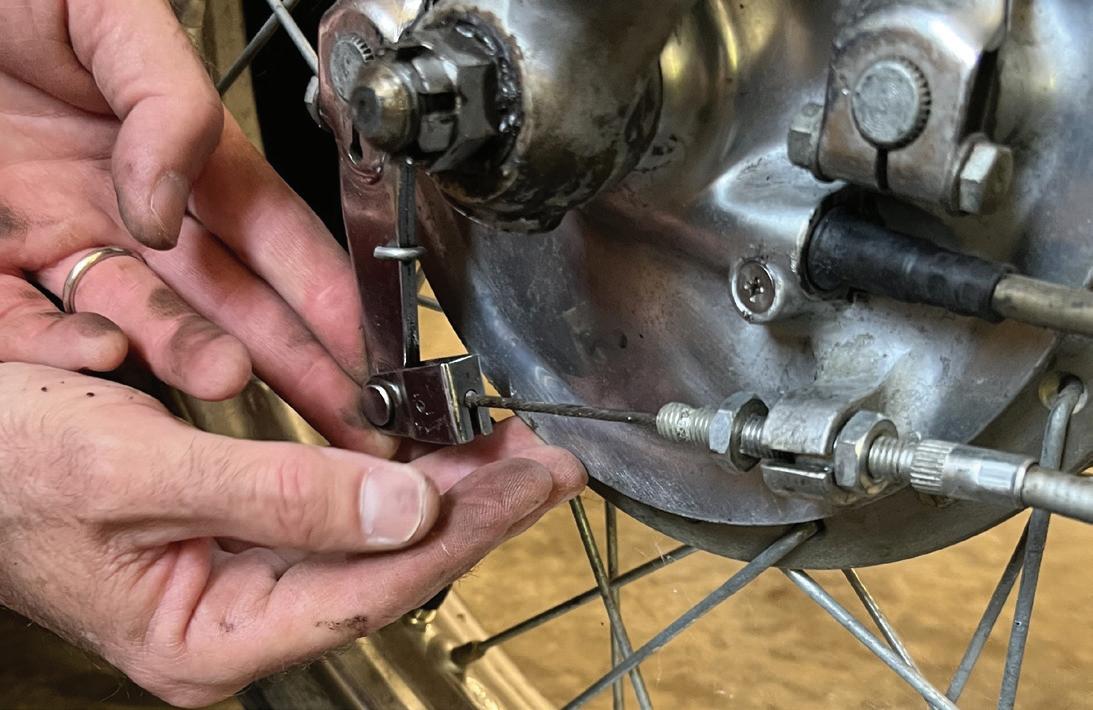
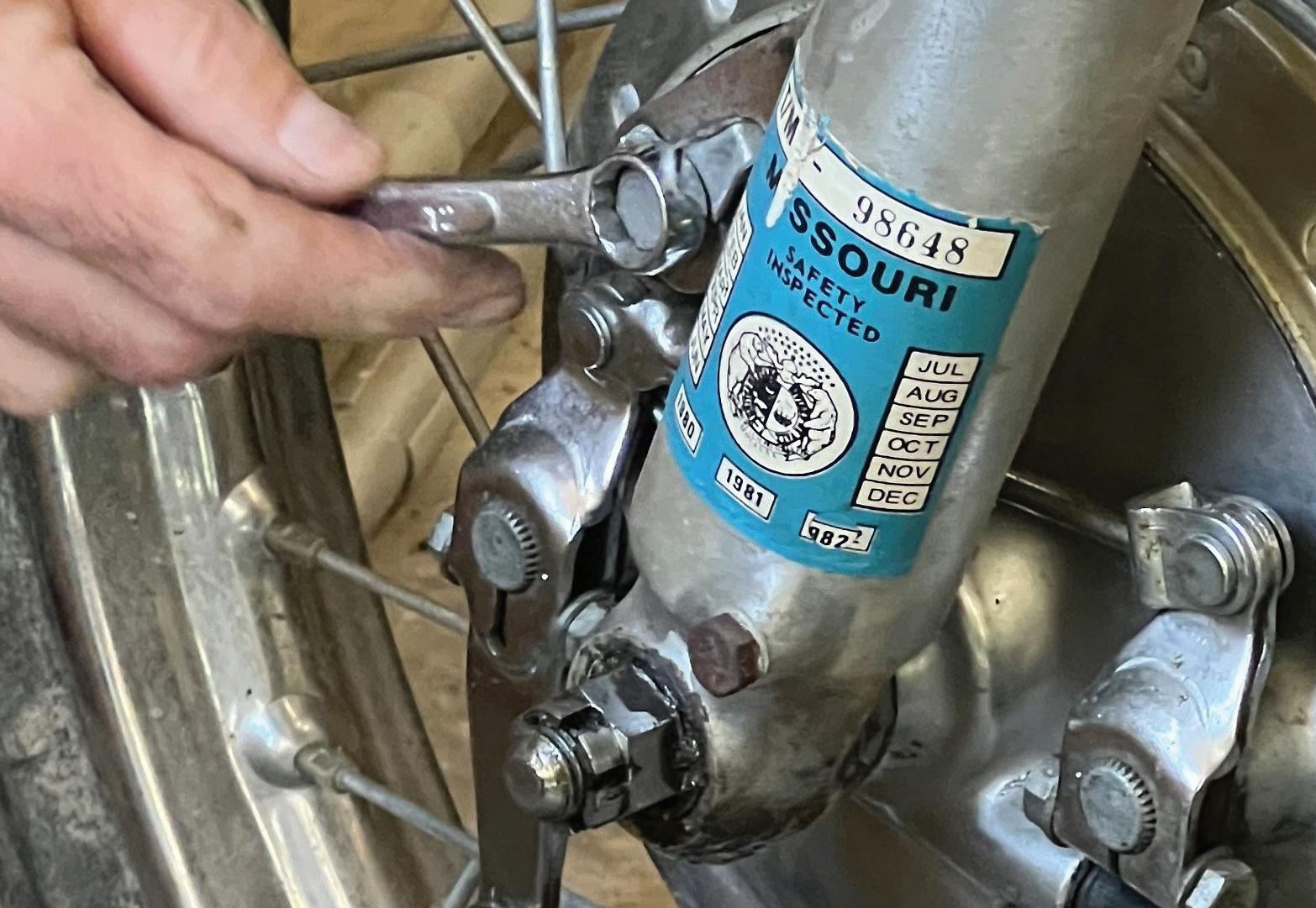
19
Now you can pull the front wheel axle out and remove the front wheel. We took our two wheels to our local independent motorcycle shop and had new tires and tubes mounted and balanced. Once that was finished, we just reversed all the disassembly steps and put the wheels back on the bike.
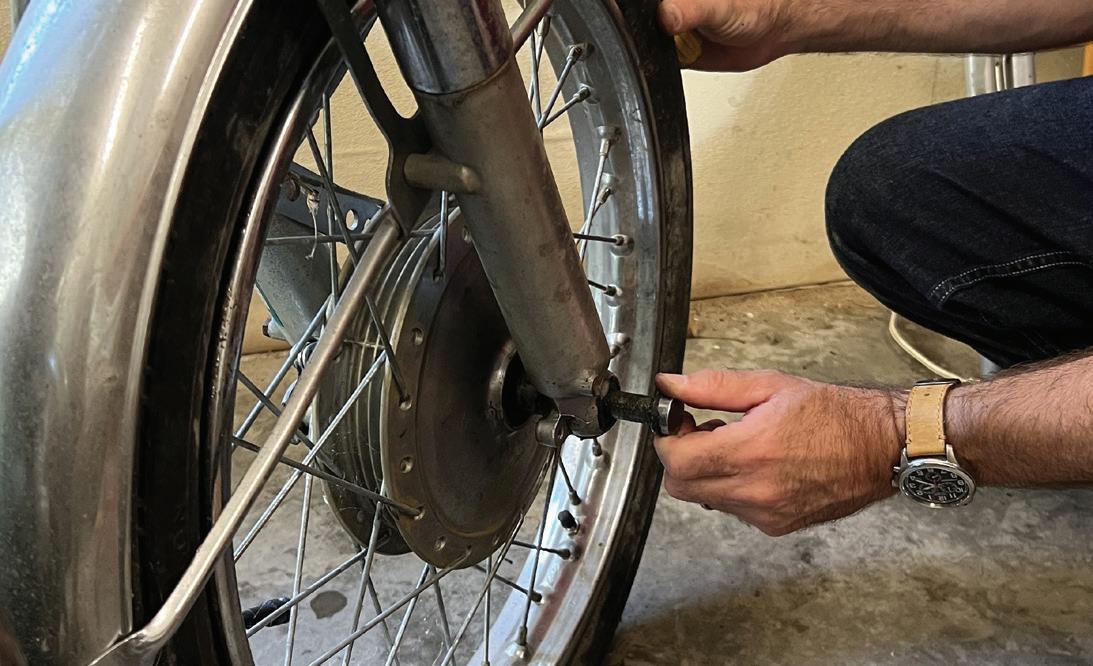
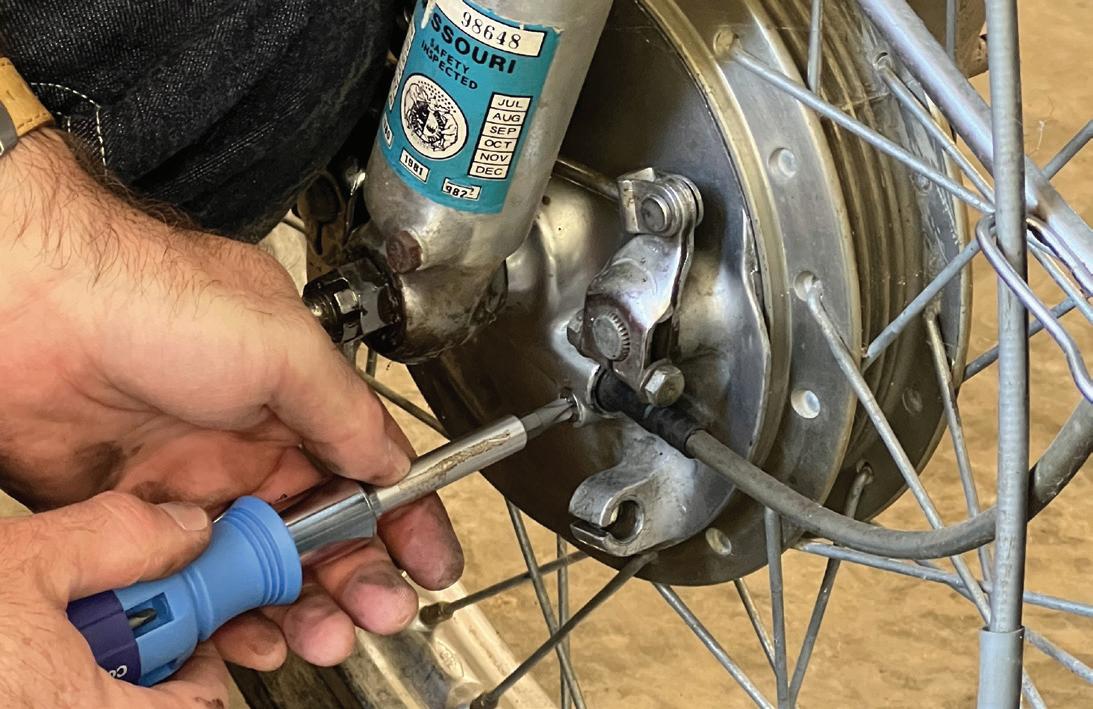
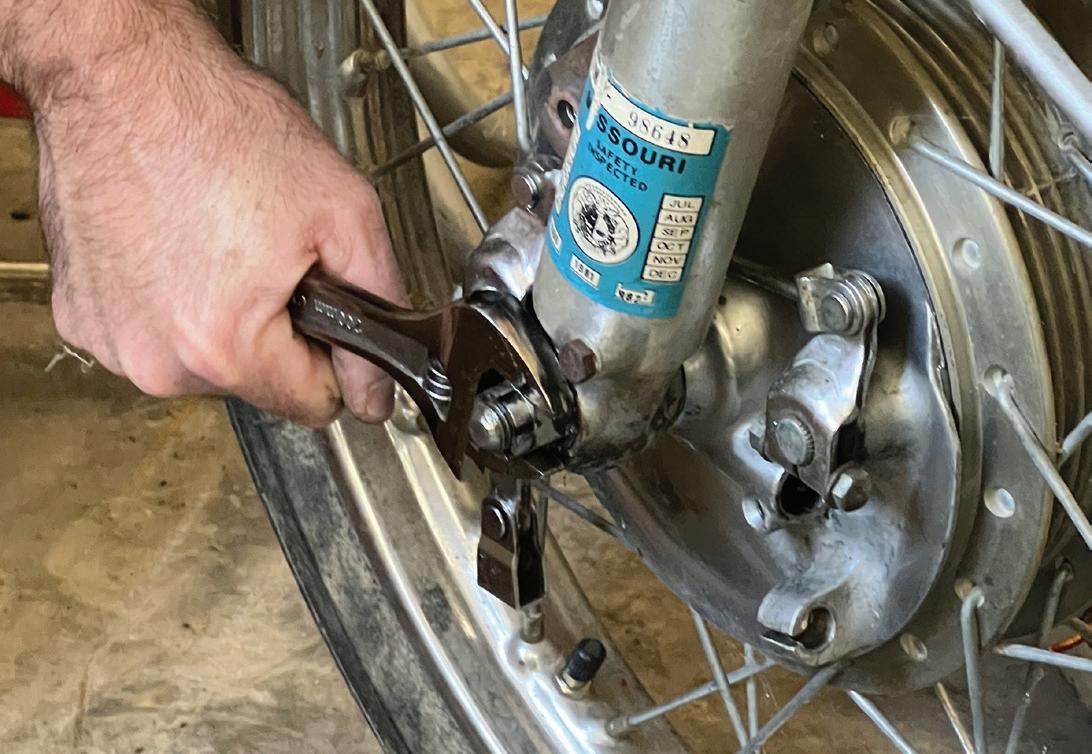
20
Our last steps included checking the tire pressure and installing a new battery. Once the gas tank was back on and attached to the carburetors, it was time to start it up and road test it. Jordan has been riding it and reports that it starts easily and handles well with the new tires. Now that it’s roadworthy he can clean and polish it to his liking.
16Remove the front brake stay after bending the lock tabs back on the lock washer attached to the stay. 15 Loosen the locknuts holding the brake cable to the brake plate and slacken off the brake cable enough to remove it from the end of the brake lever. 18 Remove the front axle nut. 17 Using a properly sized screwdriver, remove the screw holding the speedometer cable in place. Then pull the speedometer cable out of the hub.

All events subject to change. Please check event websites for updated information.
This year marks the 82nd Anniversary of Daytona Bike Week in Daytona Beach, Florida, taking place March 3-12. The 53rd running of Daytona Supercross, is set for Saturday, March 4. The 81st running of the Daytona 200, hosted by MotoAmerica, home of Superbike and North America’s premier motorcycle road race series, takes place a week later on Saturday, March 11. In addition to the Daytona 200, the MotoAmerica weekend at Daytona will be the opening round of the 2023 MotoAmerica Mission King Of The Baggers Championship, REV’IT! Twins Cup Championship, and Roland Sands Super Hooligan National Championship. This will mark the second time these three classes will race on the high banks of the superspeedway. For more info, schedules and specific locations of activities visit officialbikeweek.com

Mar. 2-4 — AMCA 2023 Sunshine Chapter National Spring Meet. New Smyrna Beach, FL. Sunshine Chapter AMCA on Facebook.
Mar. 3-5 — Vintage Motorcycle Alliance 12th Annual International Vintage Motorcycle Swap Meet and Bike Show. Deland, FL. vintagemotorcyclealliance.com
4/14
Get ready for the 23rd Annual Riding Into History Motorcycle Concours at the World Golf Village near St. Augustine, Florida. RIH begins on Friday, April 14, with the Grand Marshal Tour and Dinner, followed on Saturday the 15th by the Concours d’Elegance. This year’s featured class will be “Get your Heart Racing — Competition Motorcycles.”
AMA Motorcycle Hall of Famer Mary McGee has been named Grand Marshall. She is a historically pioneering motorcyclist having broken barriers for not only women riders, but for all riders. On the web at ridingintohistory.com
The third annual Possum Vintage Motorcycle Gathering, a swap meet and show for all makes of vintage bikes, will be held again at the Sevier County fairgrounds in Sevierville, Tennessee. Bikes and parts at least 25 years or older are welcome. On site camping is available with numerous hotels and restaurants nearby along with some of the best motorcycling roads in the Smokies. Twenty-five awards will be presented at the Concours d’Possum bike show on Saturday the 13th. Vintage bicycles along with hit-and-miss engines will also be on display. Visit Facebook at “The Possum Motorcycle Gathering” or contact Patrick at pdeason@outlook.com
Tennessee’s largest moto and music event, Tennessee Motorcyles and Music Revival, is heading back to Loretta Lynn’s Ranch May 18 - 21, 2023. The Sixth Annual TMMR is sponsored by Harley-Davidson Motor Company at the 3,500-acre Lynn ranch in Hurricane Mills, just an hour west of Nashville, in the picturesque countryside. The four-day family-friendly bash includes Harley-Davidson test rides, stunt shows, motorcycle racing and a two-wheeled playground for off-road trail riding. The BC Moto Invitational, a custom motorcycle showcase, features select craftsmen displaying some of the country’s best custom motorcycles. On the web at MotorcyclesAndMusic.com
Head to Heartland Motorsports Park in Topeka, Kansas, for a full weekend of AHRMA racing, Friday, May 26 through Sunday, May 28. There will be road racing, flat track and more. On the web at ahrma.org
Mar. 5 — Walneck’s Swap Meet and Show. Springfield, OH. walneckswap.com
Mar. 10-12 — Inland Northwest Motorcycle Show and Sale. Spokane, WA. spokanemotorcycleshow.com
Mar. 18-19 — 47th Annual Idaho Vintage Motorcycle & Bicycle Rally & Show. Caldwell, ID. idahovintagemotorcycleclub.org
Mar. 19 — 50th Annual Kalamazoo Motorcycle Swap Meet. Kalamazoo, MI. kalamazooswap.com
Mar. 26 — So-Cal Cycle Show and Swap Meet. Long Beach, CA. socalcycleswapmeet.com
Apr. 8 — 20th Annual Cadillac Swap Meet. Cadillac, MI. cadillacswap.com
Apr. 14-16 — The Handbuilt Motorcycle Show 2022. Austin, TX. revivalcycles.com/pages/ handbuilt-motorcycle-show
Apr. 22 — Northwest Motorcycle Classic Swap Meet and Show. Lynden, WA. washingtonvintagemotorcyclists.org
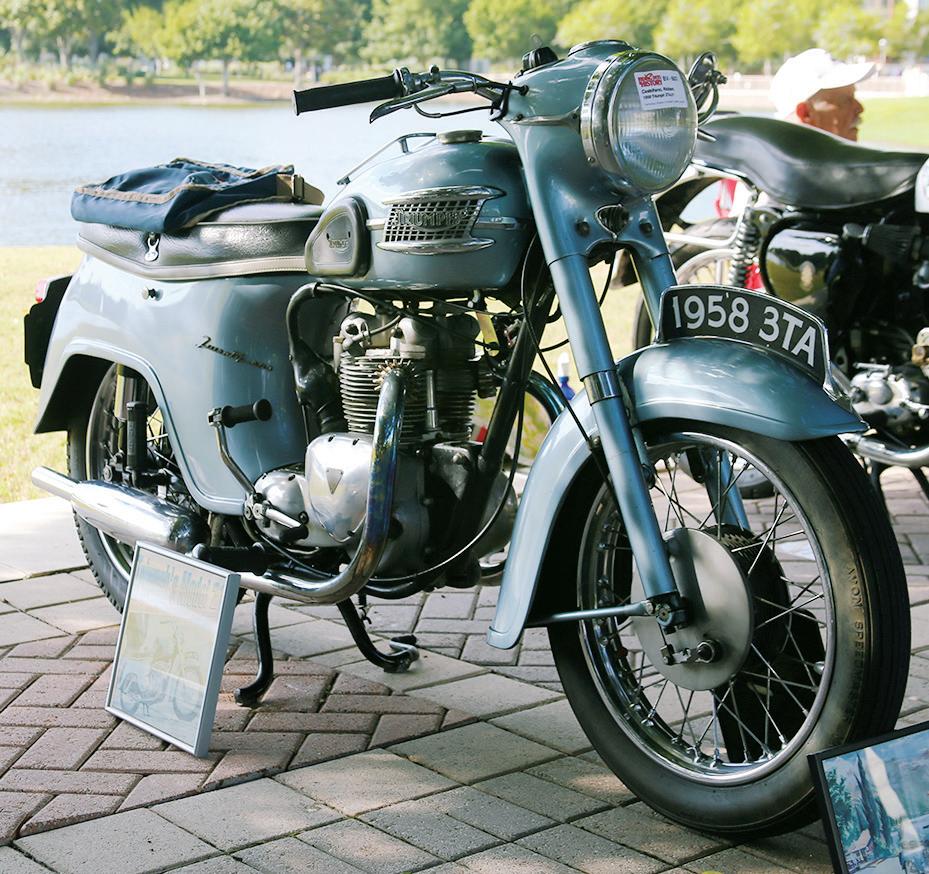
Apr. 23 — Jeff Williams
Motorcycle Swap Meet. Kansas City, MO. jwswapmeet.com
Apr. 23 — Walneck’s Swap Meet and Show. Woodstock, IL. walneckswap.com
Apr. 28-29 — AMCA National Meet Perkiomen Chapter. Oley, PA. antiquemotorcycle.org
May 19-20 — 54th Annual Hanford Cycle Swap, Kings Fairground, Hanford, CA. hanfordcycleswap.com
Show your support for the magazine with the Motorcycle Classics Mesh Hat! This hat features a garment washed cotton twill front with a mesh back and a pre-curved visor. Embellished with an embroidered patch that features a 1967 Triumph T120 Bonneville. Whether you’re in the garage working on your bike or just out for a night in town, this hat is the right one for the job.
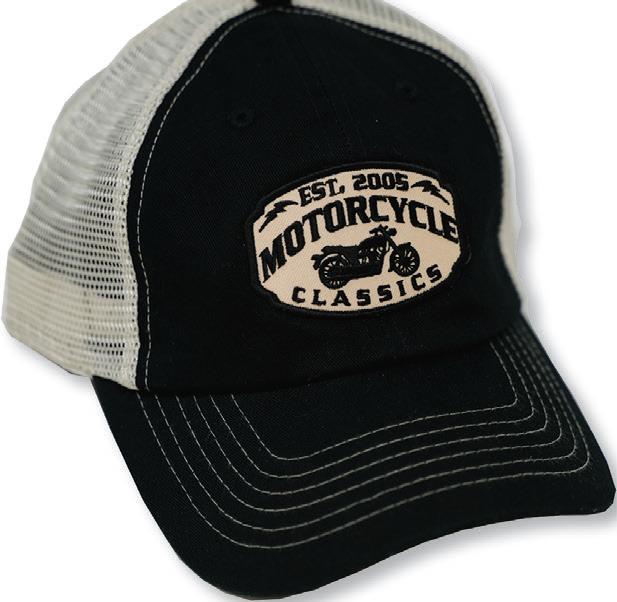
Item #9689 $16.99 Member: $14.44
Can be used on both coated and oil tanned leather. Safe for colored leather, including white. Fast application, with quick absorption time.

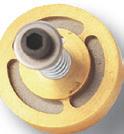


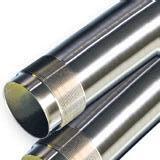



To order, call 800-880-7567 or visit Store.MotorcycleClassics.com
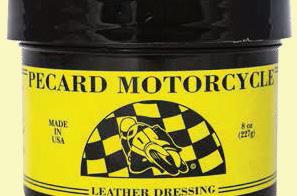


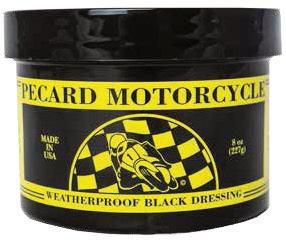
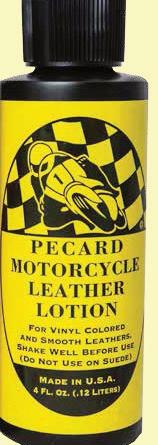

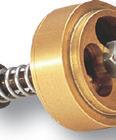







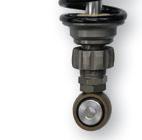
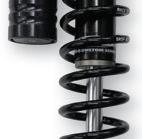






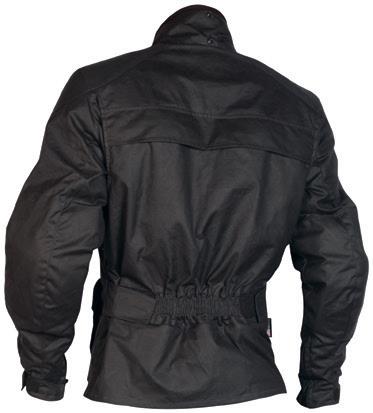
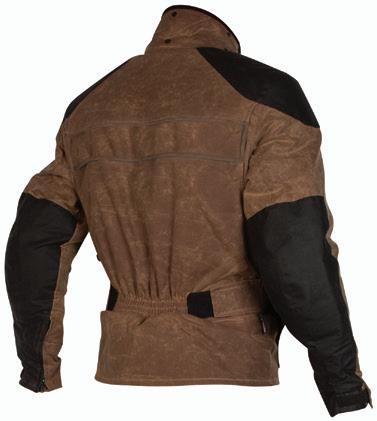
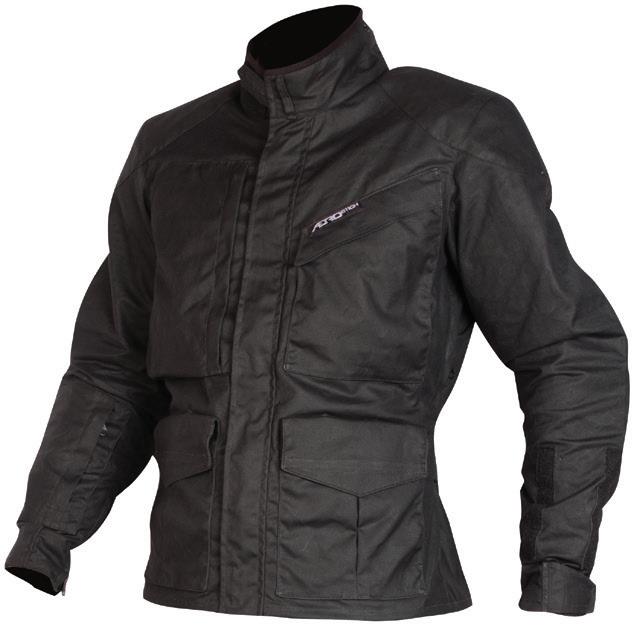
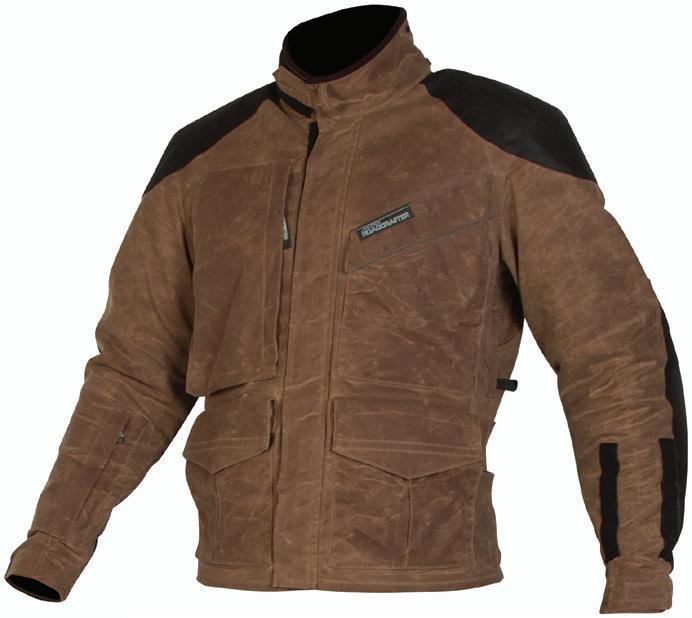
Mention promo code MMCPANZ2









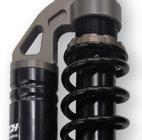








Classic waxed cotton and modern design merge in a serous riders’ jacket. The CJ’s details and features have been refined across thirty years of rider input and experiences. There are over sixty off-the-rack in-stock sizes for a precise, professional fit and unmatched all-day comfort. Waxed cotton provides extreme all-weather performance over any distance and to every destination. It’s proven waterproof and breathable technology that is literally from another century and it still works great and looks amazing today. Additional features include the ergonomic pockets, vents, and rain flaps.
Utah has some of the best roads, riding, scenery and destinations on the planet. I’ve written about Utah and its attractions in these pages before (Zion, May/June 2012; Arches, November/December 2015; State Routes 12 and 24, May/June 2016; Flaming Gorge, July/August 2017; and Golden Spike, June 2020). Cedar Breaks National Monument is another Utah Destination that belongs in this impressive list. Cedar Breaks is between Zion (80 miles to the southwest) and Bryce Canyon (60 miles to the northeast). You can visit all three (Zion, Bryce, and Cedar Breaks) in two days, and my recommendation is to base your stay in Panguitch. Panguitch is close, it has two outstanding restaurants (see below), and it is a good jumping off point for a ride along Utah State Route 12 to Grand Staircase and Escalante.

The Southern Paiute Native Americans called the area “u-map-wich,” which means “the place where rocks slide down all the time.” Another Paiute name is Ungkaw Pekonump, or “red cove.” Early white settlers called the area The Badlands due to the area’s beautiful but otherwise inaccessible, impassable, and unusable nature. Our name, Cedar Breaks, resulted from early white settlers misidentifying the juniper trees as cedars, and “break” is a geologic term for abrupt changes in topography. Cedar Breaks National Monument features a high-altitude 3-mile-wide cove with the upper rim at 10,000 feet and a depth of 2,000 feet. It forms the west end of the Markagunt Plateau (which reaches all the way to Zion National Park). Cedar Breaks’ cliff walls include reds, oranges, purples, and yellows that result from iron and manganese deposits. Hoodoos like those at the more-well-known Bryce Canyon National Park fill the interior. The
bright walls and colors are surrounded by contrasting deep green junipers. It all makes for striking scenes. While junipers are the dominant trees, the area also contains bristlecone pines. Bristlecone pines are the oldest living organisms in the world; some in this area are known to be more than 1600 years old.
Franklin D. Roosevelt designated Cedar Breaks as a national monument in August 1933. Development of Cedar Breaks National Monument was part of the New Deal that helped overcome the Great Depression, and the Civilian Conservation Corps played a significant role here similar to that undertaken at Zion, Bryce and elsewhere. The Civilian Conservation Corps’ efforts included construction of hiking trails and buildings that are still in use. One of these
buildings, a log cabin built in 1937, was added to the National Register of Historic Places in 1983. Cedar Breaks National Monument is remote and it experiences little evening light pollution; it has been designated an International Dark Sky Park by the International Dark Sky Association. On a moonless night the evening views are stellar.
Cedar Breaks National Monument is a magnificent destination but check the weather before you ride and dress appropriately. Due to the altitude, spring starts in June and the visitor center is open through October. Cedar Breaks’ wildflowers emerge in June, and they are glorious. Snow and inclement weather make parts of Cedar Breaks inaccessible other times of the year. — Joe Berk
What: Cedar Breaks National Monument, 4730 South Highway 148, Brian Head, Utah 84719, (435) 586-9451. The entrance fee is $10 for visitors 16 or older, and it is good for 7 days.
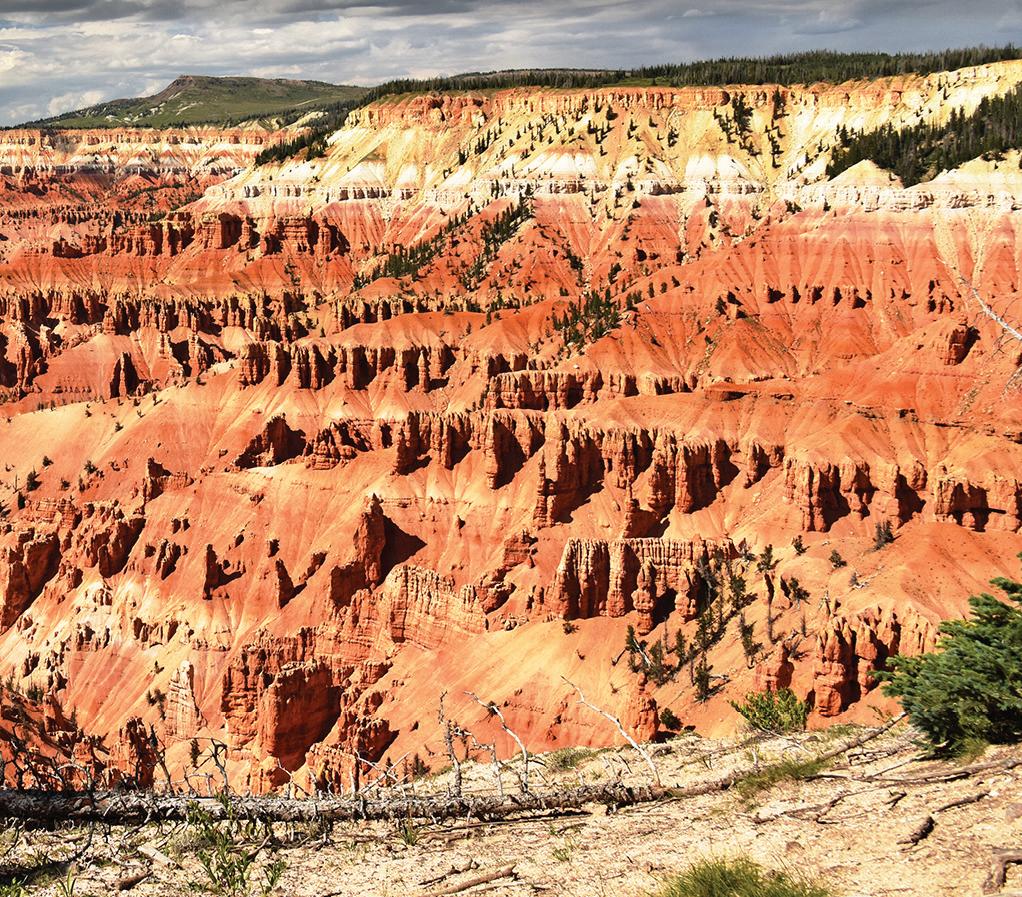
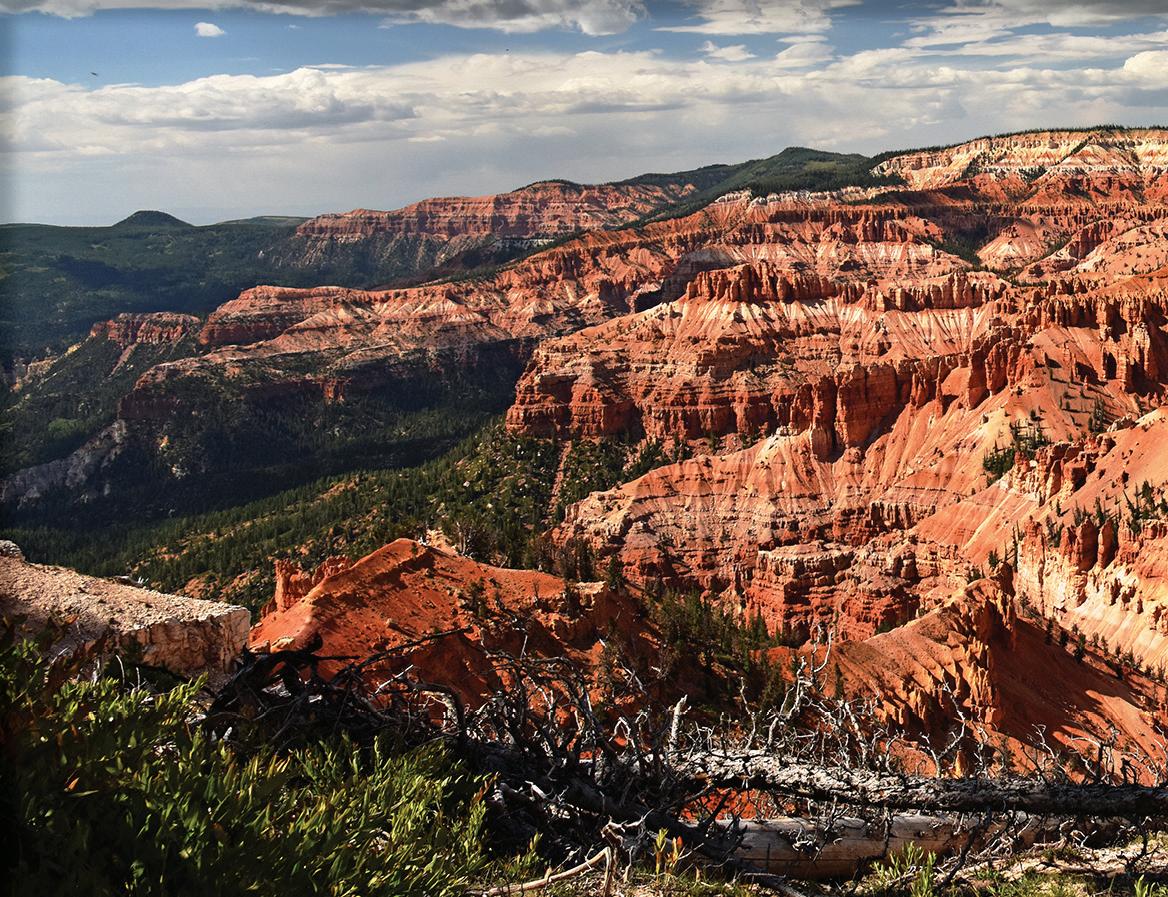
How to Get There: Take Interstate 15 from either the north or the south. From the north, take I-15 to Parowan and then head south on SR 143. From the south, take I-15 north to SR 14 east, then pick up SR 148 north.
Best Kept Secrets: Two restaurants in Panguitch (Cowboy’s Smokehouse Café for dinner and Kenny Rays for breakfast). You may have to wait for a table, but both are worth the wait.
Avoid: Leaving without checking the weather (see above).





Don’t Miss: Utah State Route 148, the Cedar Breaks Scenic Byway, for the ride in from points south. It is magnificent.
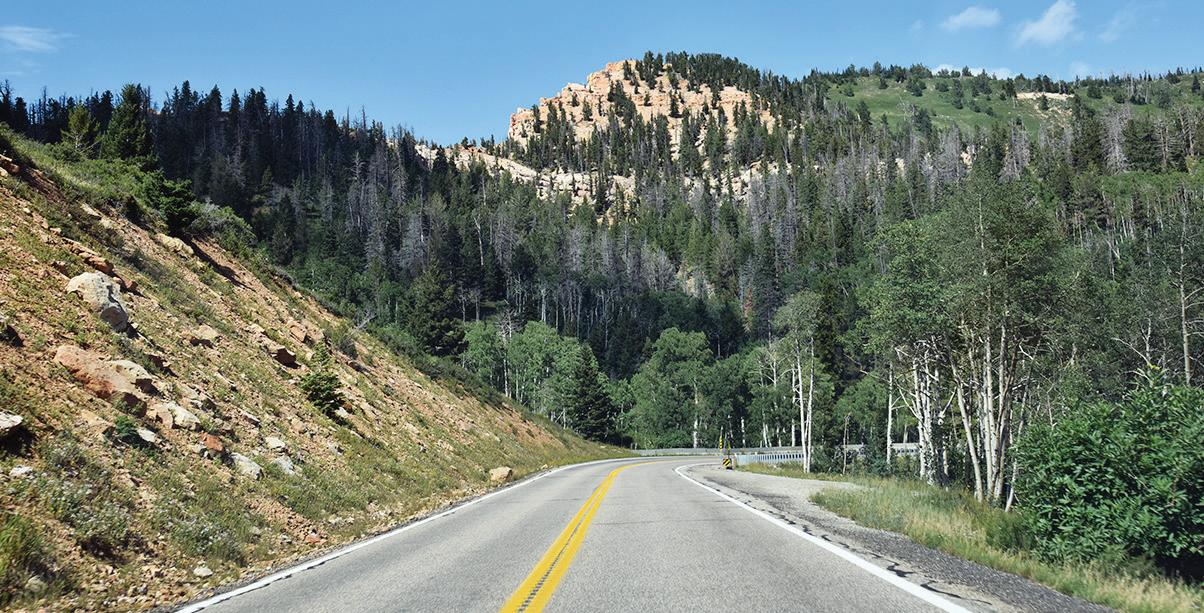


More Info: Cedar Breaks National Monument, nps.gov/cebr
More Photos: bit.ly/cedarbreaks
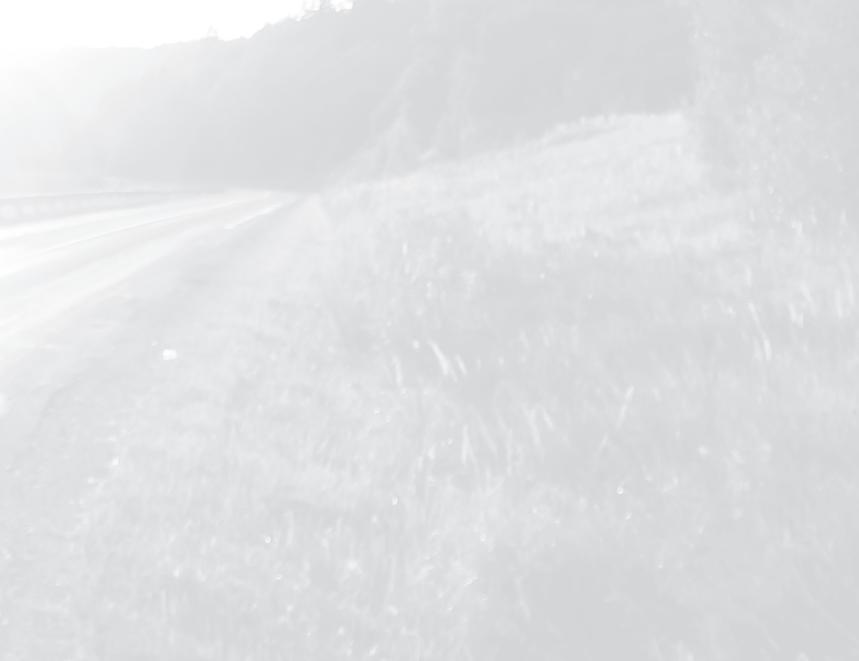



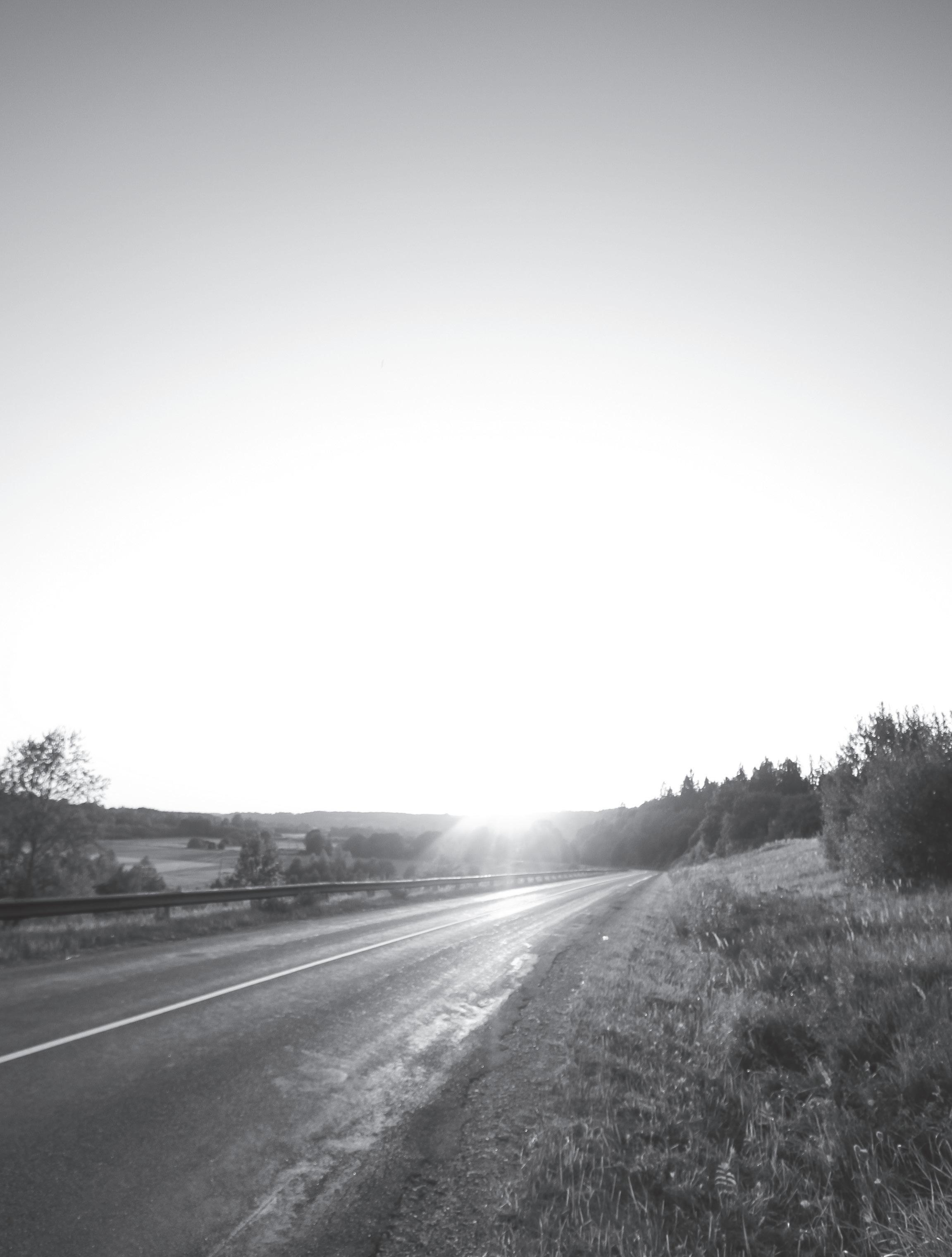
Honda made its mark on the motorcycle world with small, affordable bikes, and grew well beyond that to create some of the most important performance machines ever built. Today, these bikes are increasingly coveted by collectors and enthusiasts. This guide to the collectible Hondas gives prospective buyers a leg up on the current market for groundbreaking classics like the CB77 Super Hawk, CB92 Benly, Dream 300, CB750, CB400F, as well as 1970 to 1979 models that are quickly becoming classics in their own right. Photographs of the models are accompanied by complete descriptions of specifications, components, paint codes and serial numbers. A five-star rating system rates the bikes on collectability, parts availability, two-up touring compatibility, reliability and power. The author also highlights common repair and restoration needs, and looks ahead at future collectible models. This book is an updated version of the Illustrated Buyer’s Guide Classic Honda Motorcycles.
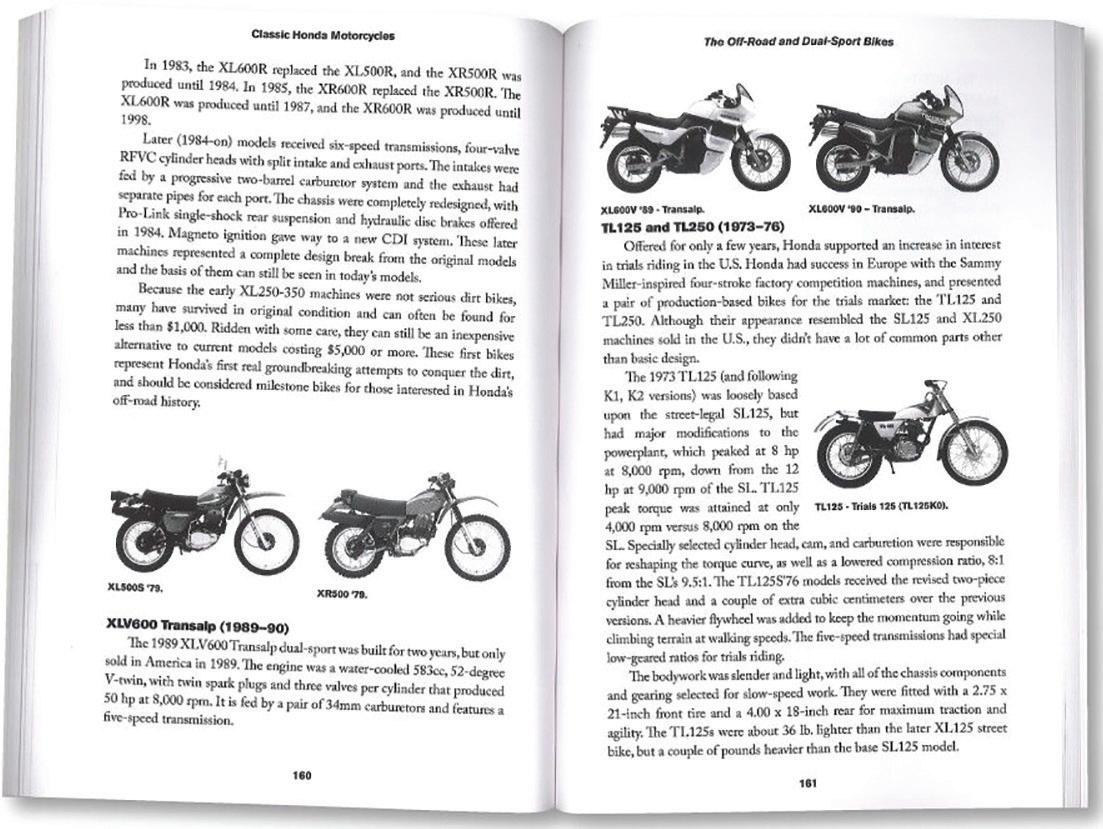
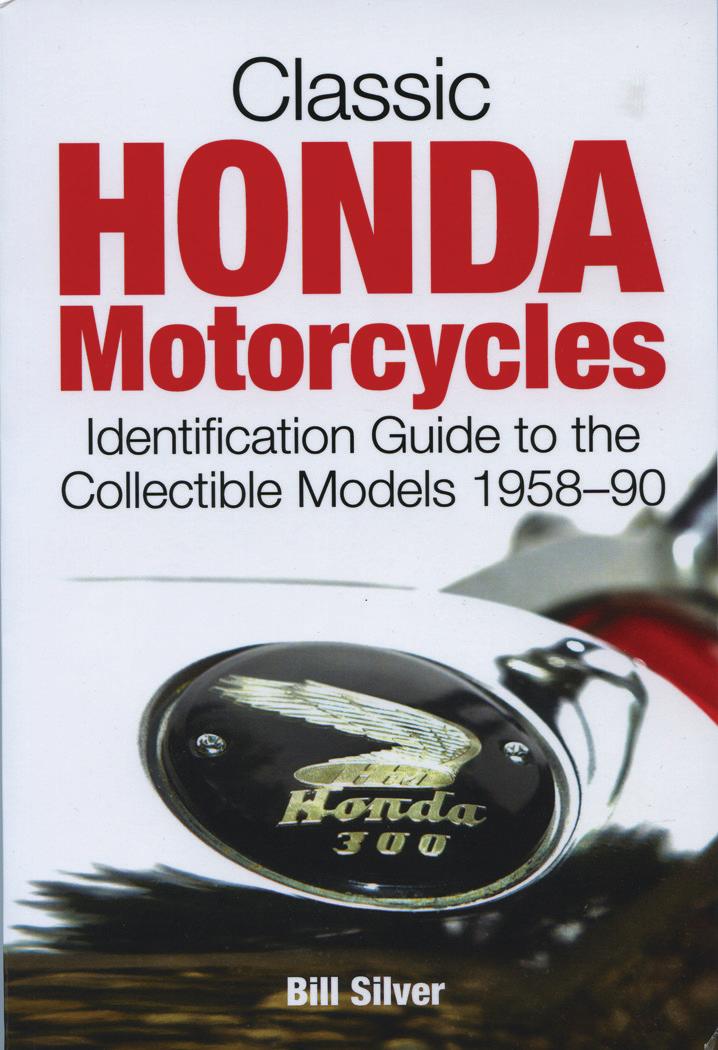
This How to Restore Norton Commando manual is aimed at owners and enthusiasts of the legendary Norton Commando, and covers all areas of restoration from the sourcing of the bike to its completion as a fully restored machine. Starting with advice on the different models, spares availability and where best to source a bike to restore, the book then covers the complete dismantling and restoration of the bike. Describing the engine, frame, gearbox, wheels, suspension and forks, brakes, ancillaries, bodywork, and electrics. Plus, the text is illustrated with hundreds of clear color photos.
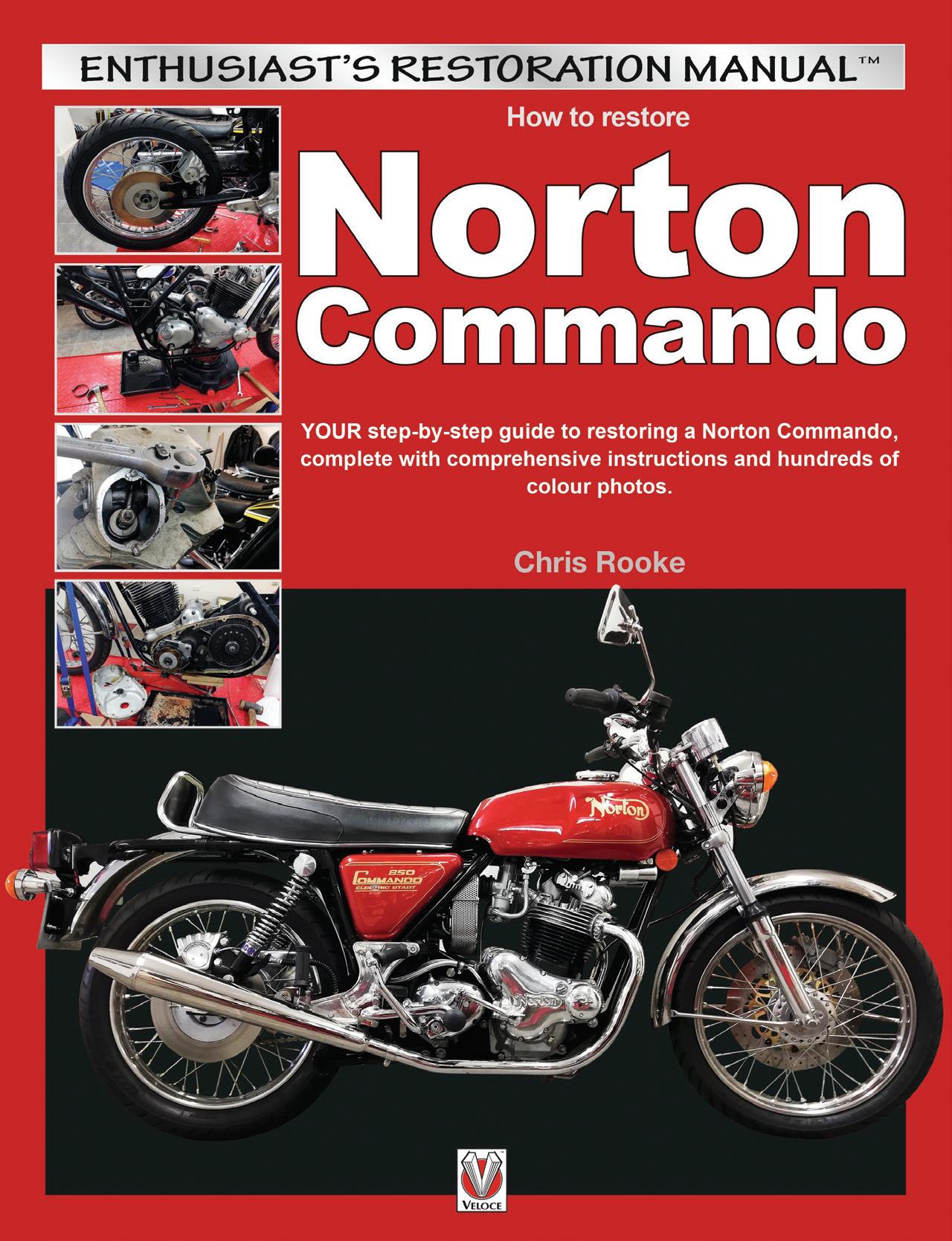
Item #10286 $50.00 Members: $45.00


To order, call 800-880-7567 or visit Store.MotorcycleClassics.com
Mention promo code MMCPANZ2








What really sets this manual apart is the style in which it is written: not as some dull and distant workshop manual but in a friendly, humorous manner by an enthusiast of many years who is able to involve and entertain the reader, as well as providing a thorough and detailed restoration guide. This is the fourth restoration guide from Chris Rooke whose previous works have been a massive hit with mechanics, enthusiasts and restorers throughout the world.



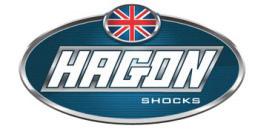

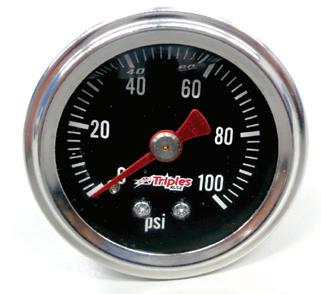

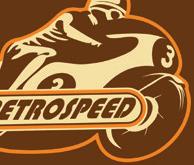


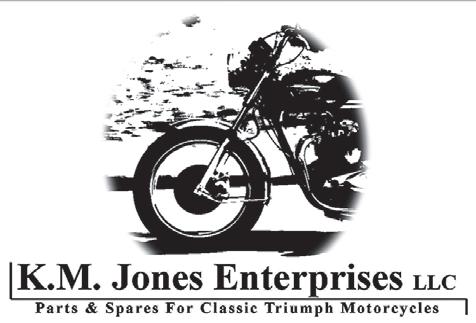

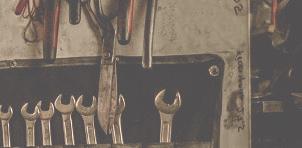



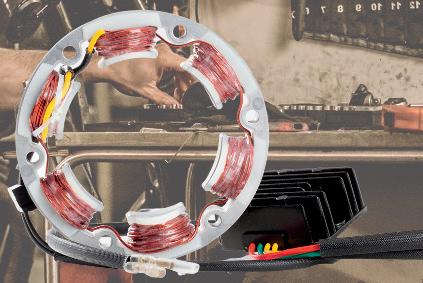
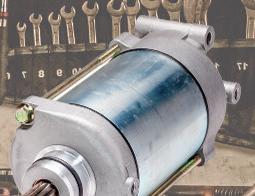
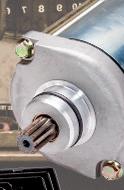
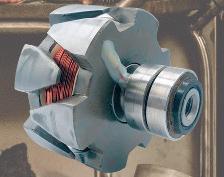

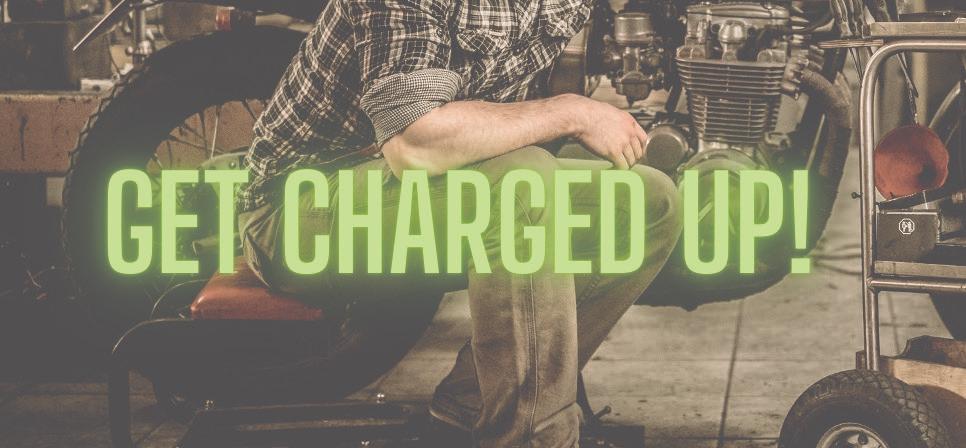




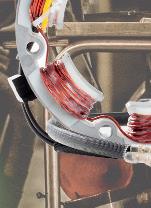

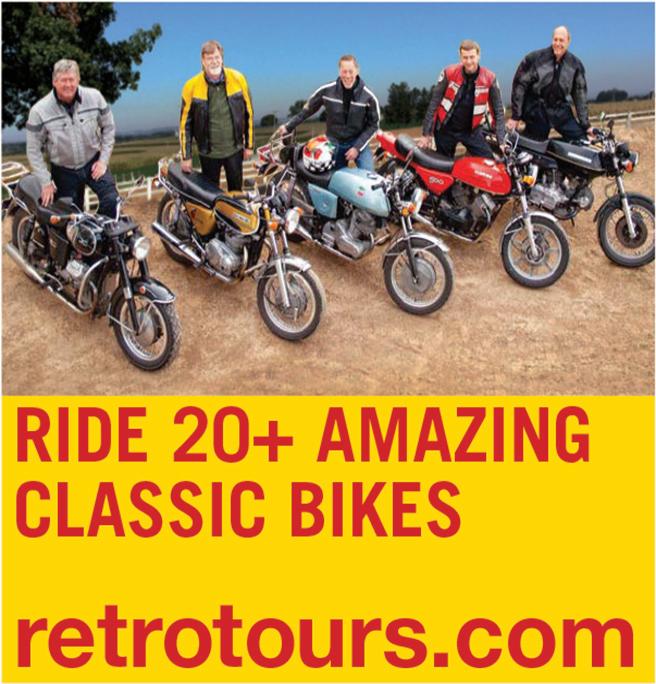





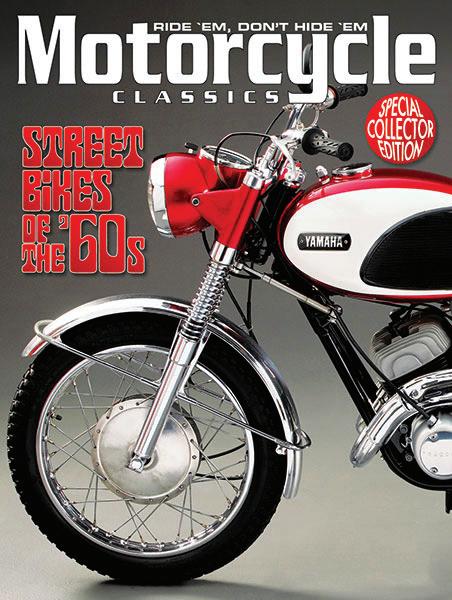


This 96-page guide is the next best thing to actually hopping on your bike and taking a long road trip with no particular destination in mind. Filled with stories of people who have ridden through places from the Big Sur coast in California to Australia, the issue will motivate you to get on your bike and take a ride. Packed with pictures of the riders’ travels and routes, this issue will help you see the beauty of different places from the view of a bike.
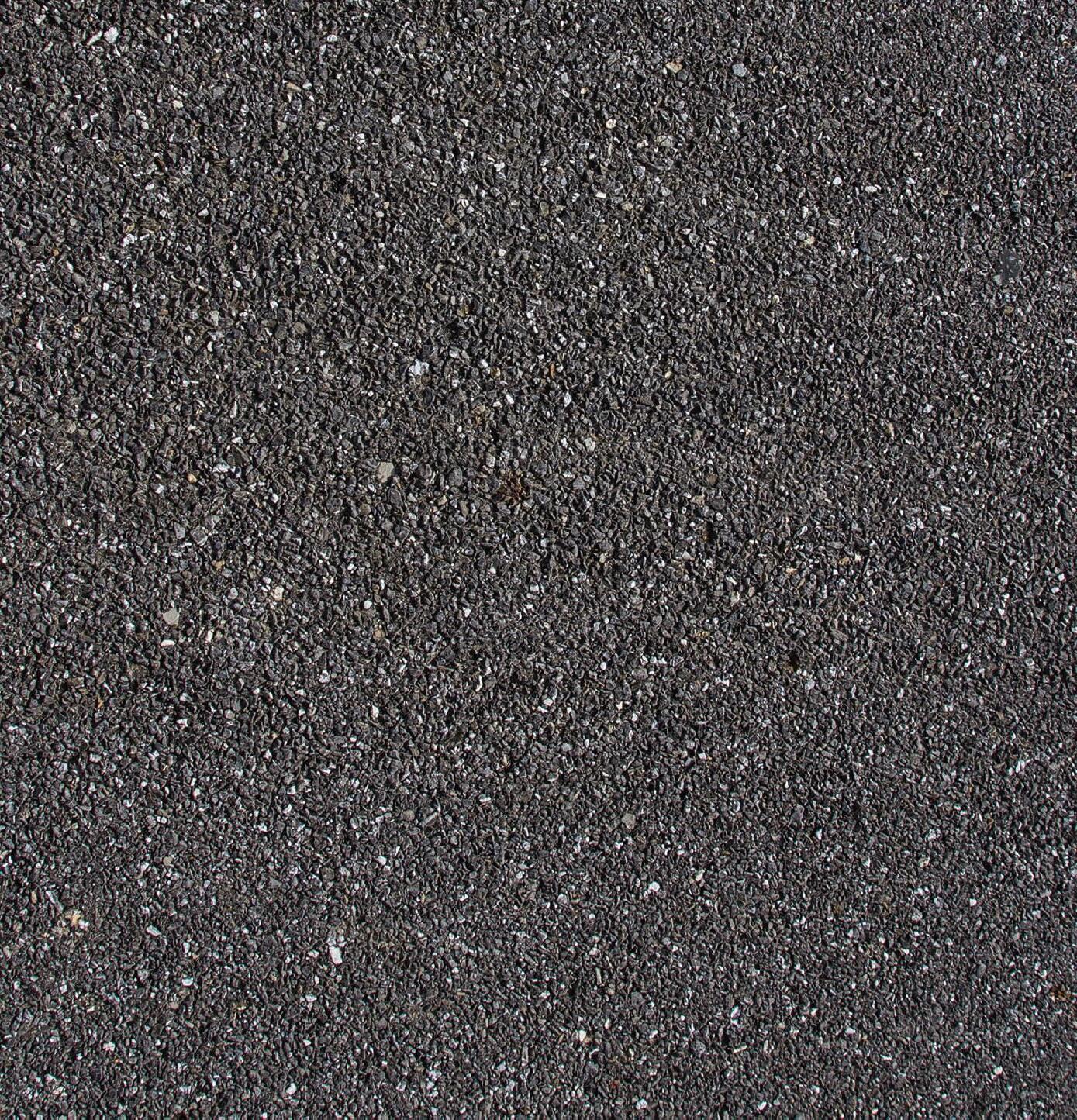
To order, call 800-880-7567, or visit Store.MotorcycleClassics.com Mention promo code MMCPANZ2









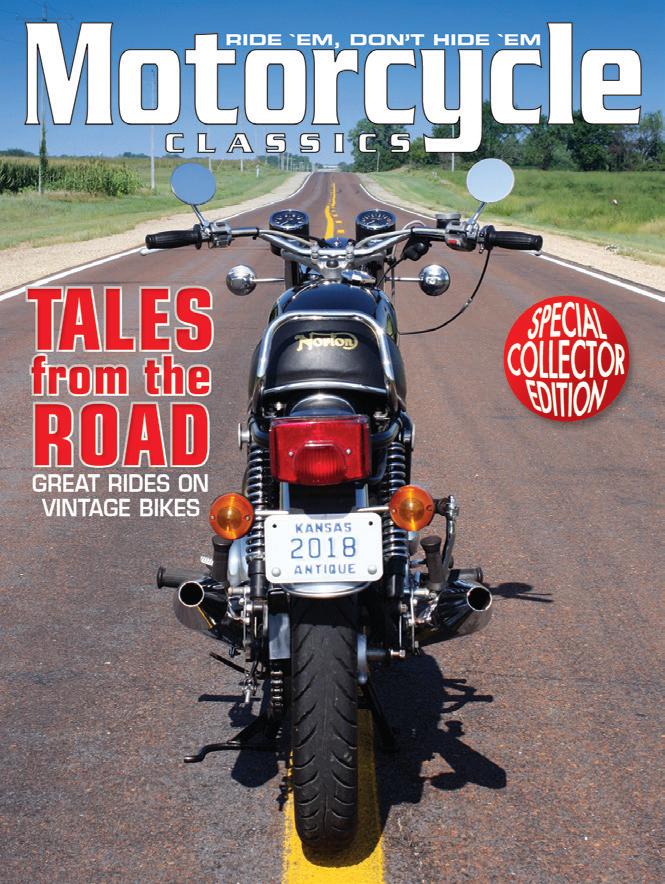
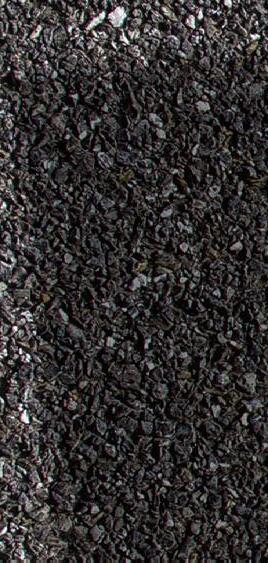
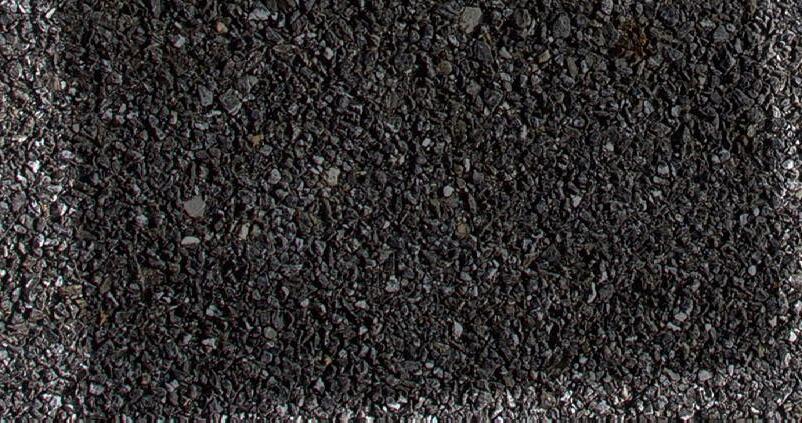


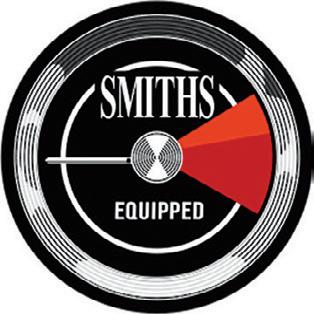

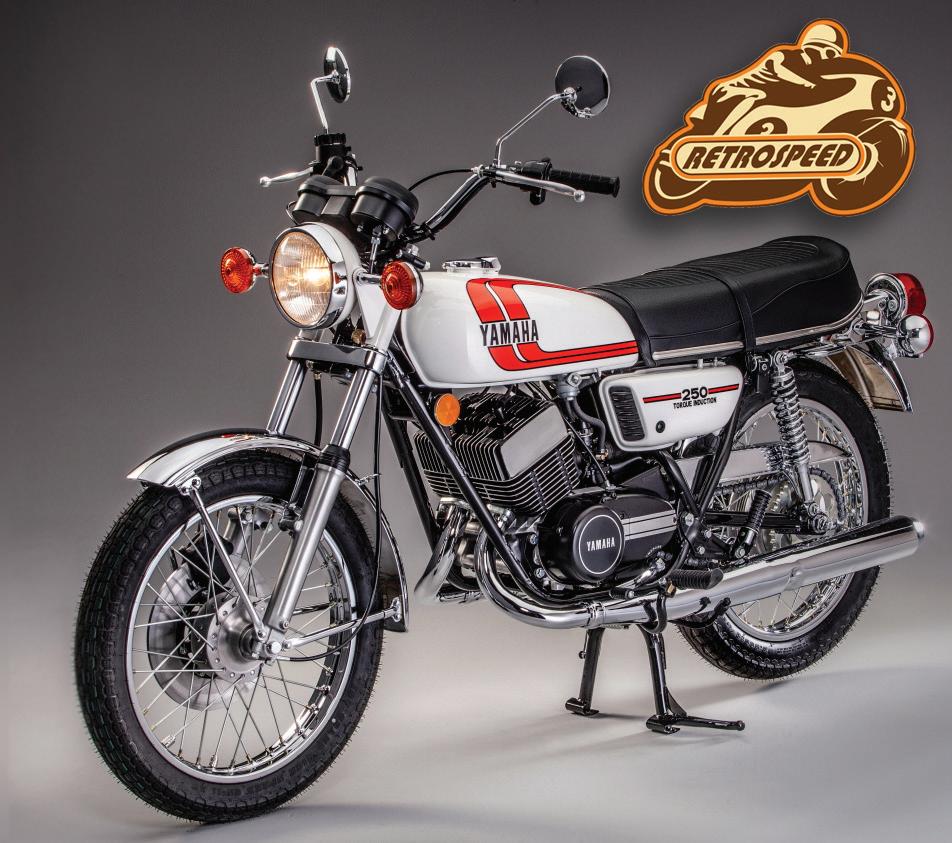

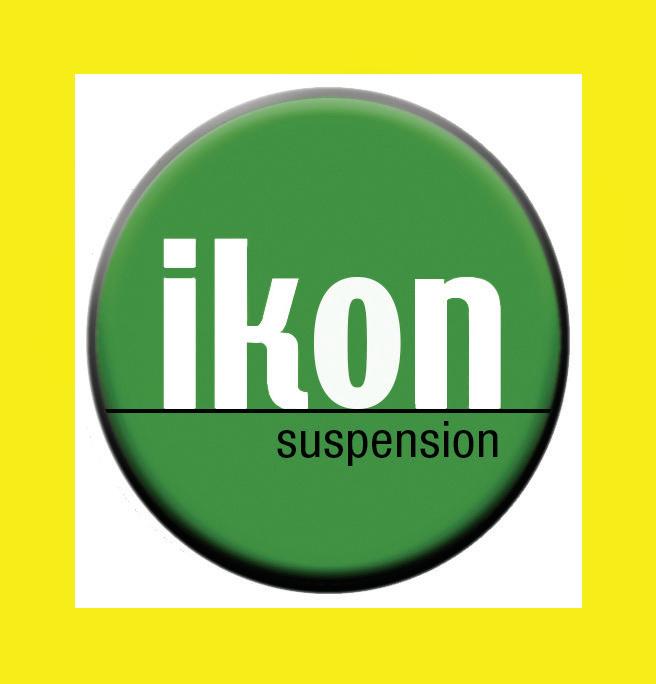


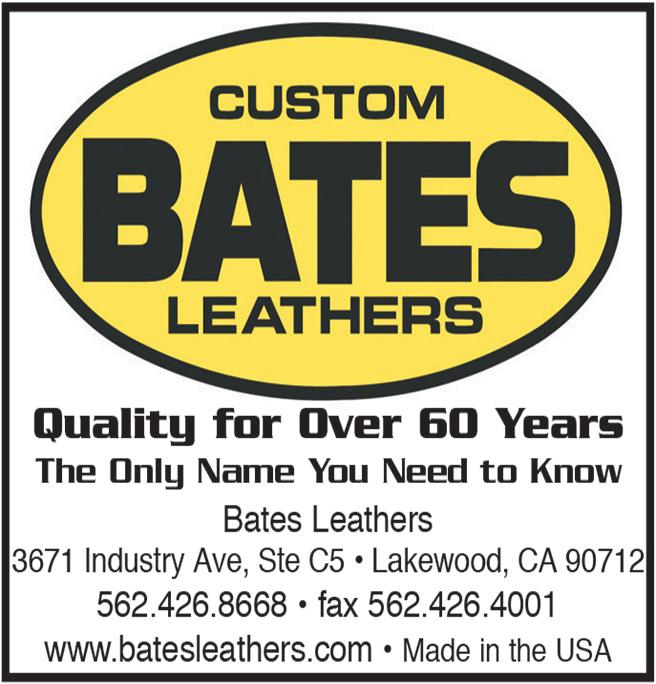

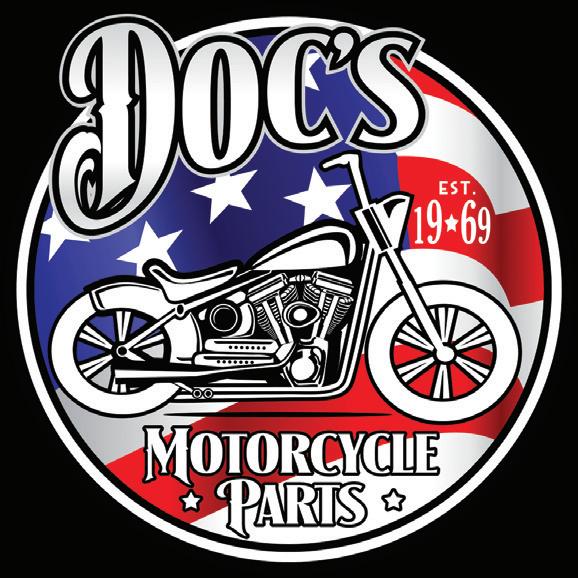
“


We bought 4 full truckloads of new original parts from the closed warehouse in Duarte CA. Everything from Bantam to Rocket III ” - Car l
“ We bought 4 full truckloads of new original parts from the closed warehouse in Duarte CA. Everything from Bantam to Rocket III ” - Car l




(314) 427-1204
(314) 427-1204

The Motorcycle People - Since 1962
The Motorcycle People - Since 1962
St. Charles Rock Road, St. Ann, MO 63074
St. Charles Rock Road, St. Ann, MO 63074

Read the fascinating story behind the woman who went on a 35,000-mile solo adventure around the world! In 1982, at the age of 23, Elspeth Beard left her family and friends in London and set off on her solo trip on a 1974 BMW R60/6. With some savings from her pub job, a tent, a few clothes, and some tools, all packed on the bike, she was determined to prove herself and to get over a recent heartbreak.
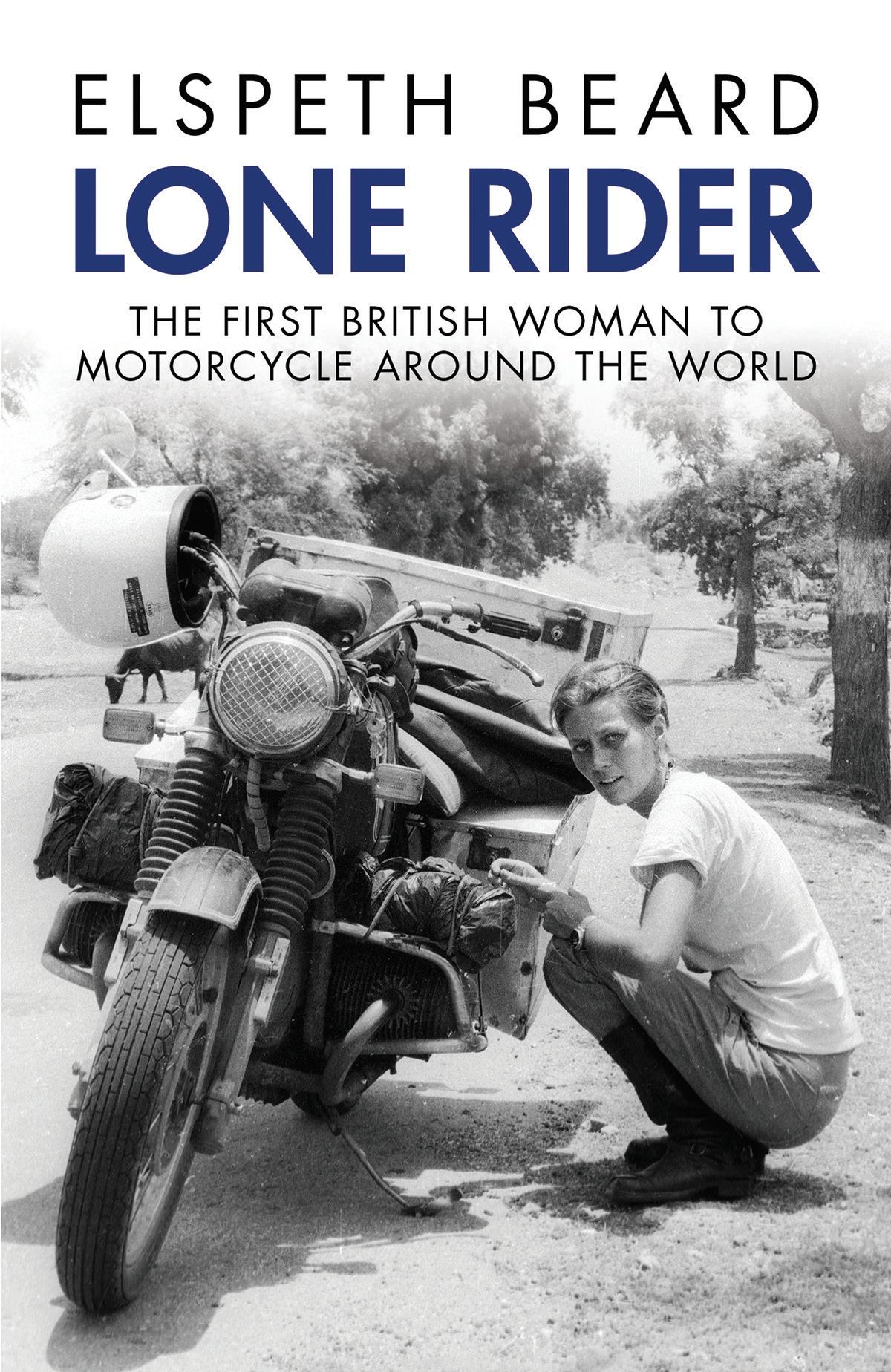
By the time she returned to England two years later, she was 30 pounds lighter and decades wiser. She’d ridden through deserts and mountain ranges and war-ravaged countries. She’d faked documents and fended off sexual attacks, biker gangs, and corrupt police who were convinced she was trafficking drugs. She’d survived brutal crashes and life-threatening illnesses, and she’d fallen in love with two very different men. Told with honesty and wit, this is the extraordinary and moving story of a unique and life-changing adventure.
Item #9115 • $19.95
To order, call 800-880-7567 or visit Store .MotorcycleClassics.com Mention promo code MMCPANZ2


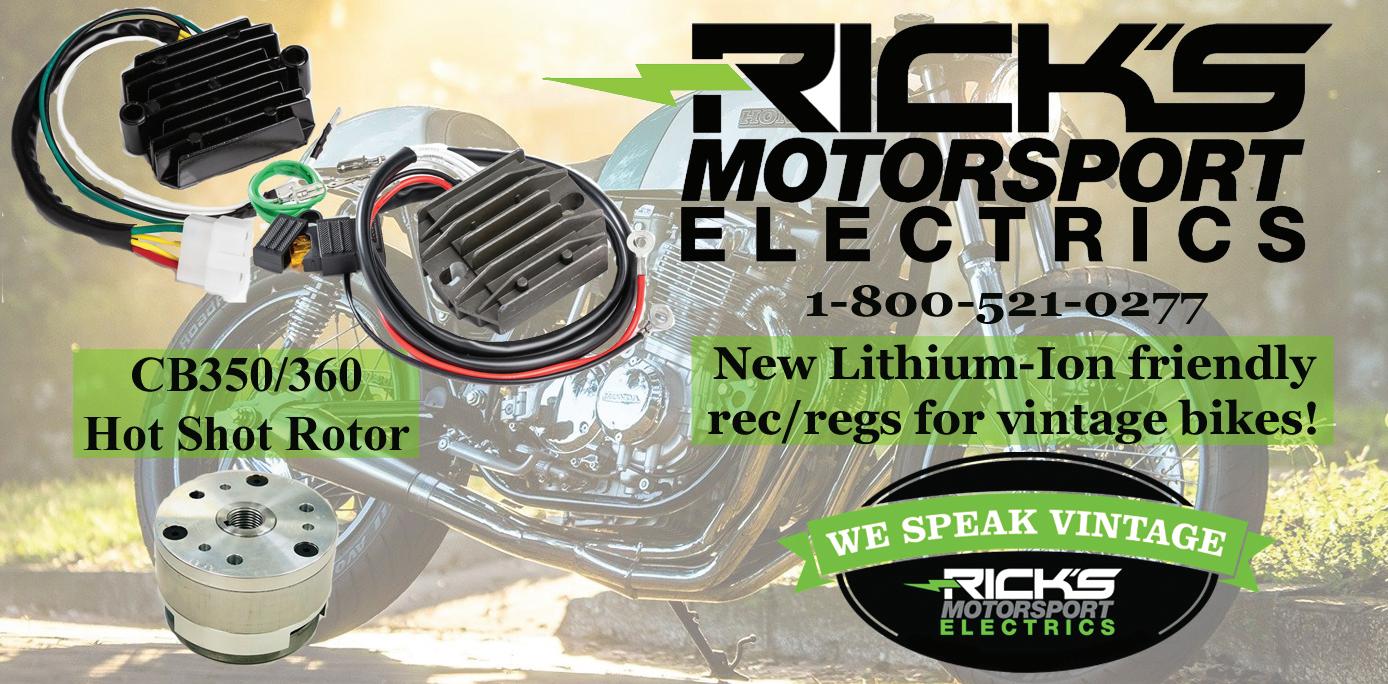
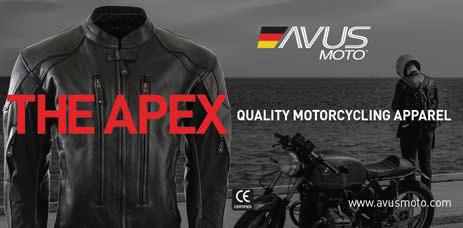

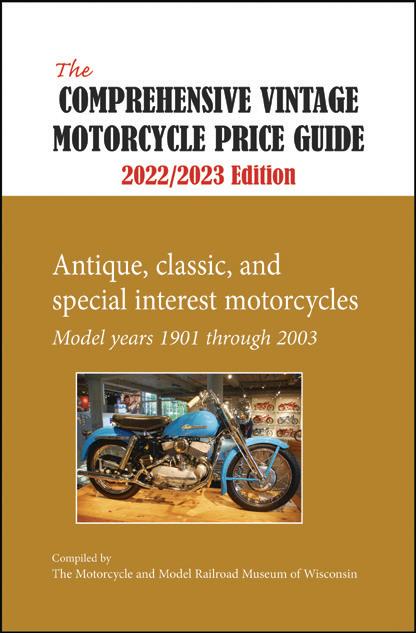
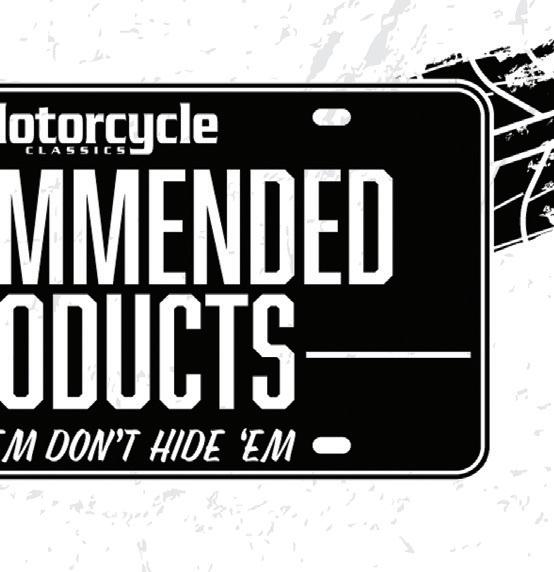
Through hundreds of hours of research and data entry, formed by the opinions of dozens of dealers, auctioneers, collectors, and experts in the vintage field, we believe this is the most accurate price guide available for vintage motorcycles. It contains more data than any other guide, as all major marques (and many lesser known marques) are included with data through 2003. Also, you’ll find data for the very early years of marques that go unreported in many other publications.
#11353 $19.95 Members: $14.95
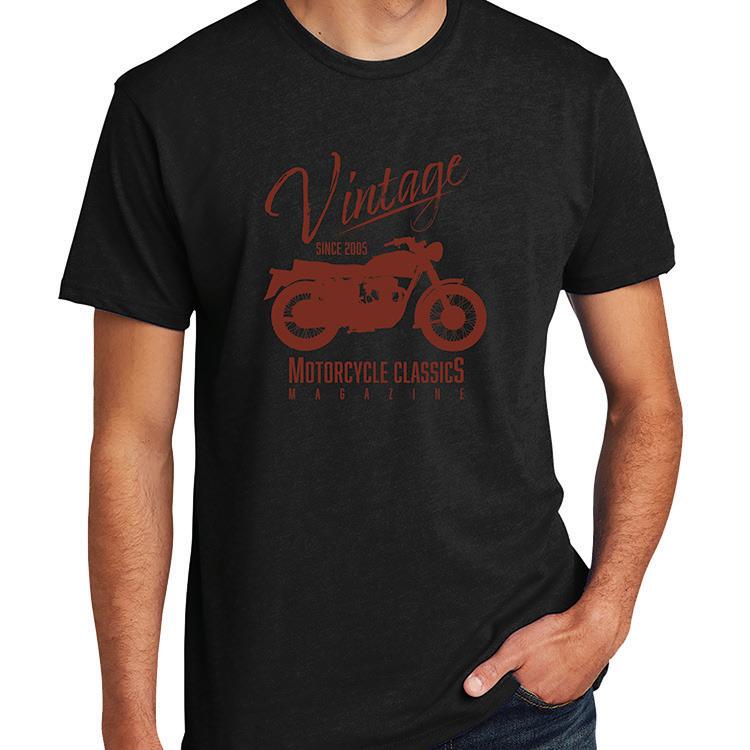
A new Motorcycle Classics T-shirt that will quickly become an old favorite! Made of super-soft material, this shirt is perfect for wearing on your rides or when you’re working on your bike. This shirt announces to everyone your love of motorcycles and Motorcycle Classics! This black short-sleeve T-shirt is made of a combed ringspun cotton/polyester fabric for a durable yet unbeatable feel.
#11844-11849

























$15.99-18.99 Members: $14.99/16.99/17.99




This new edition of Ian Falloon’s classic book on the history of BMW Motorcycles brings the story right up to date and now includes all models from 1923 right through to 2019. Readers will get an inside look at how BMW has proved their worth over the last 80 years. With its commitment to ease of serviceability, the BMW motorcycle has become the preferred choice for hundreds of thousands of motorcyclists around the world.
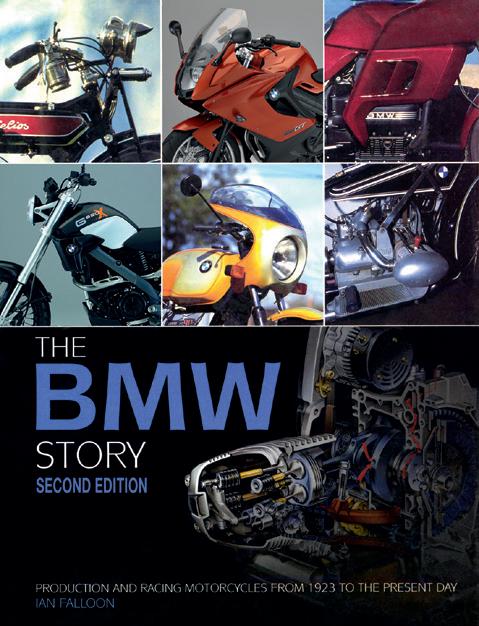
#10482 $60.00 Members: $51.00
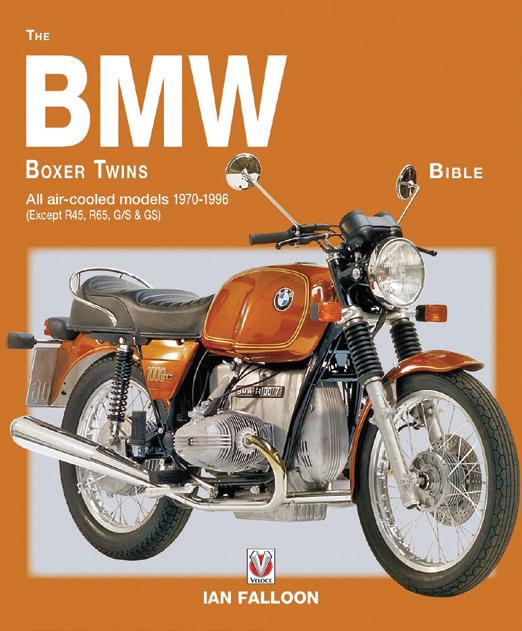
Expert Ian Falloon dives deep into the history of how the /5 series changed BMW’s reputation. Before the /5 series, BMW had a reputation for producing expensive and idiosyncratic touring motorcycles. Although still expensive, the market was opened to a new world of riders, and during the 1970s the air-cooled boxer evolved into the ground-breaking R90S and R100RS.
#10934 $50.00 Members: $42.50

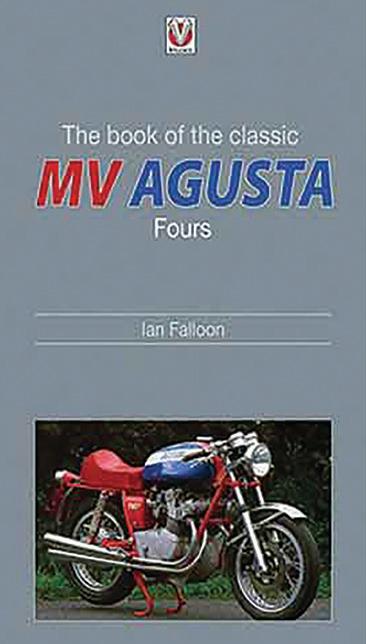
Agusta’s classic four-cylinder dominated Grand Prix racing for a decade. When replaced by the triple, Count Agusta decided to make the Four available in limited numbers as a production bike. To prevent privateers converting it into a Grand Prix racer, he stipulated it be 600cc and have shaft final drive. As befit an engine that handed multiple World Championships to its riders, the technical specification was staggering. This magnificent engine was always at the heart of MV Agusta, and it was this engine that created and sustained the legend.
#5638 $100.00 Members: $85.00
Here We Are...On Route 66 provides the fascinating histories of iconic landmarks and cultural touchstones associated with America's most famous highway, and celebrates lesser-known gems just off the beaten path. Acclaimed Route 66 historian Jim Hinckley arranged this one-of-a-kind book by classic Route 66 topics, creating a beautifully produced history rather than just another guidebook.
Here We Are...On Route 66 provides the fascinating histories of iconic landmarks and cultural touchstones associated with America's most famous highway, and celebrates lesser-known gems just off the beaten path. Acclaimed Route 66 historian Jim Hinckley arranged this one-of-a-kind book by classic Route 66 topics, creating a beautifully produced history rather than just another guidebook.
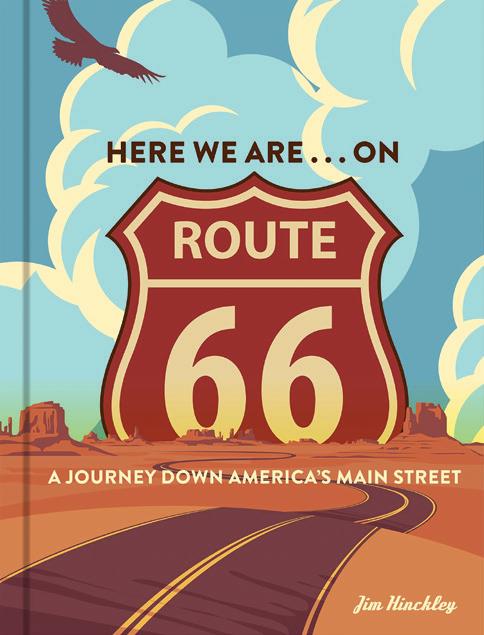
#11841 $
#11841 $40.00 Members: $34.00
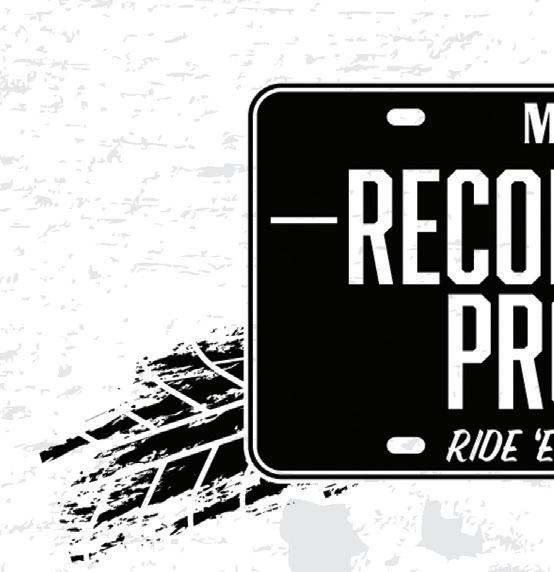
A complete workshop guide to restoring and maintaining your classic British motorcycle. Covering the principles of restoration and maintenance, and therefore applicable across all post-war classic British marques, this book covers everything from general maintenance procedures to full engine strips and rebuilds.
#10893 $59.95 Members: $49.99
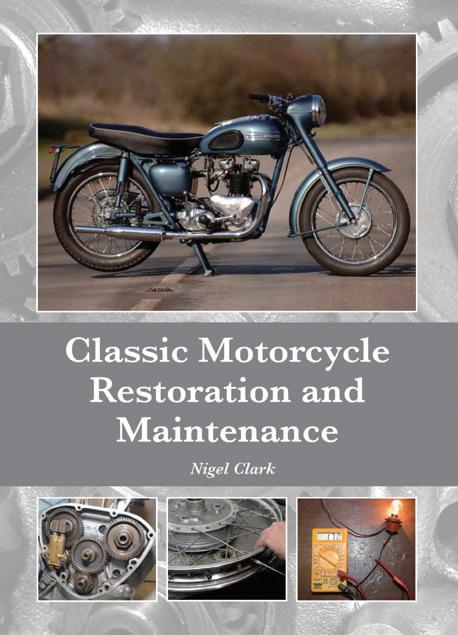
The story starts one weekend in 1947, at a motorcycle race in Hollister, California. A few members of one club, the no-holdsbarred 'Boozefighters' got a little juiced up and took their racing to the street. Through interviews with surviving members of the Boozefighters, you’ll be tossed into the fray for a firsthand account of what really happened in Hollister, and the formation of the club itself, where outlaw biker culture truly began.
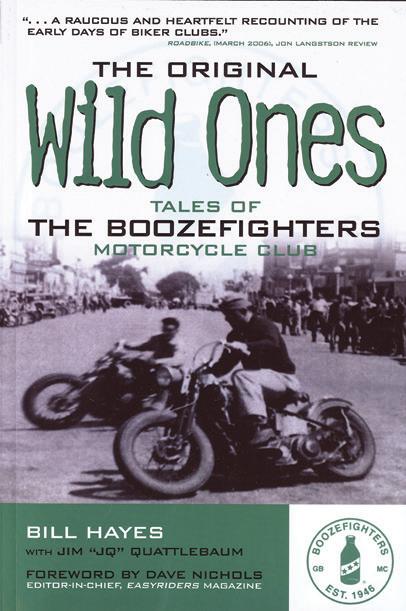
#11839 $24.99 Members: $21.24
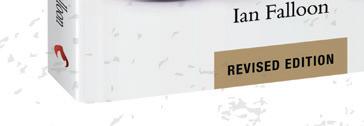












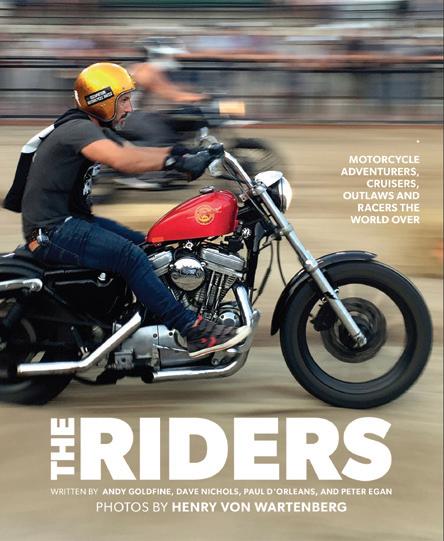
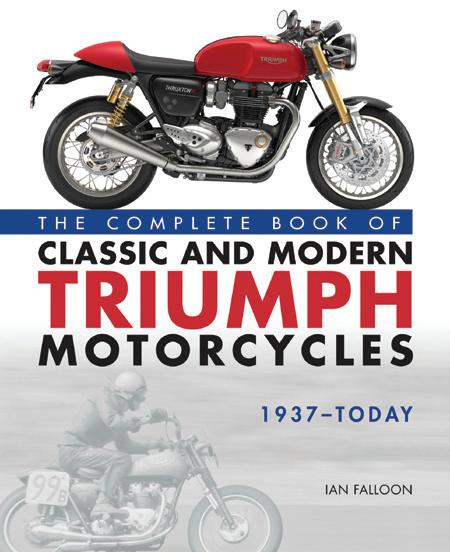
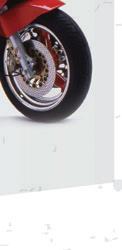

The ultimate reference for Triumph lovers and fans of British motorcycles, The Complete Book of Classic and Modern Triumph Motorcycles, 1937-Today collects all of the motorcycles from this iconic brand in a single illustrated volume. Written by respected Triumph expert Ian Falloon, this luxurious reference covers all of the major and minor models, with an emphasis on the most exemplary, era-defining motorcycles such as the Thunderbird, Tiger, and more.
#10260 $50.00 Members: $42.50

HONDA MINI TRAIL ENTHUSIAST'S GUIDE







The Riders explores and celebrates the differences and common bonds among motorcyclists around the world via Henry von Wartenberg’s engaging and inviting documentary photography. Von Wartenberg, a long-time rider himself, has traveled the world on a variety of assignments, some motorcycle related and others not. But wherever he was on the planet, he always found a way to connect with fellow riders and document their culture and machines.
The Riders explores and celebrates the differences and common bonds among motorcyclists around the world via Henry von Wartenberg’s engaging and inviting documentary photography. Von Wartenberg, a long-time rider himself, has traveled the world on a variety of assignments, some motorcycle related and others not. But wherever he was on the planet, he always found a way to connect with fellow riders and document their culture and machines.
The Honda Mini Trail Enthusiast's Guide covers all Honda Mini Trails and Z50 bikes produced between 1968 and 1999. Author Jeremy Polson begins with a brief introduction of the models that led up to the Mini Trail, and then jumps into a thorough analysis of the many models and iterations that Honda has offered through the years. In addition to the hard facts regarding each model of each year, this book is filled with many rare photos that track the evolution of the Mini Trail, and unravel its mystery.
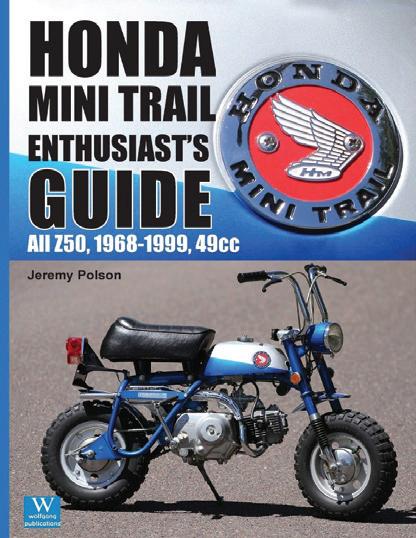
#10917 $45.00 Members: $38.25
#10917 $45.00 Members: $38.25





This book traces Peter Starr's personal journey as he made some of the most acclaimed, award-winning motorcycle films, and the accompanying DVD vividly illustrates his contribution to the world of motorcycle racing. A golden era is explored, examined, and preserved in 272 pages and more than 500 photographs as this behindthe-scenes book looks at how history was made in races all over the United States and Europe from 1973 to 1993.
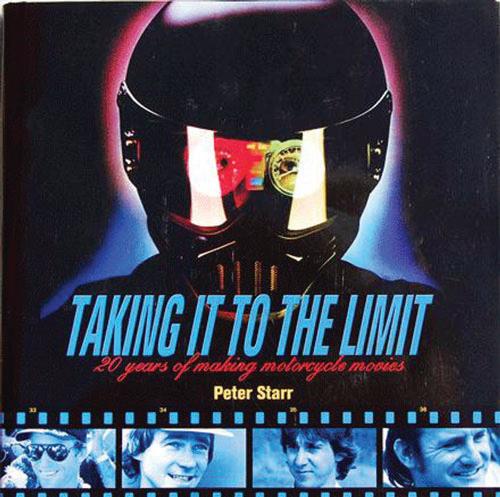
#6159 $49.95 Members: $41.99
#11373 $32.95 Members: $28.01
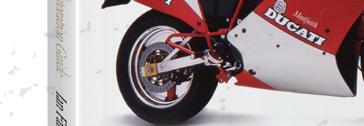
This hands-on guide helps owners ensure originality during restoration and modification by identifying key components of the 500/600/650SL, 750 F1, 750 Sport, 750SS, 900SS, Monster, Elefant, and other twovalve belt-drive built since '79. Hundreds of photos illustrate all mechanical details, while appendices cover specifications and identify sources for the restorer. First published in 2000, this revised edition has been updated with new information for its 2012 release.

#11339 $40.00 Members: $34.00




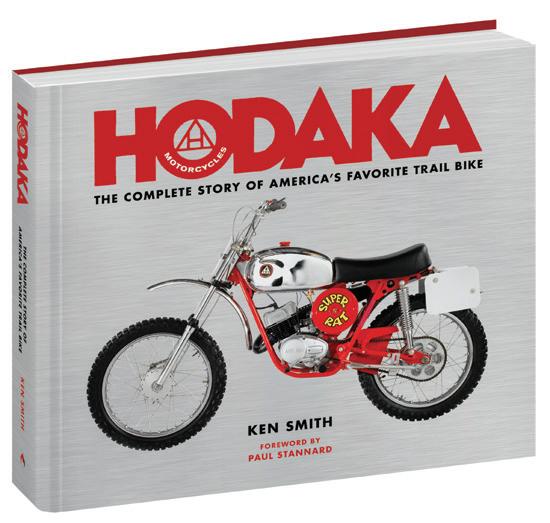
Hodaka motorcycles were some of the most creatively marketed and designed motorcycles in America. More than 15 years in the making, this exhaustively-researched tome contains all the details about the machines including production data and history as well as a treasure trove of photographs, advertisements, and graphics.
HODAKA: THE COMPLETE STORY OF AMERICA'S FAVORITE TRAIL BIKE Hodaka motorcycles were some of the most creatively marketed and designed motorcycles in America. More than 15 years in the making, this exhaustively-researched tome contains all the details about the machines including production data and history as well as a treasure trove of photographs, advertisements, and graphics.

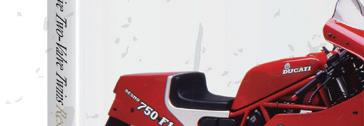
Active in motorcycle construction since 1920, particularly in the years after 1945, Moto Guzzi created motorcycles that made history, especially those with the powerful V-twin engine installed lengthwise in the chassis. This comprehensive volume describes all models and technical details, while providing background information about the company and the industry. It is not all about machines and horsepower, but also the people who put their stamp on the operations.
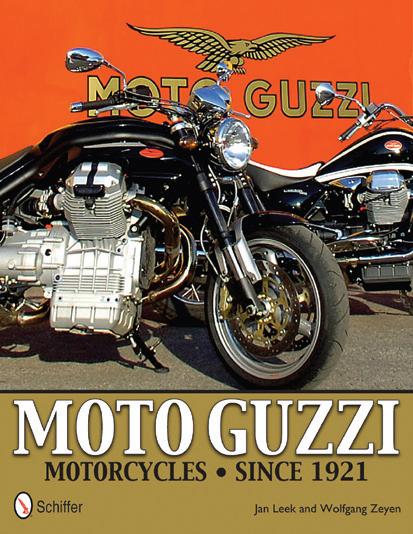
#11103 $60.00 Members: $51.00
#11103 $60.00 Members: $51.00


#10559 $39.99 Members: $33.99
To order, call toll-free 800-880-7567 (outside the United States and for customer service, call 785-274-4360) or go to Store.MotorcycleClassics.com
This book offers complete start-to-finish assembly and restoration sequences on two Triumph twins, a 1963 Bonneville and a 1969 Bonneville. Also included is the start-to-finish assembly of the 1969 engine and transmission. With more than 450 color photos, Triumph Motorcycle Restoration offers 144 pages of hard-core how-to help for anyone who wants to repair or restore their own Triumph twin.
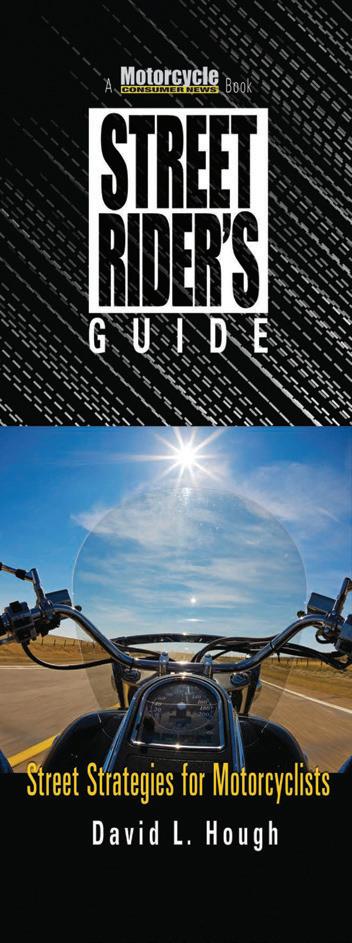
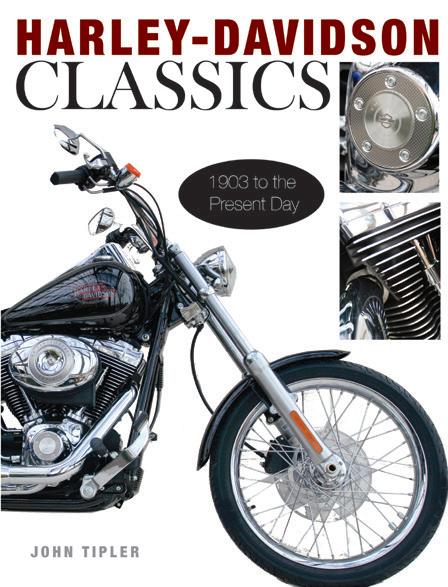
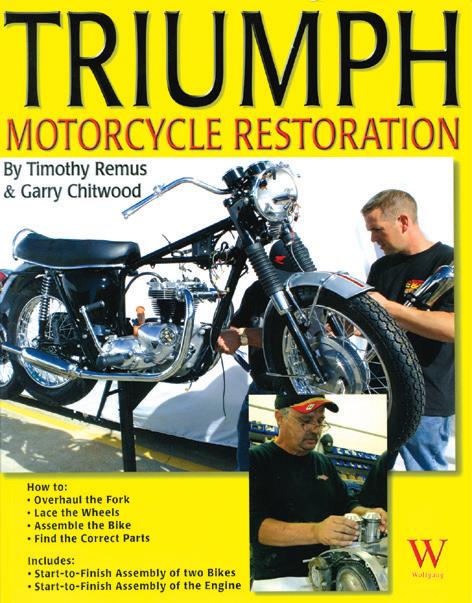
#3639 $29.95 Members: $25.46
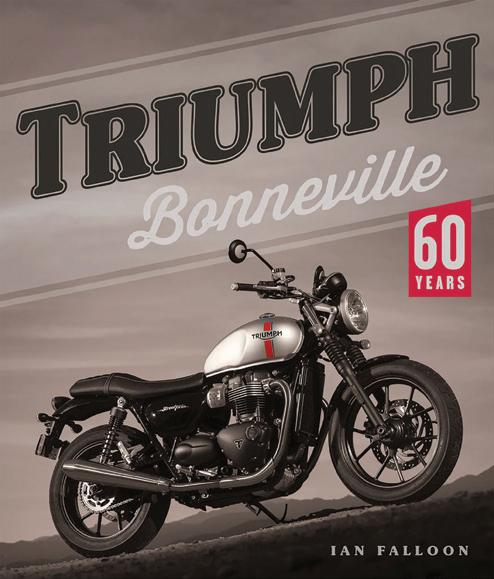
Honda Motorcycles 1959 to 1985: Enthusiasts Guide is for the non-professional motorcycle collector looking to buy and restore Honda motorcycles.
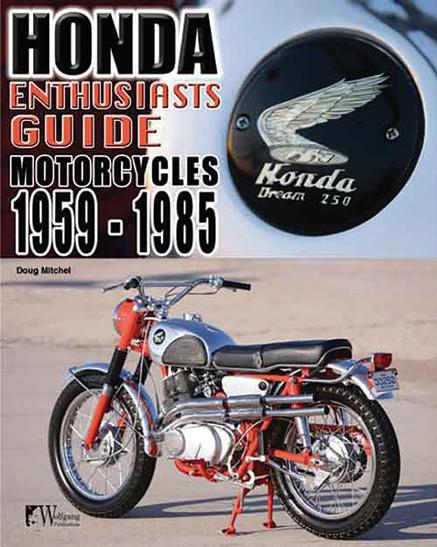
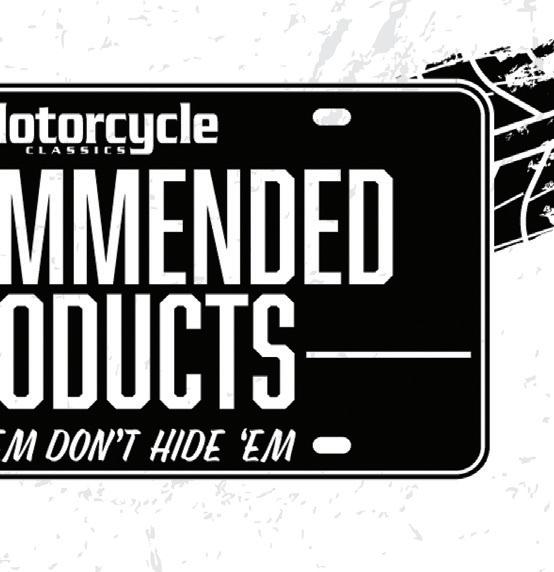
Author Doug Mitchel provides thorough descriptions of each model, the cost to acquire each project, the value when finished, which bikes and models to avoid, and where to find the frame and engine numbers. In addition, readers will learn what to look for when checking the condition of items, such as the paint and decals, chrome, seat, rubber parts, and suspension.

#6973 $32.95 Members: $28.01
HARLEY-DAVIDSON CLASSICS
No other motorcycle matches the style or sound of a Harley-Davidson with its rumbling V-twin engines. Harley-Davidson Classics zooms in on more than 50 of the company’s greatest creations, giving a close-up portrait of each machine. Superb double-page photos and close-up shots highlight every aspect of each motorcycle.
#9879 $29.95 Members: $25.46













No other motorcycle matches the style or sound of a Harley-Davidson with its rumbling V-twin engines. Harley-Davidson Classics zooms in on more than 50 of the company’s greatest creations, giving a close-up portrait of each machine. Superb double-page photos and close-up shots highlight every aspect of each motorcycle. #9879 $29.95 Members: $25.46
INDIAN MOTORCYCLE:
120 YEARS OF AMERICA'S FIRST MOTORCYCLE COMPANY
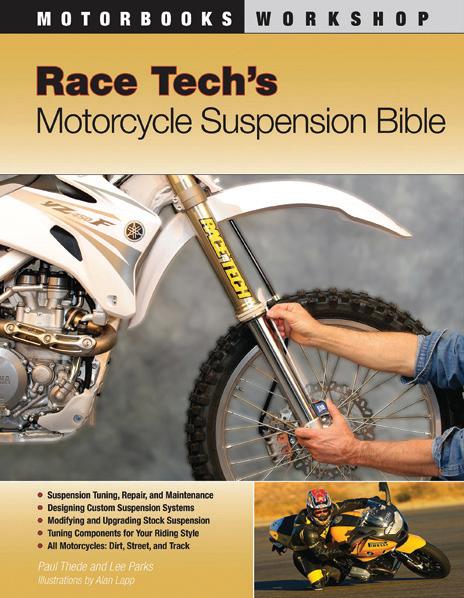
Triumph Bonneville: 60 Years is a celebration of one of motorcycling’s most iconic and beloved bikes. The Bonneville’s story, one filled with successes and challenges, begins in Great Britain in 1959 and carries through into the 21st century where it has become a global success story. Dive into the story and experience why this legendary model’s style, sound, performance, and undeniable coolness resonates with motorcycle enthusiasts around the world. #11836 $55.00 Members: $46.75 To order, call toll-free 800-880-7567
This book makes the art and science of suspension tuning accessible to professional and backyard motorcycle mechanics alike. With step-by-step instructions, Paul Thede gives a clear account of the three forces of suspension that you must understand to make accurate assessments of your suspension's condition and outlines testing procedures that will help you gauge how well you're improving your suspension.
#7312 $38.99 Members: $33.14







This book tells the complete story of Indian Motorcycle, America's first mass-produced motorcycle maker, from its start as a bicycle manufacturer to the purchase of the brand by Polaris Industries in 2011 and the subsequent new Indian motorcycles — updated to include new photography and stories of the latest models.
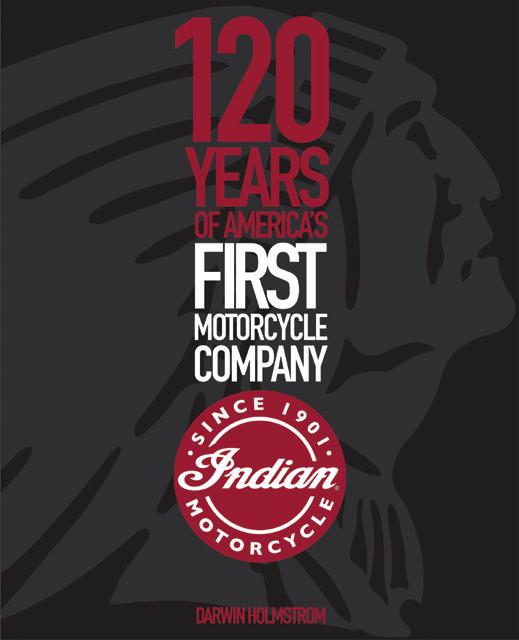
#10655 $50.00 Members: $42.50






STREET RIDER'S GUIDE





Street Rider’s Guide spells out safety tactics for motorcycle riders looking to get the most out of their favorite hobby for as long as possible. Covering topics from A to Z, this go-to handbook provides motorcyclists quick solutions to nearly 100 commonly encountered obstacles and road challenges (what safety experts call increasing a rider’s “situational awareness”).
Street Rider’s Guide spells out safety tactics for motorcycle riders looking to get the most out of their favorite hobby for as long as possible. Covering topics from A to Z, this go-to handbook provides motorcyclists quick solutions to nearly 100 commonly encountered obstacles and road challenges (what safety experts call increasing a rider’s “situational awareness”).
#9355 $17.95 Members: $15.26
#9355 $17.95 Members: $15.26
&
























Kawasaki Z1, Z/KZ900 & Z/KZ1000 is for all owners and enthusiasts of the legendary Kawasaki Z1 900, Z/KZ900 and Z1000 built between 1972 and 1980. The book covers the complete restoration of a 1976 KZ900, from the sourcing of the bike to its completion as a fully restored machine. Additional work on a 1974 Z1A model adds complementary information. What really sets this manual apart, however, is the style in which it is written: not as some dull and distant workshop manual but in a friendly, humorous manner by an enthusiast of many years who is able to involve and entertain the reader, as well as guiding them through the restoration process.
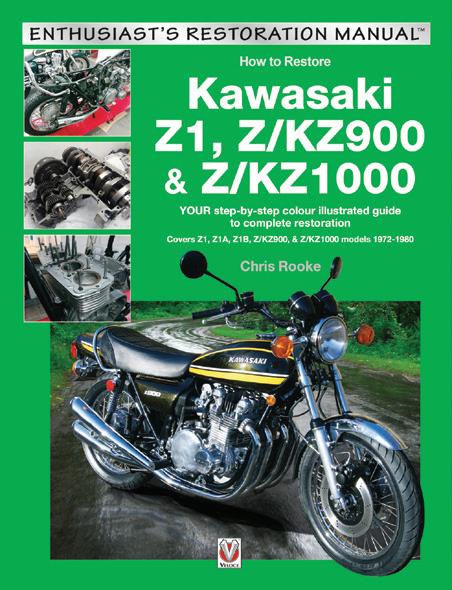
HOW TO RESTORE KAWASAKI Z1, Z/KZ900 & Z/KZ1000 Kawasaki Z1, Z/KZ900 & Z/KZ1000 owners and enthusiasts of the legendary Kawasaki Z1 900, Z/KZ900 and Z1000 built between 1972 and 1980. The book covers the complete restoration of a 1976 KZ900, from the sourcing of the bike to its completion as a fully restored machine. Additional work on a 1974 Z1A model adds complementary information. What really sets this manual apart, however, is the style in which it is written: not as some dull and distant workshop manual but in a friendly, humorous manner by an enthusiast of many years who is able to involve and entertain the reader, as well as guiding them through the restoration process.
A must-have for all Indian fans, Franklin’s Indians gives a rare look into the life of Charles Franklin, and sheds new light on the history of Indian motorcycles and the often turbulent times of the Indian Motorcycle Company itself. By the end, readers will see why the Indian has been the iconic image for American big V-Twins throughout the years, and just how Charles Franklin’s Indian Scout and Indian Chief helped get them there.
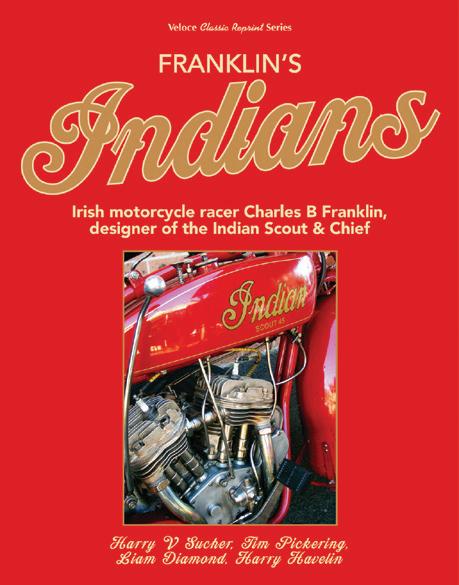
#10940 $50.00 Members: $42.50
Members: $51.00

#10916 $60.00 Members: $51.00
BMW BOXER TWIN
There are lots of books about the classic BMW Boxers; their history, performance, lineage, and the minutiae of its specification. But none of them concentrate entirely on telling you what to look for when buying one secondhand. That's what this book is about — it is a straightforward, practical guide to buying a used Boxer twin. Point by point, it takes the reader through everything that needs looking at when buying a Boxer, plus spares prices, which is the best model to buy for your needs, and a look at auctions, restorations and paperwork.
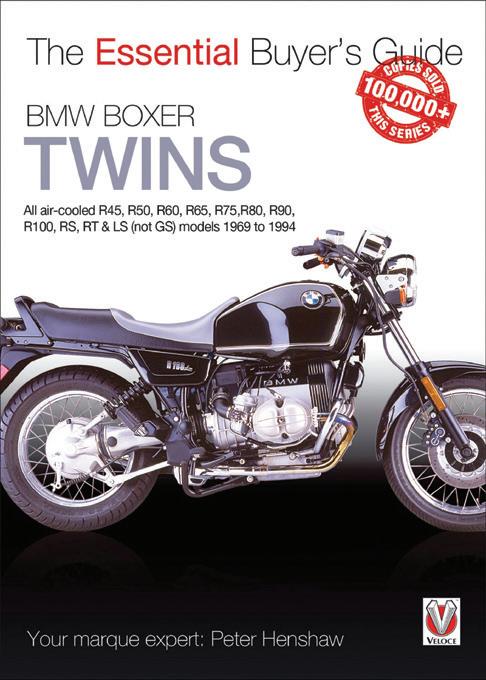
#10835 $25.00 Members: $21.25
A history of the Honda V4 — much of it told for the first time. Explains how these charismatic motorcycles came to be built, their strengths and weaknesses, and what makes them uniquely special in a sea of Universal Japanese Motorcycles. Covers the design and development of the first Honda V4, the oval piston, the VF road models and the iconic sport touring bikes.
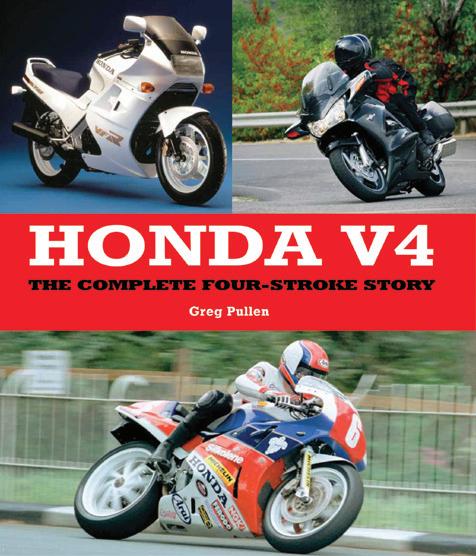
#10933 $44.95 Members: $38.21

The year was 1928 when two young Hungarians decided to travel around the world on a Harley-Davidson motorcycle with sidecar. This intelligent and engaging book offers a unique world view between the World Wars, flavored by the great diversity of cultures and the wide variety of human life that exists on the planet.
#8347 $24.95 Members: $21.21
CLASSIC BRITISH BIKES
This book covers the first century of the British motorcycle industry, from its beginnings to the end of the 20th century. Divided into four chronological sections The Pioneers, Vintage Days, The Classic Era, and Endings and Beginnings
This book covers the first century of the British motorcycle industry, from its beginnings to the end of the 20th century. Divided into four chronological sections The Pioneers, Vintage Days, The Classic Era, and Endings and Beginnings
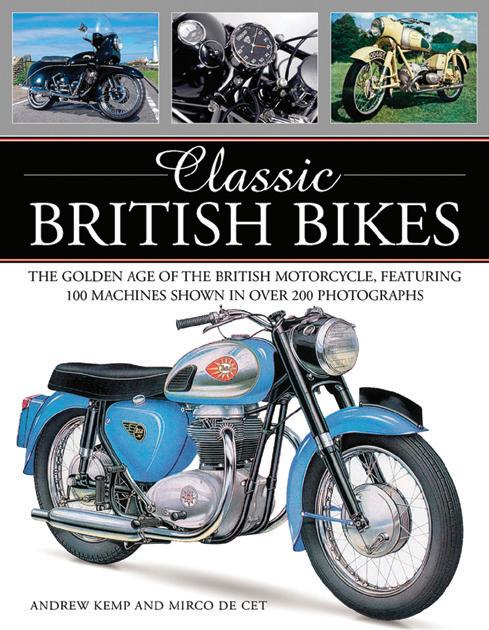
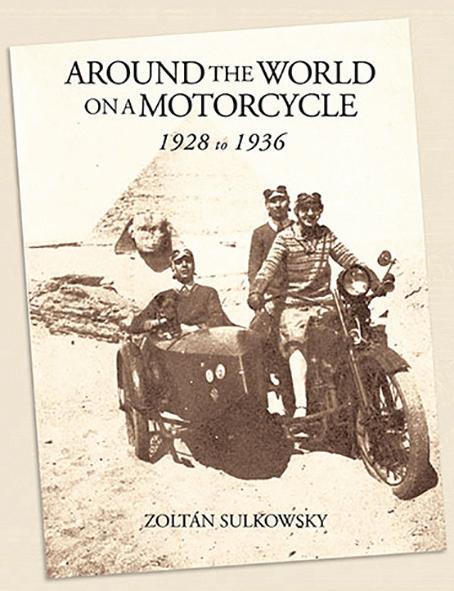
TRIDENT T150/T160 & BSA ROCKET III
— it profiles 100 of the best-loved machines that helped shape a century of motorcycle design. Each entry includes information about the bike’s history, specification panels detailing years in production, engine type, bore and stroke, capacity, gearbox, brakes, transmission, power, weight, and top
— it profiles 100 of the best-loved machines that helped shape a century of motorcycle design. Each entry includes information about the bike’s history, specification panels detailing years in production, engine type, bore and stroke, capacity, gearbox, brakes, transmission, power, weight, and top speed.
#10701 $11.99 Members: $9.99
Members: $9.99
Written by an enthusiast with many years’ experience of working on classic British motorcycles, this book covers the complete dismantling, refurbishment, and rebuilding of two Tridents: a 1973 Triumph T150V and a 1975 Triumph T160. From the simplest of jobs, such as removing the fuel tank, through to detailed explanations of rebuilding the engine and carburetors, this manual is an absolute must for any enthusiast contemplating working on their Triumph or BSA triple. Over 650 color photographs and detailed text descriptions clarify every stage of the rebuild!
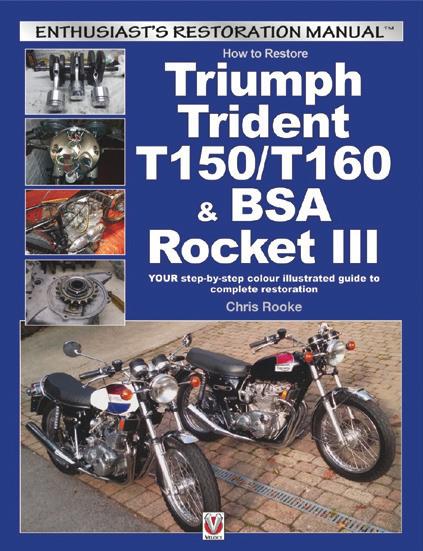
#10938 $80.00 Members: $68.00

Seventy years ago California’s Department of Transportation (Caltrans) recognized a growing — and deadly — problem on state highways. As the 1950s (aka the Ike Era) unfolded, a growing number of vehicles on the highways, byways, and freeways translated into a growing number of vehicular accidents, of which many involved head-on collisions when motorists accidentally drifted into an opposing lane. What to do?
The solution came by way of a Caltrans road engineer, Dr. Elbert Dysart Botts. His answer was to position small raised markers on roads’ painted center lines that originally had been tasked with keeping opposing traffic in their respective lanes. Botts’ elevated round markers (measuring several inches across and less than half an inch high) would alert errant drivers if they crossed the center line. Any vehicle traversing the raised markers would produce a rumpling sound from its tires, a noise loud and annoying enough to alert the driver. However, there were problems with the markers because they had to be tacked into place, and a vehicle’s tires easily dislodged the Dots. So Botts and his fellow
engineers and scientists went back to the lab where they developed an epoxy glue sticky enough to hold the small, yet important, markers in place; the epoxy proved tough enough to withstand the pounding of a heavy vehicle’s tires.
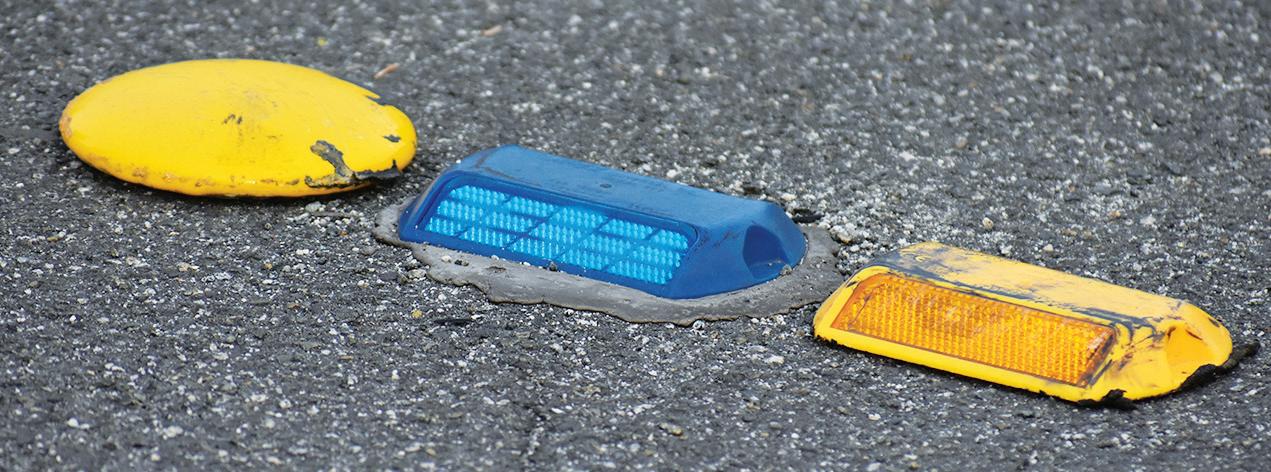
Soon enough those raised markers became known as Botts’ Dots, a name that has stuck with them through the years. By 1965 Caltrans began using Botts’ Dots on all of California’s major
Botts’ Dots dotting California’s many roads. But not all states use Botts’ Dots; similar road markers in Washington and Oregon are known as Turtles, while Texans refer to their lane-marking dots as Buttons. Many places that experience snowfall fortify their roads with sunken Botts’ Dots. By carving out a divot in the road engineers sink the Botts’ Dots to pavement level so that snow plows won’t disrupt the vital lane markers.
roadways. Some Botts’ Dots, finished in either yellow or white, feature reflector patterns that are easy to see at night or during inclement weather. But not all dots have reflective surfaces. Plain, and less expensive, non-reflective Dots are used at less critical points of a road’s surface to help mark individual lanes as required for traffic flow.
Today there are more than 25 million
Botts’ Dots have other uses besides marking lanes. For instance, reflective blue Botts’ Dots are positioned near fire hydrants so that fire fighters can easily spot them during emergency situations, or Dots positioned in a perpendicular line across a traffic lane help warn motorists of upcoming situations such as stealthy stop signs and crossroads or other potential road hazards and such. Dots can also help mark turning lanes or define merging traffic junctions.
As for influencing the ride aboard our classic motorcycles, Botts’ Dots make the ride a little safer than normal by helping motorists stay within their respective lanes. And that’s reason enough to thank the late Dr. Botts for his most timely invention. — Dain Gingerelli
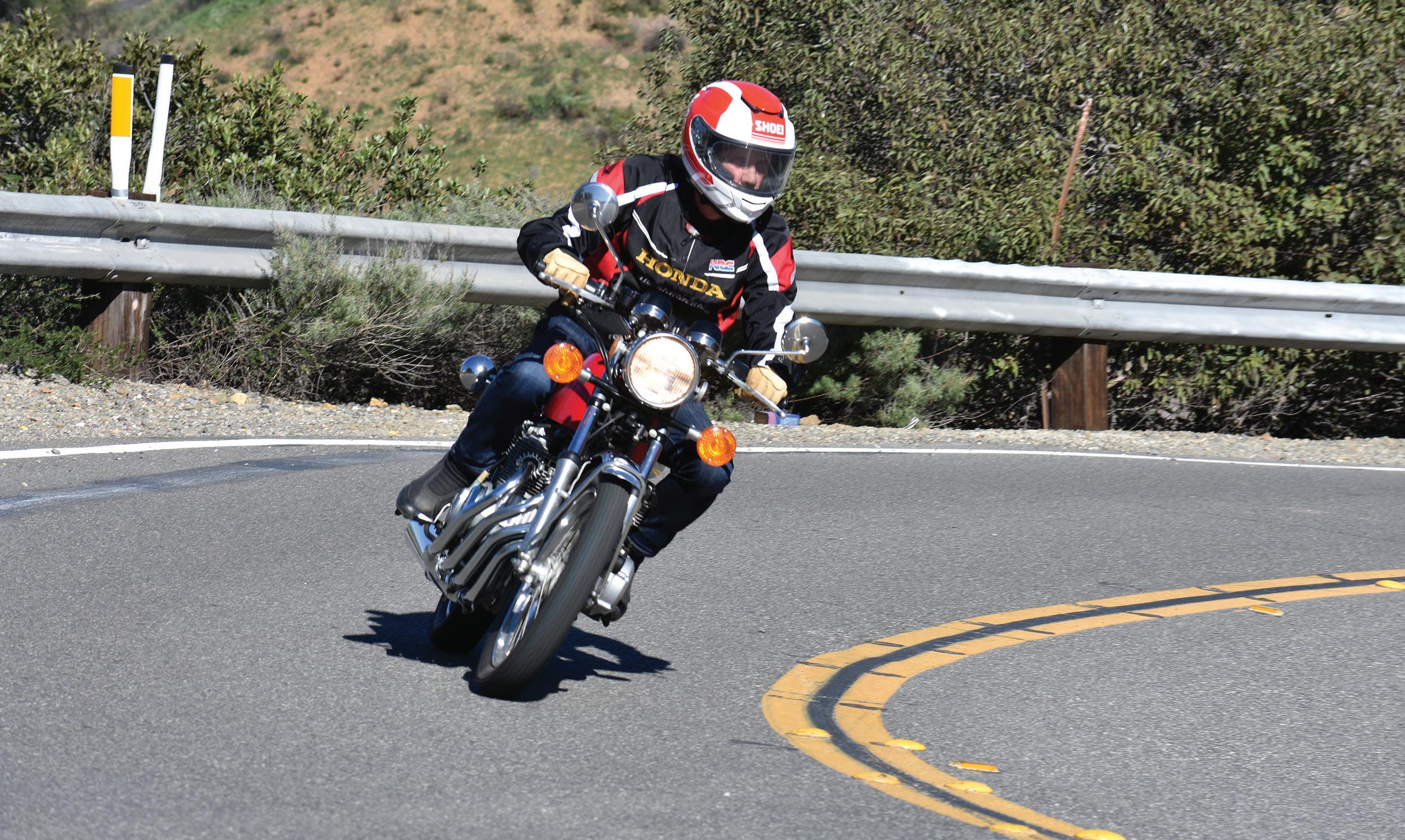




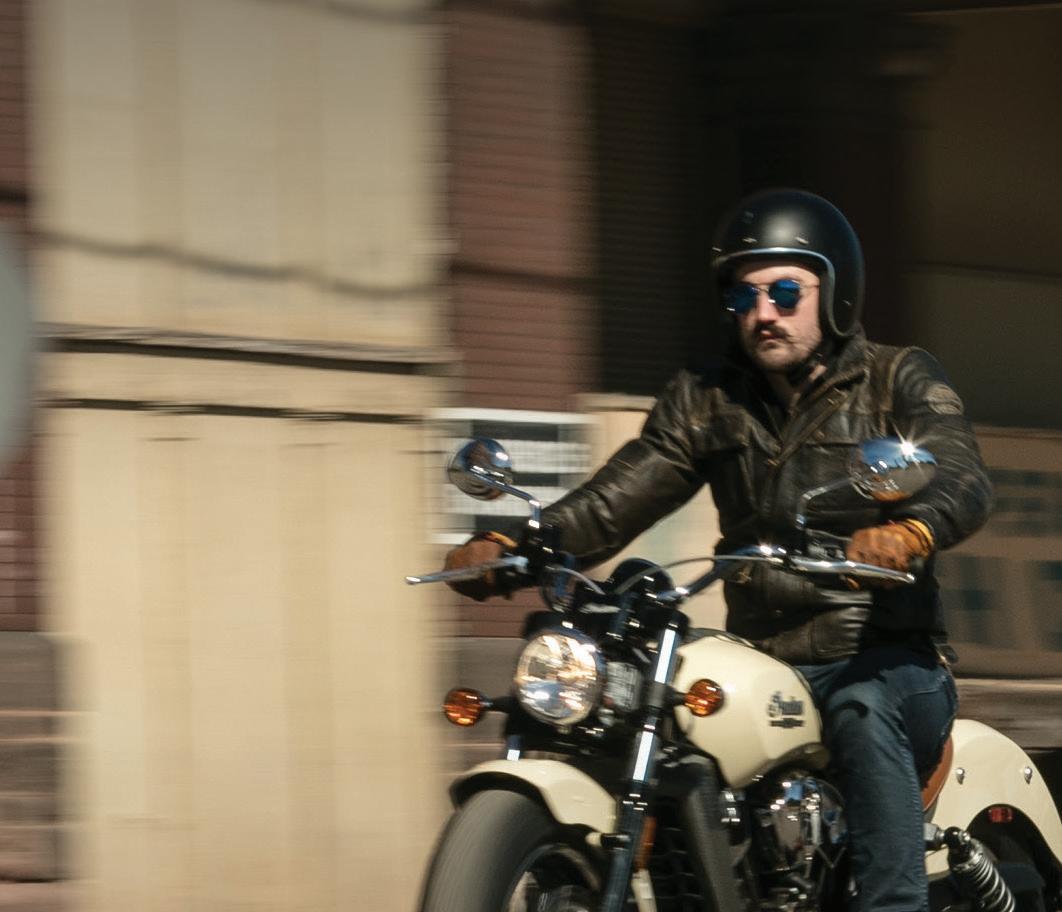
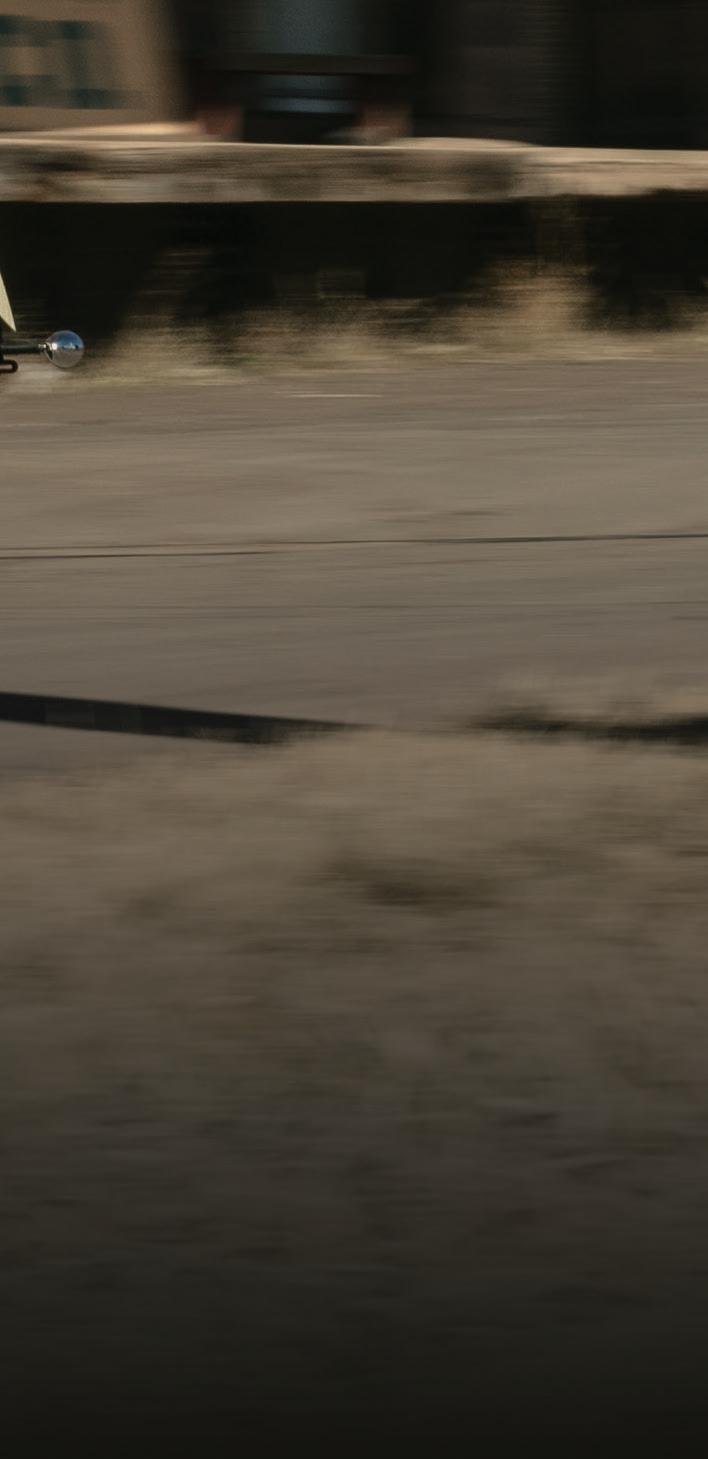
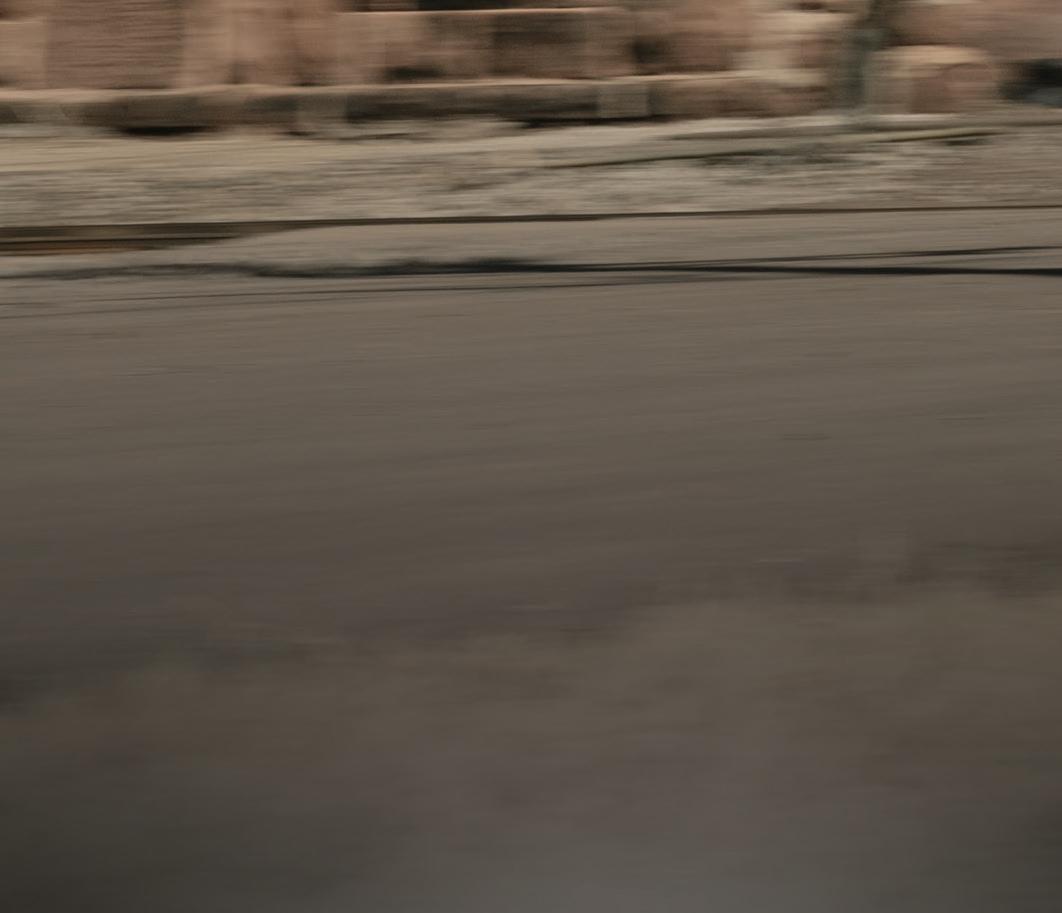
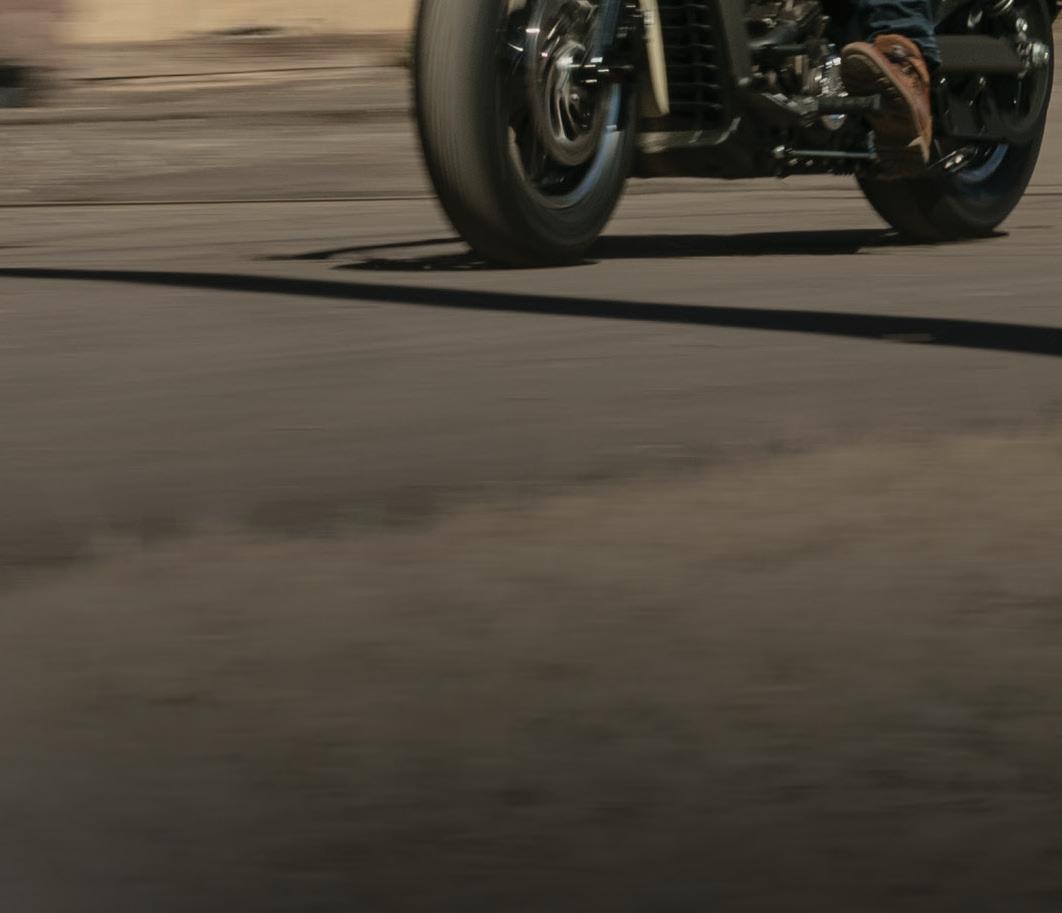




INSPIRED BY THE CLASSIC CUSTOM LOOK, BEAUTIFULLY EXECUTED BY TRIUMPH’S WORLD-CLASS DESIGN AND MANUFACTURING TEAMS.



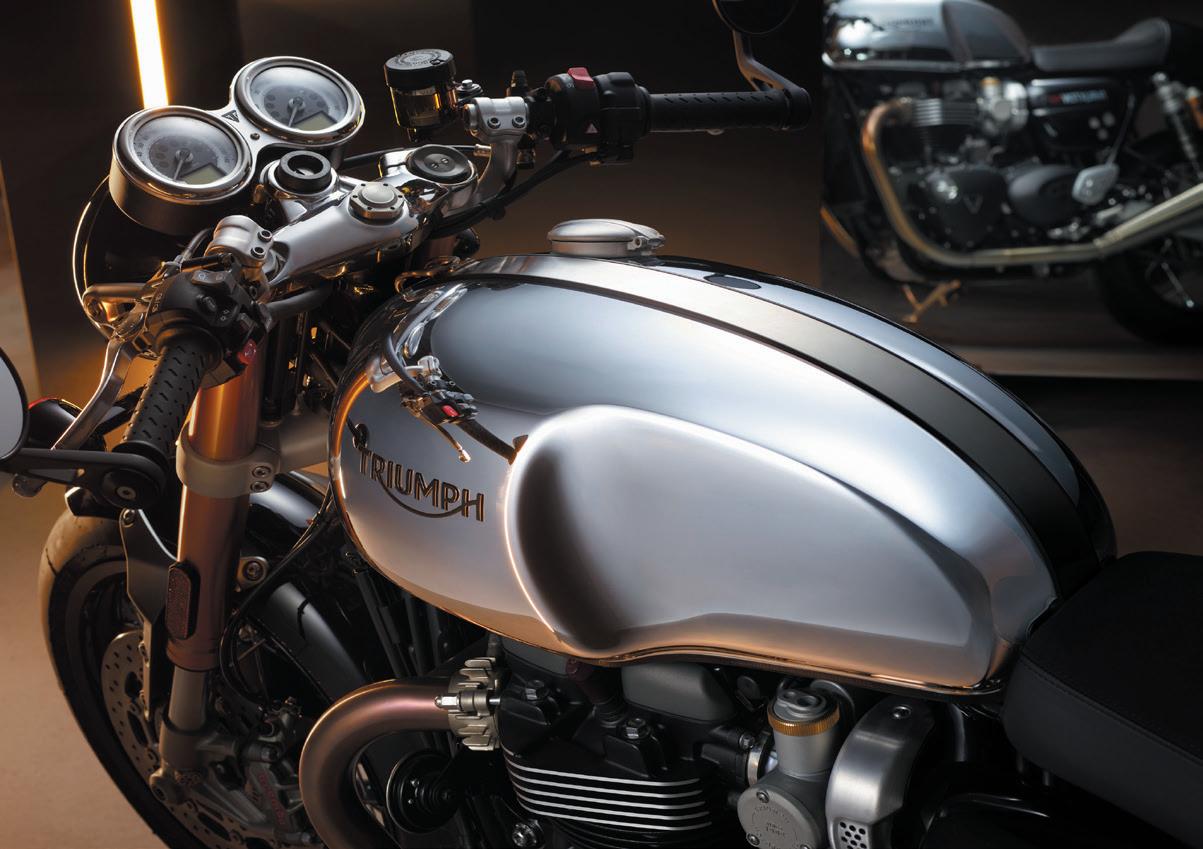
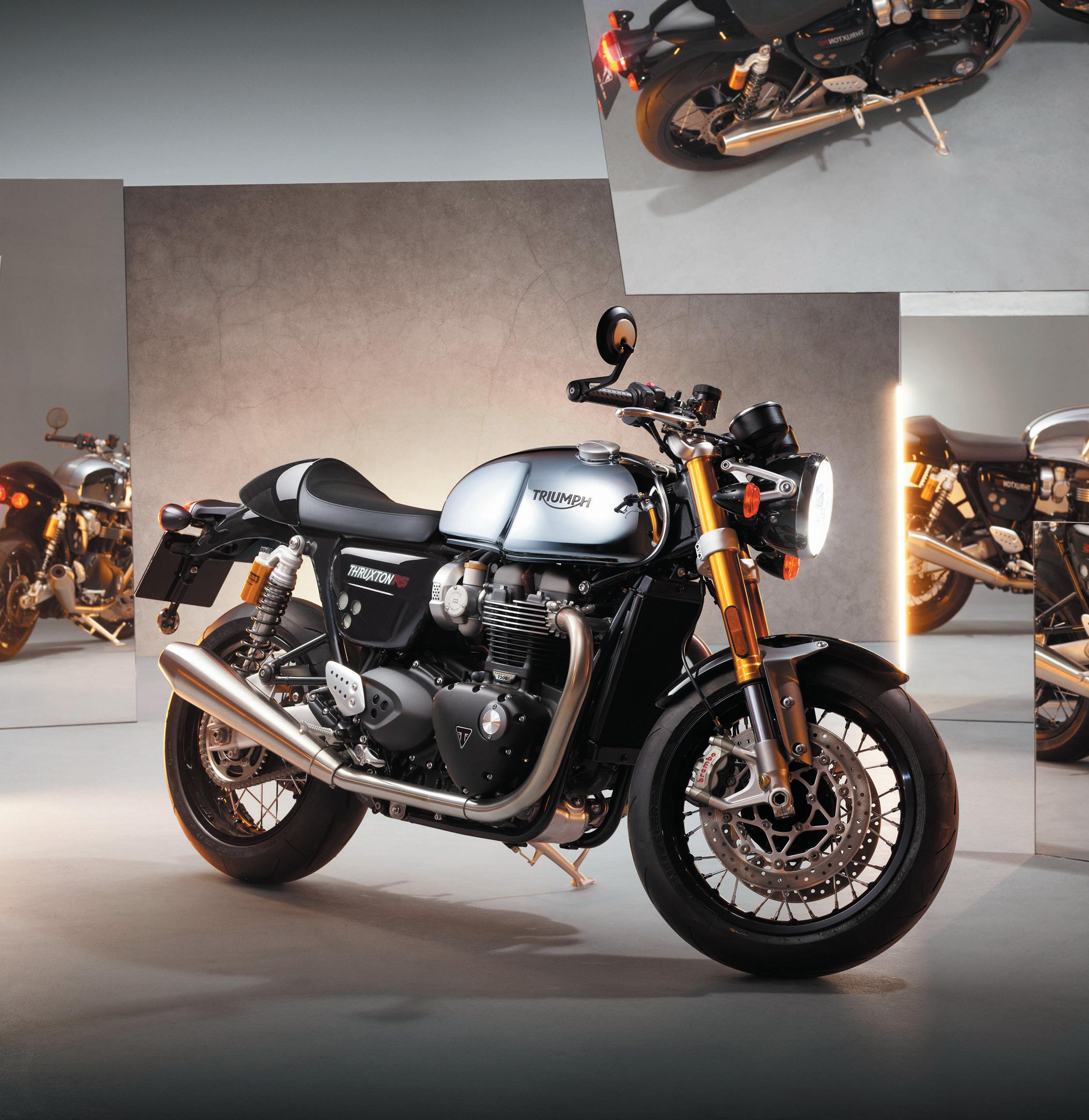
With a unique update and a major engine development for the exciting Thruxton RS, this vibrant new Chrome Edition showcases hand-crafted beauty, with a classic full chrome tank and stylish Jet Black paint scheme. Available for one year only, each Chrome Edition motorcycle perfectly showcases the craft and capability of the dedicated teams that perfected the skill of chrome detailing over many years, complementing the Thruxton RS’s dominating style. Own the new pinnacle in beauty, performance and sophistication from $17,445.00. Discover the entire Chrome Edition lineup at triumphmotorcycles.com
